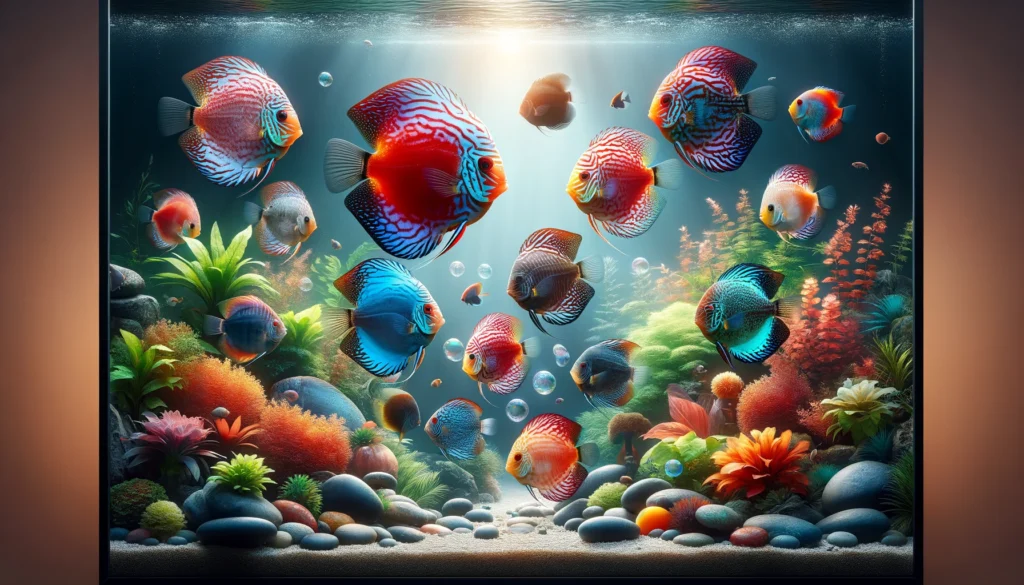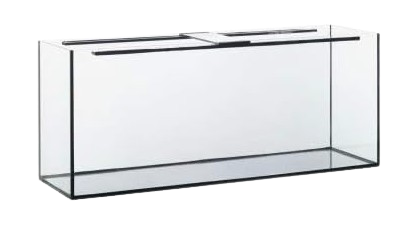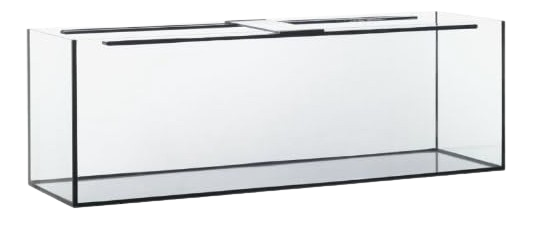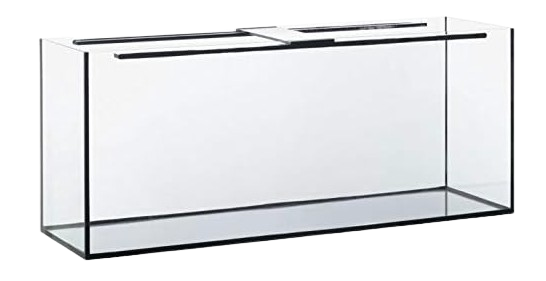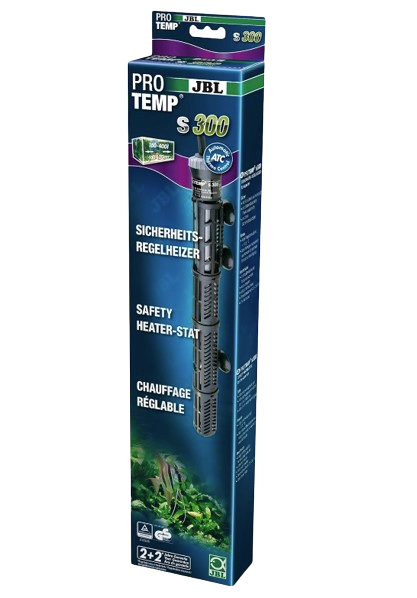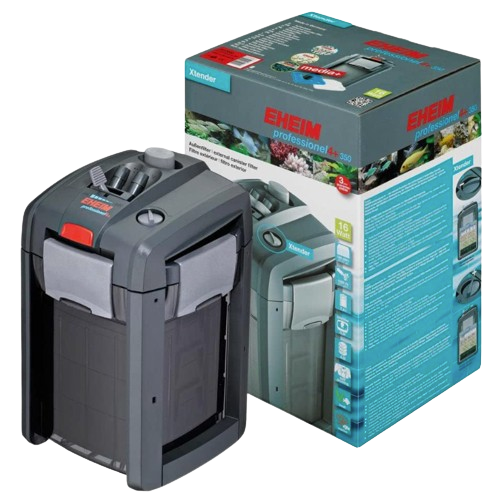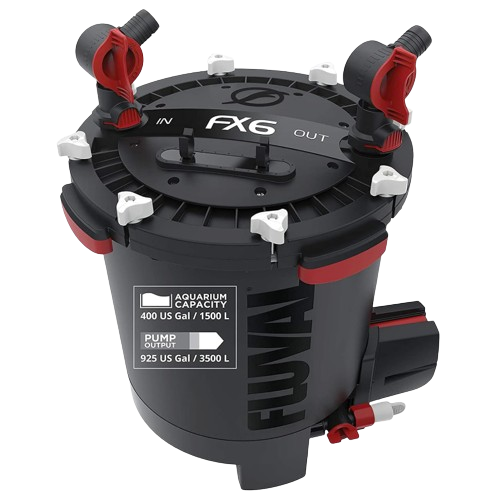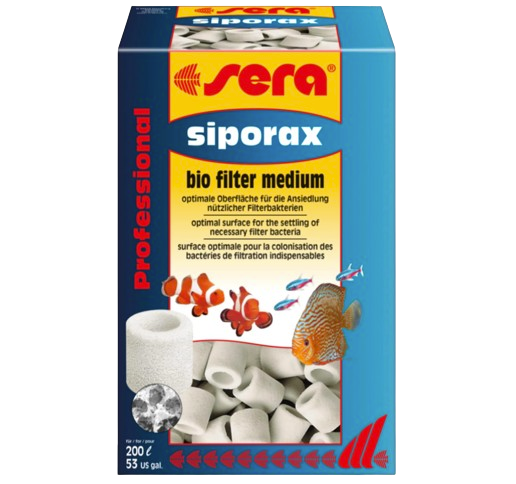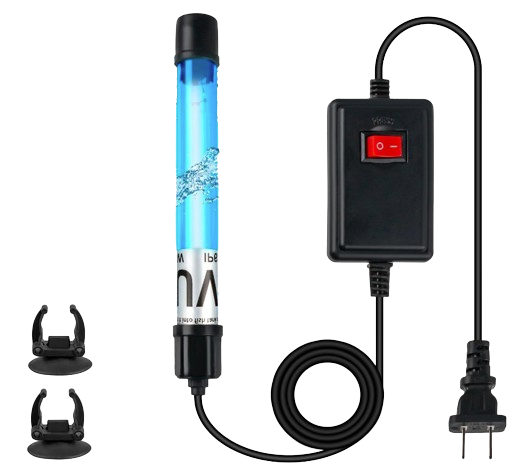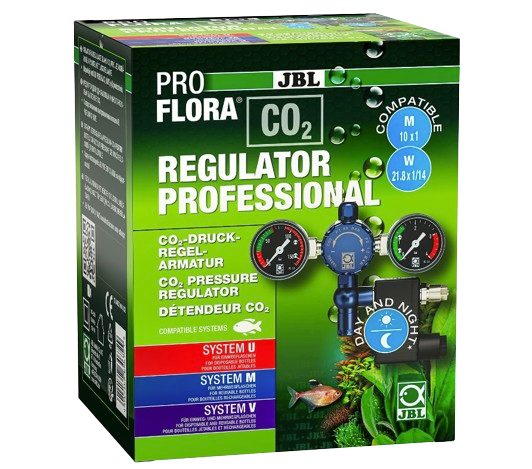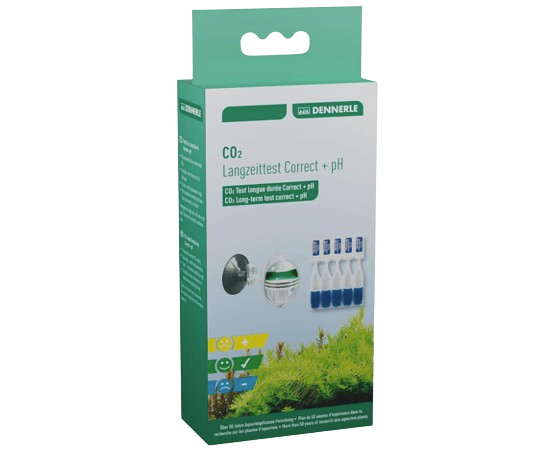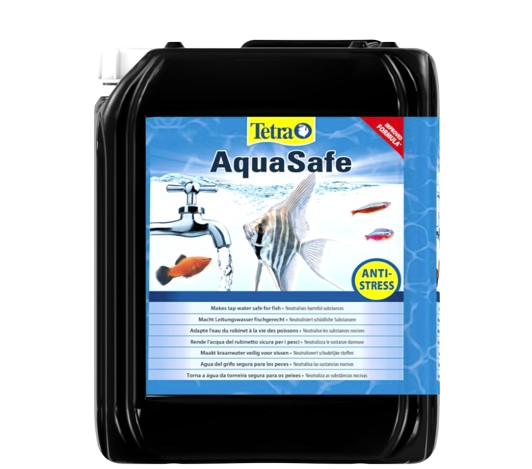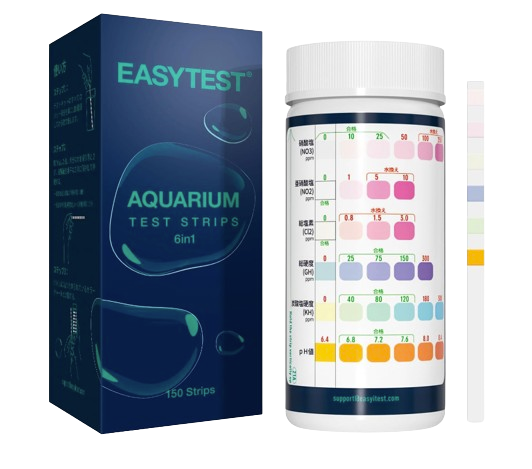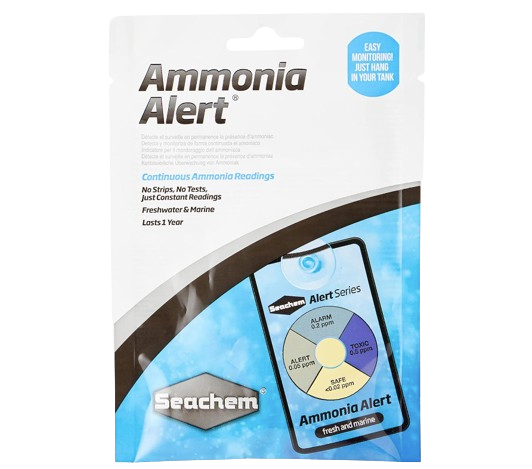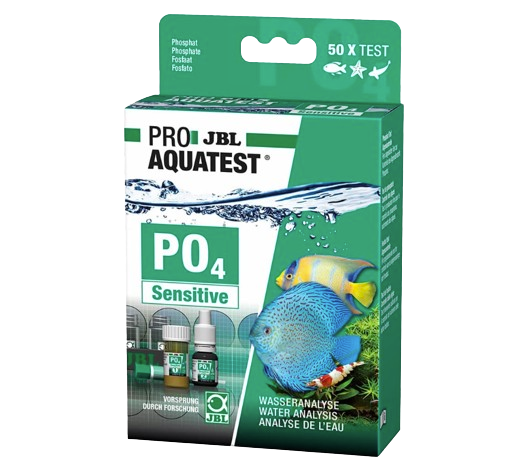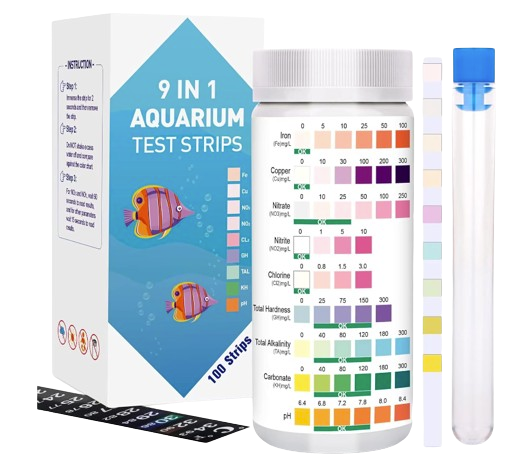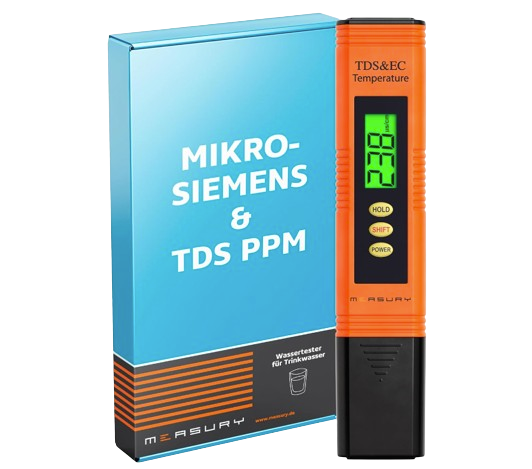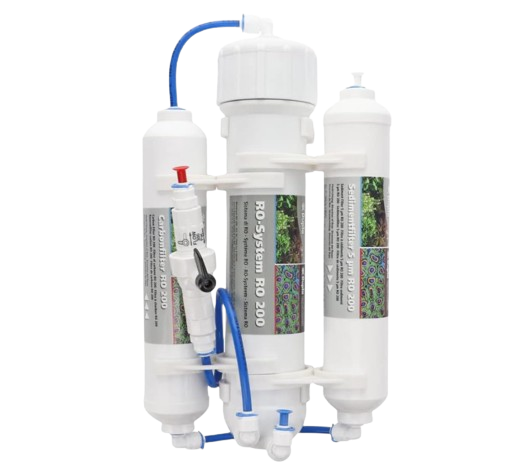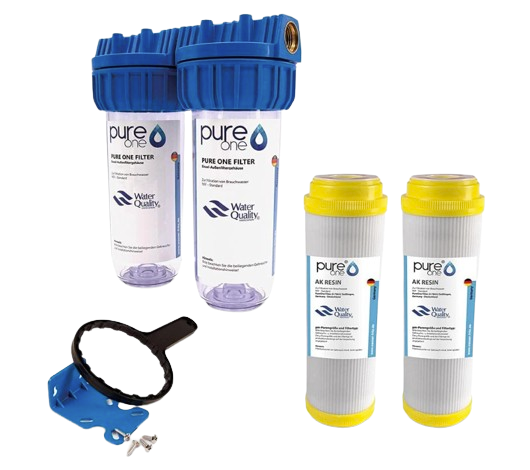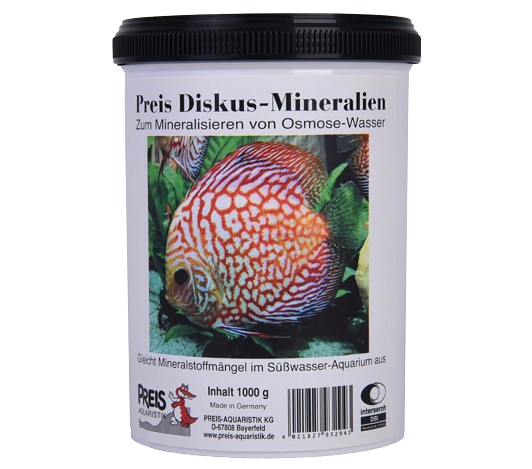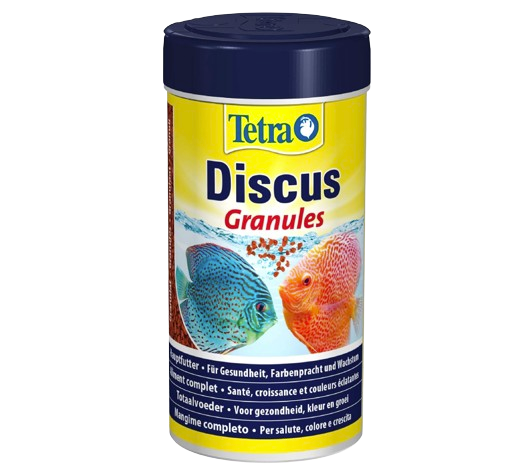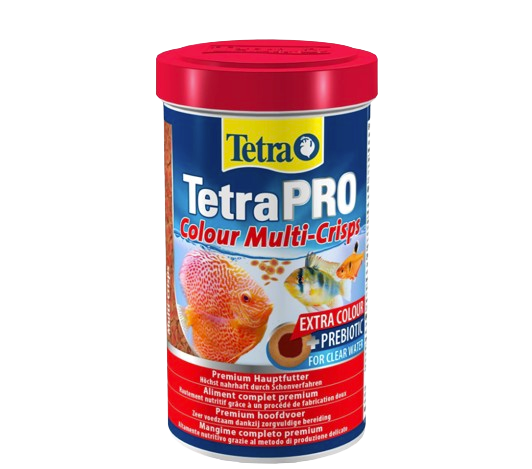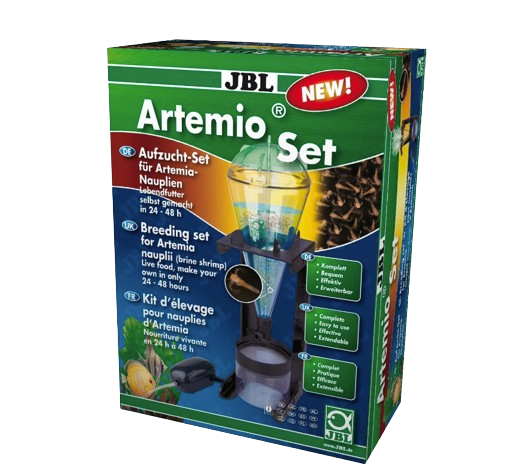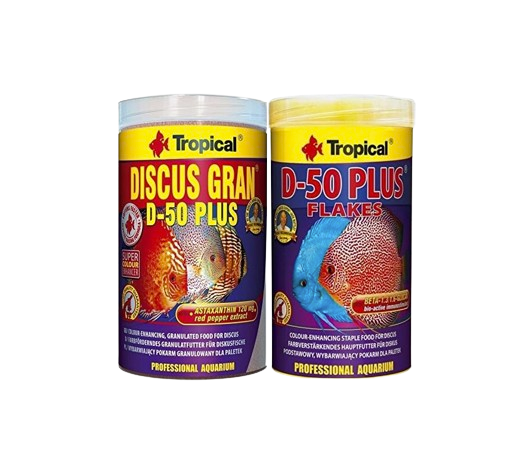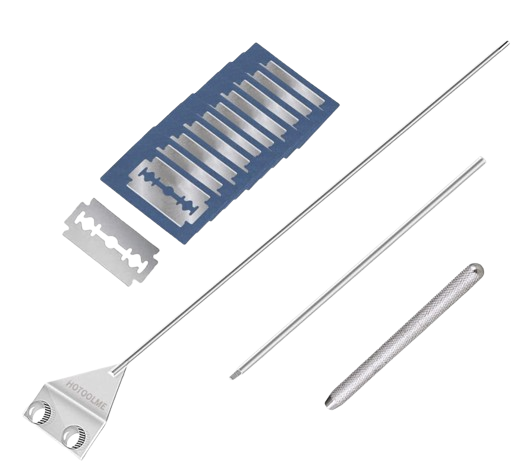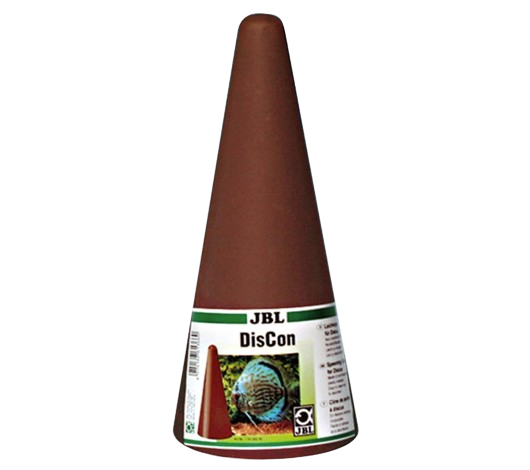Table of Contents
Foreword
Dear readers,
Aquaristics has been a lifelong passion of mine, starting from a young age with typical beginner fish like guppies, black mollies, platys, swordtails, and plecos. My fascination evolved through various species, from labyrinth fish and clown loaches to angelfish, each new interest paving the way to more complex challenges. Ultimately, this journey led me to specialize in discus fish—a species known for their demanding care requirements and stunning beauty.
I have successfully kept and bred discus fish for many years, mastering water chemistry for optimal habitat preparation and microscopic analysis of fish diseases, which underscores my expertise in this field. While priorities in life can shift—currently, I do not maintain an aquarium—my depth of knowledge remains intact and continually enriches this blog.
In this space, we utilize AI-generated imagery primarily for demonstration purposes. While these images help illustrate various concepts, they may not always accurately represent the true appearance of the species depicted and might contain textual inaccuracies. Therefore, these visuals should be seen more as creative interpretations rather than definitive representations.
We are aware of the limitations and potential of AI technology and are committed to replacing these images with more accurate and appropriate visual content that better aligns with the topics discussed. Our goal is to provide you with an authentic and informative reading experience, filled with actionable knowledge for successfully breeding and maintaining discus fish.
Please note that there may be affiliate links in this blog for promoting products. As an Amazon affiliate, I earn a commission from qualifying purchases at no extra cost to you. Thank you for your interest and loyalty. We appreciate your understanding and patience as we enhance the visual aspects of our blog.
Best regards,
Mario
Introduction to Discus Fish: The Majestic Kings of Freshwater Aquariums
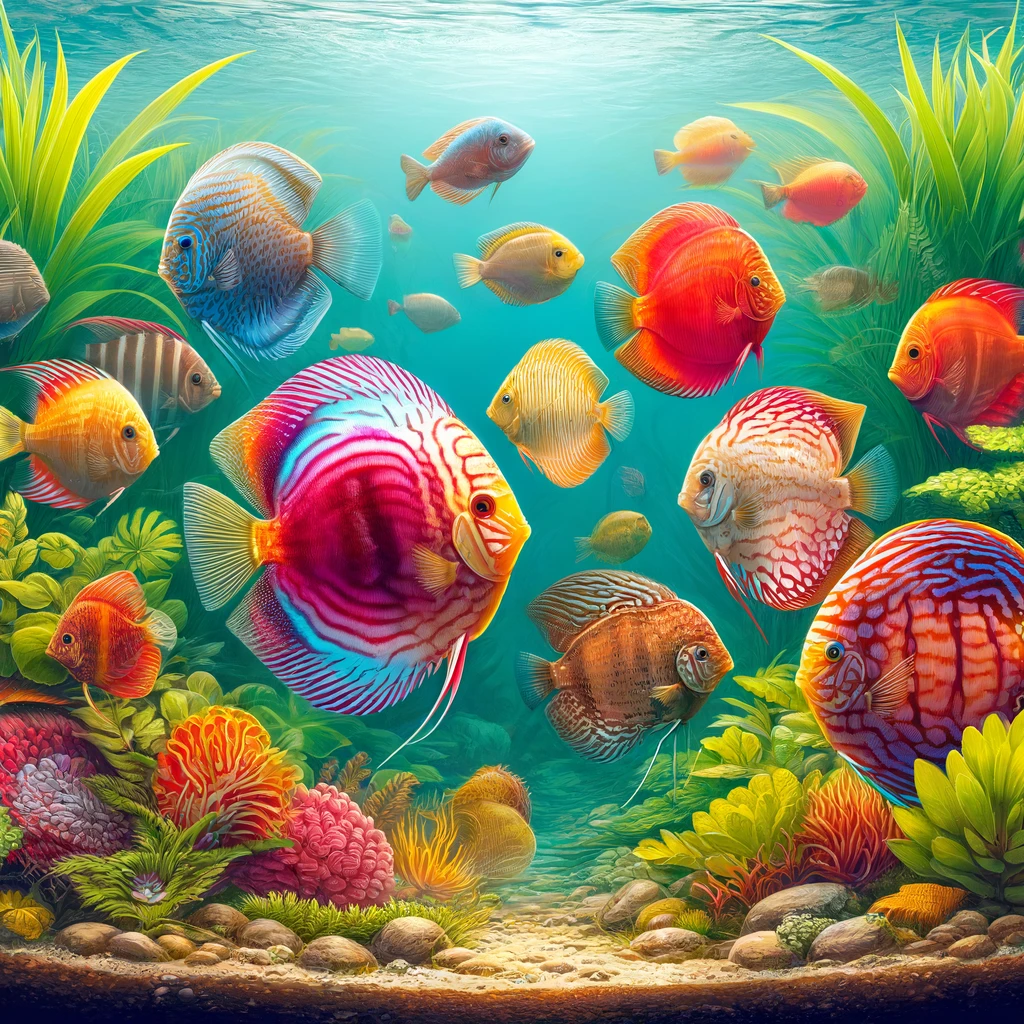
Discus fish, often hailed as the “kings” of freshwater aquarists, remain a centrepiece in the aquarium world. Few freshwater species can match the vibrant colours and majestic shapes of discus fish, captivating both spectators and their caretakers alike.
This fascination with discus fish is not only due to their stunning physiology but also has historical roots. Since the first discus were imported to Germany in 1921—an unfortunate venture where all specimens perished during transport—these fish have been highly sought after and a topic of spirited discussion. Regular imports began in the late 1940s and early 1950s, marking the onset of a challenging era in discus aquarists.
Early on, acquiring and caring for discus fish posed significant challenges. Logistical issues and the difficulty of procuring natural, varied diets were compounded by a lack of knowledge about their natural habitats, leading to inevitable care mistakes. Unfortunately, ongoing public debates among discus enthusiasts painted these fish as particularly delicate and difficult to maintain, tarnishing their reputation.
Moreover, discus fish caught the attention of professional breeders and the aquarium accessory industry as a profitable niche. Products associated with discus fish are often marketed to suggest superior quality—a perception I believe should be handled with caution.
Professional discus breeders also face challenges, as they need to recoup significant investments in their setups and struggle to compete with lower energy costs in Asia. This often leads to mass breeding, which may compromise quality, evident only later to the caretakers.
Despite these challenges, discus fish are relatively tolerant and can thrive under the right conditions, making them a fascinating and rewarding choice for dedicated aquarists.
Acquiring Discus Fish: A Trust-Based Decision
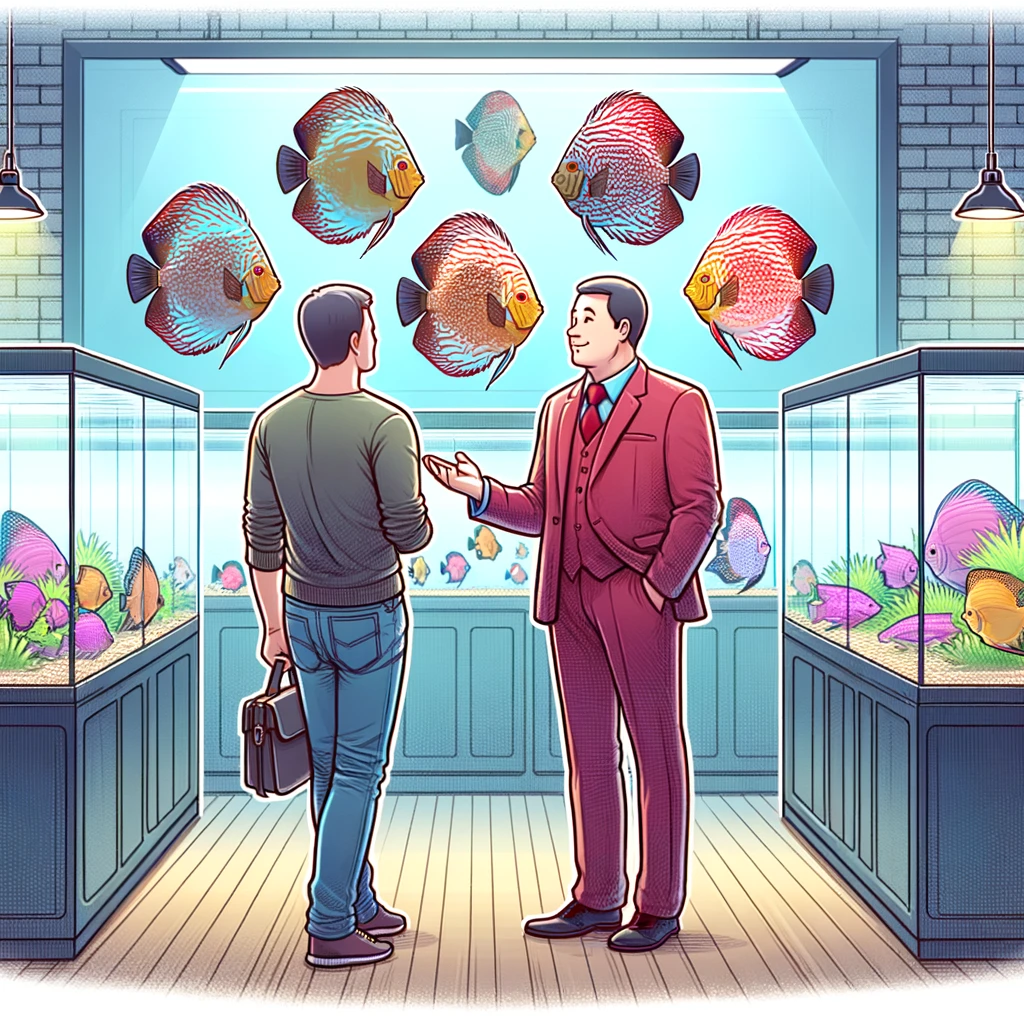
Purchasing discus fish is a matter of trust, not of bulk buying. These fish should not be treated as mere commodities. I strongly recommend buying discus fish from a local breeder rather than a pet store, where the fish are often seen as just another product and may be priced excessively.
Finding a reputable breeder typically happens through word-of-mouth or via an aquarium club. Once you’ve identified a breeder, it’s beneficial to visit them multiple times. Such visits not only allow you to learn more about the breeder’s practices but also provide a wealth of information about discus fish care, as these places are usually frequented by experienced caretakers who are generally eager to share their insights.
The Purchase: Essential Considerations Before Buying Discus Fish
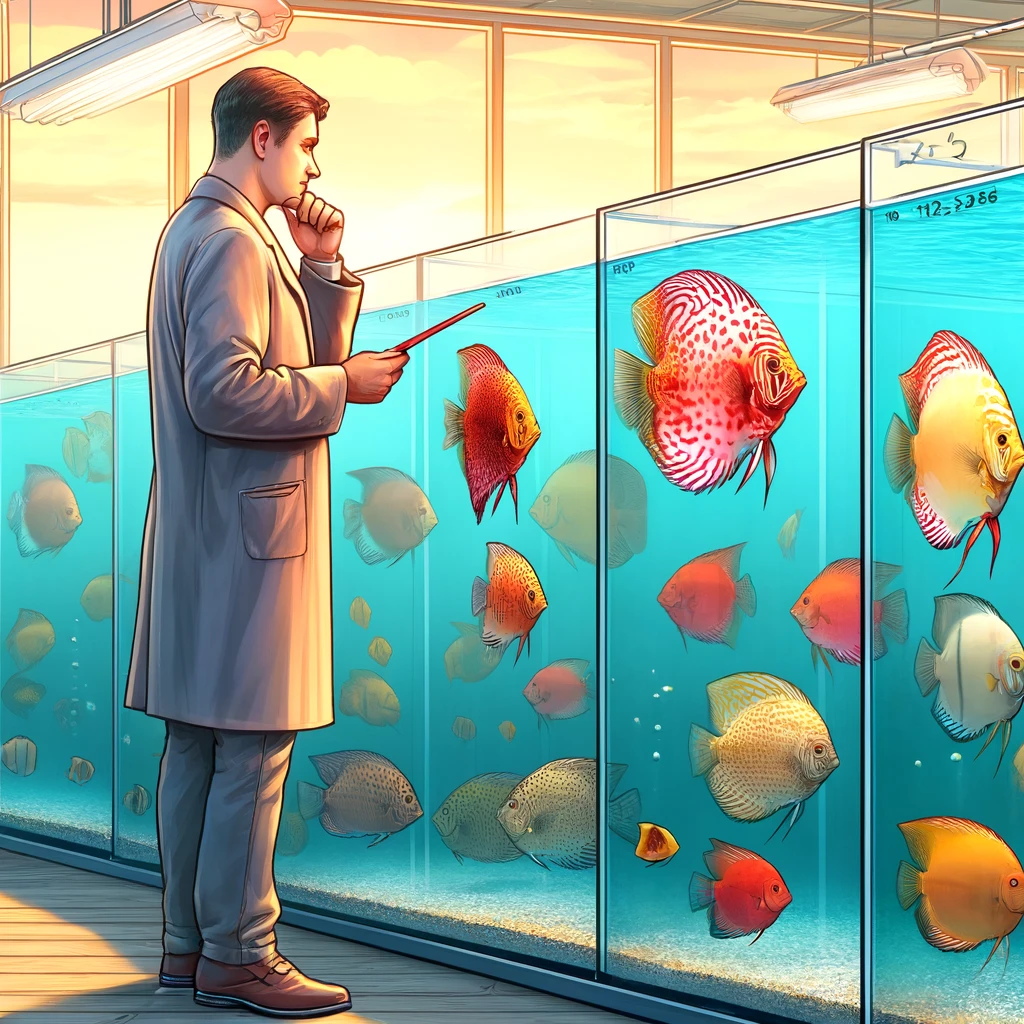
Before proceeding with the purchase of discus fish, there are several important factors to consider to ensure you choose healthy, vibrant specimens:
Cleanliness is Key: The breeder’s setup must be immaculate. This applies to all tanks, whether they house discus or other species like tetras, barbs, or labyrinth fish.
Water Parameters: Learn the water parameters from the breeder and gradually adjust your aquarium to match these values. Once stabilized, you’re ready to purchase.
Choosing a Color Variant: Take your time to observe the fish closely, which could take up to half an hour. Opt for fish that are active and display their colours vividly, as this indicates good health.
Physical Health Checks:
- Shape: Discus should be round, even as juveniles. Elongated bodies may indicate stunted growth due to past illness.
- Eyes: The size of the eyes in relation to the body should be proportionate; oversized eyes can be a bad sign.
- Head and Belly: Look for a well-formed forehead and belly. Sunken features often indicate malnutrition.
- Behavioural Signs: Healthy discus will swim to the top when your hand approaches the tank, expecting food. If a fish hangs back or is pushed aside by others, it may not be healthy.
- Feeding: Observe the fish eating. Healthy discus should approach food without hesitation.
- Breathing: Normal breathing should not exceed 60 breaths per second except after feeding. Watch for one-sided breathing, which could indicate gill parasites.
- Activity: Signs like erratic swimming or scratching can indicate parasites. Healthy discus are calm and show interest in their surroundings.
Size Considerations: For display tanks, choose mature discus, ideally no smaller than 12 cm, as young fish require frequent feeding, leading to higher water contamination.
Social Dynamics: Discus are schooling fish and should be kept in groups of at least five to distribute any aggression. Avoid keeping them in pairs unless for breeding purposes.
For Beginners: Novice discus keepers should start with adult or sub-adult fish around 10 cm in size, which are generally more resilient and require less frequent feeding.
Aquarium Size Requirements for Discus Fish
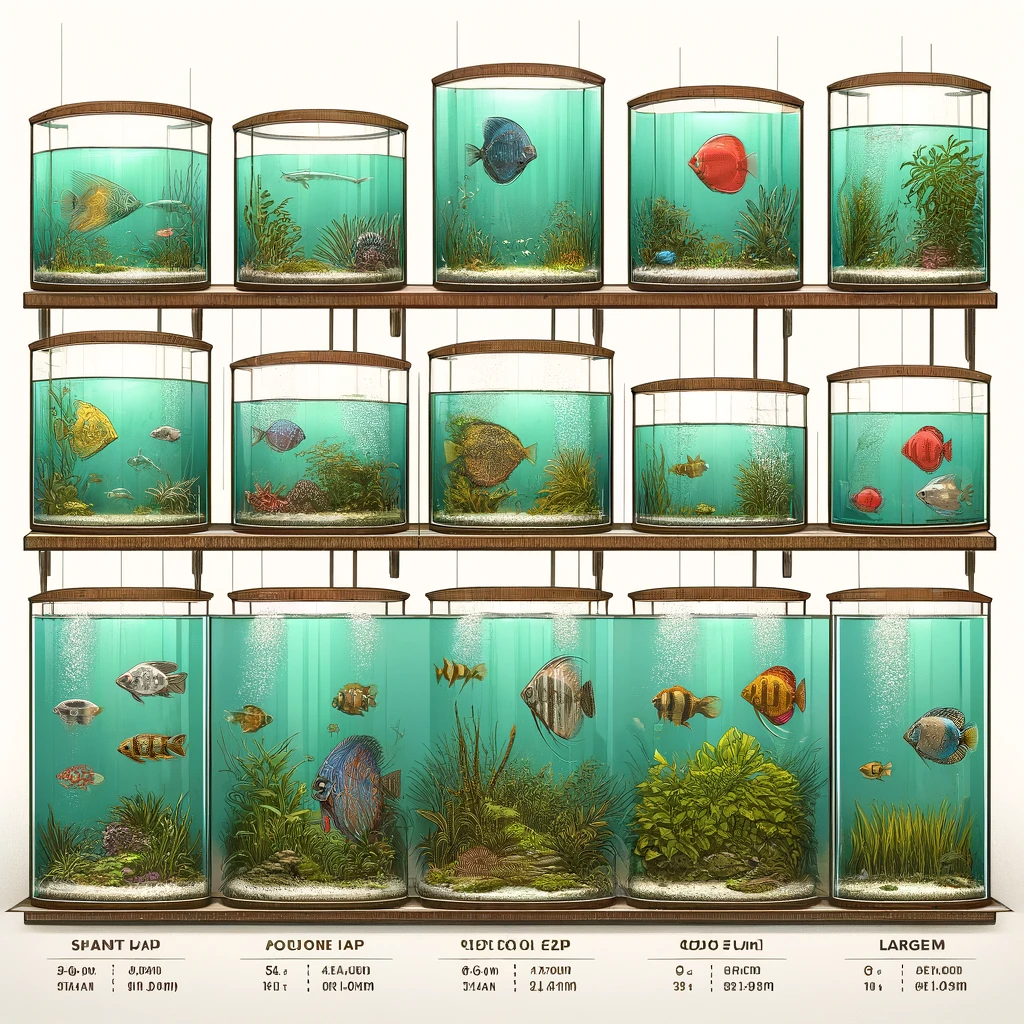
While small to medium tanks are adequate for typical beginner species like guppies, swordtails, and plecos, the needs of larger fish, such as discus, necessitate more space. As fish size and stocking density increase, the demand for space also rises. It’s either advisable to reduce the number of fish or, preferably, to acquire a larger tank.
Discus fish can grow up to 20 cm in length and weigh around 300 grams, requiring a proportionate amount of water to thrive. A recommended aquarium size that aligns closely with these needs would be one measuring 130 x 60 x 60 cm (approximately 468 litres). While smaller aquariums are possible, the minimum should not be less than 120 x 40 x 50 cm (240 liters) or 100 x 50 x 50 cm (250 liters).
The depth of the aquarium is crucial—it should be at least 40 cm, though 50 or 60 cm is preferable, as it significantly enhances the fish’s ability to move freely. Historically, a depth of 40 cm was common when aquariums were designed to fit decoratively into wall units, but greater depth is more functional for the fish.
For beginners, a practical aquarium size starts at 300 litres (e.g., 100 x 50 x 60 cm or 120 x 50 x 50 cm) or even 360 litres (120 x 50 x 60 cm). In a 420-litre aquarium, you can comfortably keep up to 6 adult discus, with a minimum of 4. Such setups can also accommodate several beneficial catfish and companion fish.
For 300-litre tanks (100 x 50 x 60 cm or 120 x 50 x 50 cm), it’s feasible to maintain 4 adult discus, and in 360-litre tanks (120 x 50 x 60 cm), up to 6 adult discus along with some helpful catfish and companion fish can be managed.
In smaller tanks of 240 or 250 litres, you should only keep a pair of discus or a group of juvenile fish. However, bear in mind that such tanks require significantly more maintenance, particularly in terms of water changes. For a group of young fish, a substantial part will need to be rehomed or moved to a larger aquarium after a few months due to their growth and increased needs.
Perfect Home for Your Discus Fish
Looking to create a stunning and thriving environment for your discus fish? Explore these top choices: the Diversa Aquarium Becken with a 300-liter capacity and dimensions of 120x50x50 cm, featuring 8mm thick glass for durability and clarity check it out on Amazon; the larger Diversa Aquarium Becken with a 450-liter capacity, measuring 150x50x60 cm, and constructed with 10mm thick glass for exceptional views and strength check it out on Amazon; and the spacious 576-liter aquarium, with impressive dimensions of 160x60x60 cm and a robust 12mm thick glass design, perfect for a spectacular discus fish display check it out on Amazon. Each of these high-quality aquariums offers the ideal space for your aquatic pets to flourish while adding elegance to any room.
Disclaimer: As an Amazon Affiliate, I earn from qualifying purchases.
Optimal Aquarium Conditions for Discus Fish
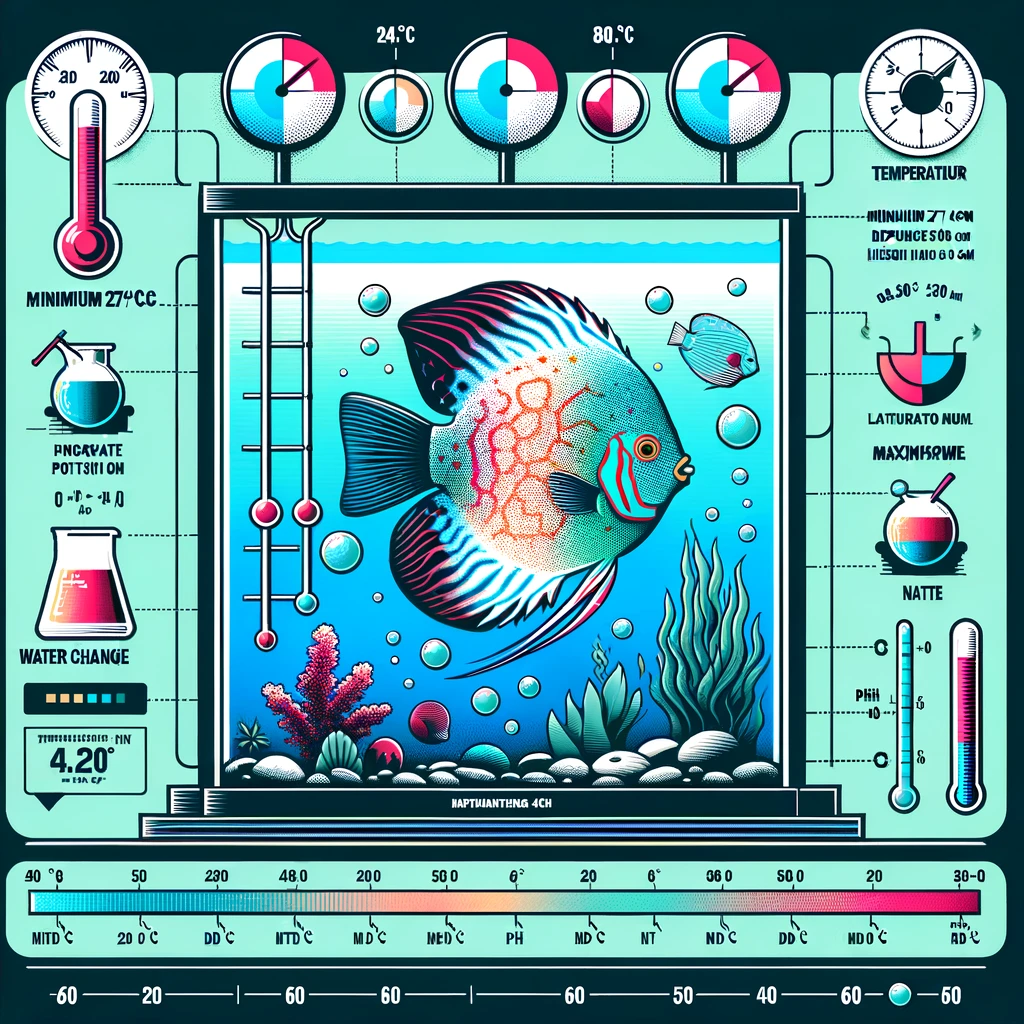
The average values obtained from various sources can serve as recommendations for setting up an ideal discus fish aquarium. These values have been rounded to practical figures for easy implementation:
Aquarium Dimensions and Volume:
- Length: 140 cm
- Depth: 50 cm
- Height: 60 cm
- Volume: 420 liters
Water Parameters:
- Temperature: Minimum 27°C, Average 28°C, Maximum 29°C
- General Hardness (GH): Maximum 9 dGH
- Carbonate Hardness (KH): Maximum 5 dKH
- pH: Minimum 6.0, Maximum 7.0
- Nitrate (NO3): 25 mg/L
- Nitrite (NO2): 0 mg/L
- Phosphate (PO4): 0.2 mg/L
- Iron (Fe): 0.3 mg/L
- Copper (Cu): 0 mg/L
- Carbon Dioxide (CO2): Maximum 20 mg/L
Maintenance and Feeding:
- Water Change: 50% weekly
- Feeding Frequency: 2 to 3 times per day
- Plants: Should constitute about 30% of the aquarium setup
- Space Allocation: 60 litres per discus fish
These guidelines are designed to provide the optimal living environment for discus fish, promoting their health, colour, and longevity. Adjustments may be necessary based on specific local water conditions or the unique needs of your discus fish.
Substrate: Creating a Natural Foundation for Discus Fish
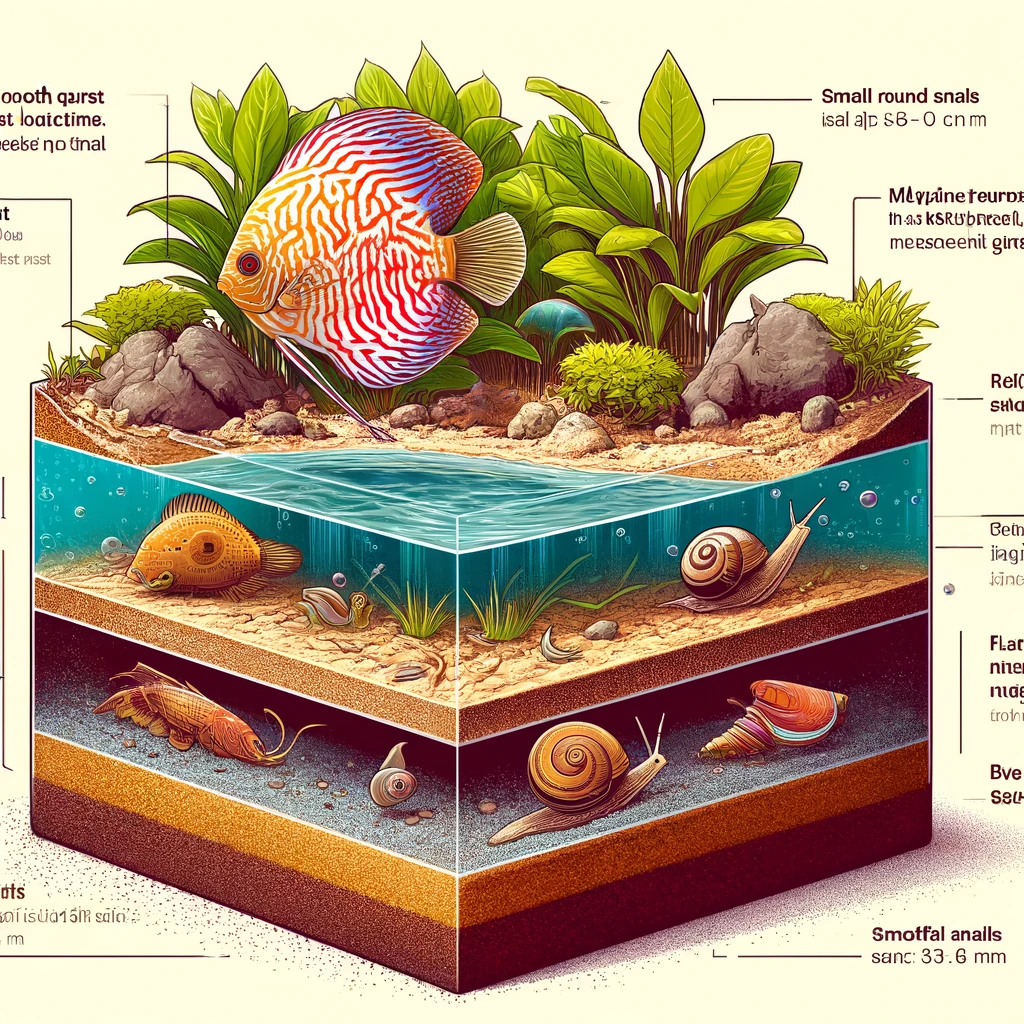
For discus aquariums, sand is the preferred substrate as it closely replicates the natural environment of the discus fish, facilitating their typical feeding behaviors. This is also beneficial for many suitable companion species, like corydoras catfish, which thrive in similar conditions.
Texture and Size: The sand should be smooth and non-abrasive to prevent harm to the fish. For areas with plants, the substrate depth should not be less than 5 cm, ideally around 8 cm. If gravel is used, it should also be smooth and not too coarse to prevent food from getting trapped and causing decay, particularly important since discus are fed multiple times a day with a variety of foods.
Advantages of Sand: Quartz sand with a grain size of 0.3-0.7mm is recommended, available at hardware stores or via wholesalers. One major benefit of sand is the ease of cleaning, as food and waste do not sink deep into the substrate but remain on top, making it easy to vacuum.
Indicator Species: Small round snails, often introduced inadvertently with plants, are not necessarily harmful; they serve as good indicators of overfeeding and water quality. A sudden increase in their population suggests excessive feeding. If they climb up the aquarium glass, it may indicate that water conditions need to be checked, particularly since toxin concentrations are highest near the substrate.
Beneficial Snails: Malaysian trumpet snails are particularly useful as they not only indicate overfeeding but also aerate and stir the substrate, helping to remove any remaining food residues.
If the population of these beneficial snails becomes too large, they can easily be removed during routine substrate vacuuming.
Temperature: Ensuring the Ideal Water Conditions for Discus Fish
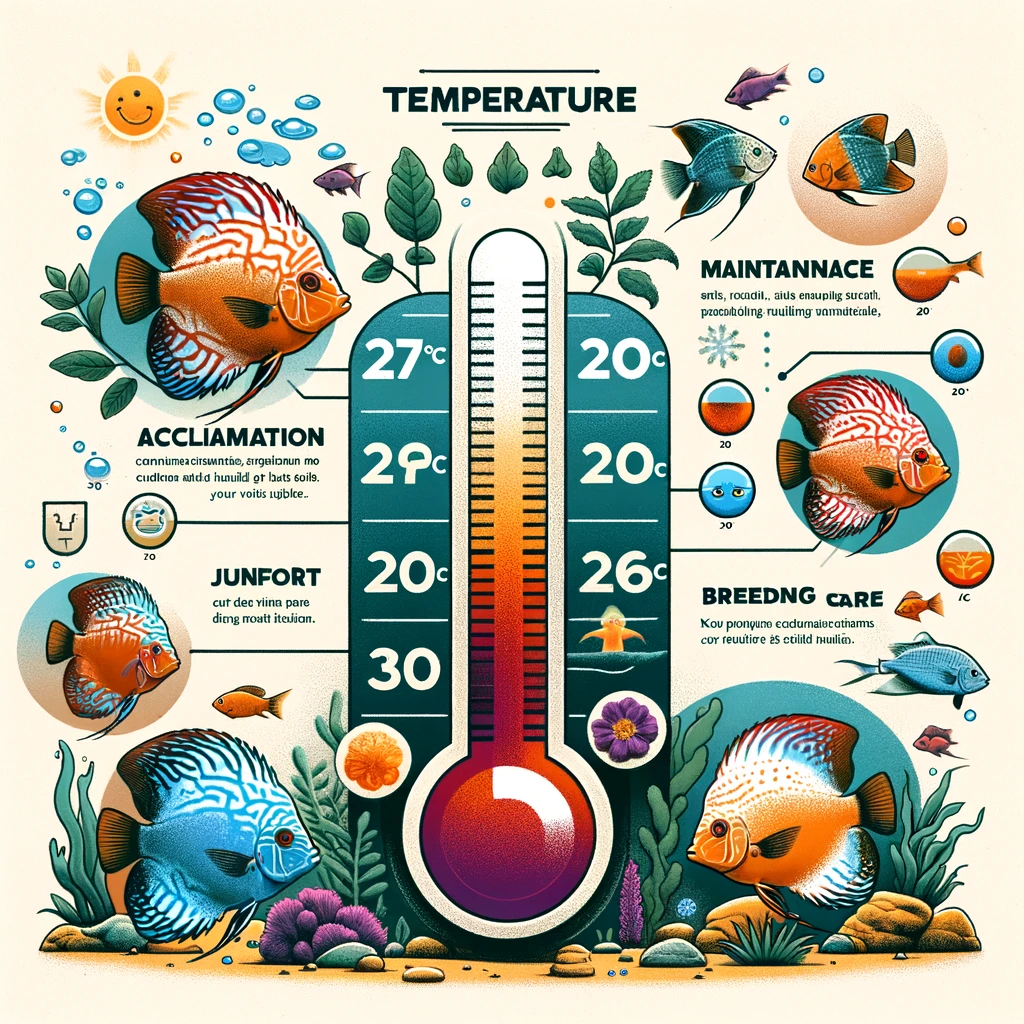
Discus fish thrive in warm water, reflecting their native Amazonian habitat where temperatures range from 27°C to 37°C. However, managing the temperature in a home aquarium requires specific considerations to ensure the health and growth of these tropical fish.
- Acclimation Period: When first introducing discus fish to an aquarium, temperatures should be kept between 30°C and 31°C to ease their transition.
- Standard Maintenance Temperature: The optimal range for maintaining adult discus fish is between 28°C and 29°C. This temperature not only supports the health and comfort of discus fish but also allows for the growth of many aquarium plants, which is crucial for creating a balanced ecosystem in home aquariums.
- Ideal Comfort Temperature: Discus fish are most comfortable at temperatures of 30°C to 31°C. This range has been observed to help prevent diseases.
- Considerations for Juveniles: For juvenile discus, due to their intensive feeding regimes, temperatures at the higher end (around 30°C to 31°C) may cause increased respiration and potentially lead to gill damage. Therefore, a slightly cooler temperature of around 28°C is recommended for raising young discus.
- Breeding Temperature: The ideal temperature for breeding discus fish is around 32°C. Fluctuating temperatures within a safe range can stimulate spawning behaviour in discus pairs.
It’s important to note that higher water temperatures can reduce oxygen levels, which poses a challenge for maintaining optimal conditions. Regular monitoring and adjustments based on the specific needs of your fish are essential to sustain a healthy discus aquarium.
Maintain Perfect Water Temperature with JBL ProTemp s300 Aquarium Heater
Ensure your aquarium’s water temperature is always just right with the JBL ProTemp s300 Aquarium Heater, designed for both freshwater and marine aquariums with a capacity of 160 to 400 litres. This reliable heater is easy to install and features a precise temperature control dial, allowing you to set the desired temperature between 20°C and 34°C with an accuracy of ±0.5°C. Made with TÜV-certified, waterproof, and shatterproof quartz glass, the ProTemp s300 offers exceptional safety and durability. Its star-shaped ceramic heating element ensures optimal heat distribution throughout your tank. Enhance your aquarium’s environment effortlessly and keep your fish healthy and happy with this top-rated heater.
Check it out on Amazon and ensure the best care for your aquatic pets with the JBL ProTemp s300.
Disclaimer: As an Amazon Affiliate, I earn from qualifying purchases.
Filtration: Essential for Maintaining a Healthy Discus Aquarium
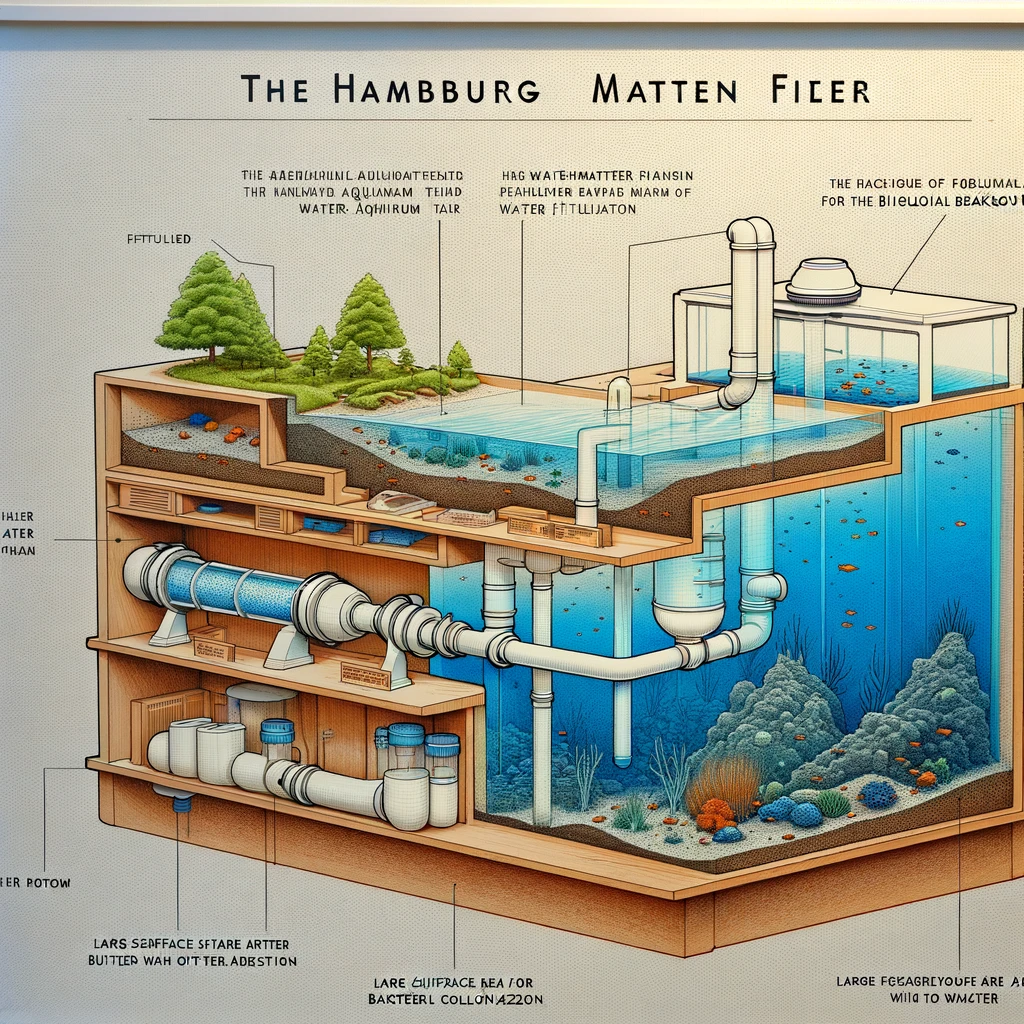
In nature, several cubic meters of water per fish help maintain a clean environment, but this ratio is impossible to achieve in home aquariums. Thus, appropriate filtration based on tank size is crucial to compensate for the reduced natural cleaning capacity.
- High Bioload: Discus tanks face high bioload due to frequent feeding and the resulting waste. Traditional filter systems often focus more on mechanical filtration rather than biological, which might not be sufficient for the waste produced by discus fish.
- Recommended Filtration Systems:
- Built-in Sump Filters: These are typically integrated into the aquarium stand and provide excellent filtration. They allow for large volumes of water to be processed and are easier to maintain due to their accessibility.
- Hamburg Mattenfilter (HMF): Known for its simplicity and effectiveness, the Hamburg Mattenfilter offers a large surface area for bacterial colonization, crucial for the biological breakdown of pollutants. This type of filter is easy to install and has proven to be highly effective in managing the waste produced by discus fish.
For a discus aquarium, ensuring robust and efficient filtration is vital to emulate the clean, balanced environment needed for the health and well-being of the fish.
Functions of an Aquarium Filter
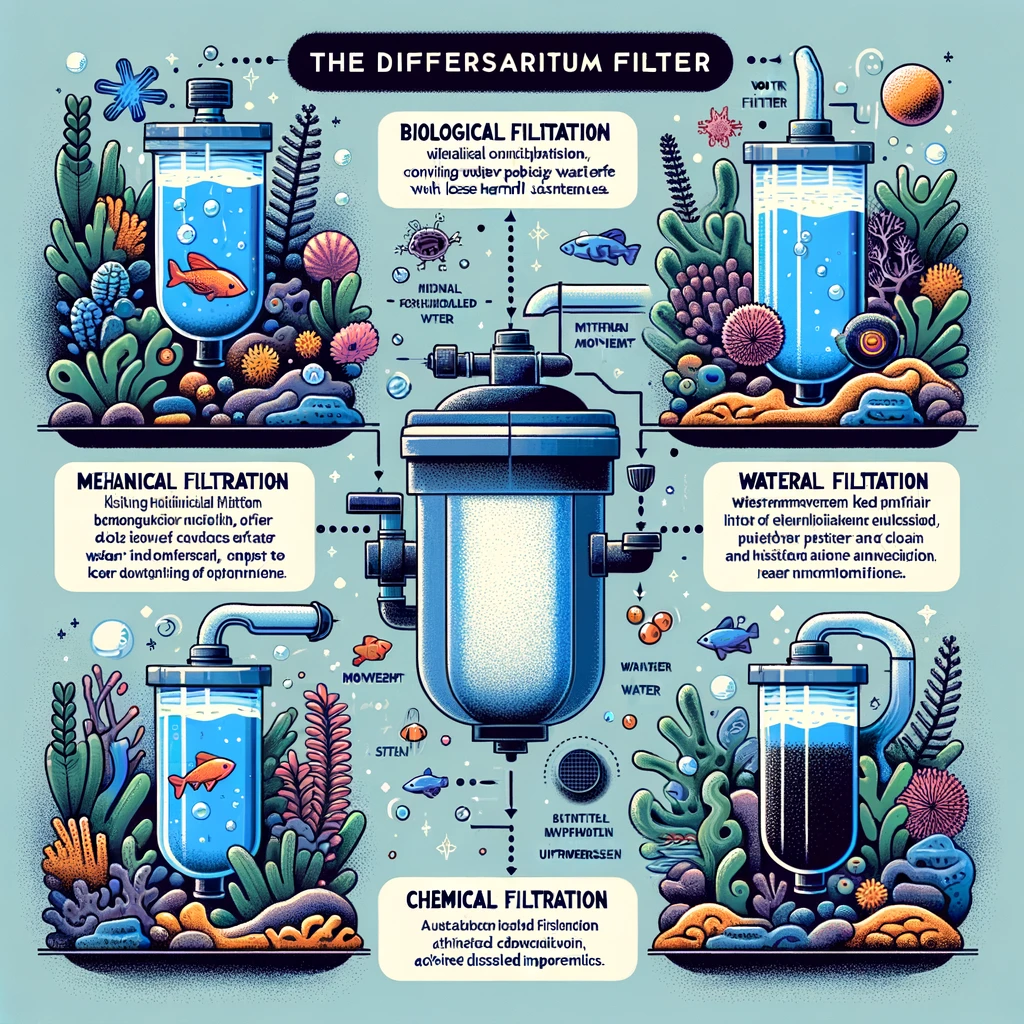
An aquarium filter performs several critical tasks to maintain the health and clarity of the water, essential for both the inhabitants and the aesthetic appeal of the tank.
Biological Filtration: This is arguably the most crucial function of a filter. Biological filtration involves the breakdown of organic wastes such as food remnants, faeces, and urine by different bacteria. For instance, toxic nitrite is converted into less harmful nitrate. Some specialized slow-moving external filters with low-oxygen zones can even break down nitrate further.
Mechanical Filtration: This process involves the removal of suspended particles from the aquarium water, ensuring that the tank remains visually appealing. Without effective mechanical filtration, the water would become cloudy and detract from the beauty of the aquarium.
Water Movement: Proper water circulation is necessary to distribute essential nutrients throughout the tank and cater to the needs of current-loving species like catfish. Additionally, adequate water flow ensures even distribution of heat within the tank, preventing the formation of cold spots that could harm the aquatic life.
Chemical Filtration: Another vital aspect of filtration, chemical filtration alters the water’s chemical composition. Using activated carbon, dissolved compounds are absorbed and trapped in the filter media, which helps remove odours, discolouration, and various contaminants.
Each type of filtration contributes to creating a stable and healthy environment for fish and plants, mimicking their natural habitats as closely as possible within the confines of an aquarium.
Sponge Filters: Assessing Their Suitability for Aquariums
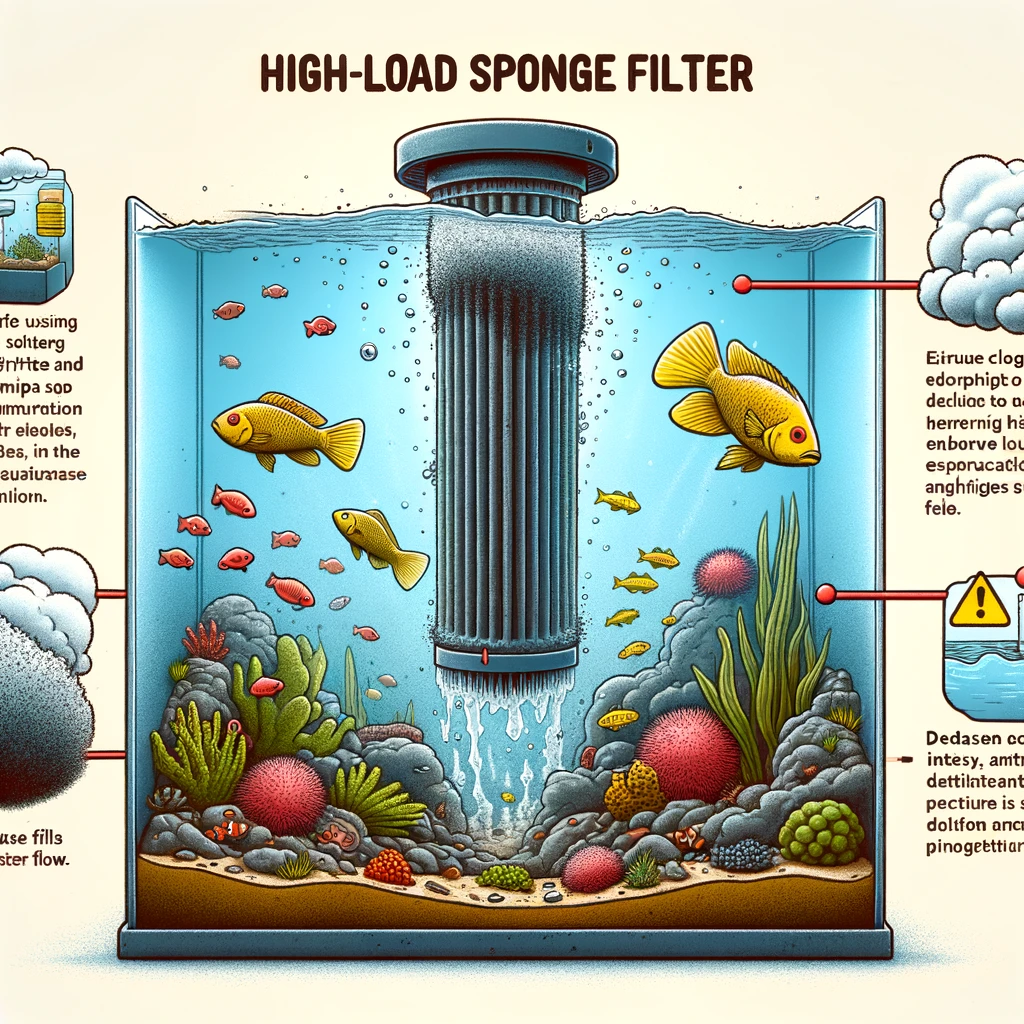
Sponge filters, despite their popularity in certain aquarium setups, have significant limitations that may render them unsuitable for maintaining healthy water quality, especially in tanks with high bioloads like those housing discus fish.
- Limited Filter Volume: Sponge filters have a relatively small filter volume, which can become quickly saturated with waste.
- Frequent Maintenance Required: They require regular cleaning to prevent clogging. When clogged, their effectiveness at maintaining water flow and facilitating the biological breakdown of nitrites and ammonia is significantly reduced.
- Reduced Flow and Filtration Efficiency: With increased waste and reduced flow, the biological process essential for converting harmful substances like nitrites and ammonia into less harmful compounds can be compromised.
- Increased Risk of Disease: As the effectiveness of the filter declines, the accumulation of waste can lead to a rise in pathogen levels in the water, putting the fish at a higher risk of infection and potentially leading to increased mortality.
Given these challenges, it’s crucial to consider whether the convenience of sponge filters outweighs their potential risks, particularly in setups that require robust filtration to maintain optimal water quality.
External and Internal Filters: Popular Choices Among Aquarists
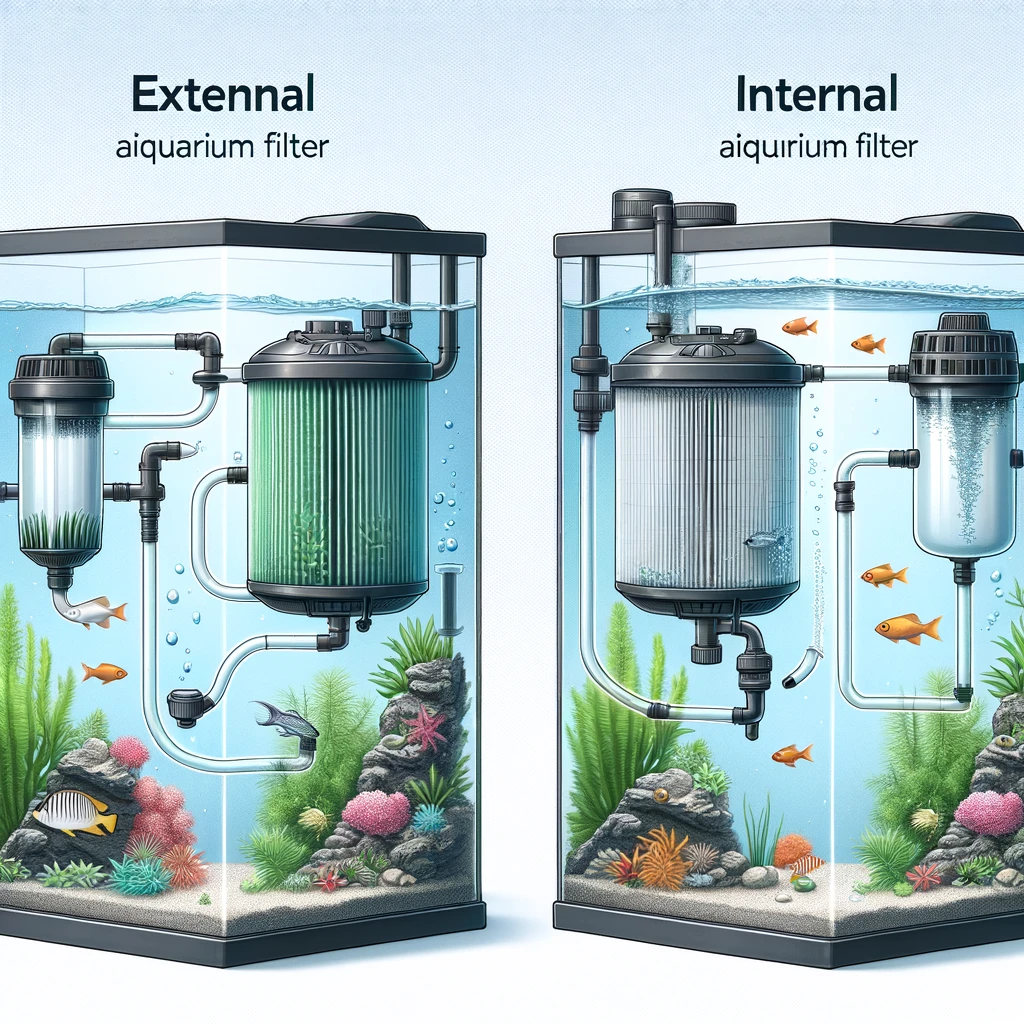
External and internal filters are widely favoured by aquarists due to their ease of use, affordability, and compact design. These filters are readily available and can fit well in various aquarium setups. When properly sized, they can provide excellent results.
- Ease of Maintenance: Both external and internal filters are known for their simple maintenance routines.
- Cost-Effectiveness: These filters are generally less expensive compared to more complex systems.
- Space Efficiency: Designed to be compact, they do not take up much space within the aquarium.
- Performance: Achieving good filtration performance depends crucially on selecting the right size. Oversizing the filter slightly can often yield better results as it provides a more robust filtration capacity.
- Filter Media: The choice of filter media is critical for optimizing performance. I have found Siporax to be an excellent biological filter media due to its high surface area, which effectively supports beneficial bacterial growth and enhances the biological filtration process.
By choosing a slightly oversized filter and using high-quality filter media like Siporax, aquarists can significantly improve the effectiveness of their filtration system, ensuring cleaner and healthier water for their aquatic inhabitants.
Superior Filtration for Your Aquarium: Eheim Professionel 4+ 350 External Filter
Upgrade your aquarium’s filtration system with the Eheim Professionel 4+ 350 External Filter. Designed for aquariums up to 350 liters, this high-performance filter ensures crystal-clear water and a healthy environment for your aquatic pets. The Eheim Professionel 4+ 350 features innovative technology, including an integrated “Xtender” button for extended maintenance intervals and a self-priming function for easy setup. With its multi-stage filtration process, this filter efficiently removes debris, harmful substances, and impurities, while promoting beneficial bacterial growth. Its quiet operation and energy efficiency make it an excellent choice for any aquarist seeking reliability and ease of use.
Check it out on Amazon and give your aquarium the professional-grade filtration it deserves.
Ultimate Filtration Power: Fluval FX6 High-Performance External Filter for Large Aquariums
For aquariums up to 1,500 liters, the Fluval FX6 High-Performance External Filter offers unparalleled filtration power and efficiency. This robust multi-stage filter is designed to provide crystal-clear water and a healthy environment for your aquatic inhabitants. With a massive 20-liter filter media capacity, the FX6 ensures thorough mechanical, chemical, and biological filtration. Key features include an integrated maintenance reminder, a synchronized motor for enhanced performance and energy efficiency, and an easy self-priming system for hassle-free setup. Whether you have a freshwater or marine aquarium, the Fluval FX6 delivers reliable, top-tier filtration to keep your aquatic ecosystem in optimal condition.
Disclaimer: As an Amazon Affiliate, I earn from qualifying purchases.
Maximize Your Aquarium’s Biological Filtration with Sera Siporax Filter Media
Enhance your aquarium’s water quality with the Sera Siporax Aquarium Filter Media. This high-performance bio-filter medium is designed to optimize biological filtration, providing a 34-times higher degradation performance compared to conventional clay filters. With a volume of 1000 ml (290g), Sera Siporax Professional offers an exceptionally porous structure, providing an optimal surface area for beneficial bacteria to thrive. This filter media is versatile and can be used in fast, slow, and trickle filters, as well as in all internal and external filters. Its long-lasting, self-cleaning properties ensure efficient and effective filtration, maintaining a healthy and clear aquatic environment for your fish.
Check it out on Amazon and improve your aquarium’s filtration system with Sera Siporax Professional.
Disclaimer: As an Amazon Affiliate, I earn from qualifying purchases.
Sump Filters and Hamburg Mattenfilter: High-Efficiency Filtration Solutions
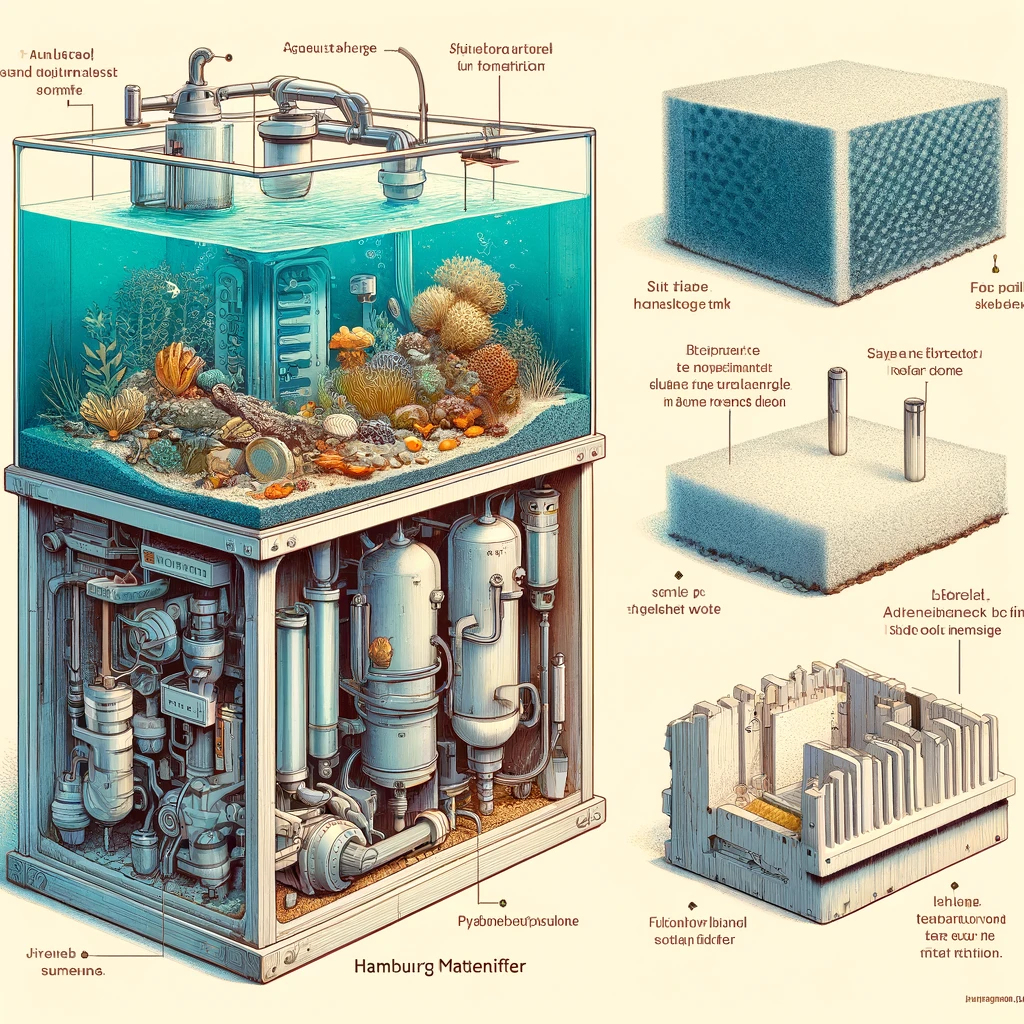
Sump filters and hamburger matten filters (HMF) are among the most effective filtration systems available for aquariums. Each system offers unique benefits that can significantly enhance the biological filtration capacity of your setup.
Sump Filters: Often integrated into the aquarium stand, sump filters feature multiple chambers that can be filled with various filter media and foam pads. This setup provides an extensive surface area for the colonization of nitrification bacteria, far surpassing the capabilities of more conventional filters. Properly filled and maintained, these systems are highly efficient at processing and reducing pollutants in the aquarium.
Hamburg Mattenfilter (HMF): This system utilizes a simple polyurethane foam wall to create optimal conditions for bacteria that break down harmful substances. The design of the HMF offers significant biological filtration benefits through ample surface areas for bacterial colonization.
Considerations:
- Space and Aesthetics: The main drawback of the HMF is its large space requirement and less appealing visual presence within the tank.
- Efficiency Over Time: Both types of filters reach peak efficiency after approximately three months of operation, following a proper cycling period.
These advanced filtering solutions are excellent for aquarists seeking robust, long-term filtration capacity to maintain healthy and stable water conditions for their aquatic life.
Trickle Filters: High Efficiency in Pollution Control
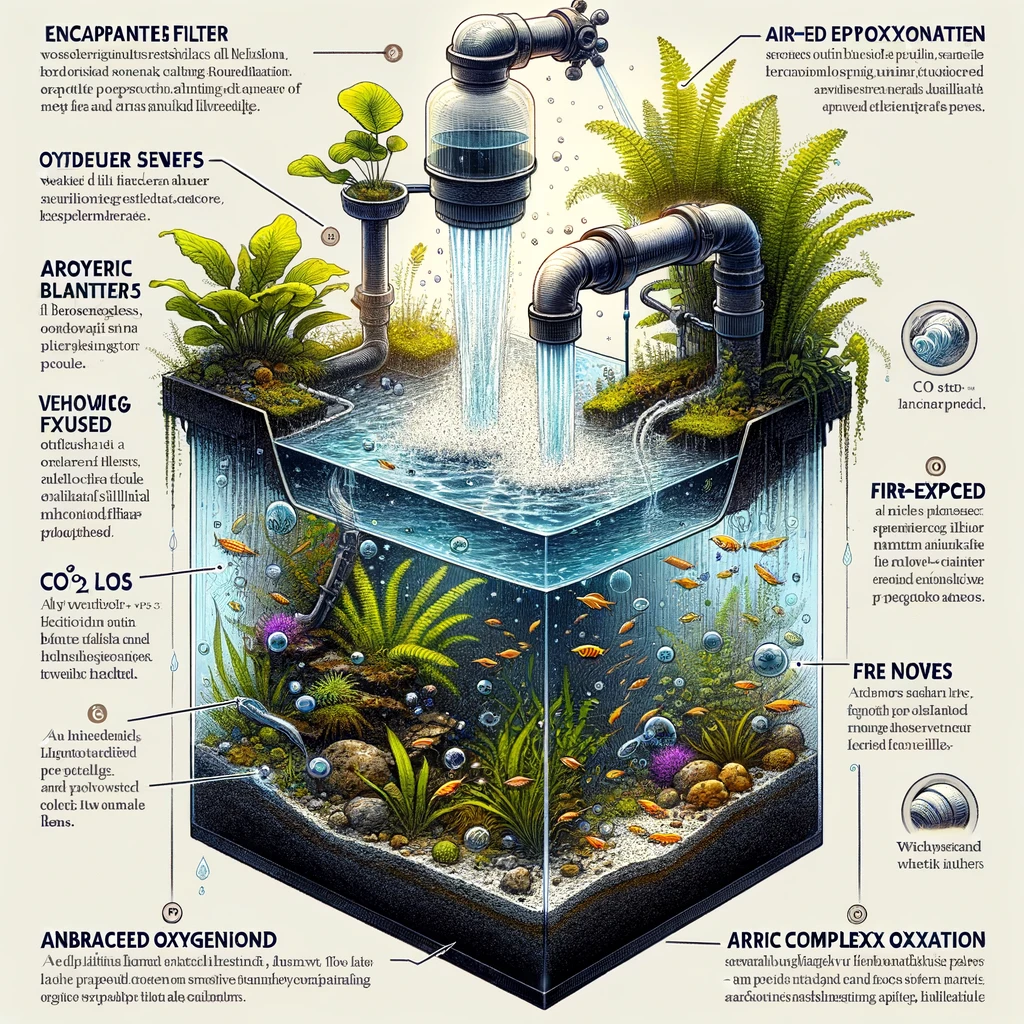
Trickle filters are known for their exceptional effectiveness in supporting bacterial growth and decomposing pollutants. They are easily integrated into existing filtration systems and operate in an oxygen-rich environment, which is inhospitable to undesirable bacterial strains such as decay bacteria, making them highly effective aerobic systems.
Operation: In a trickle filter, water is applied to the filter substrate and flows or drips down through the air-exposed filter media into a collection basin. From there, it is pumped back into the aquarium. This constant exposure to air greatly enhances the oxygenation of the water.
Considerations:
- Impact on CO2 and Nutrients: While advantageous for aerobic bacterial activity, the process can drive off CO2 essential for plant growth and can make essential iron complexes insoluble due to oxidation, potentially hindering plant growth.
- Mitigation: Regular fertilization can counteract the reduction in CO2 and available iron, helping to sustain plant health and growth.
Trickle filters are particularly beneficial in systems where high levels of biological filtration are necessary, but they require careful management to balance their effects on the entire aquarium ecosystem, especially in planted tanks.
Roots in Discus Aquariums: Benefits and Precautions
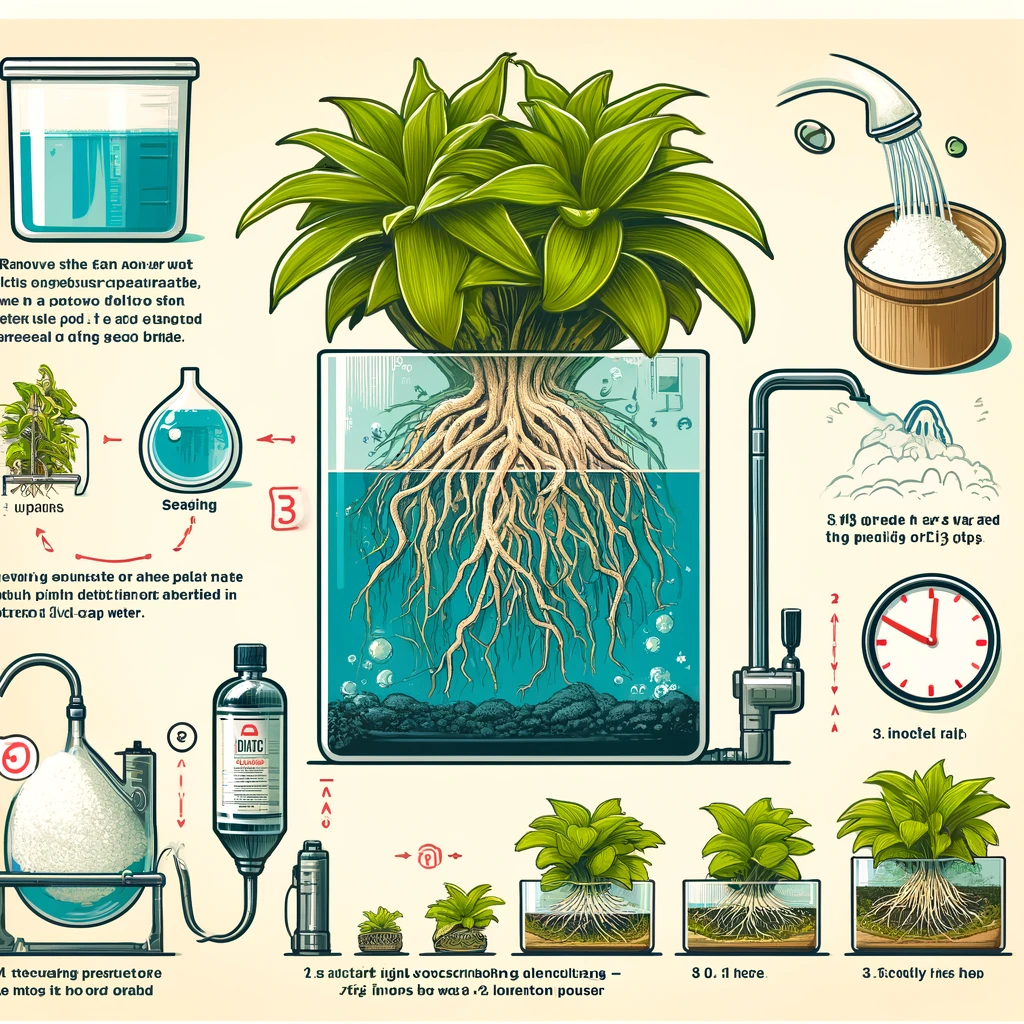
Roots provide excellent hiding and shelter for discus fish, making them a popular choice for enhancing the natural environment within the aquarium. However, it is essential to select the right types of roots, typically available through specialized aquarium shops, to ensure the health and comfort of the fish.
Suitable Root Types: Only specific types of roots should be used in discus tanks, which can be sourced reliably from pet and aquarium speciality stores.
Concerns Over Decay: There is often concern that roots can release decay substances into the water, potentially harming the discus fish. To address these issues, an effective pretreatment method for the roots is crucial.
Alternative to Boiling: Contrary to some recommendations, boiling the roots may not be ideal as it can cause the wood to expand and crack, thereby increasing its reactive surface area which could leach more tannins and other compounds into the water. Instead, a recommended method involves using osmotic pressure to treat the roots:
- Osmotic Treatment: Remove the root from the aquarium and soak it in a high-concentration salt solution (non-iodized) — 500 grams of salt per 15 litres of tap water for 2-3 days. This process helps to mitigate issues such as floating, fungal growth, or excessive release of humic acids.
- Rinsing: After soaking, thoroughly rinse the roots with clean water before placing them back into the aquarium.
This pretreatment method helps ensure that the roots do not adversely affect water quality while still providing the aesthetic and functional benefits desired in a discus aquarium.
Lighting and Illumination in Aquariums
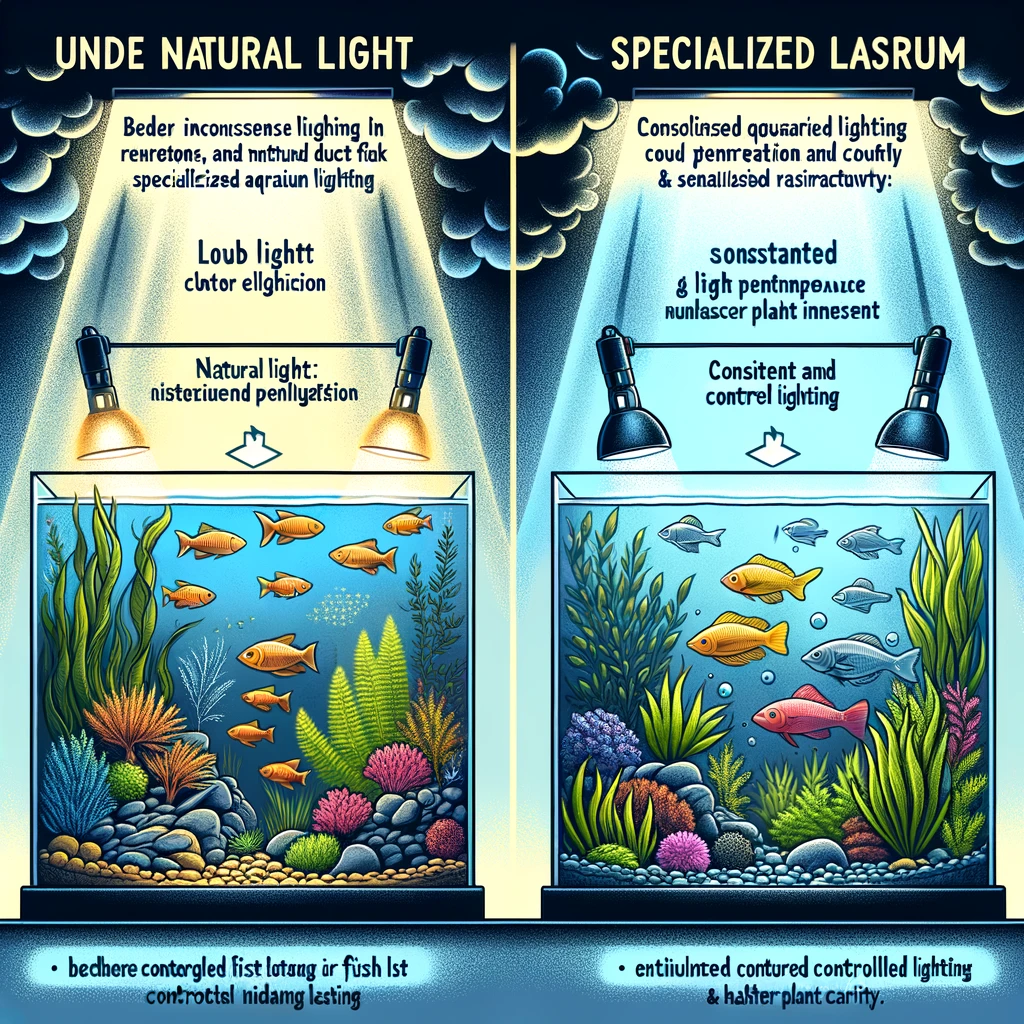
Light serves as the “engine” for plants, which synthesize their nutrients from sunlight, water, and carbon dioxide (CO2). Choosing the right light source for aquarium inhabitants is not only essential for the success of our hobby but also significantly enhances the visual quality of our aquariums.
Limitations of Natural Light: In many regions, the natural sunlight is often insufficient and unreliable for aquarium use. This is why aquarists must look for alternative lighting solutions. The old practice of placing an aquarium near a window has become obsolete with today’s technology, which offers solutions for almost any lighting requirement.
Adjustability and Control: Unlike natural sunlight, which can vary in intensity and duration throughout the day and across different weather conditions, aquarium lighting can be controlled and adjusted to provide consistent, appropriate conditions for the tank’s inhabitants.
Replicating Natural Environments: The lighting in natural habitats is more complex than the consistent illumination provided by most aquarium lights. In nature, biotopes often have shaded areas near shores and brightly lit zones where sunlight directly reaches. The light that hits the water at an angle during sunrise and sunset is largely reflected and does not penetrate deep into the water.
Variability: Just as outdoor conditions vary with sunny, cloudy, and rainy days, aquarium lighting should ideally mimic these natural dynamics to some extent, providing benefits to both plants and fish.
Proper aquarium lighting is crucial for simulating natural conditions, promoting plant growth, and ensuring the health and visibility of aquarium residents.
Illuminate Your Aquarium with Fluval AquaSky 2.0 LED Lighting
Enhance the beauty of your freshwater aquarium with the Fluval AquaSky 2.0 LED Lighting, designed for tanks measuring 115 to 145 cm. This 33W LED system offers customizable, high-quality lighting with Bluetooth control, allowing you to program a 24-hour lighting cycle tailored to your aquarium’s needs. The Fluval AquaSky provides even illumination over 120° and is rated IP67 for water resistance, ensuring durability and safety. Developed in Germany, this lighting solution not only improves the aesthetic appeal of your aquarium but also promotes the health and growth of your aquatic plants and fish.
Check it out on Amazon and transform your aquarium with Fluval AquaSky 2.0.
Disclaimer: As an Amazon Affiliate, I earn from qualifying purchases.
How Should a Discus Aquarium Be Lit?
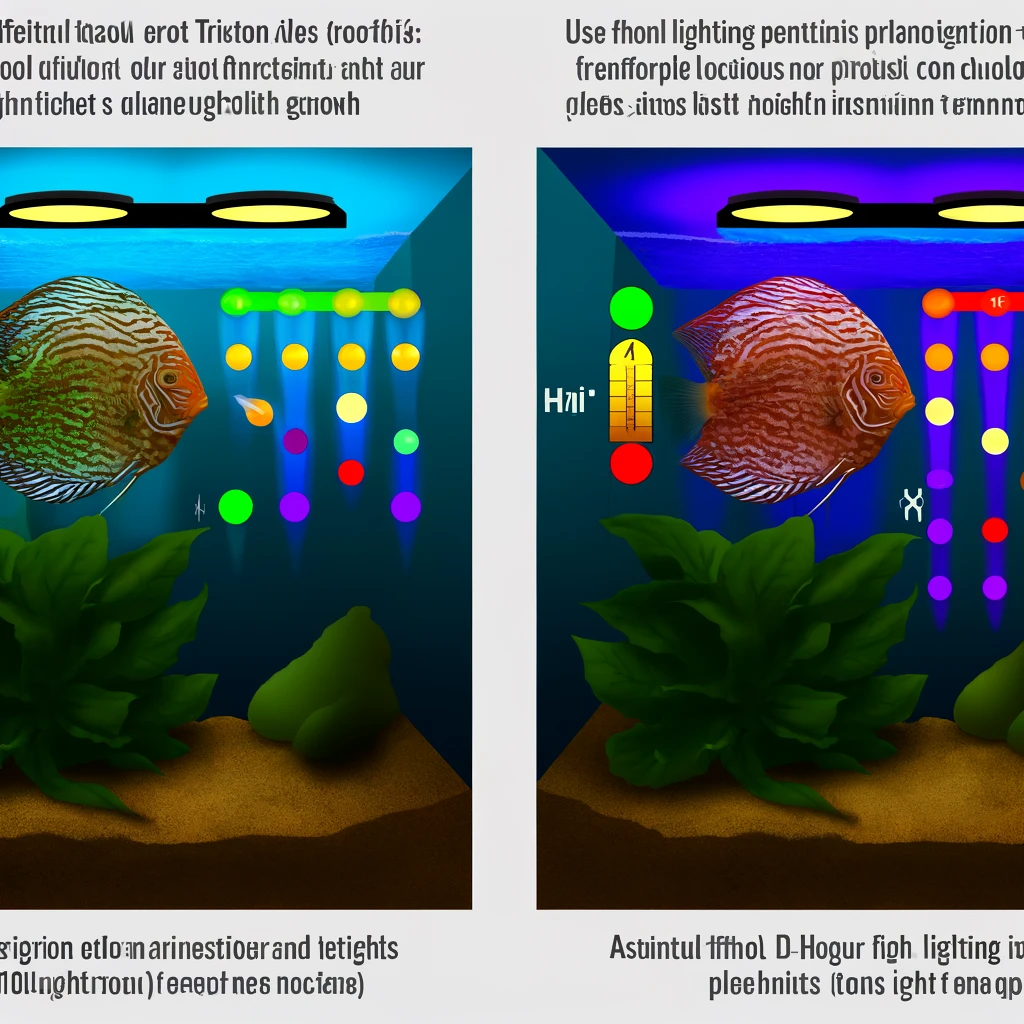
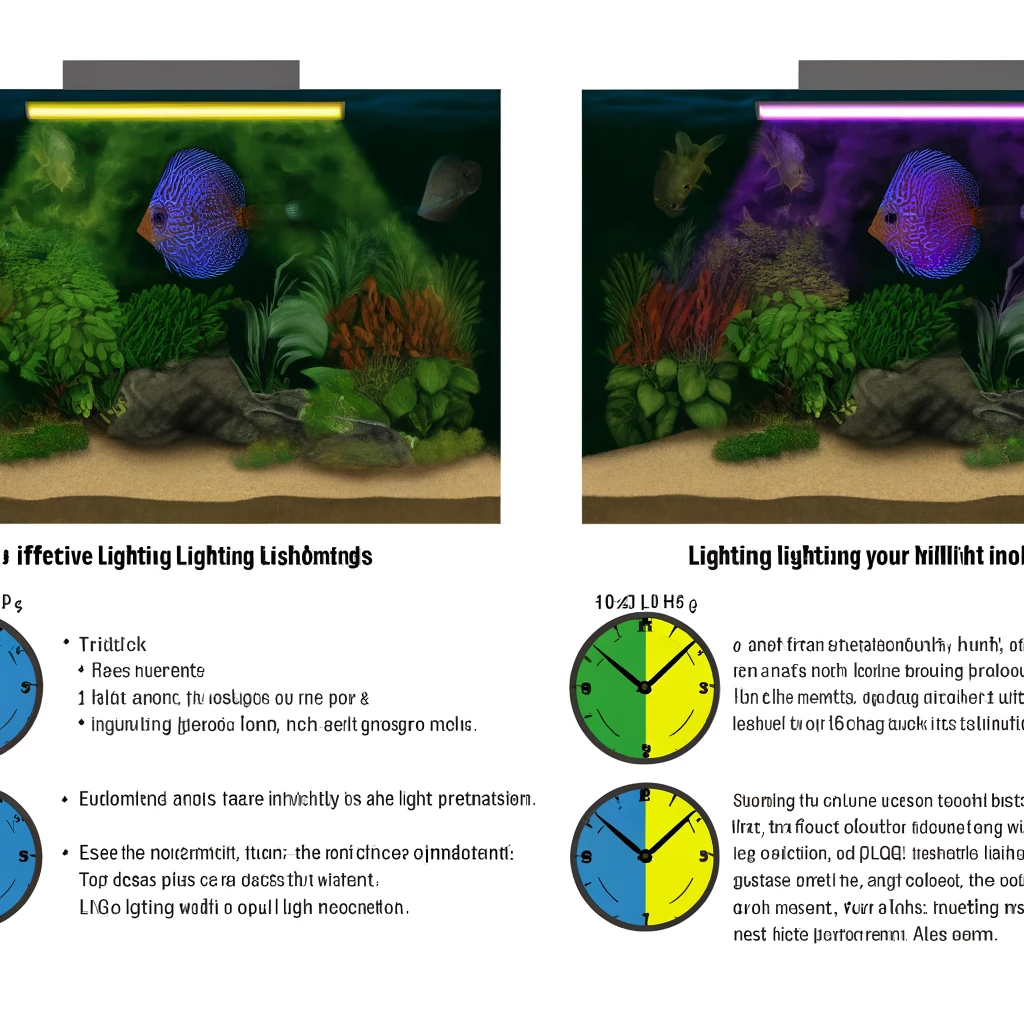
Effective aquarium lighting is crucial for showcasing the vibrant colours of discus fish while controlling algae growth. Here are some considerations and recommendations for lighting a discus tank:
Lighting Options: Fluorescent tubes or HQI/HQL (metal halide) lamps are commonly used. For cost-efficiency, fluorescent tubes are recommended. A specific type, such as the TRITON tube, is ideal as it naturally enhances the colours of the fish and inhibits algae growth.
Lighting Intensity and Fish Behavior: Contrary to what some might assume, bright lighting does not necessarily disturb discus fish. Brighter tanks reduce the perception of threatening shadows outside the tank, which can decrease the fish’s flight response. Discus fish exhibit their most vibrant colours in bright light, akin to natural sunlight. However, direct sunlight can promote excessive algae growth.
Lighting Schedule: My display tank (150x50x60 cm) is illuminated with two 125W HQL lamps for 10 hours daily with specific timings:
- 11:00 AM to 4:00 PM
- Pause from 4:00 PM to 6:00 PM
- 6:00 PM to 11:00 PM
The two-hour midday break is beneficial as algae do not thrive well under fluctuating light conditions and helps in algae prevention.
Natural Lighting Conditions: In the Amazon basin, where discus originate, the light is quite diffused yet intense due to the proximity to the equator. Though daylight lasts 10-12 hours, the effective lighting time that penetrates the water is much shorter due to the shallow angle of sunlight during the morning and evening.
Plant and Algae Preferences: Higher plants, including common aquatic plants, prefer light with longer wavelengths (red spectrum), while algae favour blue light. Special anti-algae fluorescent tubes with a UV-blocking filter can help manage algae growth. It’s crucial to replace ageing bulbs as their light spectrum and intensity can shift over time, reducing effectiveness and potentially enhancing algae growth.
Lighting Duration: It’s advisable not to exceed 11 hours of lighting per day, as aquatic plants typically complete their photosynthesis within 10 hours; additional lighting mainly benefits algae.
UV Sterilizers: Enhancing Water Clarity and Health
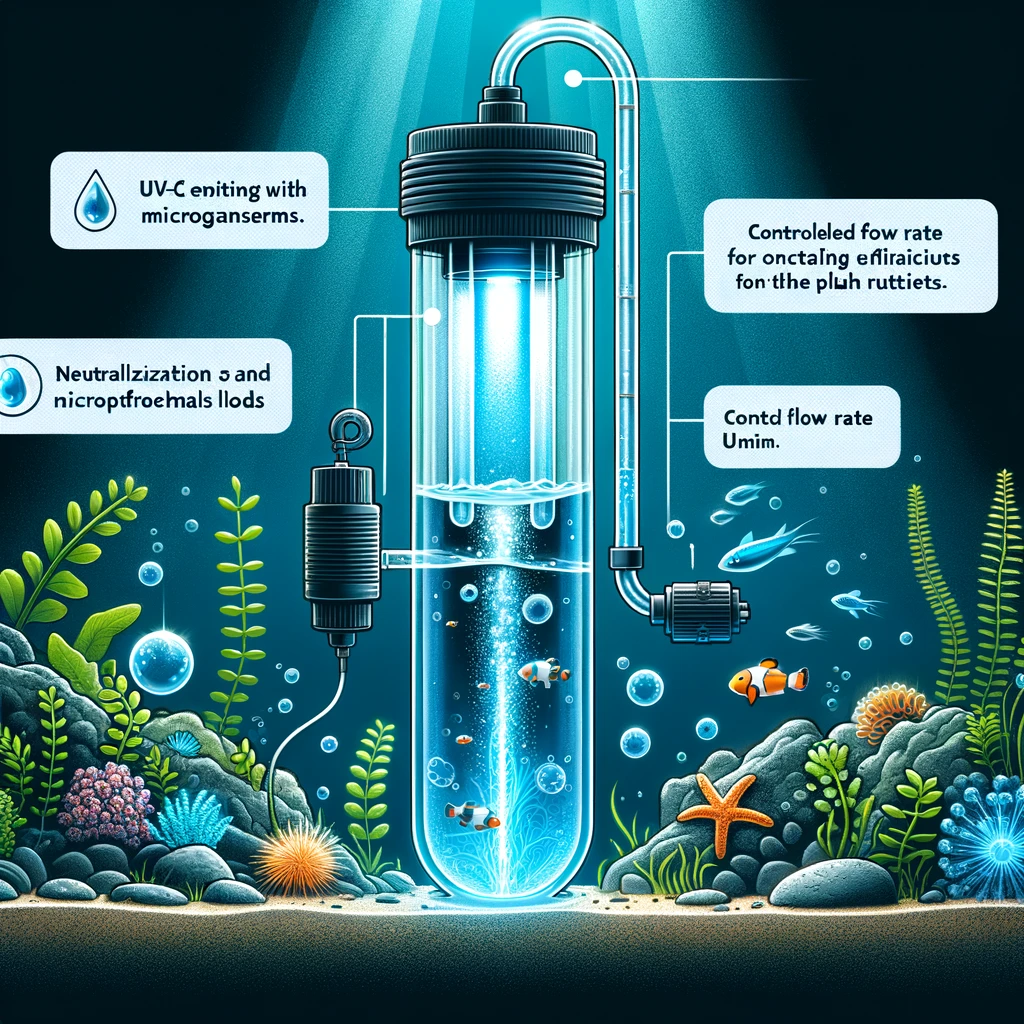
UV sterilizers are not filters but are critical tools used to enhance water quality by reducing turbidity and microbial and algal loads. They are especially useful in preventing fungal infections on fish eggs.
How It Works: UV sterilizers operate by passing water through a quartz glass tube that contains a UV-C emitting compact fluorescent lamp. As water flows through this tube, microorganisms are exposed to UV-C radiation, which effectively neutralizes them. This process helps significantly reduce the microbial count in the aquarium without the use of chemicals, thus lowering the risk of infections.
Benefits:
- Chemical-Free: Utilizes UV-C light to control pathogens, eliminating the need for chemical treatments in maintaining water hygiene.
- Infection Control: Reduces the infection pressure by damaging live bacteria and fungi in the water.
Considerations:
- Lamp Lifespan: The lifespan of the UV lamp is limited; it typically needs replacement annually if operated continuously.
- Flow Rate: Optimal results are achieved with slower water flow through the sterilizer, allowing prolonged exposure to the UV light.
- Impact on Nutrients: One downside noted is the potential destruction of essential iron compounds needed by plants, which may necessitate daily dosing of nutrients if plants are present in the tank.
Personal Experience: Due to having a heavily planted tank and performing weekly substantial water changes while providing optimal conditions for the inhabitants, the need for a UV sterilizer may be mitigated. Additionally, the extra energy consumption of the UV lamp is a consideration.
Keep Your Aquarium Crystal Clear with Coospider-Repta UV Sterilizer
Maintain pristine water quality in your aquarium with the Coospider-Repta UV Sterilizer. Available in 5W, 7W, and 11W options, this powerful device uses UVC light to effectively eliminate green algae and harmful microorganisms, ensuring a crystal-clear and healthy environment for your aquatic life. The Coospider-Repta UV Sterilizer is designed with efficient algae control in mind and features a durable, waterproof construction that allows for complete submersion. Easy to use and maintain, this UV sterilizer is a must-have for any aquarium, pond, or waterfall setup. Remember to avoid direct exposure to UV light for safety.
Disclaimer: As an Amazon Affiliate, I earn from qualifying purchases.
CO2 Fertilization in Aquariums
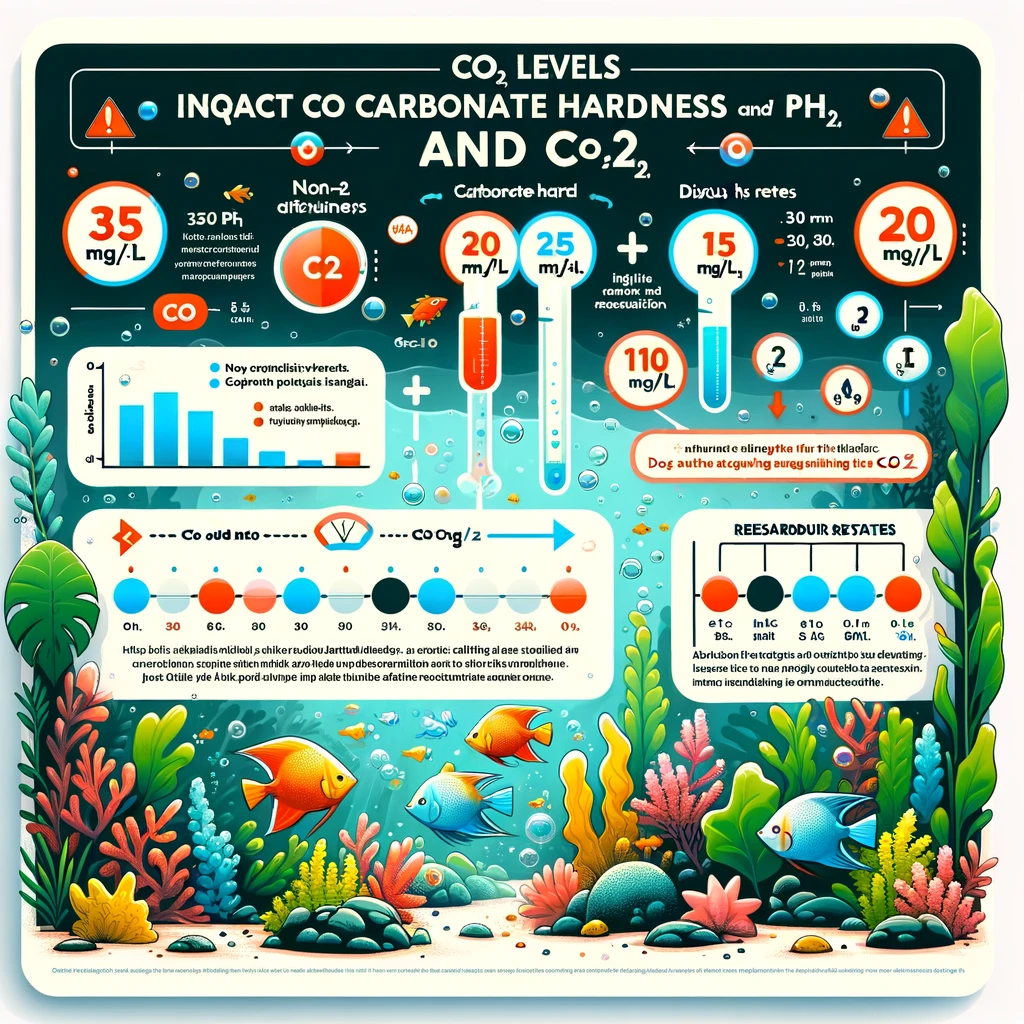
CO2 fertilization systems are commonly used in aquariums to manage the pH level. Some charts relate pH levels to carbonate hardness (KH) and indicate the corresponding CO2 levels needed.
CO2 Levels and pH Adjustment: These charts demonstrate that higher levels of carbonate hardness require more CO2 to acidify the water effectively. This is due to the buffering capacity of the water, which neutralizes acidity and stabilizes pH.
Impact on Discus Fish: For discus aquariums, it is crucial to monitor CO2 levels closely. When CO2 concentrations exceed 15 mg/L, it can lead to increased respiratory rates in discus fish, indicating stress. This condition can heighten their susceptibility to diseases due to the stress involved.
Optimal CO2 Levels: In non-discus aquariums, the optimal CO2 concentration is around 35 mg/L, with the pH being slightly acidic to alkaline. This level supports robust plant growth while maintaining water conditions that are generally safe for most tropical fish.
Management and Monitoring: Effective CO2 fertilization requires careful monitoring and adjustment based on water chemistry tests to ensure the health of both plants and fish. Using a CO2 system helps enhance plant growth and can improve the overall health and appearance of the aquarium.
Carbon Dioxide (CO2) in Aquariums
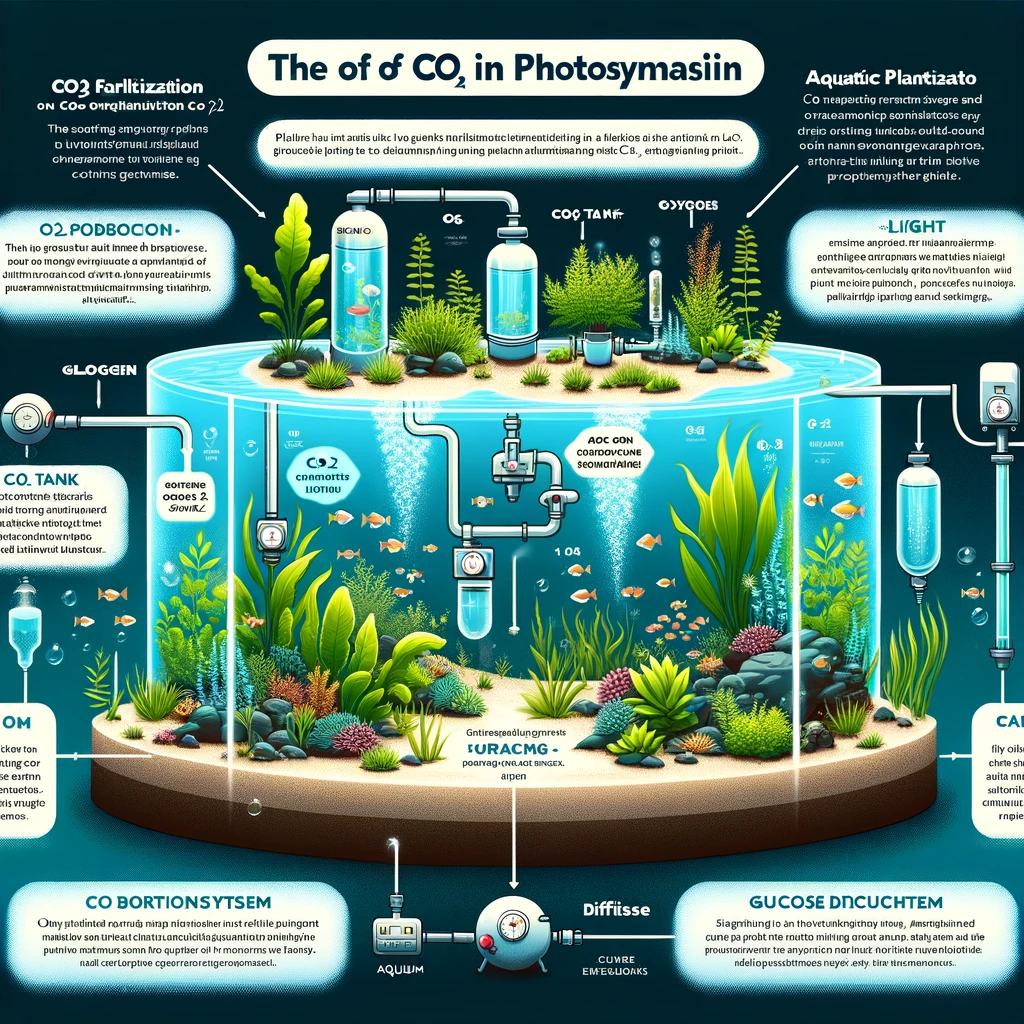
The image you provided appears to be a table showing the relationship between carbonate hardness (KH), pH levels, and CO2 concentration in aquarium water. This table is particularly useful for aquarists who need to adjust CO2 levels in their tanks to promote healthy plant growth while ensuring safe conditions for fish, particularly discus which are sensitive to certain CO2 levels.
Here’s a breakdown of how this table works and its significance:
CO2 Concentration: This table provides the CO2 concentration in mg/L required to achieve a certain pH level given a specific degree of carbonate hardness (KH). Carbon dioxide, being a crucial component for plant photosynthesis, is dissolved in water and interacts with carbonate (KH) to form carbonic acid, which influences pH levels.
Optimal Ranges for Discus: The red values indicate CO2 concentrations that are potentially harmful or stressful for discus fish and should be avoided, especially as these levels could lead to increased respiratory rates and stress. Green values are recommended as safe and effective for promoting plant health without adversely affecting discus fish.
Use of CO2 in Planted Aquariums: Adding CO2 can significantly boost the growth of aquatic plants by providing them with their primary carbon source. However, it’s crucial to balance CO2 levels to avoid creating an environment that’s harmful to fish. Plants in an aquarium will use CO2 for photosynthesis, especially under strong lighting, improving overall plant health and water quality.
For maintaining an ideal environment in a discus aquarium, it’s important to monitor both CO2 levels and pH closely, adjusting as necessary to maintain within the green zones indicated on your chart. This ensures optimal plant growth while keeping the water conditions safe for discus fish.
Dissolved carbon dioxide (CO2) is one of the most crucial nutrients for the growth of aquatic plants. Since plants are primarily composed of carbon, which they derive from CO2, maintaining adequate levels of this gas in aquarium water is essential.
Importance of CO2: Aquatic plants need CO2 for photosynthesis, the process by which they convert light, water, and CO2 into glucose and oxygen. This process is vital not only for the growth of the plants themselves but also for contributing to the oxygenation of the aquarium environment.
Common Issue – CO2 Deficiency: In many aquarium setups, especially those with heavy planting, the natural concentration of CO2 in the water may not be sufficient to support optimal plant growth. Signs of CO2 deficiency include stunted growth and poor health of the plants.
Solutions: To address this, aquarists often employ CO2 fertilization systems. These systems dissolve CO2 into the aquarium water, enhancing the available carbon source for plants. This supplementation can lead to more robust and healthier plant growth and can also help in controlling algae, as healthy plants outcompete algae for nutrients and light.
Balancing CO2 Levels: It’s crucial to balance CO2 levels carefully because too much CO2 can lower the water’s pH significantly and be harmful to fish and other aquatic life. Aquarists should use CO2 systems with a regulator and consider a pH controller to maintain safe water chemistry.
Incorporating a CO2 system can dramatically improve the growth and health of aquatic plants and contribute to a more balanced and vibrant aquarium ecosystem.
Here’s a detailed table showing the relationship between carbonate hardness (KH), pH levels, and CO2 concentration in aquarium water. The data is organized to assist aquarists in maintaining optimal conditions for both plant growth and fish health, particularly for discus fish:
| KH (°dKH) | pH 6.4 | pH 6.6 | pH 6.8 | pH 7.0 | pH 7.2 | pH 7.4 | pH 7.6 | pH 7.8 |
|---|---|---|---|---|---|---|---|---|
| 2 | 25 mg/L | 16 mg/L | 10 mg/L | 7 mg/L | 4 mg/L | 3 mg/L | 2 mg/L | 1 mg/L |
| 4 | 50 mg/L | 32 mg/L | 20 mg/L | 13 mg/L | 8 mg/L | 5 mg/L | 3 mg/L | 2 mg/L |
| 6 | 75 mg/L | 50 mg/L | 30 mg/L | 20 mg/L | 12 mg/L | 8 mg/L | 5 mg/L | 3 mg/L |
| 8 | 100 mg/L | 65 mg/L | 40 mg/L | 25 mg/L | 16 mg/L | 10 mg/L | 6 mg/L | 4 mg/L |
| 10 | 130 mg/L | 80 mg/L | 50 mg/L | 32 mg/L | 20 mg/L | 13 mg/L | 8 mg/L | 5 mg/L |
| 12 | 150 mg/L | 100 mg/L | 60 mg/L | 40 mg/L | 24 mg/L | 15 mg/L | 10 mg/L | 6 mg/L |
| 14 | 180 mg/L | 115 mg/L | 70 mg/L | 45 mg/L | 28 mg/L | 18 mg/L | 11 mg/L | 7 mg/L |
| 16 | 200 mg/L | 130 mg/L | 80 mg/L | 50 mg/L | 32 mg/L | 20 mg/L | 12 mg/L | 8 mg/L |
| 18 | 230 mg/L | 145 mg/L | 90 mg/L | 58 mg/L | 36 mg/L | 23 mg/L | 14 mg/L | 9 mg/L |
| 20 | 250 mg/L | 160 mg/L | 100 mg/L | 65 mg/L | 40 mg/L | 25 mg/L | 16 mg/L | 10 mg/L |
| Table | pH 6.4 | pH 6.6 | pH 6.8 | pH 7.0 | pH 7.2 | pH 7.4 | pH 7.6 | pH 7.8 |
|---|---|---|---|---|---|---|---|---|
| 2 KH | 25 | 16 | 10 | 7 | 4 | 3 | 2 | 1 |
| 4 KH | 50 | 32 | 20 | 13 | 8 | 5 | 3 | 2 |
| 6 KH | 75 | 50 | 30 | 20 | 12 | 8 | 5 | 3 |
| 8 KH | 100 | 65 | 40 | 25 | 16 | 10 | 6 | 4 |
| 10 KH | 130 | 80 | 50 | 32 | 20 | 13 | 8 | 5 |
| 12 KH | 150 | 100 | 60 | 40 | 24 | 15 | 10 | 6 |
| 14 KH | 180 | 115 | 70 | 45 | 28 | 18 | 11 | 7 |
| 16 KH | 200 | 130 | 80 | 50 | 32 | 20 | 12 | 8 |
| 18 KH | 230 | 145 | 90 | 58 | 36 | 23 | 14 | 9 |
| 20 KH | 250 | 160 | 100 | 65 | 40 | 25 | 16 | 10 |
Table Explanation:
- Columns: The table lists pH levels from 6.4 to 7.8 and provides corresponding CO2 concentrations (in mg/L) required for various degrees of carbonate hardness (KH), measured in degrees of German hardness (°dKH).
- Colours and Warnings:
- Red Values: Indicate potentially harmful CO2 levels for discus fish, which could lead to stress and increased susceptibility to disease.
- Green Values: Suggest optimal CO2 concentrations that promote healthy plant growth without adversely affecting discus fish.
Importance of Monitoring and Adjusting:
- CO2 Concentration: As the primary source of carbon for aquatic plants, it’s vital to ensure there is enough CO2 for photosynthesis without exceeding levels that could harm fish.
- pH and KH Relationship: The interaction between CO2, KH, and pH is crucial; incorrect levels can destabilize the tank environment.
- Plant Health and Algae Control: Proper CO2 levels can enhance plant growth and help manage algae by providing plants with the resources they need to outcompete algae for nutrients.
This table serves as a critical tool for aquarists looking to balance the needs of their aquatic plants with the health requirements of their fish, particularly in intricately planted discus tanks.
Achieve Perfect CO2 Levels with JBL ProFlora CO2 Regulator Professional
Ensure optimal CO2 levels in your aquarium with the JBL ProFlora CO2 Regulator Professional. This high-quality pressure regulator is designed for CO2 fertilization systems, helping to maintain healthy and vibrant plant growth. It features two manometers for precise monitoring of bottle and working pressures, and a reliable pressure reduction from 60 bar to 1.5 bar. The regulator is compatible with both disposable and refillable CO2 bottles, thanks to the included adapter. Made from anodized aluminum with precise CNC milling, it includes a quiet solenoid valve for nighttime shutdown, ensuring energy efficiency and plant health. Easy to install, this CO2 regulator is an essential tool for any aquarist looking to enhance their plant’s growth and maintain a balanced aquarium ecosystem.
Disclaimer: As an Amazon Affiliate, I earn from qualifying purchases.
DIY Carbon Dioxide System
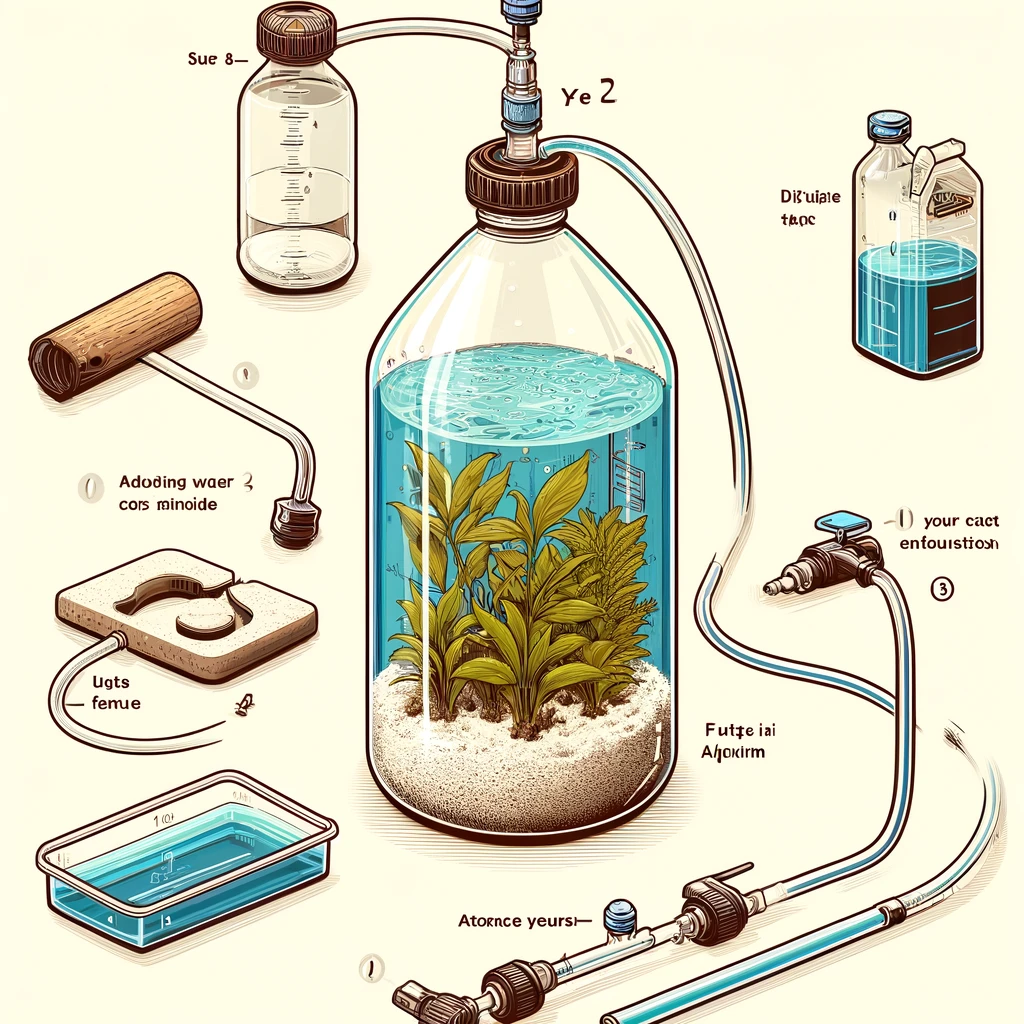
Creating a DIY CO2 system for a 250-litre aquarium involves the following components:
- Materials Needed:
- One 1-litre plastic bottle (e.g., from Aldi)
- 200 grams of sugar
- 3 grams of dry yeast (baking yeast is common, but wine yeast is recommended for better results)
- 750 ml of water (aquarium water is best)
- One linden wood airstone, a diffuser, or a Flipper
- Aquarium air tubing (length as required)
- Screw cap (e.g., Bioplast Bio-CO2 bottle screw cap or window cleaner screw cap) with a nipple for attaching the tubing
Steps to Set Up:
- Mix Ingredients: Start by adding sugar and yeast to the empty plastic bottle.
- Add Water: Pour in the water, screw on the cap, and shake well to mix. Bio-CO2 bottle caps are advantageous as they fit well on Aldi PET bottles and the tubes can be easily attached. They also prevent the foam produced during fermentation from entering the tank thanks to a built-in filter. An alternative is the window cleaner screw cap, which may require enlarging the small opening; however, these caps lack a filter.
- Connect to Diffuser: Finally, attach the other end of the tube to the Linden wood airstone or diffuser. For larger tanks, like my 450-litre setup, I use a Maxi-Flipper.
- Completion: Your DIY CO2 system is ready!
Important Considerations:
- Water Buffering: Ensure the water is adequately buffered. If the carbonate hardness (ideal KH value: 2-3) is too low or depleted, it can cause the pH to drop significantly, which might be fatal for the fish. For discus fish, keep the CO2 content below 15 mg/L to avoid stress.
- Regulation: I use the specified amount for my 450-litre tank and supplement it with wine yeast. The CO2 supply is controlled by a CO2 night shut-off to ensure it does not run continuously.
This DIY approach allows for effective and affordable CO2 supplementation in your aquarium, enhancing plant growth and overall tank health while ensuring safety for the fish.
Accurately Monitor CO2 Levels with Dennerle CO2 Long-Term Test Correct + pH
Ensure precise control of your aquarium’s CO2 levels with the Dennerle CO2 Long-Term Test Correct + pH. This user-friendly device allows for continuous and accurate monitoring of CO2 concentration in your aquarium water. The indicator changes colour to reflect the CO2 content, which can be easily read against the six-colour comparison scale in milligrams per litre. Additionally, it provides a straightforward way to measure the pH level of your aquarium, ensuring optimal conditions for your aquatic plants and fish. The kit includes a test container, a CO2 special indicator, and a comparison scale, making it simple, safe, and accurate to maintain the perfect balance in your tank.
Disclaimer: As an Amazon Affiliate, I earn from qualifying purchases.
About Water: Essential Parameters for Discus Fish
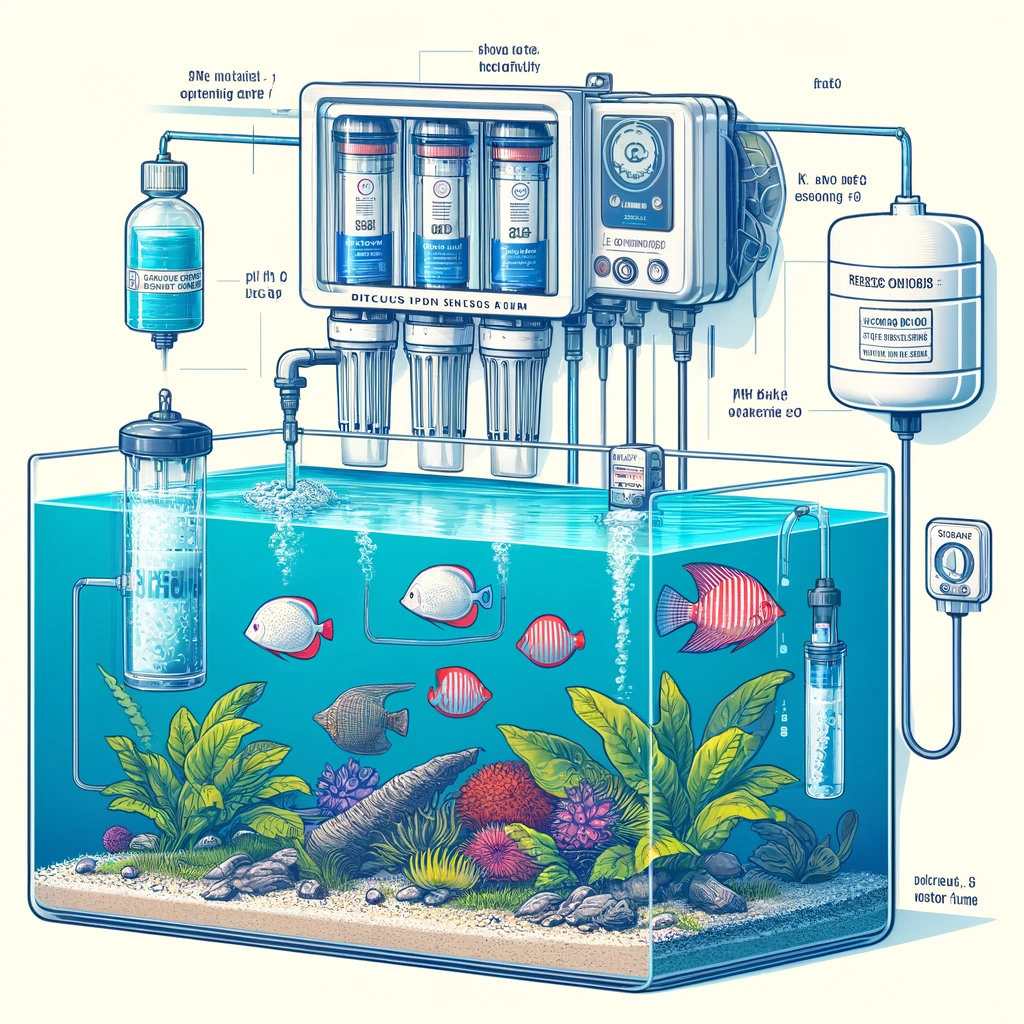
Discus fish have specific water quality requirements, though they are not as extreme as often portrayed. It’s crucial to differentiate between wild-caught discus and those bred in captivity:
- Wild-Caught Discus: These fish naturally require very soft and acidic water. Nitrate levels should be kept minimal.
- Captive-Bred Discus: These are more tolerant of harder water and neutral pH levels, although these conditions are not ideal.
Recommended Water Parameters:
- pH Level: Should not exceed 7; slightly acidic conditions are preferable.
- General Hardness (GH): Should not exceed 9 dGH.
- Carbonate Hardness (KH): Should not exceed 5 dKH.
These guidelines may seem strict, but it’s important not to compromise when keeping discus fish. While the fish themselves may not be the most significant cost factor, the necessary equipment, such as a reverse osmosis system to achieve these water parameters, can be. Investing in such a system should not be avoided in an attempt to save money improperly.
Following these parameters will help ensure a stable and healthy environment for both wild-caught and captive-bred discus, promoting their well-being and vibrant colouration.
Transform Your Aquarium Water with Tetra AquaSafe Water Conditioner
Ensure a healthy and natural environment for your fish with the Tetra AquaSafe Water Conditioner. This premium water treatment solution, available in a 5-litre bottle, is designed to make tap water safe for fish by neutralizing harmful substances like chlorine and heavy metals. Tetra AquaSafe also supports fish health by promoting the growth of beneficial bacteria and includes vital nutrients such as iodine and magnesium for improved fish well-being. Its advanced formula protects fish gills and mucous membranes with a natural algae extract and includes a Vitamin B mix to reduce fish stress during aquarium setup, water changes, and transport. Suitable for all freshwater and marine aquariums (with protein skimmers turned off), Tetra AquaSafe is a must-have for any aquarist seeking crystal-clear and fish-friendly water.
Check it out on Amazon and make your tap water safe for fish with Tetra AquaSafe Water Conditioner.
Disclaimer: As an Amazon Affiliate, I earn from qualifying purchases.
Ensure Healthy Water Quality with EASYTEST 6-in-1 Aquarium Test Strips
critical water parameters: nitrate, nitrite, general hardness, chlorine, carbonate, and pH levels. Regular testing is essential to prevent fish loss and promote a thriving aquatic ecosystem, whether you have a freshwater or saltwater tank. EASYTEST strips are made from premium fibre paper to ensure reliable and precise results, helping you keep your fish safe and your aquarium clean. Suitable for a wide range of aquariums, including tropical, goldfish, breeding tanks, ponds, betta tanks, and shrimp tanks, these test strips are an invaluable tool for any aquarist.
Disclaimer: As an Amazon Affiliate, I earn from qualifying purchases.
Ammonia in Aquariums
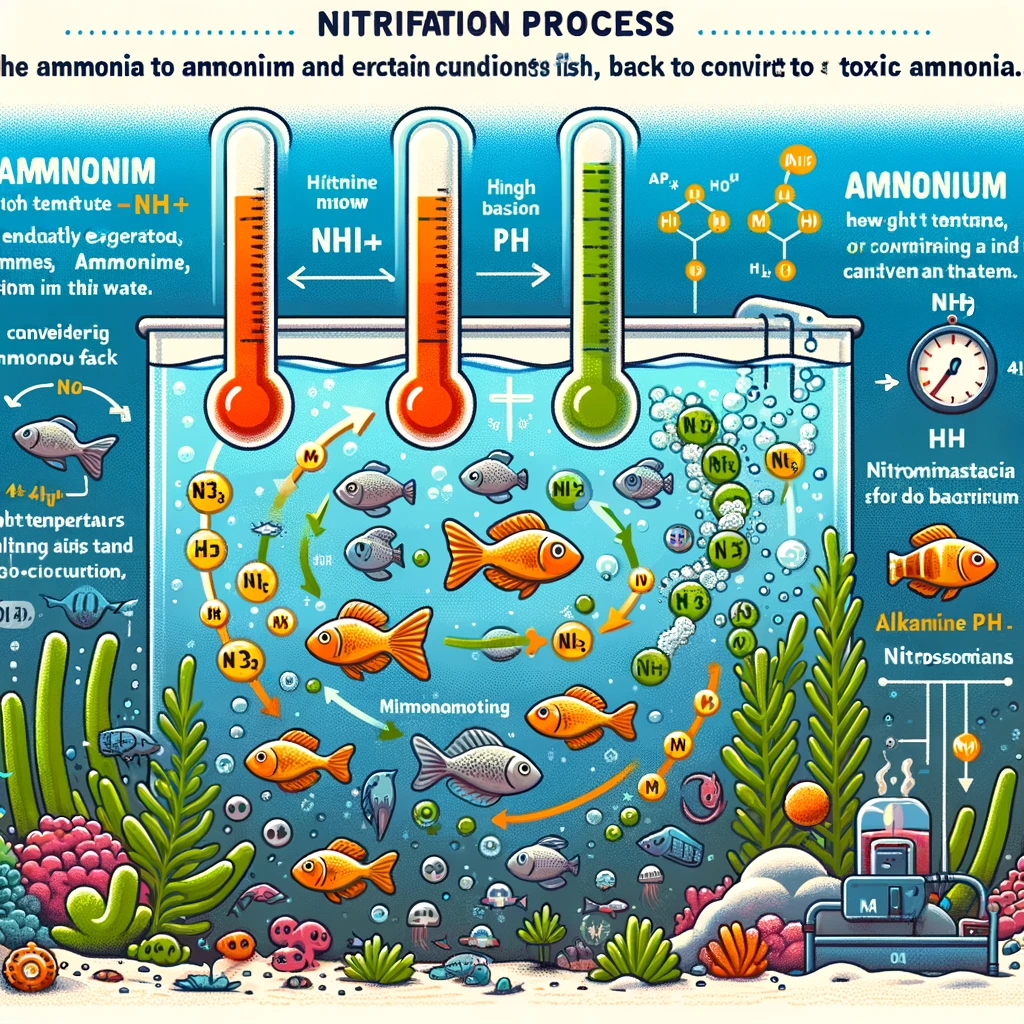
Ammonia (NH3) is a primary waste product in aquariums, typically excreted through fish gills and immediately converted into ammonium (NH4+) in water. While ammonium is non-toxic to fish and serves as an important nutrient for plants, it can revert to toxic free ammonia (NH3) under conditions of high temperatures and alkaline pH levels.
Toxicity of Ammonia: Free ammonia is the most toxic of the nitrogen compounds discussed here. Concentrations as low as 0.1-0.5 mg/L can be lethal to fish. A sudden increase in pH can trigger this dangerous shift from ammonium to ammonia, posing a significant risk to aquarium inhabitants.
Nitrification Process:
- Step 1: Ammonia or ammonium is converted to nitrite (NO2-) by Nitrosomonas bacteria, a process that consumes oxygen (oxidation).
This transformation is part of what aquarists refer to as “nitrification,” a critical cycle that helps maintain the balance of nitrogen compounds in the aquarium and ensures the health of the aquatic ecosystem.
Continuously Monitor Ammonia Levels with Seachem Ammonia Alert
Keep your aquarium safe from toxic ammonia with the Seachem Ammonia Alert. This innovative device uses advanced sensor technology to provide continuous, real-time monitoring of ammonia levels in both freshwater and saltwater aquariums. The color-changing sensor shifts from yellow to green to blue, indicating the concentration of free ammonia, with detection sensitivity as low as 0.05 mg/L (ppm). No test kits, chemicals, or procedures are required, making it easy to use. Simply place the device in your tank and let it work. It lasts over a year and provides constant readings to help you quickly identify and address ammonia spikes, protecting your fish from stress and potential harm.
Disclaimer: As an Amazon Affiliate, I earn from qualifying purchases.
Nitrite: A Subtle Threat in Aquariums
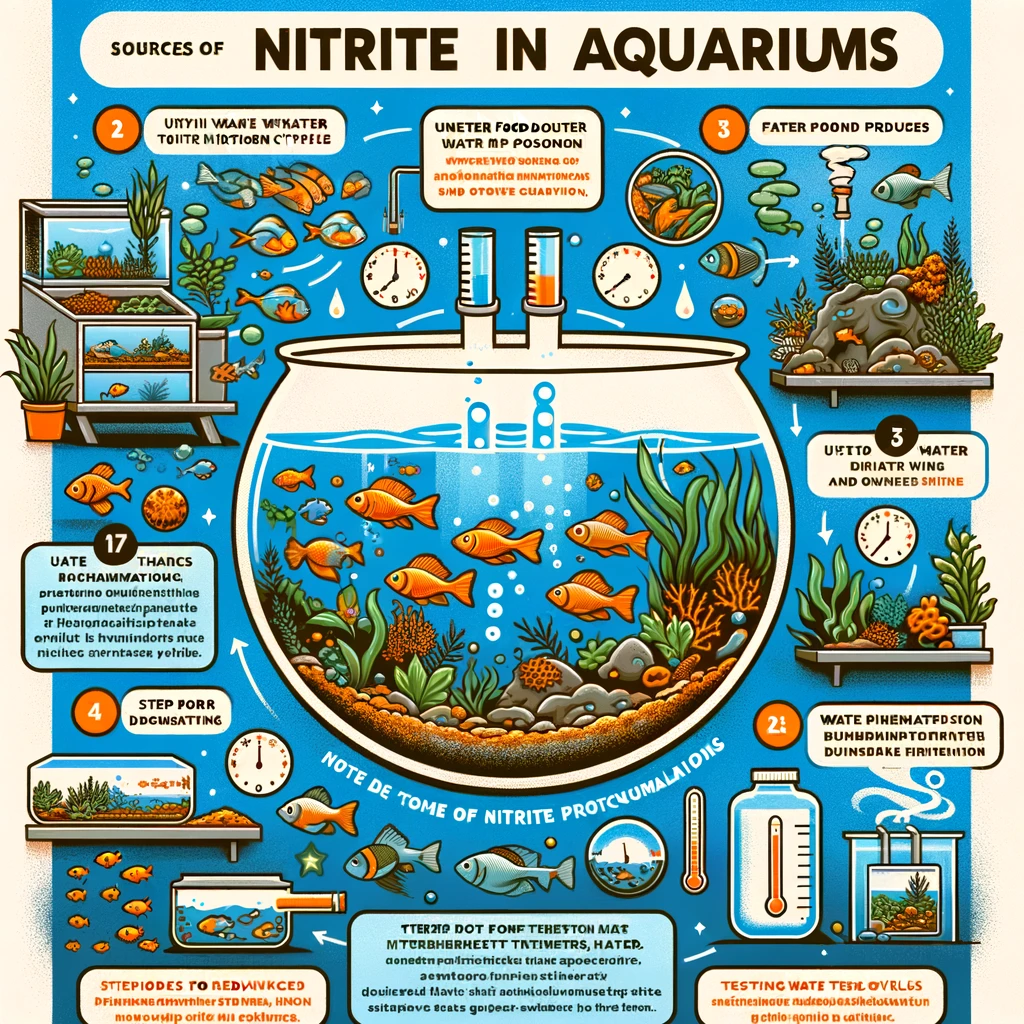
Nitrite is less toxic than ammonia, but concentrations ranging from 1-5 mg/L can still be deadly for fish, especially under conditions of lower pH and chloride content.
Symptoms of Nitrite Poisoning:
- Fish may gasp for air at the water’s surface, showing signs of laboured breathing.
- A general lack of energy or unexplained erratic swimming can indicate nitrite toxicity.
Common Mistakes: Many new aquarists, and even some experienced hobbyists, lose their fish and their enthusiasm for the hobby due to nitrite poisoning. It is crucial to monitor nitrite levels during the initial setup of an aquarium after any medication has been added, or whenever fish show signs of distress.
Immediate Remedies:
- Perform a partial water change to quickly reduce nitrite levels.
- Use preparations that promote beneficial bacteria to help process and reduce nitrite more effectively.
Monitoring and managing nitrite levels are essential for maintaining a healthy aquarium and preventing fish loss due to toxicity.
Nitrate: Balancing Levels for Aquarium Health
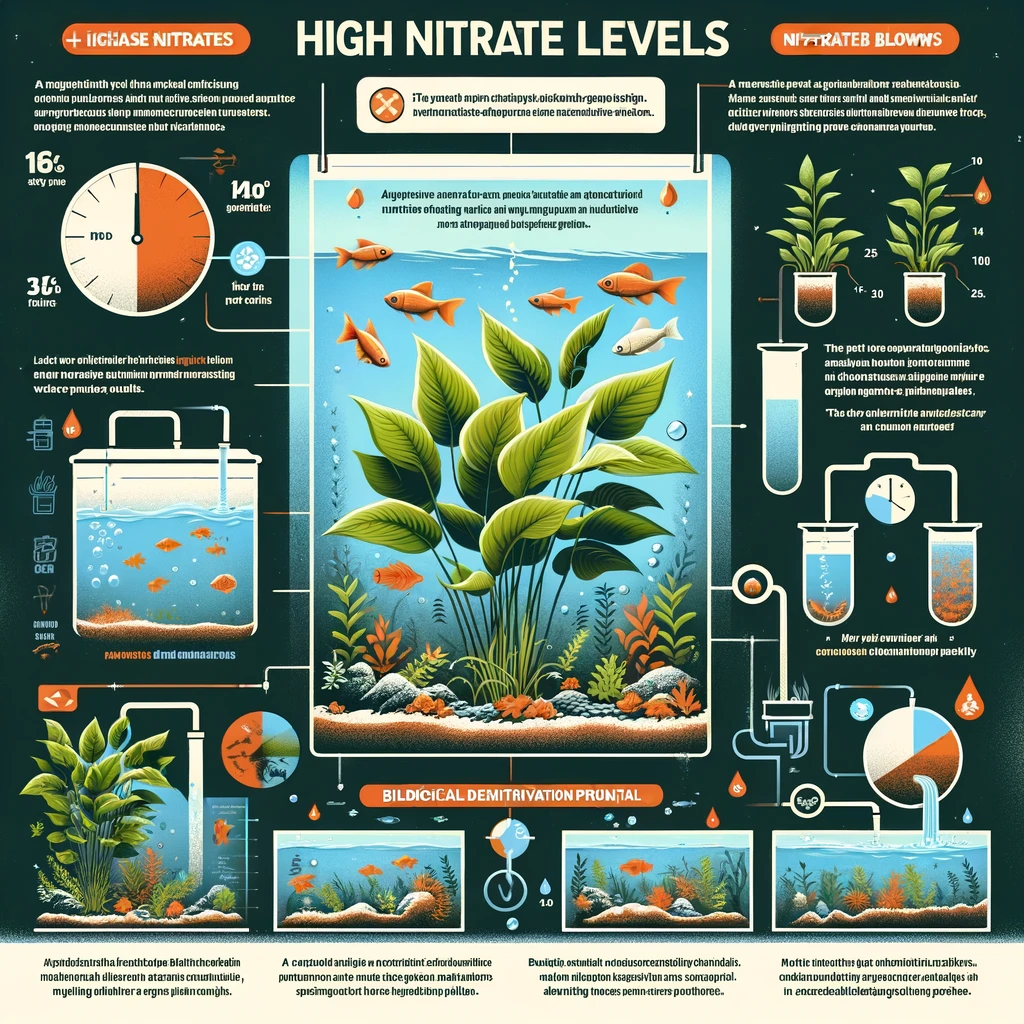
High nitrate levels can weaken the immune systems of fish, making them more susceptible to diseases. Keeping nitrate levels in check is crucial for maintaining a healthy aquarium environment.
Problems Associated with High Nitrate Levels:
- Increased disease susceptibility: Fish in environments with high nitrate levels are more prone to illnesses.
- Poor plant growth and algae blooms: Excessive nitrates can lead to poor plant growth and proliferate algae.
- Water chemistry imbalance: High nitrate levels often correlate with high redox potential, indicating an imbalance in the aquarium’s cleanliness and biological load.
Nitrate Management Strategies:
- Conventional Methods: While nitrate filters or resin columns are effective, they can be expensive and require meticulous maintenance.
- Natural Remedies:
- Using Pothos (Epipremnum aureum): Known as Efeutute, this plant can absorb significant amounts of nitrate. It can be bought from a regular plant shop, cleaned of all soil, and placed in the aquarium, ensuring only the roots and a few centimetres above are submerged. This setup is beneficial in open aquariums where the plant can receive ample light.
- Floating Plants: Plants like water lettuce also consume excess nutrients and can significantly improve water quality.
Additional Considerations:
- Regular Water Changes: Despite using plants to control nitrates, regular water changes are indispensable to prevent nitrate build-up.
- Monitoring Redox Potential: This measurement can indicate the hygiene status of the aquarium; too high means the aquarium is overly clean, and too low suggests excessive pollution.
- Biological Denitrification: Special slow-running filters can enhance biological denitrification, keeping essential plant nutrients available, reducing water yellowing, and balancing oxygen levels and bacterial counts.
Maintaining low but adequate nitrate levels through careful management and regular maintenance ensures a healthy and vibrant aquarium.
Ensure Healthy Water Quality with EASYTEST 6-in-1 Aquarium Test Strips
Maintain a balanced and healthy aquarium environment with the EASYTEST 6-in-1 Aquarium Test Strips. This comprehensive test set includes 150 high-quality strips designed to accurately measure six critical water parameters: nitrate, nitrite, general hardness, chlorine, carbonate, and pH levels. Regular testing is essential to prevent fish loss and promote a thriving aquatic ecosystem, whether you have a freshwater or saltwater tank. EASYTEST strips are made from premium fiber paper to ensure reliable and precise results, helping you keep your fish safe and your aquarium clean. Suitable for a wide range of aquariums, including tropical, goldfish, breeding tanks, ponds, betta tanks, and shrimp tanks, these test strips are an invaluable tool for any aquarist.
Disclaimer: As an Amazon Affiliate, I earn from qualifying purchases.
Phosphate: A Critical Water Parameter
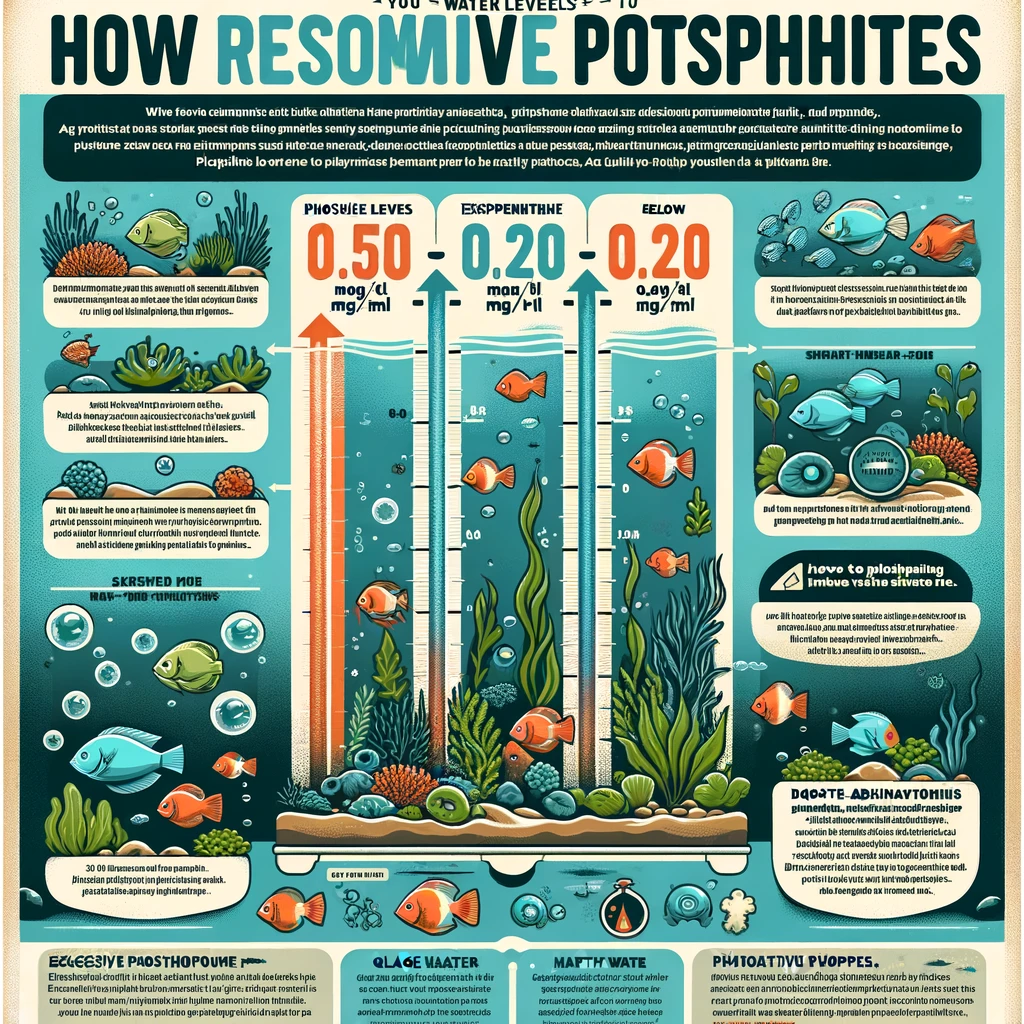
Phosphate levels in an aquarium are crucial yet often overlooked compared to the more commonly monitored nitrate levels. However, maintaining appropriate phosphate levels is essential for preventing excessive algae growth and ensuring the overall health of the fish.
Risks of High Phosphate Levels:
- Algae Growth: Excessive phosphate can lead to significant algae blooms, which can disrupt the balance of the aquarium.
- Fish Health: High phosphate levels can adversely affect the health of the fish, potentially leading to fatal outcomes.
Recommended Levels:
- General Aquariums: It’s advised to keep phosphate levels below 0.5 mg/L to prevent unwanted plankton blooms.
- Discus Aquariums: For discus fish, maintaining phosphate levels under 0.20 mg/L is recommended to ensure their health and well-being.
By closely monitoring and managing phosphate levels, aquarists can maintain a healthier environment for both plants and aquatic life, reducing the risk of algae overgrowth and promoting the vitality of the fish.
Accurately Test Phosphate Levels with JBL ProAquaTest PO4 Phosphate Sensitive
Maintain optimal water quality in your aquarium or pond with the JBL ProAquaTest PO4 Phosphate Sensitive. This advanced water test kit provides precise and reliable measurements of phosphate levels, essential for promoting healthy plant growth and preventing algae problems. Suitable for both freshwater and saltwater aquariums, as well as ponds, this comprehensive test set includes reagents, glass cuvettes with screw caps, a syringe, a comparator block, and colour scale, allowing for easy and accurate testing. With the ability to perform approximately 50 tests, this kit ensures you can regularly monitor and maintain the ideal phosphate levels for your aquatic environment.
Disclaimer: As an Amazon Affiliate, I earn from qualifying purchases.
Total Hardness (GH)
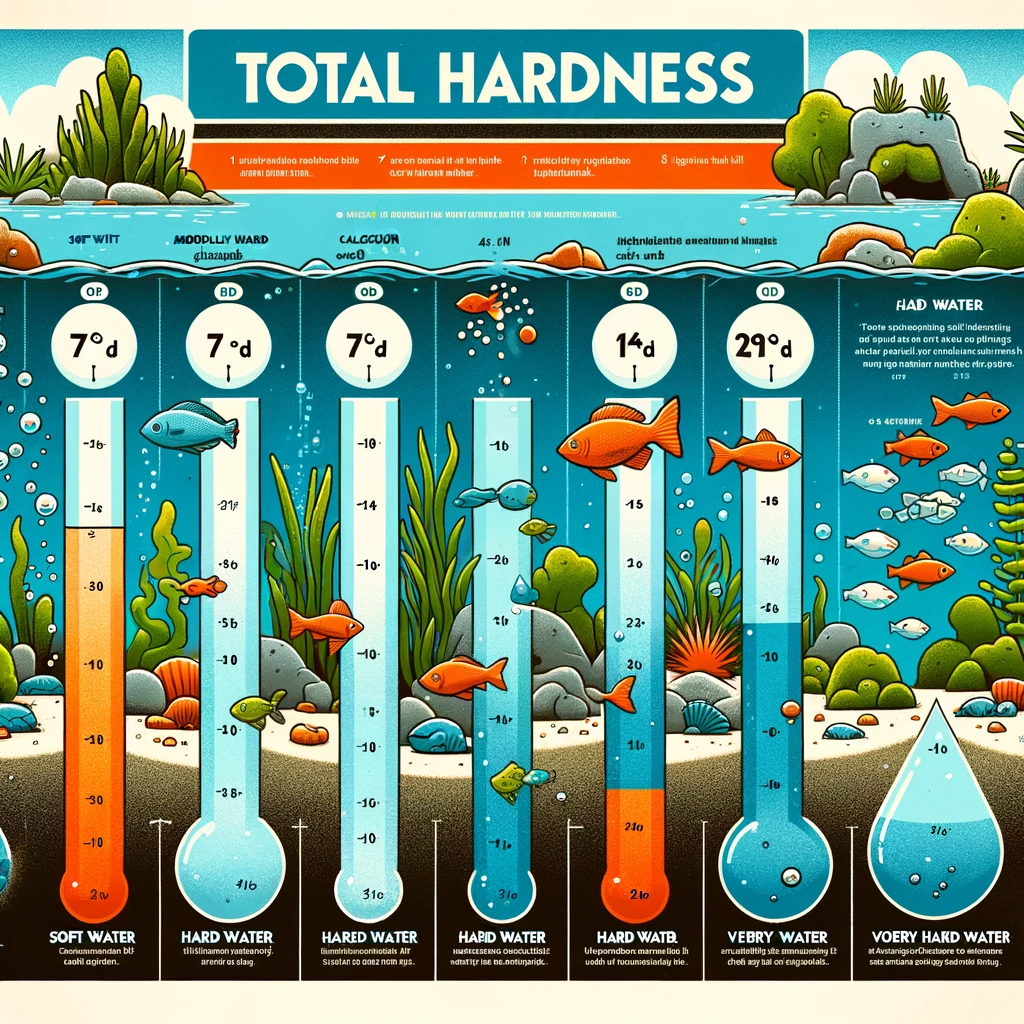
Total Hardness (GH) is the sum of all earth alkali ions in water, primarily calcium and magnesium ions, which constitute about 80% of the dissolved ions in water. Other ions like strontium and barium are also present in trace amounts. From an aquarist’s perspective, total hardness is not as critical as carbonate hardness (KH), but it still plays a significant role in determining water quality.
Levels of Total Hardness:
- Soft Water: GH under 7°d
- Moderately Hard Water: GH between 7°d and 14°d
- Hard Water: GH between 14°d and 21°d
- Very Hard Water: GH over 21°d
Understanding and managing the total hardness in your aquarium can help in providing an optimal environment for your aquatic life, especially in terms of ensuring the health of species that are sensitive to mineral content in the water.
Carbonate Hardness (KH)
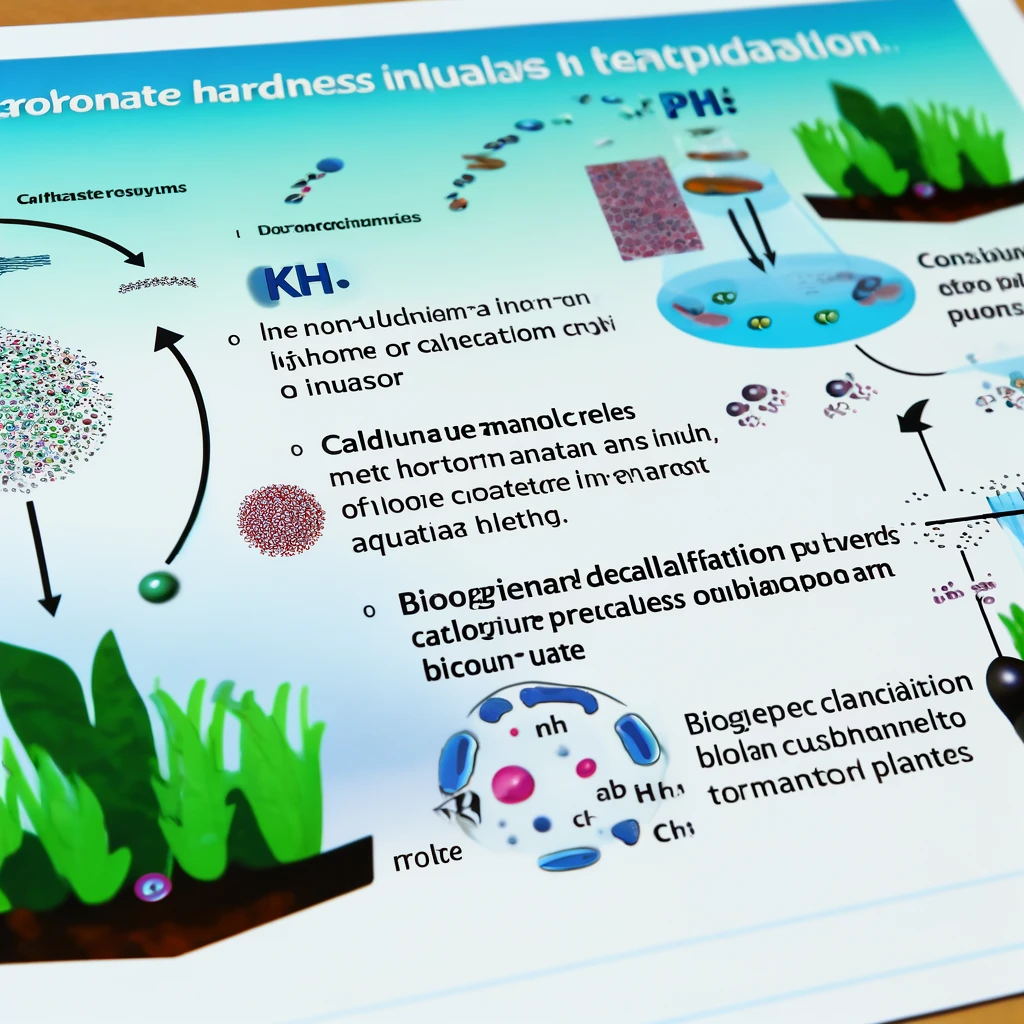
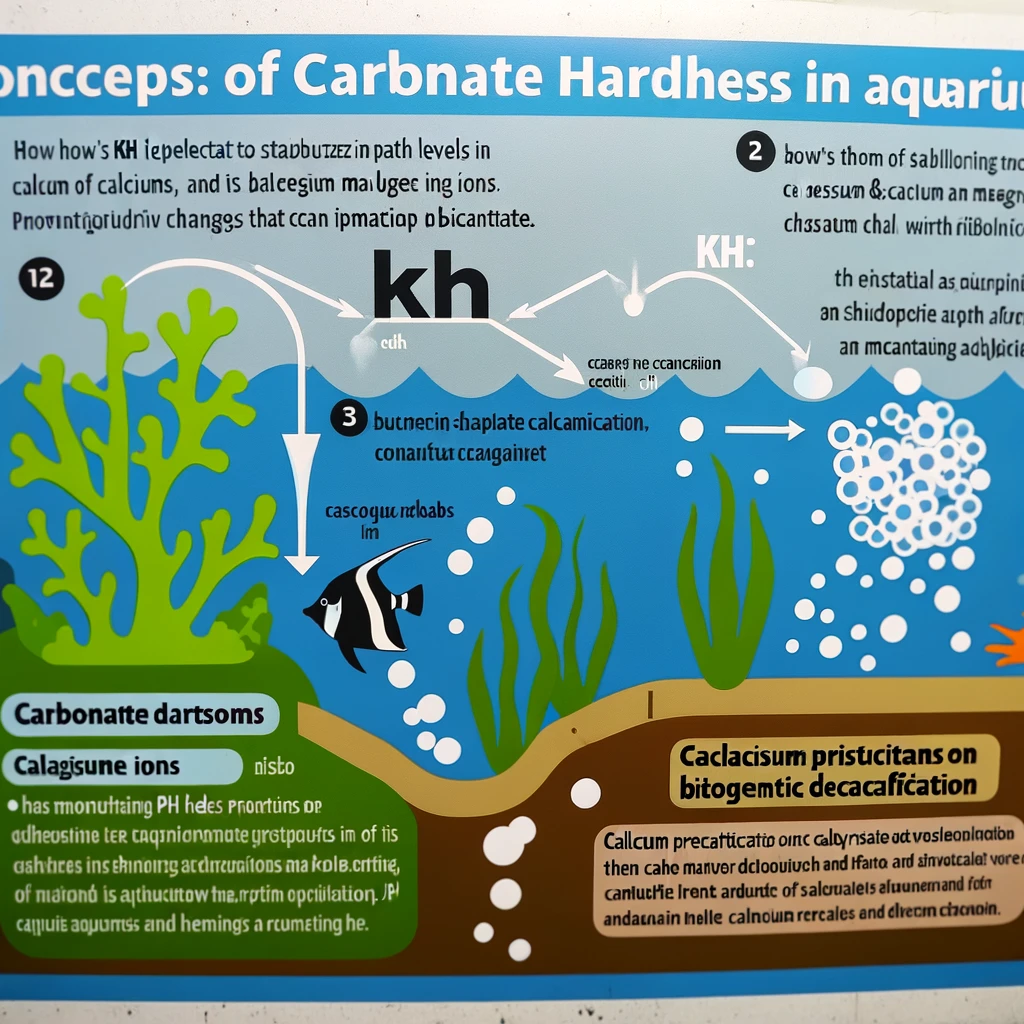
- KH vs. GH: Typically, KH is lower than total hardness (GH) because each bicarbonate ion must be paired with a calcium or magnesium ion to contribute to KH. However, in some cases, KH can be higher than GH. This anomaly can occur if water contains additives like sodium bicarbonate (baking soda) or potassium bicarbonate, which do not contribute to “true” carbonate hardness like calcium or magnesium bicarbonate would.
- Role of KH: Carbonate hardness plays a crucial role in stabilizing pH levels in the aquarium. High KH values indicate a basic (alkaline) pH. The carbonate buffering system is vital as it prevents drastic pH shifts which could otherwise occur from the decomposition of organic materials or fluctuations in dissolved carbon dioxide levels.
- Biogenic Decalcification: This process involves the precipitation of calcium as calcium carbonate on plant leaves where water hardness is being reduced. This biological removal of hardness can stabilize the pH by reducing alkalinity and increasing acidity through the formation of carbonic acid.
- Regular monitoring of KH is essential. A decrease in KH warns of potential instability in pH levels, which could rapidly shift to dangerous levels if all buffering capacity is exhausted. Maintaining an adequate level of dissolved CO2 and other buffers is critical to prevent biogenic decalcification and to keep the pH stable.
Comprehensive Water Quality Testing with FJHTY 9-in-1 Aquarium Test Strips
Ensure optimal water conditions for your aquatic life with the FJHTY 9-in-1 Aquarium Test Strips. This all-inclusive test kit allows you to measure nine essential parameters: iron (Fe), copper (Cu), nitrate (NO3), nitrite (NO2), chlorine (Cl2), general hardness (GH), total alkalinity (TAL), carbonate (KH), and pH levels. Each pack contains 100 strips, providing cost-effective and accurate testing for both freshwater and saltwater aquariums. The testing process is quick and simple, involving just three steps: dip a strip into the water sample, wait for the results to develop, and compare the colors to the provided chart. Ideal for use at home, these strips help you maintain a healthy environment for your fish and plants by identifying potential water quality issues before they become harmful.
Disclaimer: As an Amazon Affiliate, I earn from qualifying purchases.
Biogenic Decalcification Explained
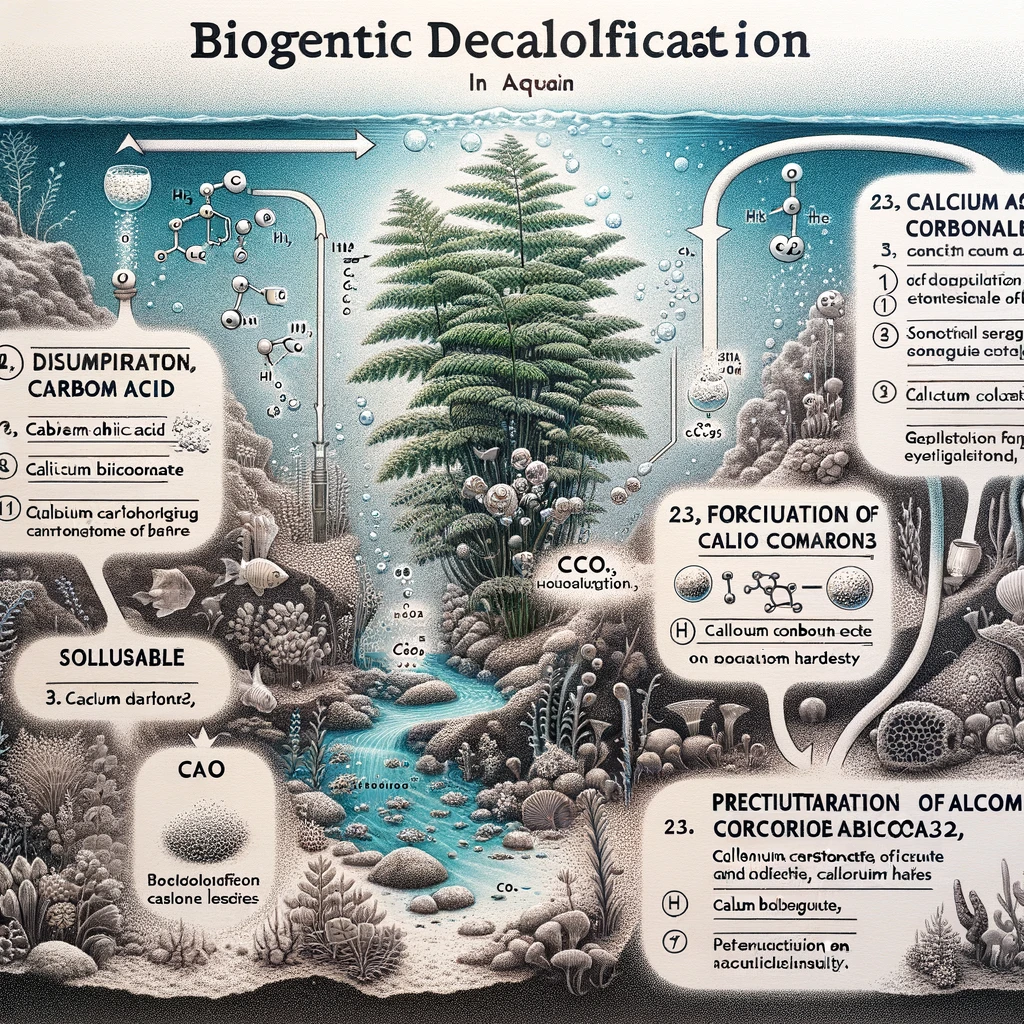
The process of biogenic decalcification represents a natural biological method in which carbonate hardness (KH) in the water is reduced. Here’s a breakdown of this process in a way that complements and updates the information in your blog section on carbonate hardness.
Process Overview
- Carbon Dioxide in Water: Carbon dioxide (CO2) from various sources, such as fish respiration and microorganisms, dissolves in water.
- Formation of Carbonic Acid: When CO2 dissolves in water, it forms carbonic acid (H2CO3).
- Reaction with Calcium Carbonate: The carbonic acid reacts with calcium carbonate (CaCO3) present in the water. This interaction typically occurs on plant surfaces in an aquarium.
- Formation of Calcium Bicarbonate: Through these reactions, calcium bicarbonate (Ca(HCO3)2) is formed, which is more soluble than calcium carbonate. This reaction effectively reduces the carbonate hardness of the water.
- Decalcification Effect: As a result of this reaction, calcium is precipitated on plant leaves, and the overall carbonate hardness in the water decreases. This reduction in carbonate hardness helps stabilize water pH by shifting it towards acidity.
Relevance to Carbonate Hardness in Aquaria
This natural process is crucial for maintaining stable pH levels in aquaria. Carbonate hardness (KH), often misunderstood merely as a measure of water hardness, acts more accurately as a buffer that stabilizes pH levels. Through biogenic decalcification, plants help modulate this buffer capacity by absorbing calcium carbonate and, thus, indirectly managing the pH balance in the aquarium environment.
pH Value
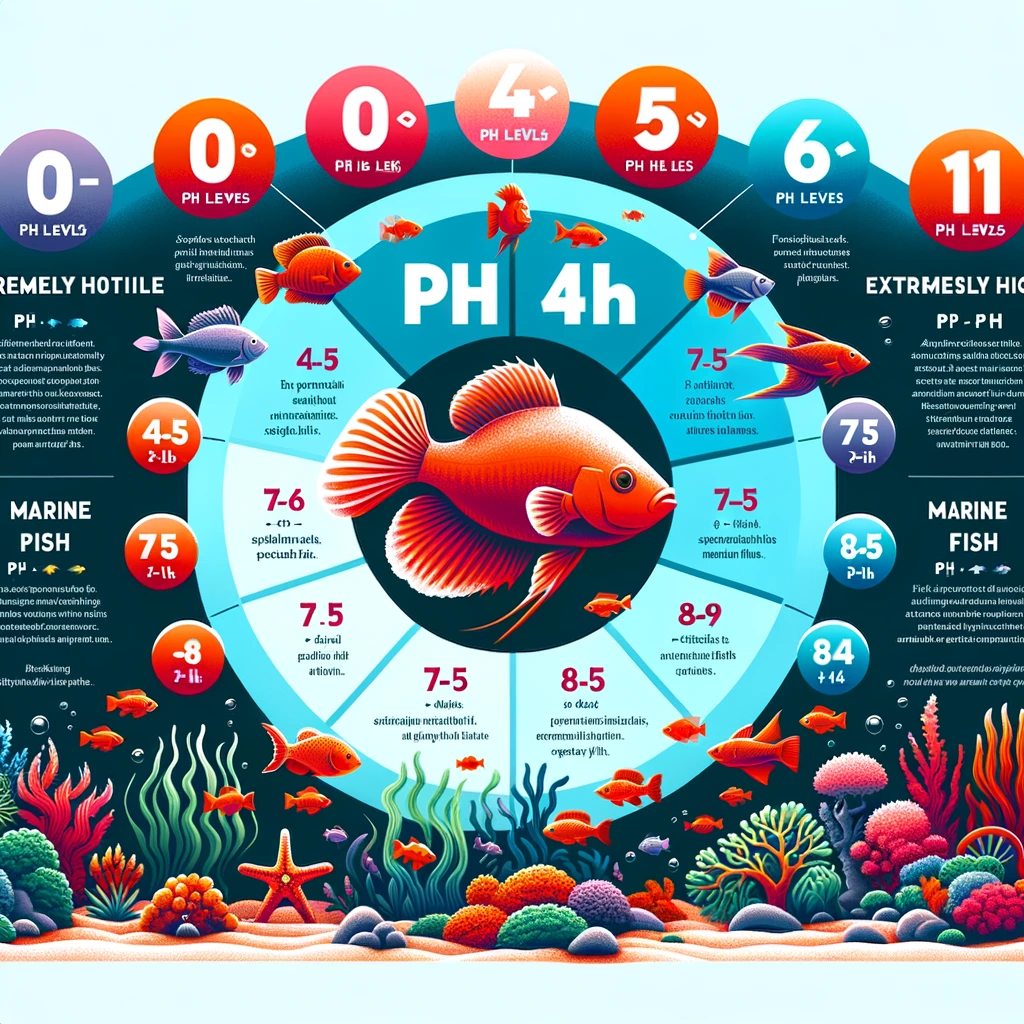
The pH value, derived from the Latin “potentia hydrogenii,” measures the ratio of acids and bases in water. A pH of 7 is neutral, indicating a balance between acidic and basic components. Values below 7 indicate acidic water, while values above 7 are considered alkaline.
Key Aspects of pH:
- Logarithmic Scale: The pH scale ranges from 0 to 14 and is logarithmic. This means that each unit change represents a tenfold change in the concentration of hydrogen ions. For example, a pH of 6 has ten times more acidity than a pH of 7 and a hundred times more than a pH of 8.
Effects of pH on Aquatic Life:
- 0 – 4.5: Extremely hostile to life.
- 4.5 – 6: Ideal for specific fish species.
- 6 – 7.5: Optimal range for most fish.
- 7.5 – 8: Suitable for some African fish species.
- 8 – 9: Optimal for marine fish.
- 9 – 14: Extremely hostile to life.
Maintaining the correct pH level is crucial for the health and well-being of aquarium inhabitants. It’s important to regularly check and adjust the pH to ensure it is suitable for the specific types of fish and plants in the aquarium.
Salinity and Conductivity
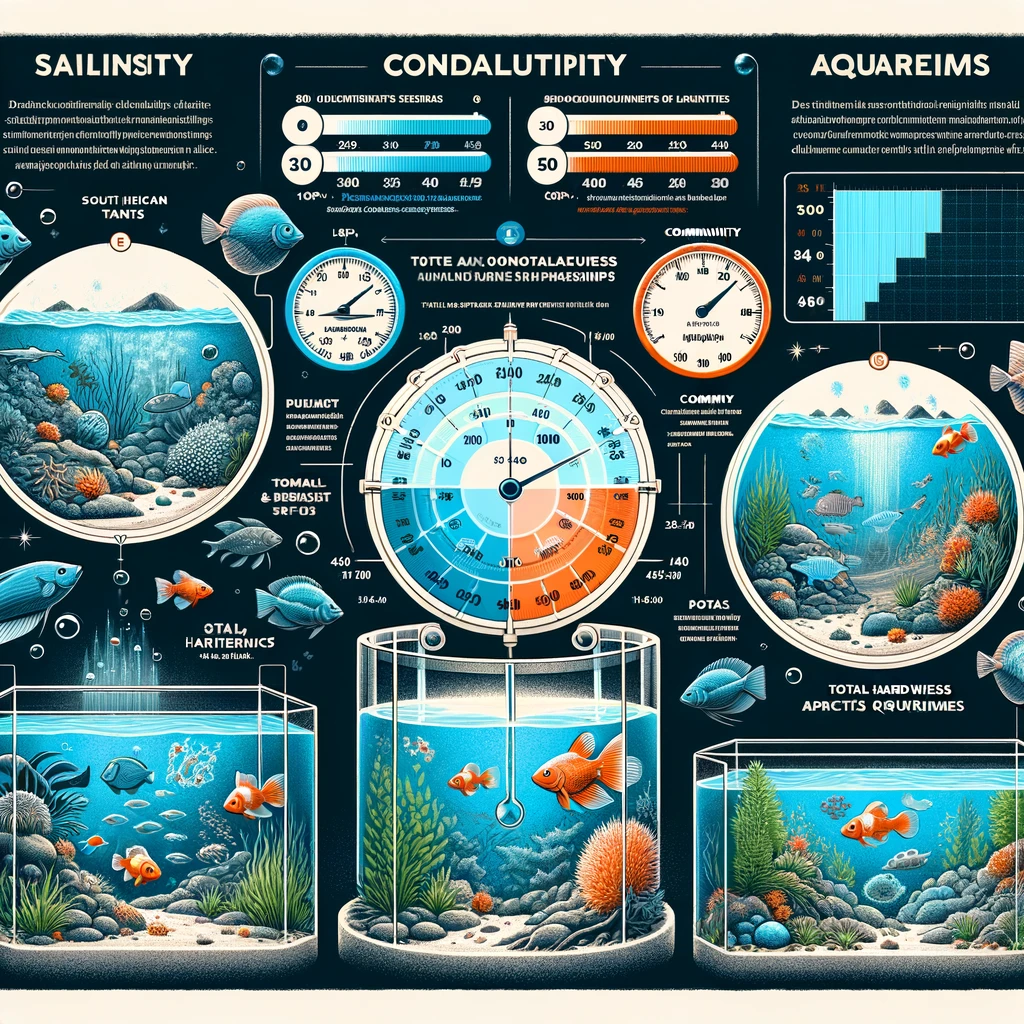
Salinity, or the total dissolved salts in water, directly affects the osmoregulation and well-being of fish and plants. If a fish is continually kept in water with inappropriate salinity levels, it experiences “osmotic stress,” constantly striving to balance these unfavourable conditions internally. This can deteriorate its overall physical condition and lower its disease resistance.
Conductivity Measurement:
- Mechanism: In aquarium water, electrically charged particles (ions) allow electric current to flow when a voltage is applied. This flow of current, known as water conductivity, depends on the quantity and mobility of these ions.
- Distilled Water: It contains no ions and does not conduct electricity.
- Higher Ions, Higher Conductivity: More ions and more mobile ions result in faster electricity conduction and higher conductivity. Water with high conductivity also typically has high total hardness.
Electrical Conductivity:
- Measurement Units: The conductivity of water is measured in microsiemens (µS/cm) or millisiemens per centimetre (mS/cm). It provides an overview of the total salt content of the water. For example, roughly 33 µS/cm conductivity corresponds to 1°d of total hardness.
- If Additional Salts Are Present: If, for example, water with 10°d GH measures not approximately 330 µS/cm but 420 µS/cm, significant quantities of other salts like sodium or potassium salts may also be present.
Appropriate Conductivity for Different Aquariums:
- South American Tanks: Recommended conductivity levels are between 100 µS/cm and 300 µS/cm.
- Community Tanks: Slightly higher levels, from 300 µS/cm (moderately hard) to 500 µS/cm (hard), are acceptable.
- Marine Aquariums: Conductivity should be between 48 mS/cm and 52 mS/cm.
Understanding and managing salinity and conductivity is crucial for the health of sensitive fish species and when transferring fish between different water types.
Accurately Test Water Quality with Measury TDS & EC Meter
Ensure the purity and safety of your water with the Measury TDS & EC Meter. This versatile device measures the electrical conductivity (EC) of water and calculates the total dissolved solids (TDS) value, providing crucial insights into water quality. With three output modes—TDS (ppm), EC (µs), and temperature (Celsius or Fahrenheit)—this meter offers comprehensive testing for a variety of applications, including drinking water and aquarium maintenance. The Measure meter measures conductivity from 0-9990 µs/cm and TDS from 0-9990 ppm with a precision of ±2%. Pre-calibrated and ready to use, it also features a hold function for easy reading and a backlit display for clear visibility in any lighting condition. Ideal for ensuring the health of your aquarium or verifying the quality of your drinking water.
Check it out on Amazon and ensure optimal water quality with the Measury TDS & EC Meter.
Disclaimer: As an Amazon Affiliate, I earn from qualifying purchases.
GH and KH Composition
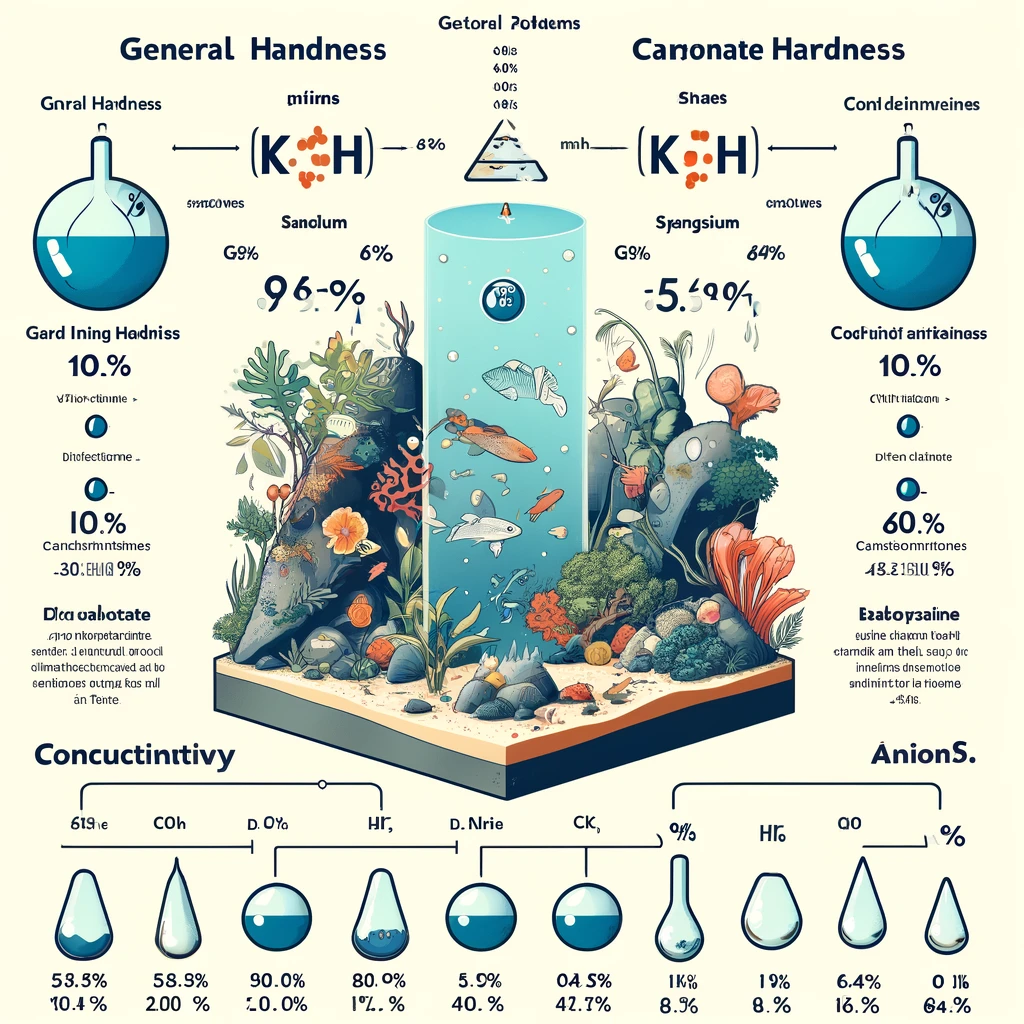
In freshwater systems around the world, the composition of dissolved salts typically adheres to a standard ion ratio, although the concentrations and resulting conductivity may vary based on this ratio:
Cation Composition:
- Calcium: 64.4%
- Sodium: 18.4%
- Magnesium: 10.6%
- Potassium: 6.6%
Anion Composition:
- Bicarbonate (equivalent to KH): 80.0%
- Sulfate: 13.7%
- Chloride: 6.3%
Conductivity and Hardness Relationship:
- A conductivity of 33 µS/cm typically corresponds to 1°d GH, with 80% of GH being manifested as KH, assuming the standard ion ratio is present. This means that hardness in water is primarily due to calcium, magnesium, and bicarbonates.
Practical Implications:
- Despite low GH and KH, conductivity can be high if other ions like sodium or potassium are present in significant amounts.
- Generally, KH should account for about 80% of GH according to common guidelines.
Measuring KH:
- To accurately assess KH, especially important in breeding waters, use standard drop tests. For KH levels below 3, you can adapt the test as follows:
- Take 100 ml of water, measure the pH, then add KH test liquid drop by drop (counting them) until the pH drops below 4.3. Multiply the number of drops by 0.05 to determine the KH. If using 50 ml of water, multiply the number of drops by 0.1. This method is effective because each drop of the standard reagent is calibrated to alter the KH by a specific amount in 5 ml of water.
Note on Conductivity:
- Conductivity significantly influences the osmotic pressure of the water but does not indicate water purity. Low conductivity does not guarantee the absence of toxins that do not affect conductivity readings.
This detailed explanation underscores the importance of understanding GH, KH, and their influence on water chemistry for maintaining healthy aquarium conditions.
How Often Should You Change Aquarium Water?
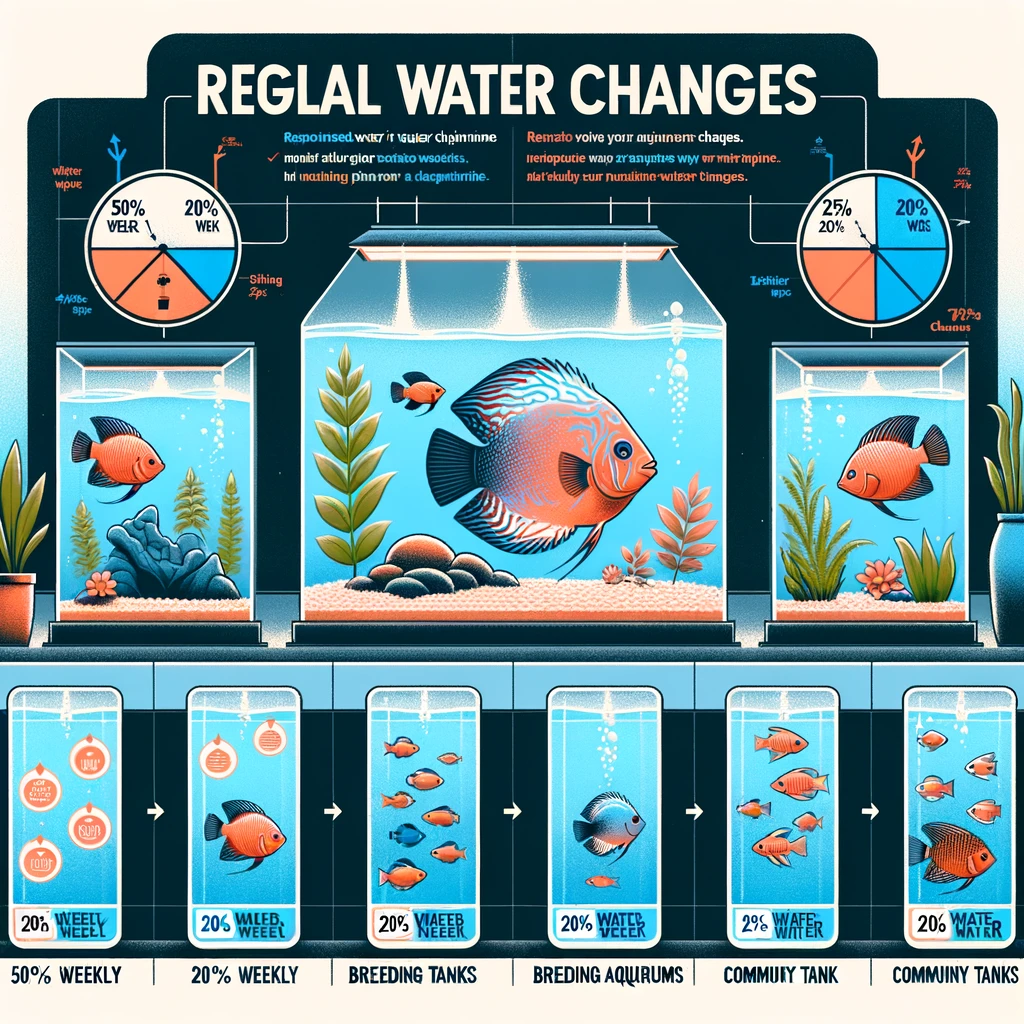
Regular water changes are crucial for maintaining the health and well-being of the fish in your aquarium. The frequency and volume of water changes can vary depending on the type of aquarium and the fish’s requirements.
Recommended Water Change Practices:
- Discus Aquariums: In my display tank, which is a 450-litre tank housing 6 juvenile discs, I perform a weekly water change of 50% of the tank’s volume. Due to their high metabolism and substantial appetite, discus fish produce a significant amount of waste, necessitating substantial and frequent water changes.
- Breeding Tanks: For breeding tanks, I recommend changing about 20% of the water daily to maintain optimal water quality and support the health of the breeding fish.
- Community Tanks: In a normally stocked community tank, a weekly water change of at least 25% is advisable to ensure the freshness and hygiene of the aquarium water, which is vital for the health and comfort of the fish.
Importance of Regular Water Changes:
- Health and Hygiene: Neglecting water changes can lead to deteriorating water conditions, affecting the health and stress levels of the aquarium inhabitants.
- Stability: Regular changes help maintain stable water parameters, crucial for the thriving of all aquarium life, especially in densely stocked or high-bio-load environments.
Following these guidelines will help ensure that your aquarium remains a healthy and vibrant environment for all its inhabitants.
Reverse Osmosis (RO)
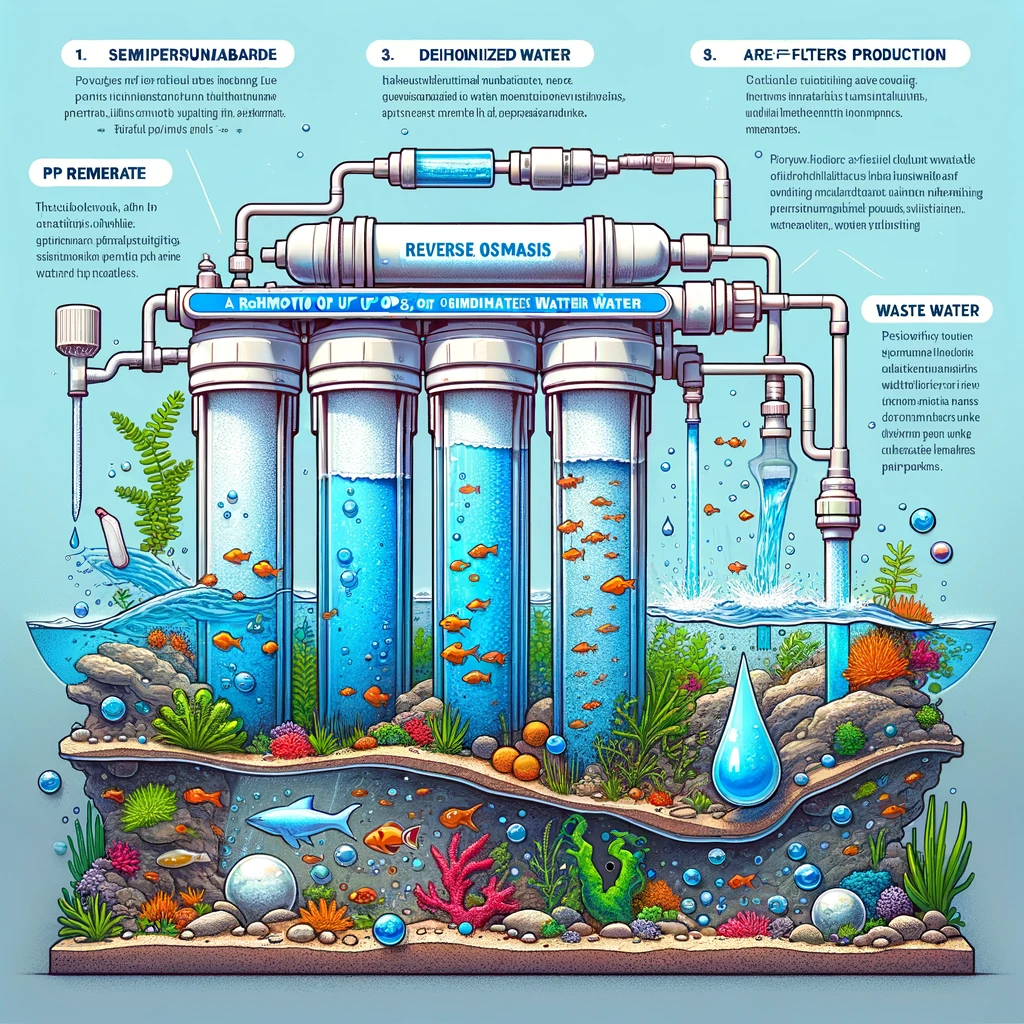
Reverse osmosis is a straightforward method for producing deionized water from tap water. This process involves forcing water through a semipermeable membrane under high pressure, which allows only water molecules to pass through, resulting in ion-poor water, also known as permeate.
Key Features of RO Systems:
- High Efficiency: Up to 99% of salts, pesticides, bacteria, and other contaminants are retained, ensuring highly purified water.
- Waste Water Production: A significant disadvantage of RO systems is a large amount of wastewater (concentrate) produced, about 75% in a typical 1:4 ratio. However, this can be mitigated by repurposing the wastewater for other uses, such as watering plants.
- Maintenance and Filters: To extend the lifespan of the membrane, regular flushing of the system is recommended. Pre-filters such as fine filters and carbon filters are advisable to protect the RO membrane and enhance the system’s durability.
Personal Usage Tip:
- I use the RO waste water for laundry, collecting it in containers beforehand. It’s important to use a water softener like Calgon to protect the washing machine from limescale build-up. This practice allows even the wastewater to be utilized effectively.
Reverse osmosis systems are an excellent choice for aquariums, particularly in areas with hard tap water, providing clean, controlled water that is crucial for sensitive aquatic environments.
Achieve Pure Water with Dupla RO 200 Reverse Osmosis System
Ensure optimal water quality for your aquarium with the Dupla RO 200 Reverse Osmosis System. Weighing just 1.3 kg, this compact and efficient system uses the principle of physical filtration to remove harmful substances like silicates, nitrates, and hardness formers from your water. Suitable for both freshwater and marine aquariums, the Dupla RO 200 operates under standard household water pressure (2 to 6 bar) and passes water through a semipermeable membrane. This process effectively filters out contaminants, leaving you with pure water that promotes a healthy aquatic environment. Certified by NSF, this RO system is an excellent choice for maintaining the highest water standards in your aquarium.
Disclaimer: As an Amazon Affiliate, I earn from qualifying purchases.
Ion Exchangers
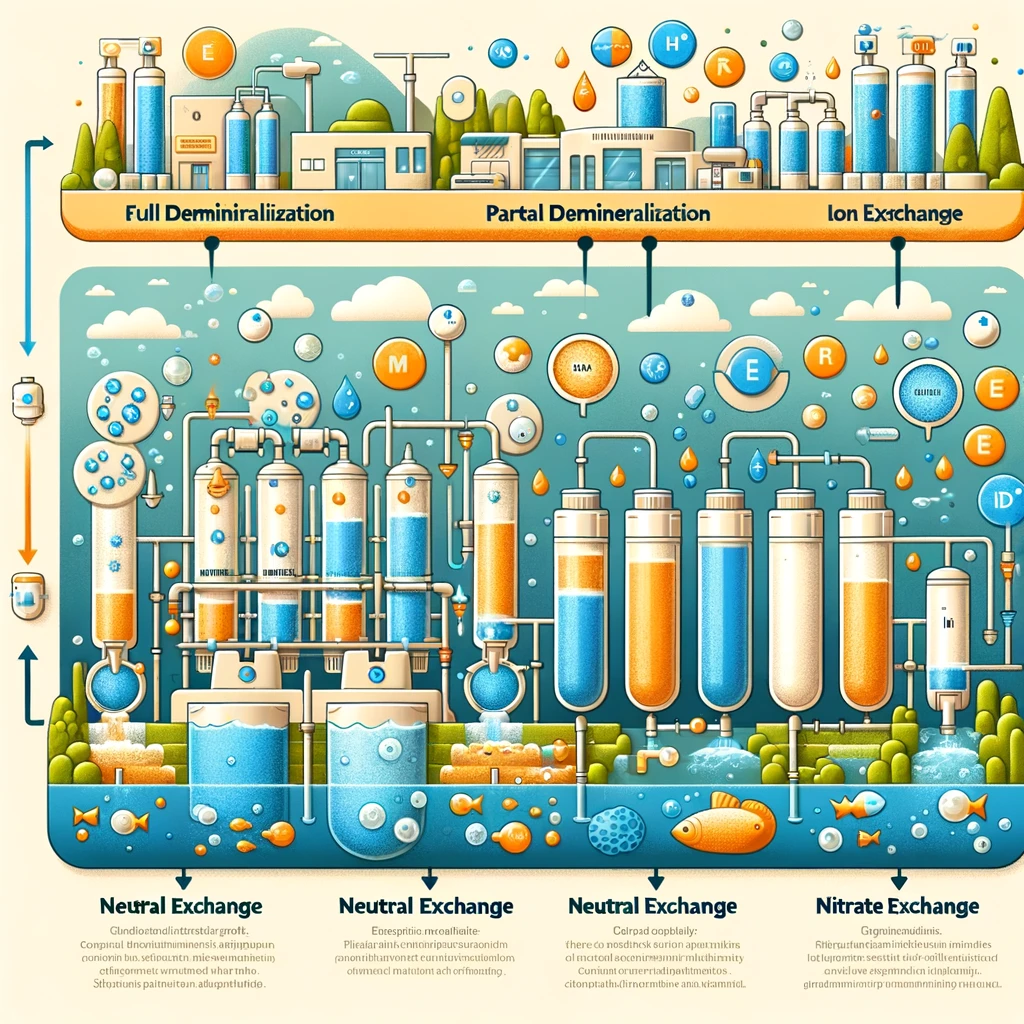
Ion exchangers are used in various forms to purify and treat water by exchanging undesirable ions in the water with preferable ones. Each method has specific uses and implications:
Full Demineralization:
- Process: Positively charged cations are replaced by hydrogen ions, while negatively charged anions are exchanged for hydroxide ions.
- Regeneration: Cation exchange resins are regenerated with hydrochloric acid and anion exchange resins are regenerated with sodium hydroxide.
- Result: The resultant deionized water has a low conductivity and contains neither hardness builders nor other salts. Due to its carbon dioxide content, the water is slightly acidic.
Partial Demineralization:
- Process: Only cations are exchanged, typically removing salts that contribute to total hardness.
- Result: The water produced has a very low pH value.
Neutral Exchange:
- Process: Cations are exchanged for sodium ions, and anions are exchanged for chloride ions.
- Uses: This method is not suitable for discus fish aquariums due to the resulting increase in conductivity but can be useful for laundry purposes.
- Regeneration: The resins are regenerated using table salt (sodium chloride).
Nitrate Exchange:
- Process: Nitrate ions are replaced by chloride ions to reduce nitrate levels, which can contribute to excessive algae growth in aquariums.
- Regeneration: The resins are regenerated with sodium chloride.
These ion exchange processes are crucial for managing water quality in various settings, from industrial applications to home aquariums, ensuring optimal conditions for specific uses.
PureOne AKS2 Anti-Scale Set: Efficient Dual Filter System for Water Softening
Optimize your water quality with the PureOne AKS2 Anti-Scale Set, a robust dual filter system designed for effective water softening and descaling. Featuring two filtration stages, the first stage uses 100% ion-exchanging resin granules to replace hardness minerals like calcium and magnesium with sodium ions. The second stage enhances filtration efficiency with an additional AK Resin cartridge. Housed in durable 10-inch PureOne filter casings, available in 1/2 inch, 3/4 inch, or 1-inch brass internal thread fittings, this system ensures a high flow rate of up to 5000 litres per hour. Ideal for treating utility water, well water, household water, and contaminated water, it protects water installations, pumps, tanks, and piping from scale and debris. The set includes filter housings, cartridges, wall mounting hardware, and a filter opening key, making cartridge replacement simple.
Check it out on Amazon and improve your water quality with the PureOne AKS2 Anti-Scale Set.
Disclaimer: As an Amazon Affiliate, I earn from qualifying purchases.
Re-Mineralizing RO Water
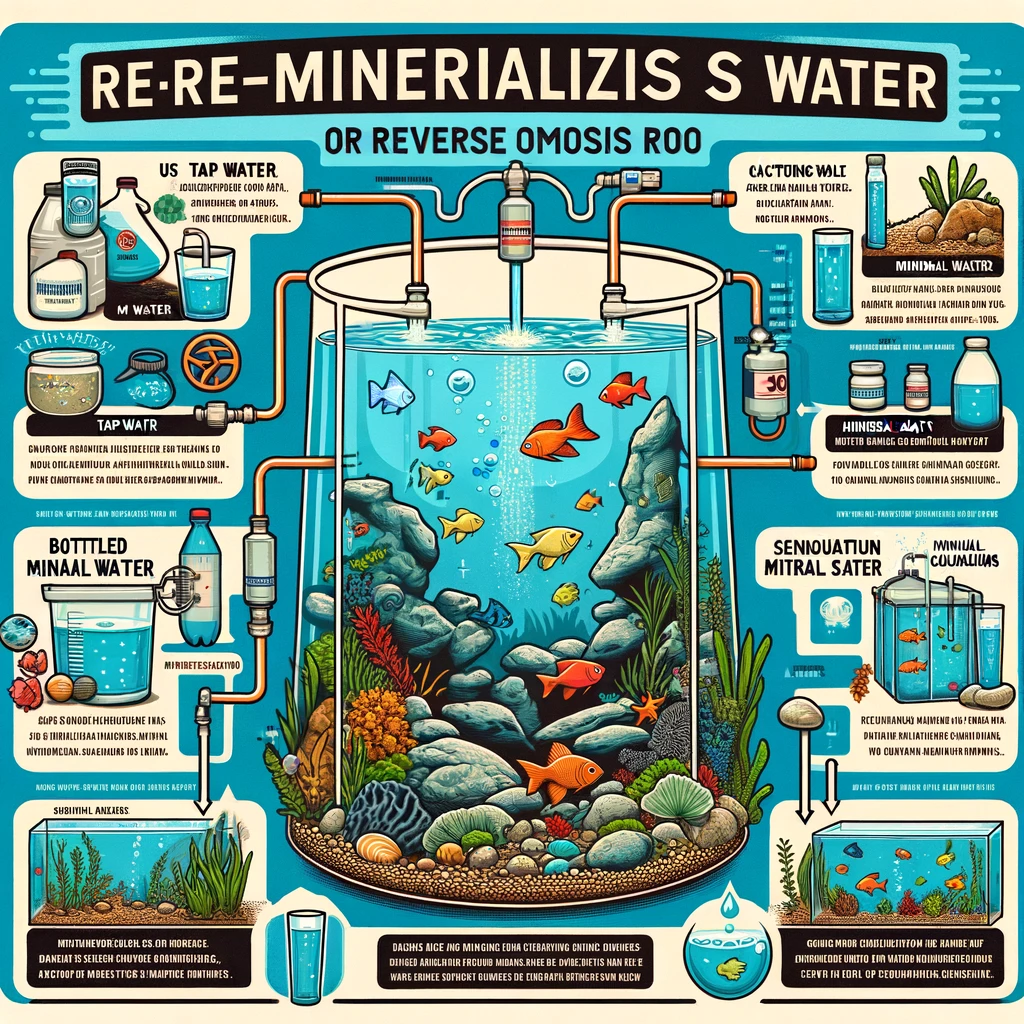
Re-mineralizing reverse osmosis (RO) water is crucial for aquariums, especially when creating specific water conditions required by certain fish species. Krause’s article in the Discus Yearbook 1999 provides essential insights and should be read alongside his book “Aquarienwasser” if one plans to undertake water re-mineralization independently.
Methods of Re-mineralization:
- Krause discusses the pros and cons of various re-mineralization methods including using tap water, bottled mineral water, mineral salts, and a calcium reactor.
- Important Consideration: A common misconception is the adequacy of using sodium bicarbonate (baking soda) alone for re-mineralization. This method is inappropriate by itself because it lacks crucial counterions such as magnesium or calcium. Using only sodium bicarbonate creates an unnatural ion balance and omits important hardness components, thus failing to maintain its buffering capability.
- Appropriate Use of Sodium Bicarbonate: It can be effectively used in a single instance to prevent a potential pH crash. When water already contains essential hardness-increasing salts like magnesium and calcium, sodium bicarbonate can help maintain buffer capacity.
Key Takeaway:
- For effective re-mineralization that mimics natural water conditions and maintains stability, it is vital to use a combination of minerals that includes both magnesium and calcium, not just sodium bicarbonate.
This approach helps ensure that the water chemistry supports the health and vitality of the aquarium inhabitants.
Enhance Your Aquarium with Preis-Aquaristik 220 Discus Minerals
Ensure your discus fish thrive with the Preis-Aquaristik 220 Discus Minerals. This premium supplement, available in a 1 kg container, is designed to mineralize reverse osmosis and soft water, providing all the essential minerals and trace elements needed for the health and vitality of your fish. By addressing mineral deficiencies, this product helps prevent issues such as fungal infections, deformities, and dark colouration in fish. Suitable for both professional and home aquarists, Preis-Diskus-Mineralien ensures that your aquarium water supports optimal fish health and growth.
Disclaimer: As an Amazon Affiliate, I earn from qualifying purchases.
Peat in Aquariums
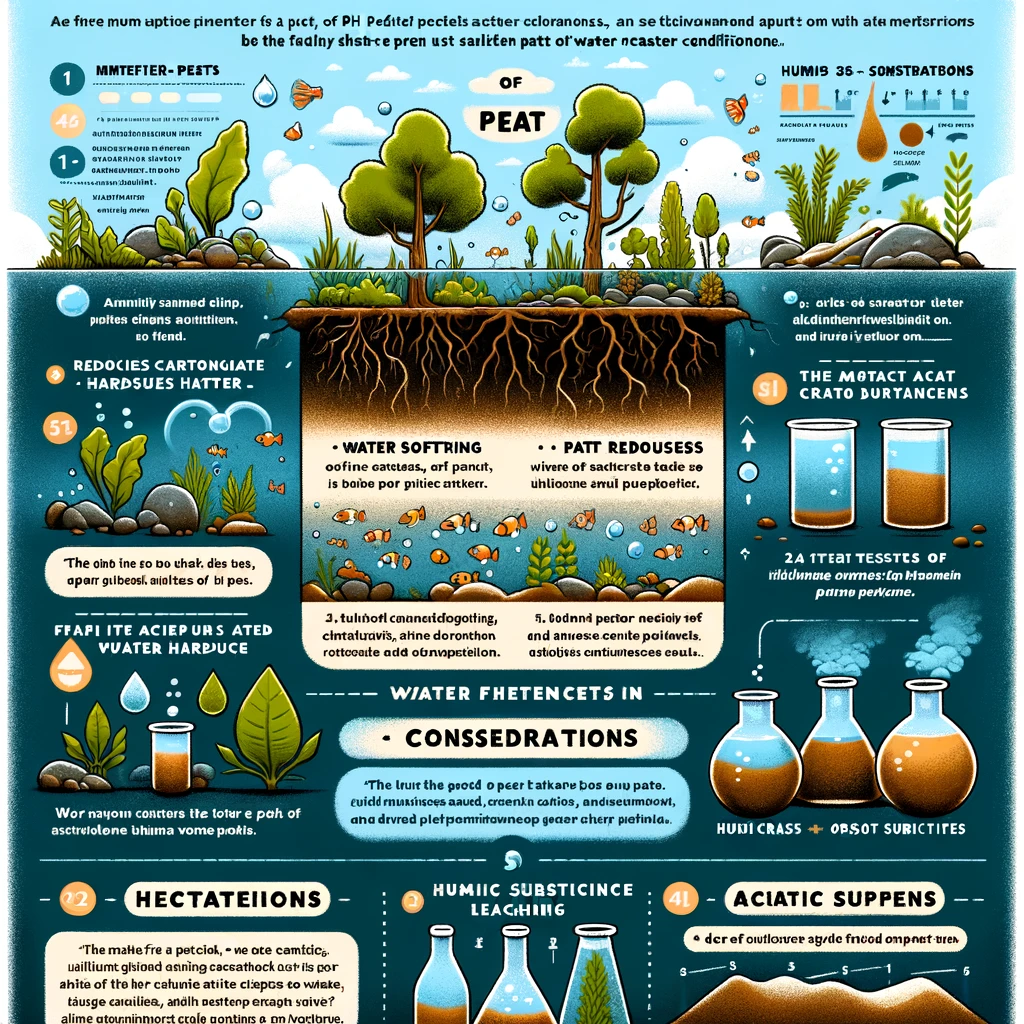
Peat is an invaluable filter material for conditioning aquarium water, especially proven in the care of discus fish.
Benefits of Using Peat:
- Water Softening: Acidic white peat can bind calcium, reducing carbonate hardness (KH), softening the water, and lowering conductivity.
- pH Reduction: Peat releases tannic acids, lowering the pH level and increasing organic substances in the water. It contains humic substances, tannins, and fatty acids, which have antifungal properties and reduce bacterial counts in aquarium water.
Considerations:
- Usage Amount: As a general rule, use about 0.5 to 1 litre of wet white peat per 100 litres of water, renewing it every two weeks. Always monitor water reactions, especially pH and nitrite levels.
- Impact on Bacteria: Peat’s antibacterial properties can impair nitrite-converting bacteria in unestablished aquariums or when used in a separate filter. Thus, peat should be the last component added to the filter.
- Acid Crash Risk: The risk of an acid crash can be managed by controlling the carbonate hardness, ensuring it does not drop below 2° KH.
- Initial vs. Long-term Effects: Peat reacts differently initially than it does with prolonged use. Short-term use may not significantly colour the water, whereas, after about four days, the water may darken considerably due to the leaching of humic substances.
- Impact on Plants: Peat can affect plant growth differently; algae typically decrease quickly, and shade-loving plants thrive, while light-loving plants may struggle due to reduced light penetration caused by the water’s brown colour.
- Contamination Risk: Many types of peat may be contaminated with phosphates (PO4) or nitrates (NO3) due to agricultural runoff, making them unsuitable for aquaristic use. Testing peat before use is essential to ensure it is free from such contaminants.
- Commercial Peat Granulates: Specially designed peat granulates from aquatics suppliers are more expensive but easier to use and apply according to manufacturer recommendations.
Peat can significantly improve the water quality in aquariums, especially for species that thrive in soft, acidic conditions, but it requires careful handling to avoid adverse effects.
Feeding Discus Fish
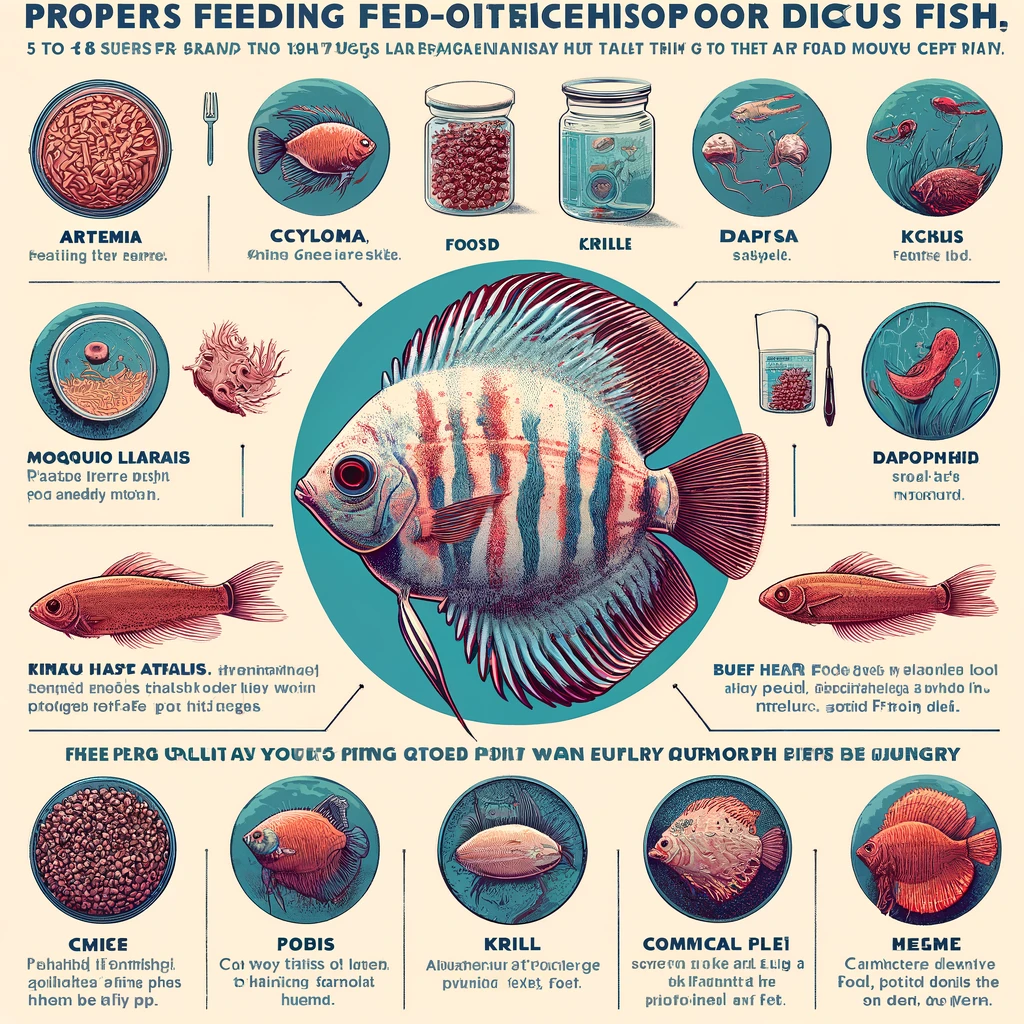
What and How Often to Feed?
Maintaining healthy and vibrant discus fish requires frequent feeding. The feeding schedule depends on the age and size of the fish:
- Young Fish: Feed 5 to 8 times per day.
- Adult Fish: Feed at least 3 times per day.
Types of Food:
- Live Food: Artemia, Cyclops, red, black, or white mosquito larvae, Daphnia, Mysis, and krill are highly nutritious and favoured by discus.
- Prepared Food: Rinderherz (beef heart mixtures) and commercially available flake and granulated foods.
Acclimating Fish to New Foods:
- Discus fish may take some time to adjust to new types of food. To facilitate this, introduce unfamiliar foods early in the day when the fish are most hungry. This encourages the fish to try new items. The key is to be persistent and patient as the fish learn to accept a variety of foods, rather than letting the fish dictate the menu.
This approach ensures that discus receive a balanced diet rich in the nutrients necessary for their health and growth.
Boost Your Discus Fish's Health and Color with Tetra Discus Granules
Promote the health, vibrant colours, and growth of your discus fish with Tetra Discus Granules. This specially formulated fish food, available in a 250 ml container, meets the unique nutritional needs of discus fish with its optimal blend of essential nutrients, vitamins, and trace elements. The slow-sinking granules allow for natural feeding behaviour, ensuring your fish receive the nutrition they need. Unlike frozen food, Tetra Discus Granules are safe from harmful pathogens, reducing the risk of disease. Suitable for discus fish of all ages, this high-quality food enhances their well-being and natural beauty.
Disclaimer: As an Amazon Affiliate, I earn from qualifying purchases.
Nutritional Components of Fish Food
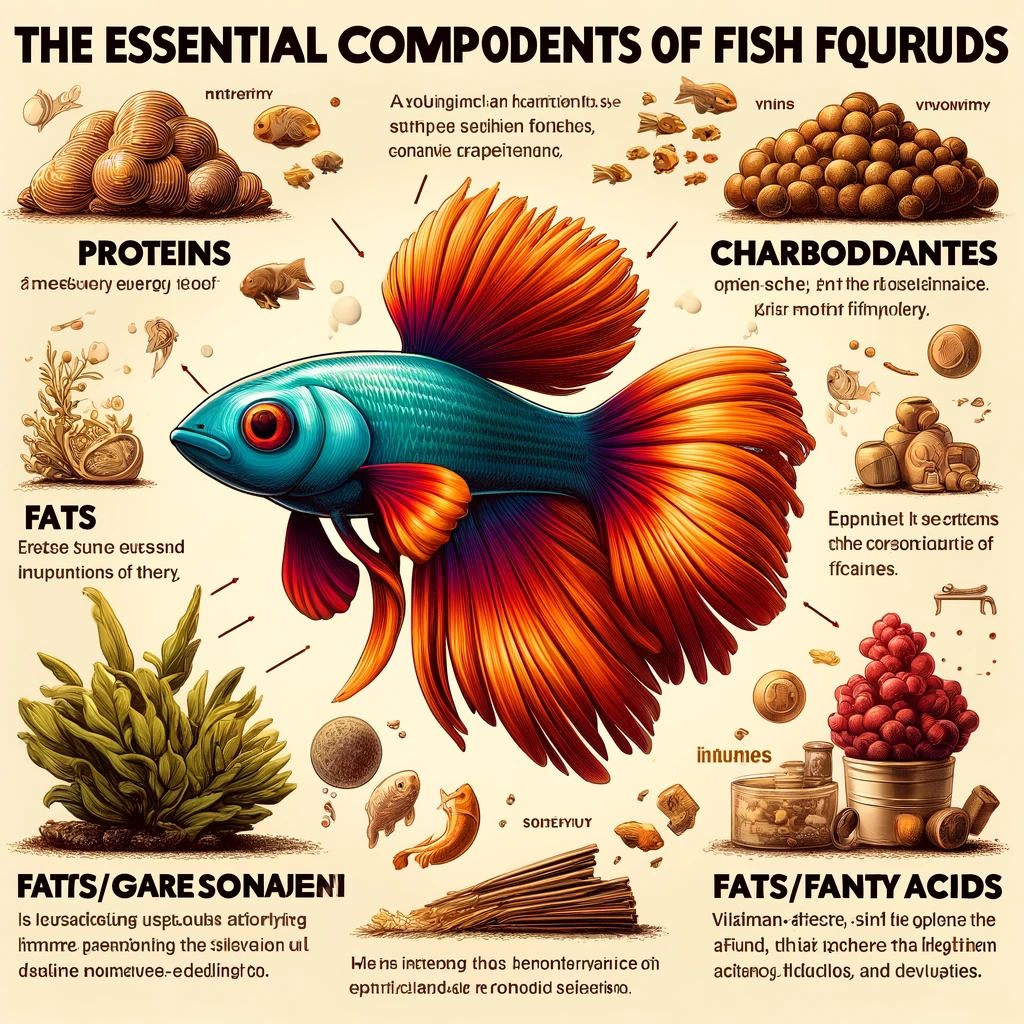
Good fish food provides not just calories but also a balanced and high-quality assortment of essential nutrients required by the fish.
Proteins
- Definition: Proteins are long-chain molecules made up of amino acids, essential for growth and critical for metabolic functions as enzymes.
- Importance: They are a primary component of the diet, vital for structural and functional purposes.
Carbohydrates
- Definition: A collective term for nutrients like sugars, starch, and cellulose. Carbohydrates are significant because they consist largely of carbon and are key energy sources and short-term energy storage.
Fats/Fatty Acids
- Definition: Ideal for nutrition and energy reserves in animal and plant cells. Plant fats often contain polyunsaturated fatty acids, which are essential as the fish cannot synthesize them.
- Role: Fats are also important for transporting fat-soluble vitamins.
Fibre
- Benefits: While not nutritive per se, fibres are crucial for a healthy diet as they enhance and optimize the digestive process.
Vitamins and Trace Elements
- Function: These are not nutrients in the traditional sense but are crucial for supporting metabolic functions without being consumed in large amounts.
- Necessity: They must be regularly included in the diet as they cannot be synthesized by the animal’s body. Deficiencies can lead to severe, often untreatable diseases.
Each of these components plays a vital role in maintaining the health, vitality, and longevity of fish, particularly in an aquarium setting where dietary needs must be carefully managed to replicate natural feeding conditions.
Enhance Your Fish's Color with Tetra Pro Colour Multi-Crisps
Achieve vibrant and beautiful fish with Tetra Pro Colour Multi-Crisps. This premium fish food, available in a 500 ml container, is specially formulated with colour concentrates to enhance the natural colours of your fish. The unique crisps are produced using a low-temperature process that preserves vitamin stability and maintains high nutritional value. Designed for minimal water pollution, these crisps ensure a cleaner and healthier aquarium environment. Suitable for fish of all ages, Tetra Pro Colour Multi-Crisps support growth, health, and vibrant colouration making them an excellent choice for any aquarium.
Disclaimer: As an Amazon Affiliate, I earn from qualifying purchases.
Can Live Food Be Used in Aquariums?
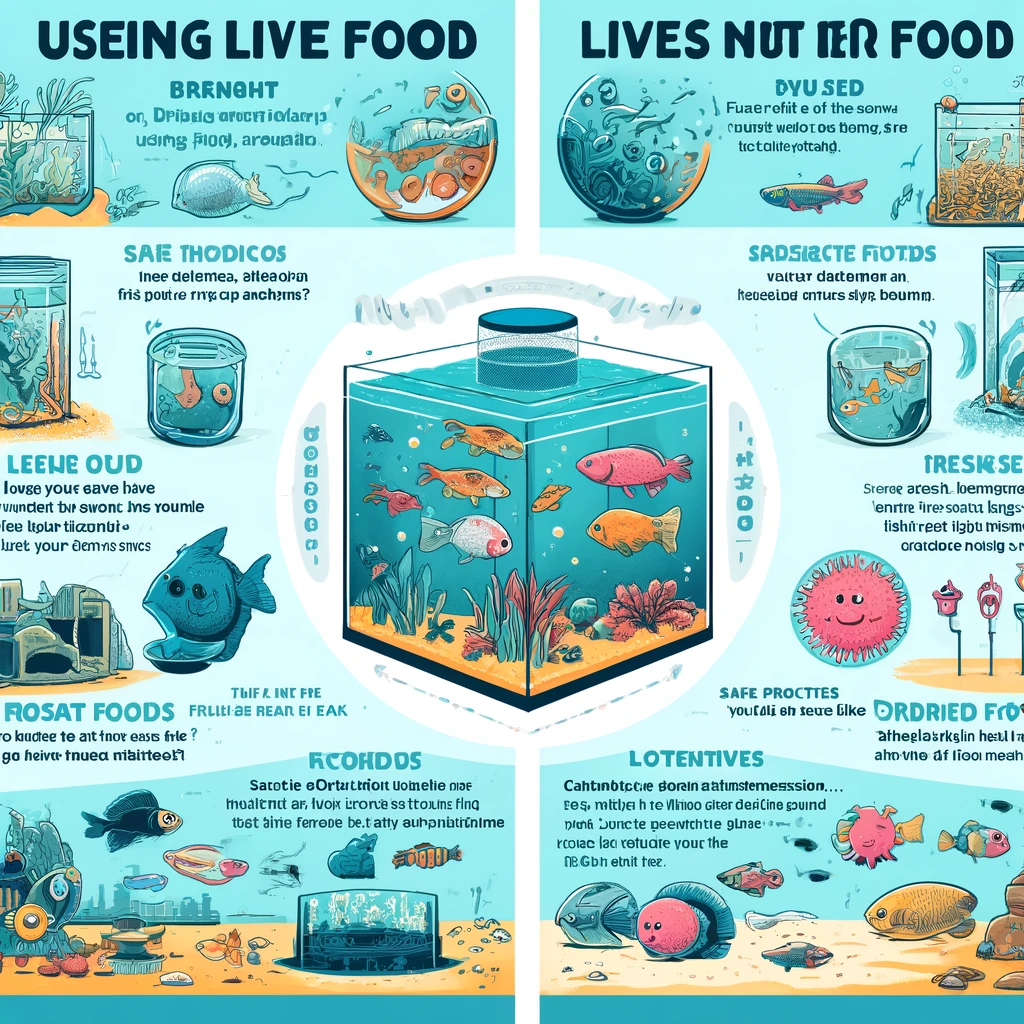
Live food is a treat for fish but comes with its risks. The joy of consuming live food can be marred by potential diseases it might introduce into the aquarium.
Risks Associated with Live Food:
- Disease Risk: Live food can be a vector for diseases. Without knowing its source or what it has come into contact with, using live food can unknowingly introduce pathogens into your aquarium.
- Uncontrolled Quality: The quality and cleanliness of live food cannot always be verified unless you breed it yourself or source it from fish-free environments.
Safe Practices for Using Live Food:
- Self-Cultivation: Breeding your live food like Enchytraeus worms or raising mosquito larvae at home can be fun and provide safer, controllable food sources—though it might also lead to domestic disputes!
- Sourcing: Collecting live food from clean, uncontaminated, fish-free waters is another safe method.
Alternatives to Live Food:
- Frozen and Dried Foods: These are safe, convenient alternatives to live food. Most frozen foods like mosquito larvae are readily accepted by fish and are less likely to cause marital strife when stored in your freezer. Pet stores offer a wide variety of these products.
- Benefits of Non-Live Food: Using frozen and dried foods reduces the risk of introducing diseases into your aquarium and provides a balanced diet.
Caution:
- One infected piece of live food can cause significant issues, so consider the risks carefully when making your choice.
Live food can enhance the vitality and health of your aquarium fish when used correctly and sourced safely. However, considering the potential risks and opting for safer alternatives might be a wiser choice for both the health of your fish and domestic harmony.
Feeding Competition Among Discus Fish
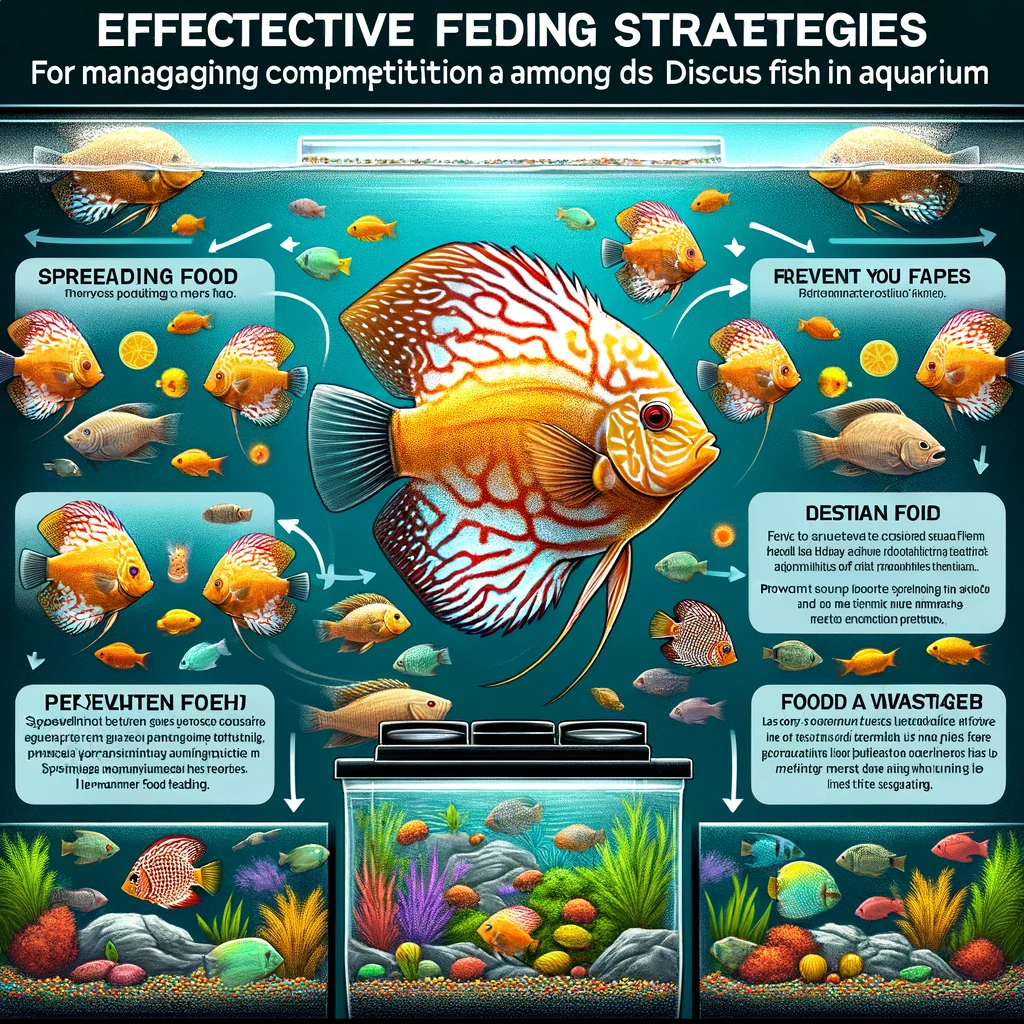
Competitive Feeding: It’s not uncommon for discus fish, which are part of the cichlid family, to exhibit competitive behaviour during feeding. This is typical of their nature and lineage.
Feeding Strategy:
- Spread Feeding: To ensure that all fish get their share, it’s advisable to distribute the food across the entire tank rather than in a single spot. This technique prevents dominant individuals from monopolizing the food supply.
- Avoid Filter Issues: Care should be taken to ensure that food particles are not sucked into the filtration system, where they can decompose and degrade water quality.
Recommendations:
- By feeding in a widespread manner, you can minimize conflicts and ensure that each fish receives enough nutrition. This method also helps maintain better water quality by reducing the chance of food decay within the tank.
Feeding Discus Fish: Ensuring Health and Vitality
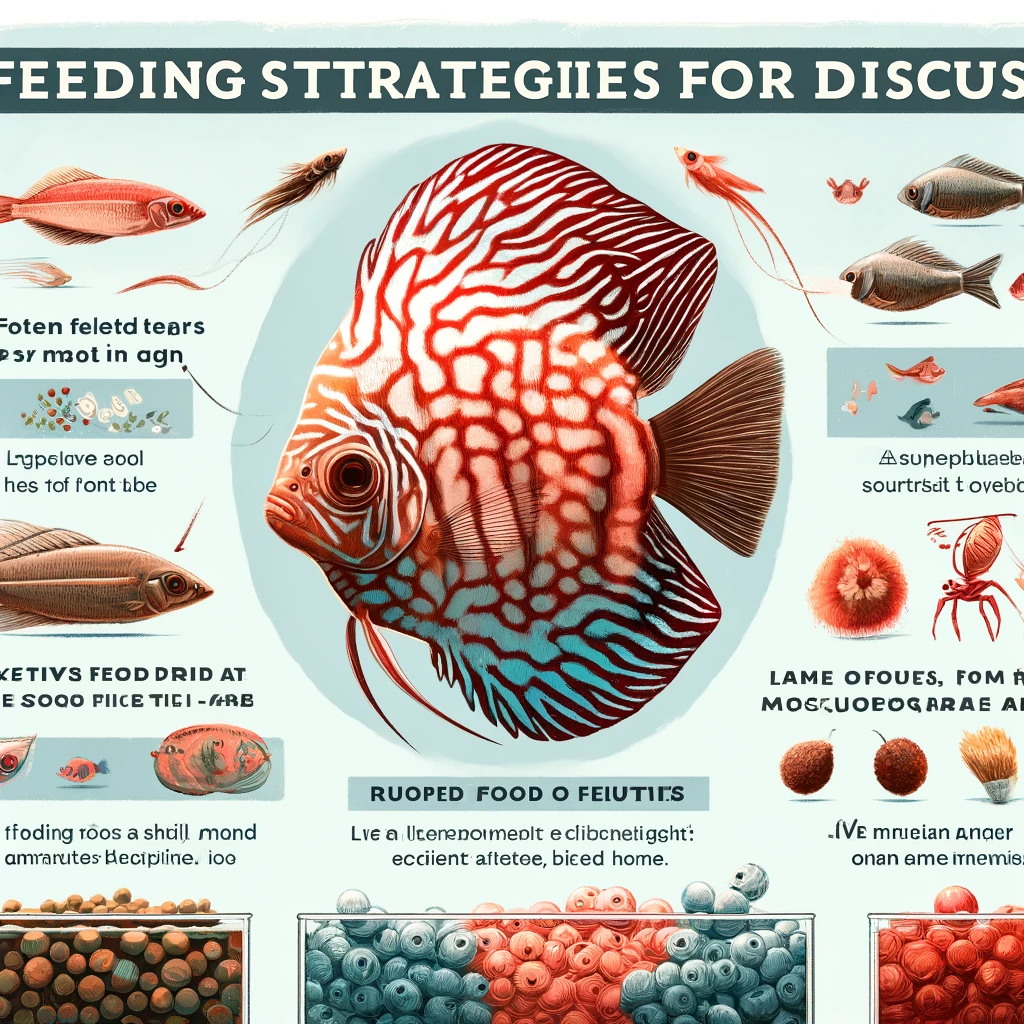
Feeding Frequency and Quality: Healthy discus fish exhibit constant appetite throughout the day, but it’s crucial to feed them in moderation to maintain optimal water quality. It is advisable to feed often but in smaller quantities. The diet should be varied to ensure all nutritional needs are met.
Controversial Foods: Despite some controversy among discus keepers, especially around feeding beef heart, it remains a staple in many feeding regimens. However, when feeding beef heart, ensure to supplement the diet with adequate fiber, such as chitin, which is naturally found in the exoskeleton of mosquito larvae and Artemia.
Daily Feeding Practices:
- Adult Discus: Feed 2–3 times per day, with no more than one meal consisting of beef heart to avoid digestive issues.
- Young Discus: Feed 5–6 times daily to support rapid growth and prevent developmental problems.
Frozen and Live Foods:
- Frozen food, especially from reliable brands, should be 99% of the diet to avoid risks of disease transmission. Always check for freshness and avoid any food that appears to have been thawed and refrozen.
- Live food, sourced from fish-free waters or bred at home, such as Artemia or Enchytraeus, is highly recommended over commercial artificial feeds. Tubifex worms, thoroughly rinsed, can also be beneficial.
Special Considerations:
- FD (Freeze-dried) food is a safe and effective option that poses no risk of parasite transmission.
- Discus fish may become finicky with their food preferences. If they resist new types of food, patience and gradual introduction are key.
Quantity and Duration of Feeding: Feed in such a quantity that the food is consumed within 10 minutes to prevent overfeeding and maintain water quality. For adult fish, occasional fasting is beneficial and well-tolerated.
Key Takeaway: Managing the diet of discus fish is crucial for their health and growth. Ensuring a varied and balanced diet, using safe food sources, and adapting feeding practices as they grow are essential steps for any discus keeper.
Maintaining Artemia for Feeding Discus Fish
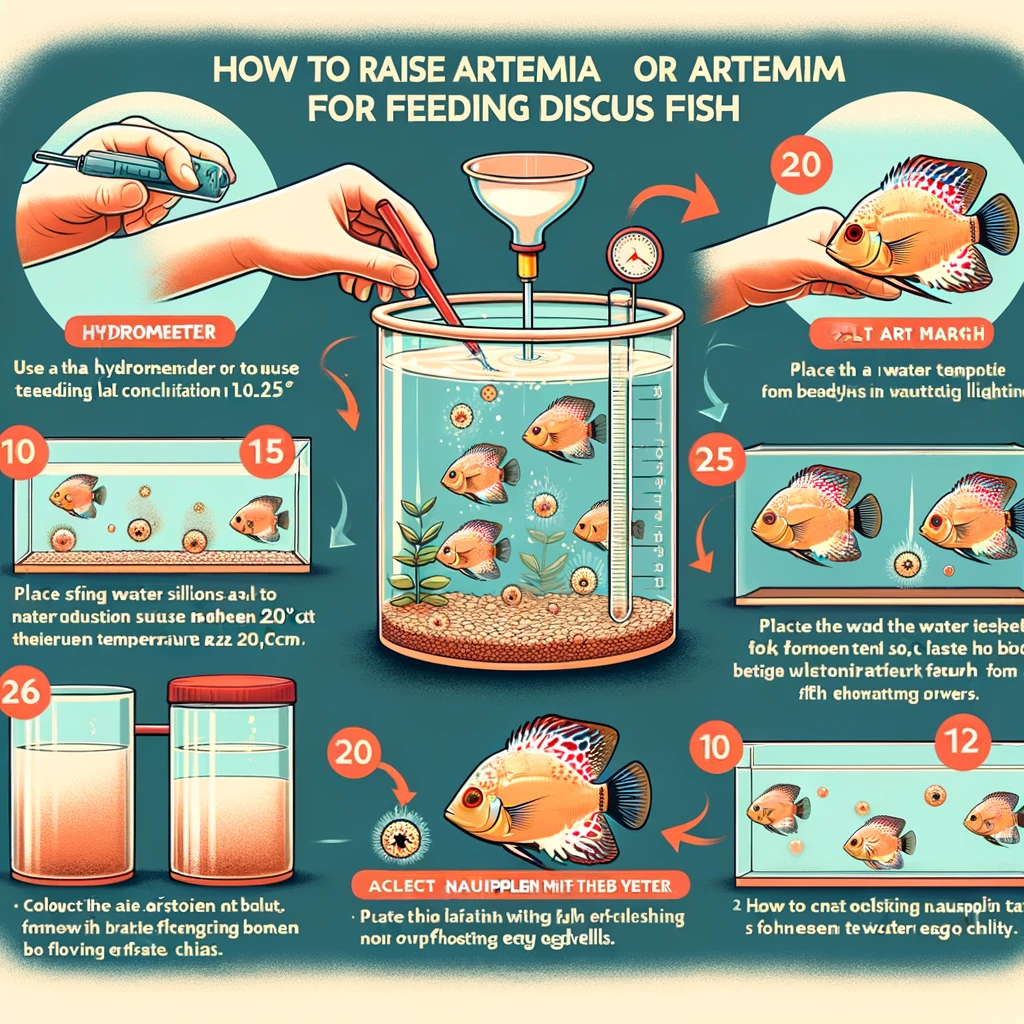
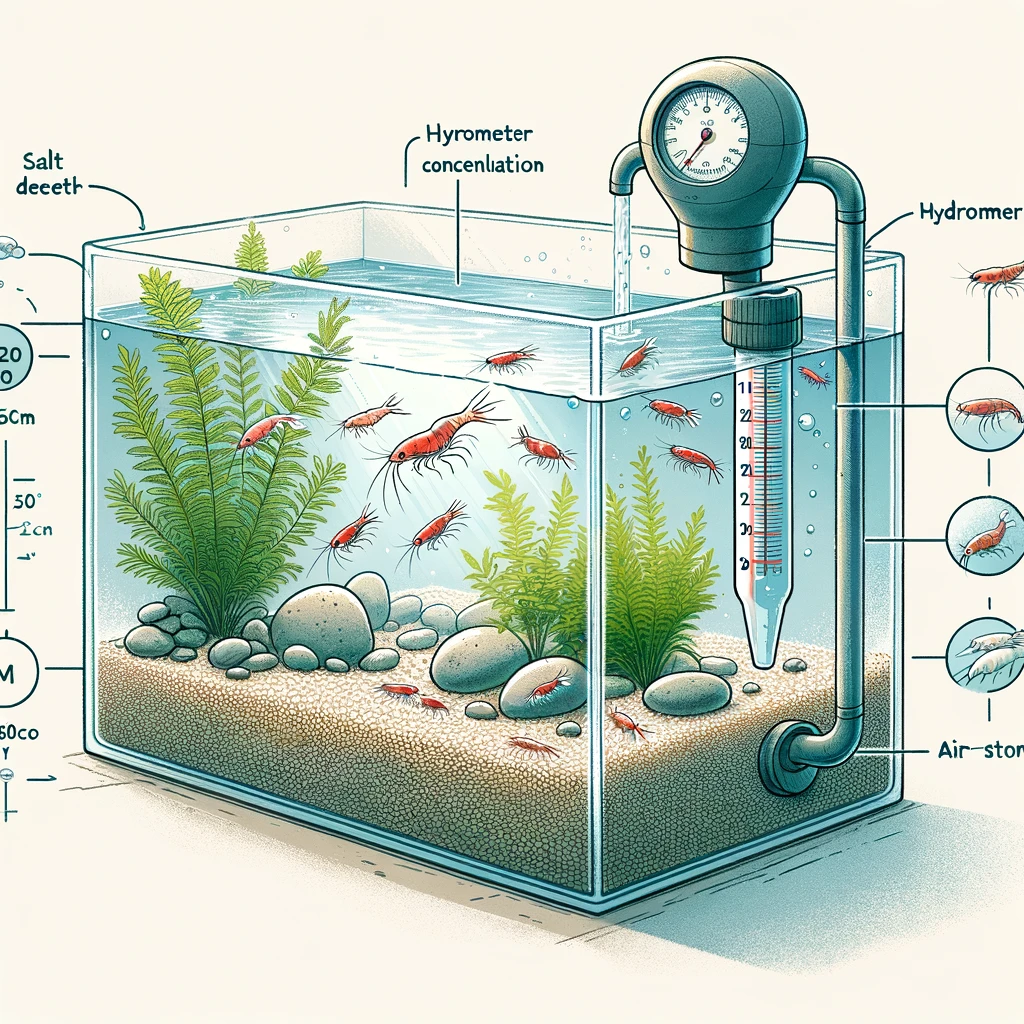
Artemia eggs are readily available at any pet store. After hatching, the small brine shrimp should be transferred to a larger aquarium with a slightly higher salt concentration. The ideal salinity, measured using a hydrometer, should be between 1.025 and 1.035. Place an airstone in the saltwater to provide necessary aeration. This setup allows for year-round feeding of live Artemia to your fish. If the breeding aquarium is positioned on a windowsill, artificial lighting becomes unnecessary.
The water depth in the breeding aquarium should not exceed 25 cm, and the temperature should be maintained between 25 and 30°C. Feed the brine shrimp with baker’s yeast, taking care to avoid overfeeding as it can deteriorate water quality and jeopardize the entire culture. Only sprinkle enough yeast on the water surface to avoid clouding the water.
Brine shrimp nauplii can be rapidly cultured to meet specific needs, making them ideal for feeding fry. To set up the breeding environment:
- Fill a special container with salt water (20 grams of non-iodized salt per litre of water).
- Add 1 to 2 teaspoons of cysts (available from pet stores) and place in a warm area (20 to 28°C).
- After the larvae hatch in two to three days, turn off the aeration and wait for the nauplii to settle at the bottom. The empty eggshells will float to the surface.
- Collect the nauplii through an air hose over a feeding sieve.
Decapsulated Artemia Nauplii: The Ideal Feed for Cultivating Fish
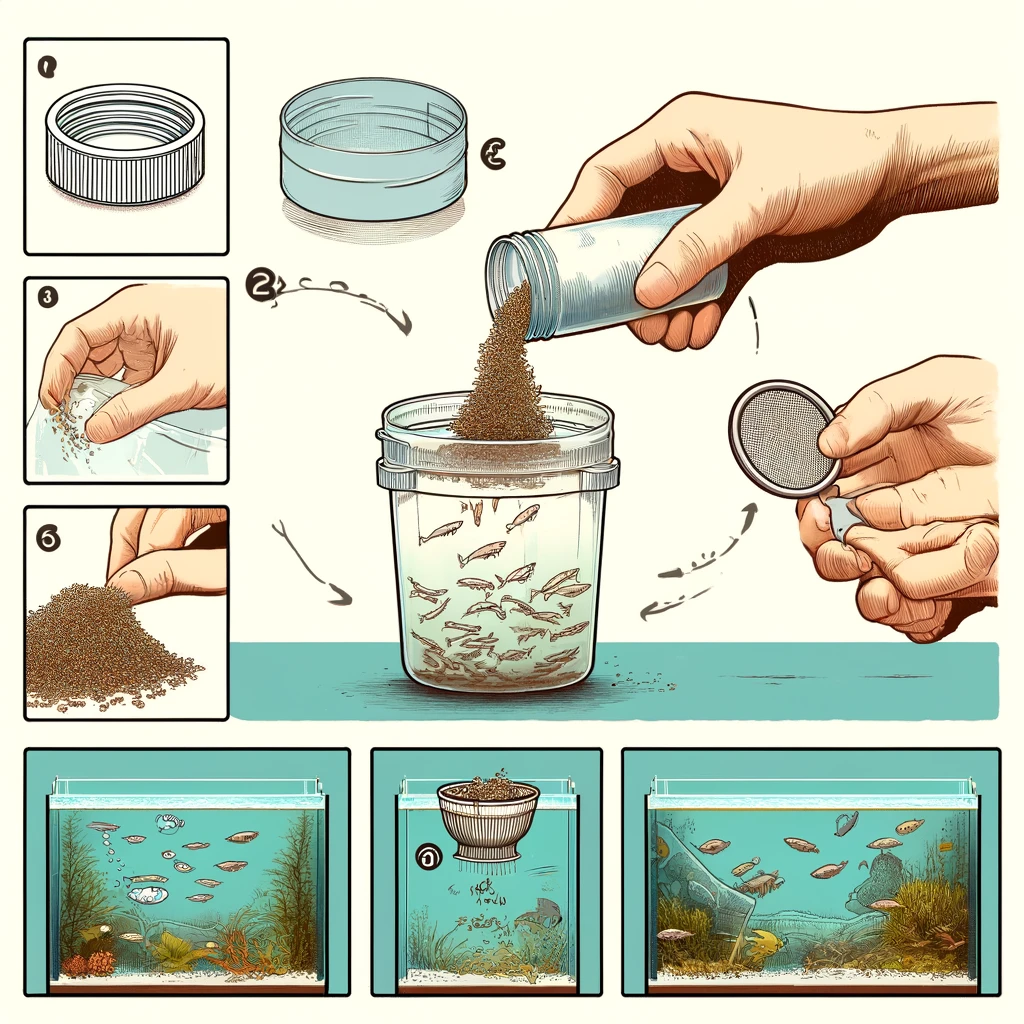
Unlike Artemia eggs, which need aerated saltwater to hatch, decapsulated Artemia nauplii are ready to use at any time. To feed them to your fish, simply soak them for about 20 minutes in a small container of aquarium water. The drying process used in their preparation makes them hard, which may initially cause some young fish to reject them. Soaking softens the nauplii, eliminating this issue.
“Decapsulated” refers to the removal of the shell from Artemia eggs, leaving behind the unhatched nauplii. These are almost indistinguishable from hatched Artemia nauplii in colour (reddish-brown) and texture. Originally used in pond aquaculture due to their high protein content, their value was quickly recognized by aquarists, and soon, breeders of live-bearing species began to use decapsulated Artemia nauplii as well.
With decapsulated Artemia nauplii available, you always have excellent feed for young fish. This method can replace the sometimes cumbersome process of setting up Artemia eggs in bubbling bottles, unless you need live, moving food for the very first weeks of the smallest fry’s life.
Quick Guide
- Fill a small, sealable container (e.g., a clean, rinsed film canister) with a little aquarium water.
- Add the required amount of decapsulated Artemia nauplii and shake well.
- Shake again after about 10 minutes.
- After 20–25 minutes, pour the contents through an Artemia sieve and feed to the fish.
- Rinse the container in the aquarium to clean it.
- Done.
Raise Your Own Live Fish Food with the JBL Artemio Set
Cultivate nutritious live food for your fish with the JBL Artemio Set, a complete kit designed for hatching Artemia nauplii (brine shrimp). Perfect for any aquarist, this set includes everything you need to start producing live food within 24-48 hours. The kit features a funnel-shaped hatching container, an air pump, a catch container, an Artemia sieve with a 0.15 mm mesh, a stand with screws, an air hose, and a check valve. Simply fill the hatching container with special salt and Artemia eggs (sold separately), connect the air pump and wait. The efficient design ensures maximum hatch rates by keeping the nauplii in constant motion. The JBL Artemio Set is expandable, allowing you to connect additional hatching containers for a continuous supply of live food, essential for the healthy growth of young fish.
Disclaimer: As an Amazon Affiliate, I earn from qualifying purchases.
Cultivating Enchytraeus Worms for Fish Feeding
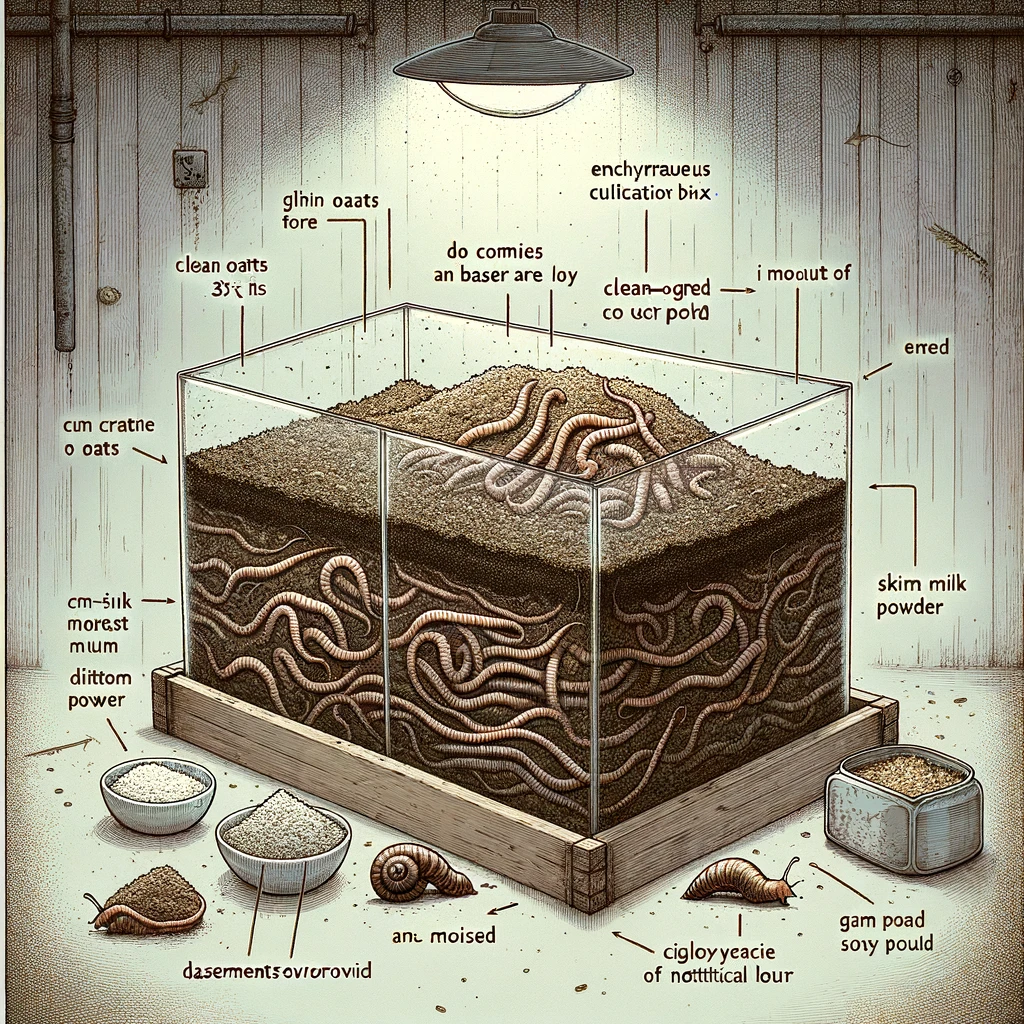
Enchytraeus worms are an excellent source of live food. Despite longstanding concerns that frequent feeding of these worms could cause fattening of internal organs like the liver, or lead to diseases and even sterility in fish, inquiries with various breeders who feed large quantities to their fish have not confirmed these issues. No diseases or breeding difficulties were observed, even with heavy Enchytraeus feeding. Young discus fish display vibrant colouring and show healthy growth when fed these worms.
Enchytraeus can be cultivated in closed containers or Styrofoam boxes. The ideal size for such a cultivation box is 30×30 cm in the base area with a height of 15 cm. Clean, fine-grained soil should be filled to a height of about 8 cm and moistened. The soil must be kept moist, but not soaking wet. The optimal temperature for cultivation seems to be around 15°C, and a diffuse, semi-dark environment is beneficial, making basement spaces highly suitable for these breeding boxes.
There are countless recipes for the composition of the feed. Some aquarists feed only oats, which I find less favourable due to the increased fat content in the worms. I prefer a mix of ground oats (70%), skim milk powder (10%), nutritional yeast (10%), and soy flour (10%)—all available in health food stores. I sprinkle the feed in the centre of the box on the soil and moisten it, along with the rest of the soil, using a plant mister. I then cover the feeding area with a glass plate. Once the culture is densely populated with worms, a little feed can also be spread over the rest of the soil surface. Feed is replenished whenever it is completely consumed. Overfeeding leads to mouldy food and might attract mites.
In contrast to mites, woodlice in the boxes should be welcomed, as they are harmless to our Enchytraeus and also help consume any potentially present mites.
Recommendation:
In new breeding setups, Enchytraeus worms tend to disperse across the entire box. Therefore, I recommend starting with daily feeding of small amounts of food (which should be consumed within a day) until the worms gather again under the glass plate. ‘Small amounts’ may initially mean five to ten flakes of oats! Depending on how quickly the food is consumed, you can gradually increase the food portions. Flake food (fish food) is also suitable for initial feeding and is eagerly consumed, but it is too expensive for long-term use.
European Nightcrawlers: Excellent for Fishing, Composting, and More
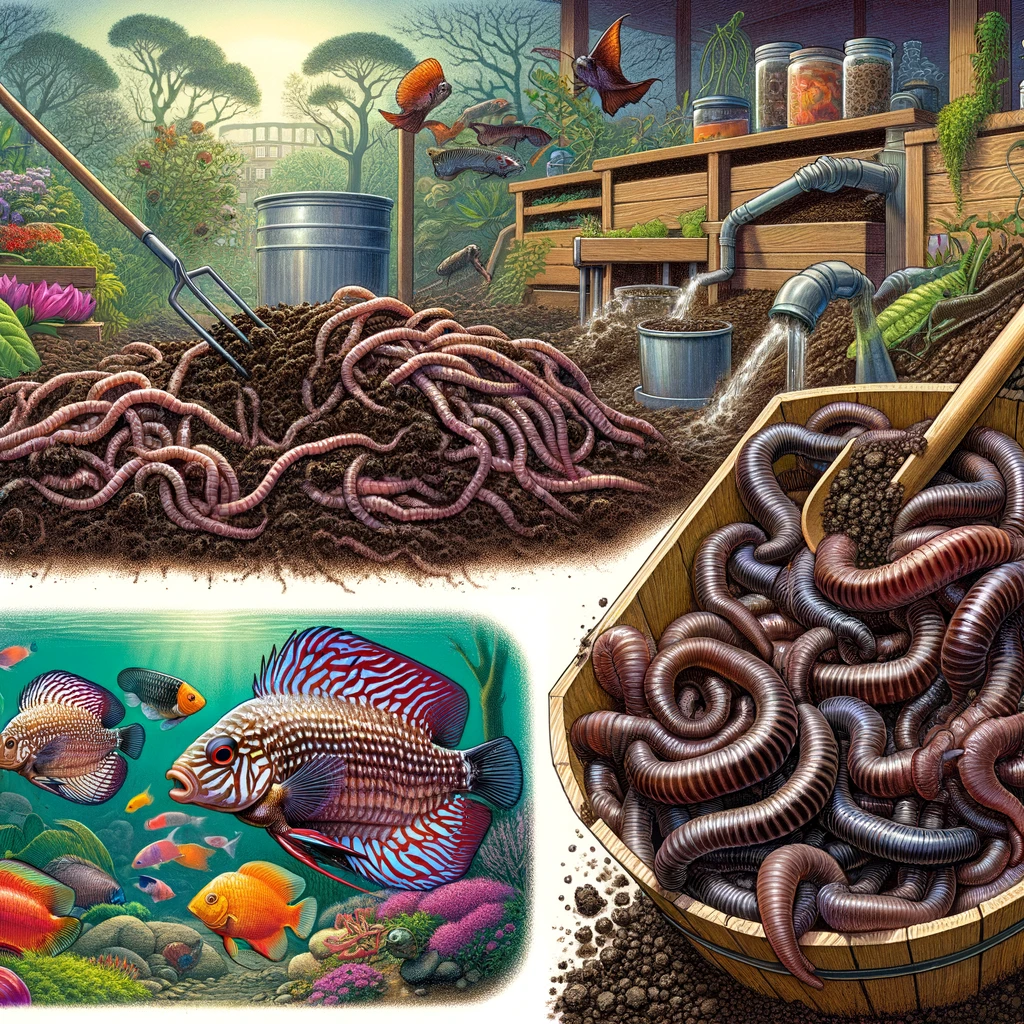
The European Nightcrawler, also known as the Riesen-Rotwurm, is an outstanding bait worm, known for its robust features. Increasingly, it is also used for composting. As a garden worm, it aerates the soil, breaks down heavy metals, produces valuable worm castings, and acts as a natural soil enhancer. For many creatures in terrariums or aquariums, as well as for birds, the European Nightcrawler serves as a sensible dietary supplement.
Initially, my discus fish had to get used to this type of food. I had to cut the worms into bite-sized pieces to help the fish acquire a taste for them. Nightcrawlers are quite tough, and it was a struggle for the discus to swallow them whole. Today, they have mastered the technique and eagerly devour these worms! The worms can be kept and even propagated in non-fertilized soil or specialized earth. They feed on moist corrugated cardboard, which I enrich with nutrients and vitamins.
Cultivating Microworms for Fish Fry
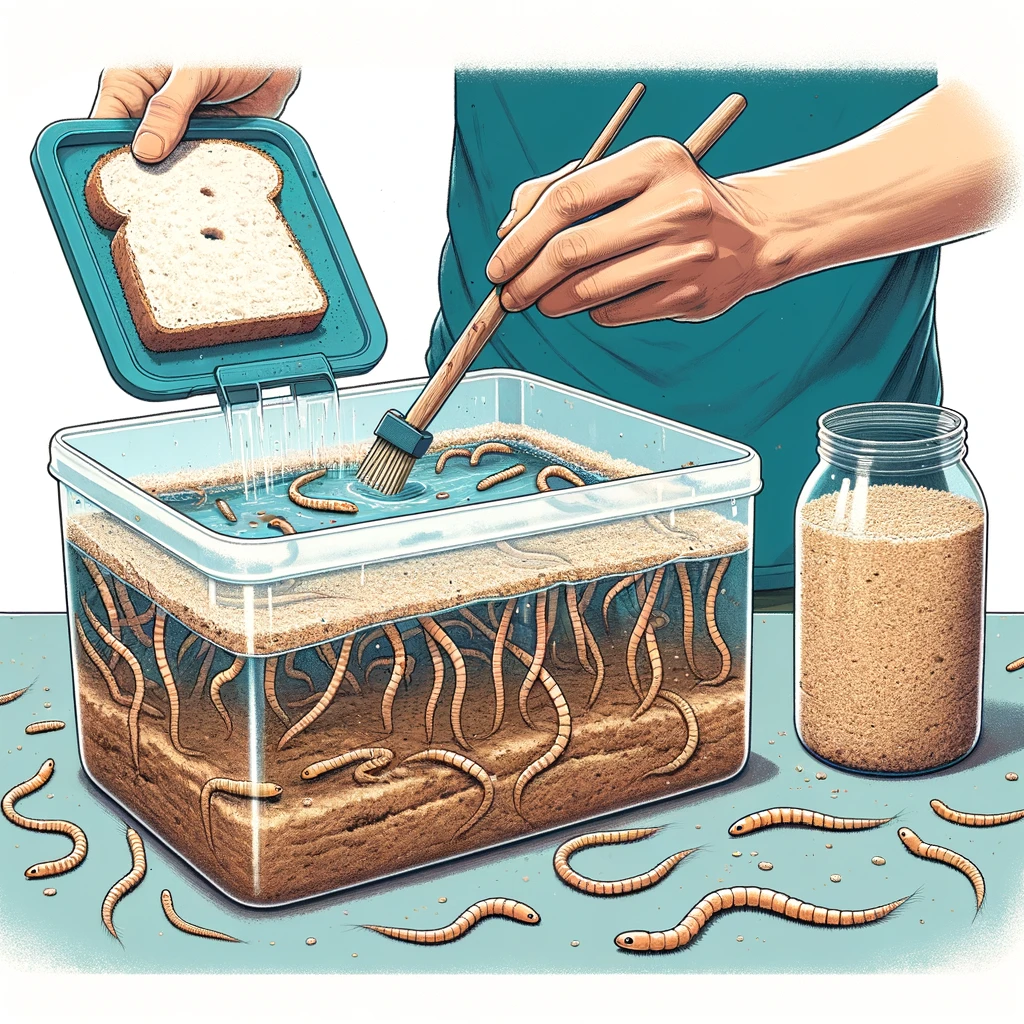
Vinegar eels and other microworms, typically only a few millimetres in size, are excellent for raising fish fry due to their small size. While the cultivation process is simple, it might not be suitable for those sensitive to smells. For cultivation, use a flat plastic container with a lid. Fill the container with stale bread from which the crust has been removed. Alternatively, thick-cooked oats can be used instead of bread. The starter culture, which can be obtained through ads or from fellow aquarists, should be kept moderately moist. At 25°C, the worms develop quickly. Once they start climbing up the sides of the container, they can be easily harvested with a brush.
Cultivating Grindal Worms for Fish Feeding
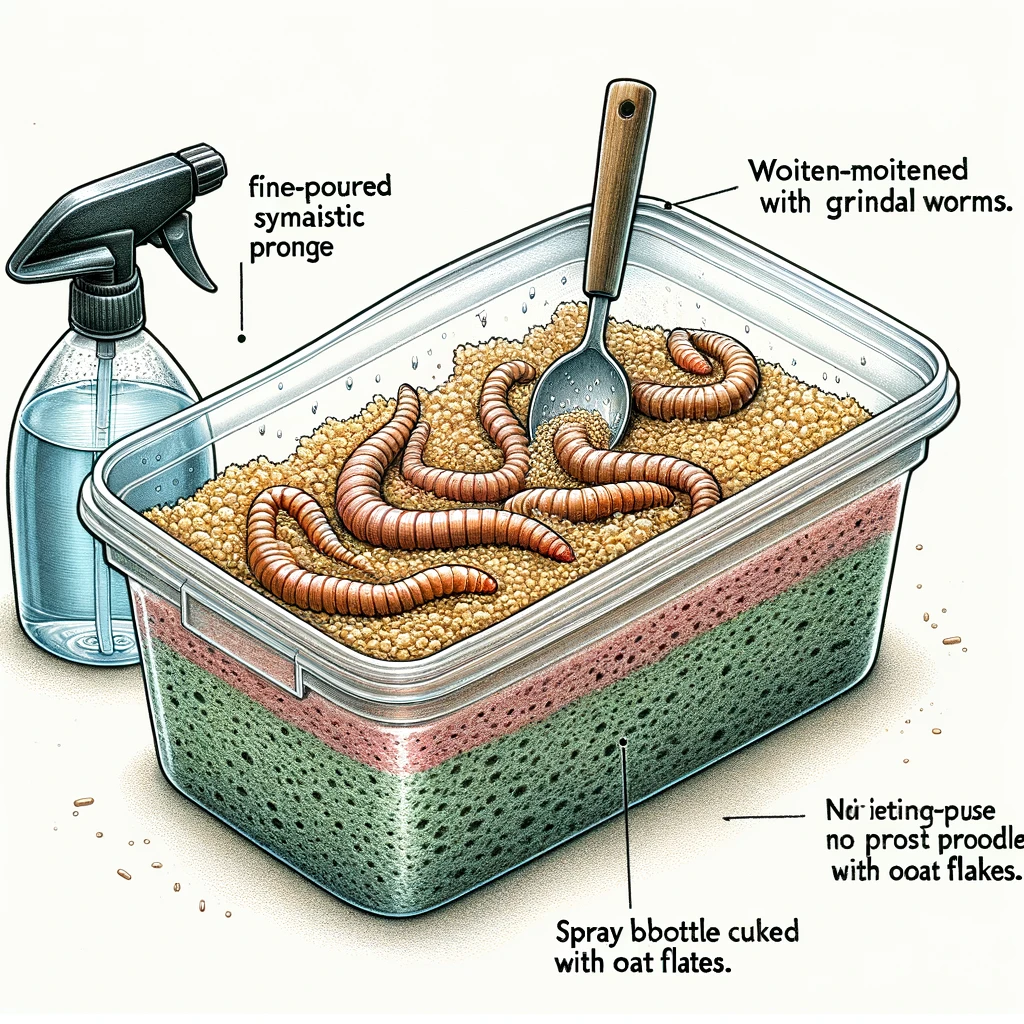
Grindal worms, due to their high nutritional content, should be used as supplementary feed. They are particularly suitable for raising young fish but are also favoured by all other small fish species. To start the culture, place a 5 cm high fine-pored synthetic sponge in a similarly sized plastic container with a lid. Moisten the sponge, inoculate it with the worm culture, and sprinkle with oat flakes. Keep the flakes moist using a spray bottle. Only add as many flakes as the worms can consume in 24 hours to prevent mould formation. The worms can be harvested from the surface of the sponge using a small spoon. If the sponge discolours over time, gently wash it under lukewarm water. The worms will remain in the pores of the sponge and will not be harmed.
Mosquito Larvae: A Versatile Fish Food
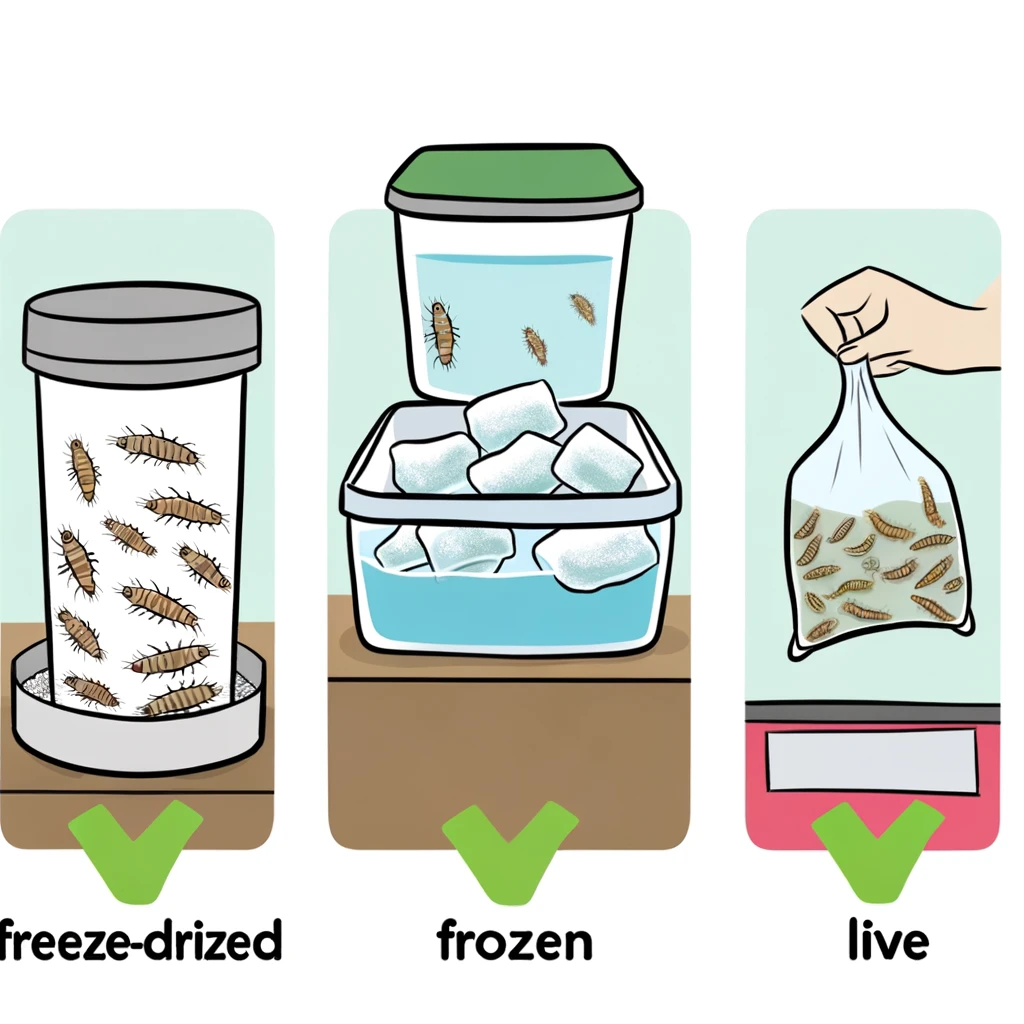
Mosquito larvae are among the most commonly used foods in aquaculture due to their high nutritional value. They are available in three forms: freeze-dried, frozen, and live.
Freeze-Dried Mosquito Larvae
This preservation method is arguably the least effective. Freeze-dried larvae contain no vitamins and are generally not recommended for aquarists. Sometimes, fish may even refuse to eat them, yet they are still commonly found in the market. If you want to provide quality food for your fish, it’s better to opt for frozen or live larvae.
Frozen Mosquito Larvae
I usually add the frozen food cube directly to the water. Some thaw the food or rinse it with warm water before feeding, but I do not recommend these methods as they can accelerate the decomposition process. Unlike freeze-dried larvae, frozen mosquito larvae retain many vitamins and nutrients in a form that is beneficial for fish. Therefore, they are an ideal food for ornamental fish.
Feed mosquito larvae sparingly to avoid fouling the water; uneaten larvae can decay and lead to water contamination. Overfeeding, especially with red mosquito larvae, can cause digestive problems and even lead to fish mortality—although this occurs only with excessive feeding. Black mosquito larvae, which are very nutrient-rich, can stimulate spawning in many fish species. White larvae, however, are not as rich in nutrients and vitamins as the red and black varieties.
Do not confuse red mosquito larvae with Tubifex worms, which are not mosquito larvae but live in heavily polluted water and should not be fed to ornamental fish.
Live Mosquito Larvae
Live mosquito larvae also retain a high content of vitamins and nutrients. They are often sold in sealed plastic bags with water and can be stored in the refrigerator for weeks without turning into mosquitoes or dying. However, the longer the larvae are stored, the more their nutritional value decreases as they continue to consume nutrients even at low temperatures.
You can also harvest mosquito larvae from nature, such as from ponds or ditches, but be careful not to introduce fish parasites or pathogens into your aquarium. And while it might be cheaper to collect your own, purchasing them from a reputable dealer ensures safety.
Feeding live food like mosquito larvae is more interesting to observe as it triggers the hunting instincts in fish—a fascinating spectacle. Everyone should occasionally feed live mosquito larvae to their fish, if only for the enjoyment of watching.
Caution with Feeding Mosquito Larvae: Always feed mosquito larvae sparingly. Excessive feeding of frozen larvae that are not fully consumed can severely impact water quality, potentially leading to algae blooms or even fish death. The same caution applies to feeding live larvae—less is often more, unless you want to risk them developing into flying mosquitoes and causing a mosquito infestation in your home, especially if they are black larvae that can turn into biting mosquitoes.
Flake Food: A Comprehensive Guide for Ornamental Fish
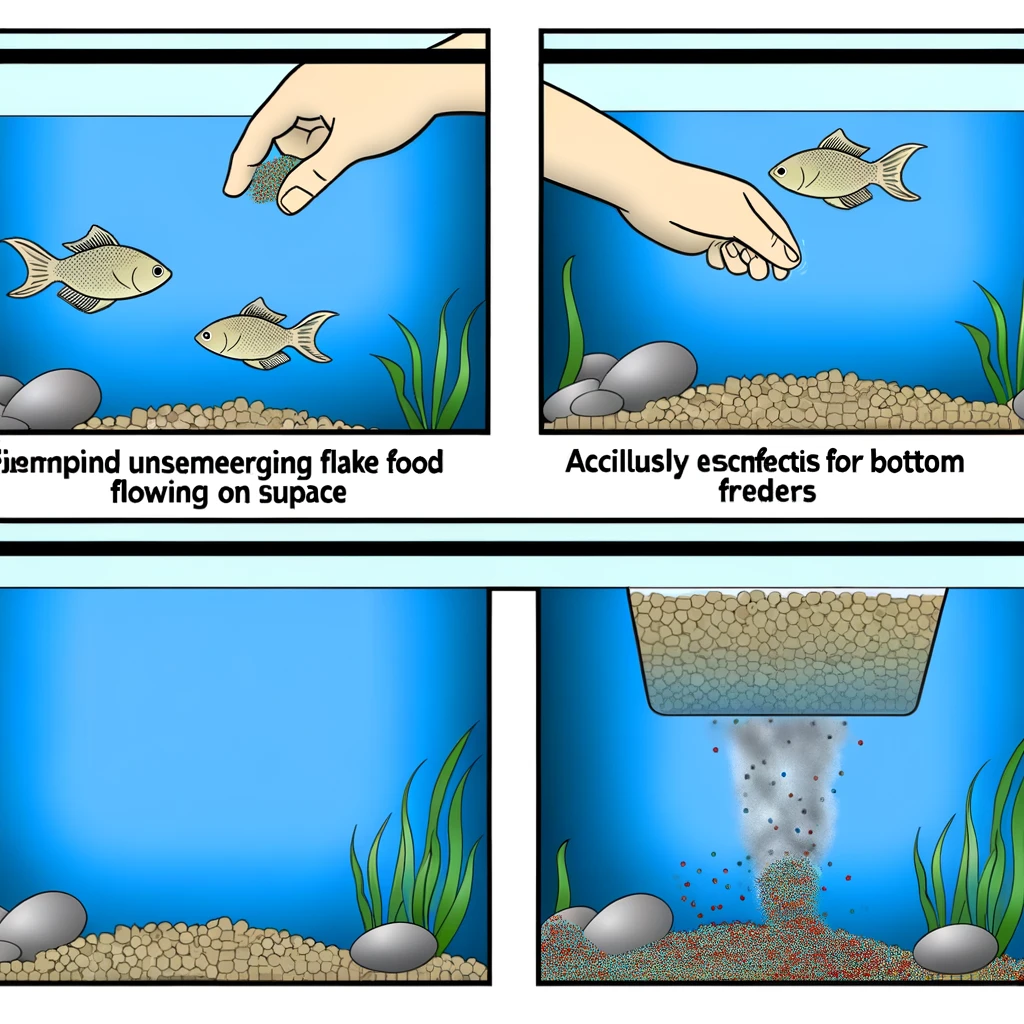
The quality of artificial ornamental fish food available in the market today, commonly referred to as flake food, has improved significantly. It is now entirely feasible to feed your fish exclusively with flake food. However, it’s important to choose brand-quality flake food, even if it costs a bit more.
Identifying High-Quality Flake Food
Good quality flake food can be identified by the presence of vitamins, minerals, and trace elements listed on the packaging. These indicators typically reflect a high-quality product. Discus fish, for example, usually accept flake food only if they have been accustomed to it from a young age; otherwise, it can be challenging to adapt adult fish to flake food.
Feeding Moderately
As with all types of fish food, overfeeding should be avoided with flake food. Feed only as much as the fish can consume within a few minutes. Any excess floating in the tank or on the water surface is too much and can degrade water quality.
Flake Food for Bottom-Dwellers
Since flake food tends to float at the surface, it is often inaccessible to bottom-dwelling fish like catfish and loaches. To ensure they receive nutrition, you should compress some flake food between your fingers and submerge it until it is waterlogged enough to sink. This method is more effective and preferable to feeding tablets.
Drawbacks of Feeding Tablets
Although feeding tablets are available for bottom-dwellers, they have disadvantages. They are made from ground and pressed flake food which can disintegrate in water. The milled mush may float around in the tank, and only the parts directly gnawed by the fish tend to be consumed. The unused particles from feeding tablets can start decaying in the water, potentially causing water quality issues.
Granulated Food for Larger Aquarium Fish
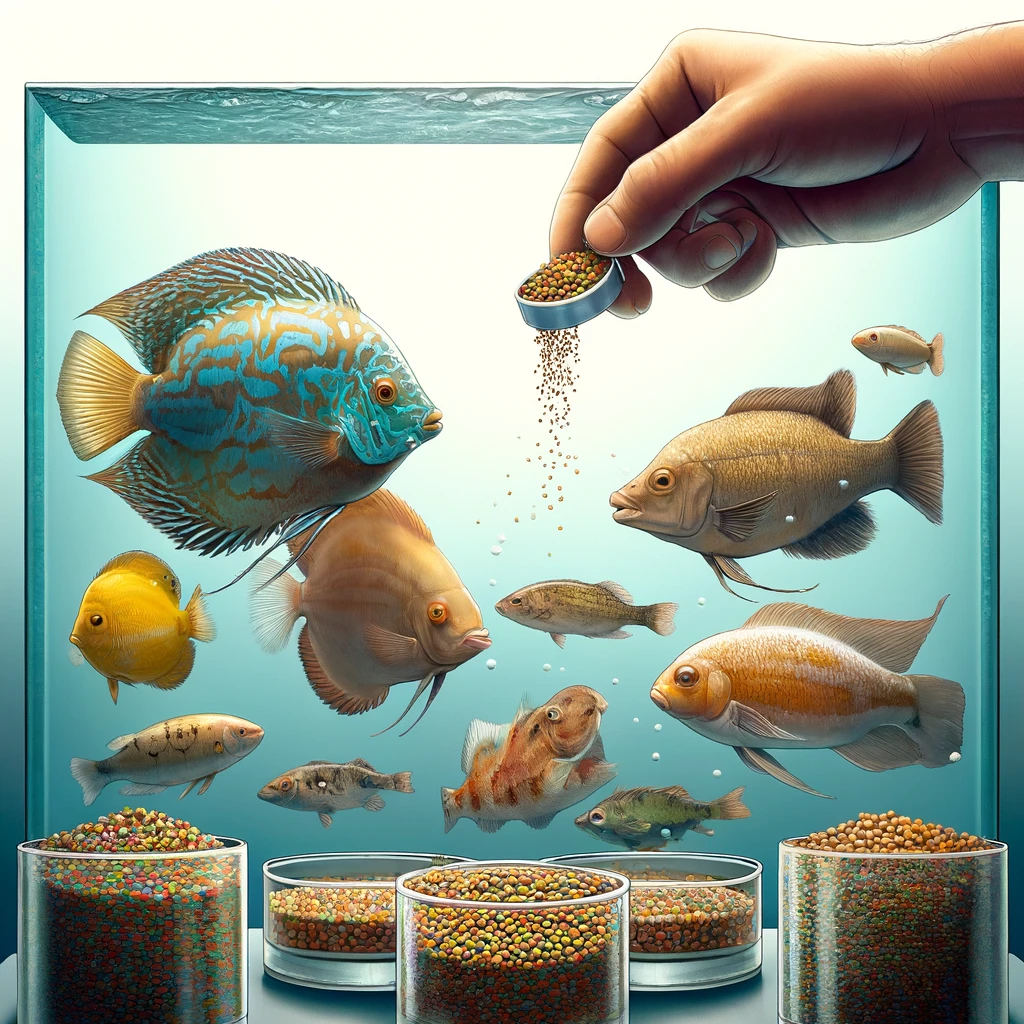
For larger aquarium fish such as discus and cichlids, the market offers various types of granulated food. These granules are tailored to fit the mouth size of larger tank inhabitants, making them an ideal choice for bigger fish. However, it’s important to note that not all discus fish may take to granulated food. As with many aspects of fish care, it’s a matter of trial and error to see what your fish prefer.
Shelf Life of Vitamins in Fish Food
When purchasing fish food, avoid buying the more economical 1-liter containers for your ornamental fish. Once opened, the vitamins in these containers have a limited shelf life and begin to degrade within a few weeks—sometimes even sooner. Therefore, it’s advisable to choose the smallest packaging available. Also, ensure that the vitamin C in the food is stabilized, as it tends to degrade quickly otherwise.
While flake food may be an ideal diet for many fish species, this is not the case for discus. Discus fish generally require live food and may suffer from health issues if fed only flake food, which lacks the variety they need.
Premium Nutrition for Your Discus Fish with Tropical Discus Gran D-50 Plus and Discus Flocken D-50
Provide your discus fish with top-quality nutrition using the Tropical Discus Gran D-50 Plus and Discus Flocken D-50 2-pack set. This premium fish food combo includes 1 litre of Discus Gran D-50 Plus and 1 litre of Discus Flocken D-50, both designed to meet the specific dietary needs of Discus cichlids. Rich in essential nutrients, these foods are highly digestible and formulated to enhance the vibrant colours of your fish. Suitable for all life stages, this complete feed supports the overall health, growth, and vitality of your discus fish, ensuring they thrive in your aquarium.
Disclaimer: As an Amazon Affiliate, I earn from qualifying purchases.
Keeping Discus in a Planted Aquarium: Feasibility and Challenges
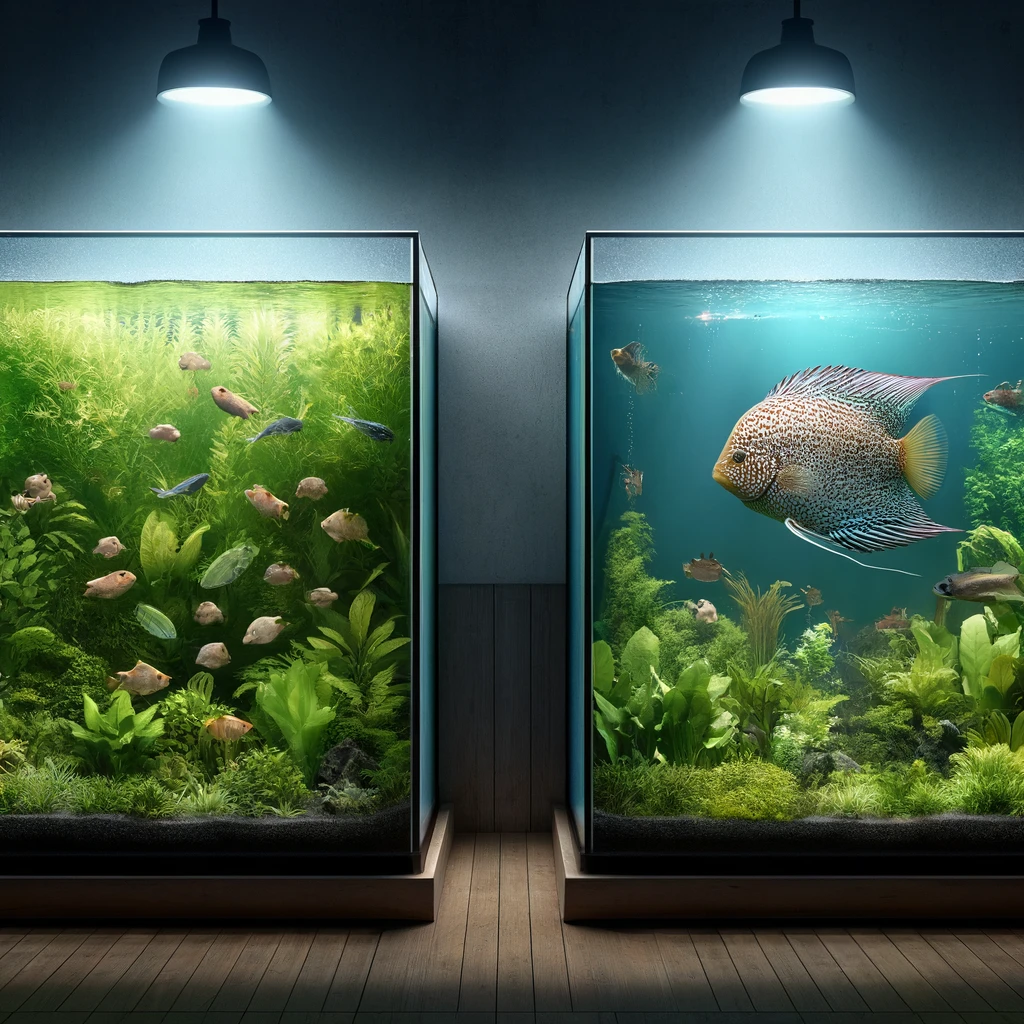
Feasibility
Certainly! Discus fish can be kept in planted aquariums, but the real question is whether it’s advisable to combine large fish like discus with heavily planted setups (such as Dutch or Amano-style tanks). Interestingly, beginners often gravitate towards such ambitious projects, becoming frequent patrons at pet stores as their failed attempts lead to increased spending. There are many paths to success, and while the achievement of managing a herd of elephants in a perfectly styled Japanese ornamental garden would be lauded, such experiments are bound to continue. However, it’s often problematic when conditions are altered to favour plants at the expense of the discus, such as setting temperatures below 28 degrees Celsius or inadequately feeding, especially younger fish, to minimize tank pollution.
Tips for Plant Choices
Avoid carpeting and forest-forming plants (like Cryptocoryne, Vallisneria, Hygrophilia, Myriophyllum, etc.) and favour solitary plants (such as Echinodorus, Aponogeton, Nymphaea, etc.). A major issue in many planted tanks is difficulty in removing detritus, making them unhygienic despite appearing clean. Another problem is that the offered amount of food often doesn’t reach the discus, affecting their growth and health rather than helping, thus burdening the aquarium environment. Raising young discus in a planted tank is nearly impossible, considering they need feeding 5-10 times a day for optimal growth.
Conclusion
- Avoid overly dense plantings in your tank.
- Do not introduce very young discus to your tank.
- Do not compromise on temperature, amount of food, water changes, or necessary treatments at the expense of your discus.
- Floating plants like duckweed and water lettuce are good indicators of water quality. A rapid increase in these plants should prompt an immediate check of water parameters, as it usually indicates high nitrate levels.
Consider having two separate aquariums; one optimized for plants and a few small fish and another optimized for larger fish.
The Significance of Patterning in Discus Fish
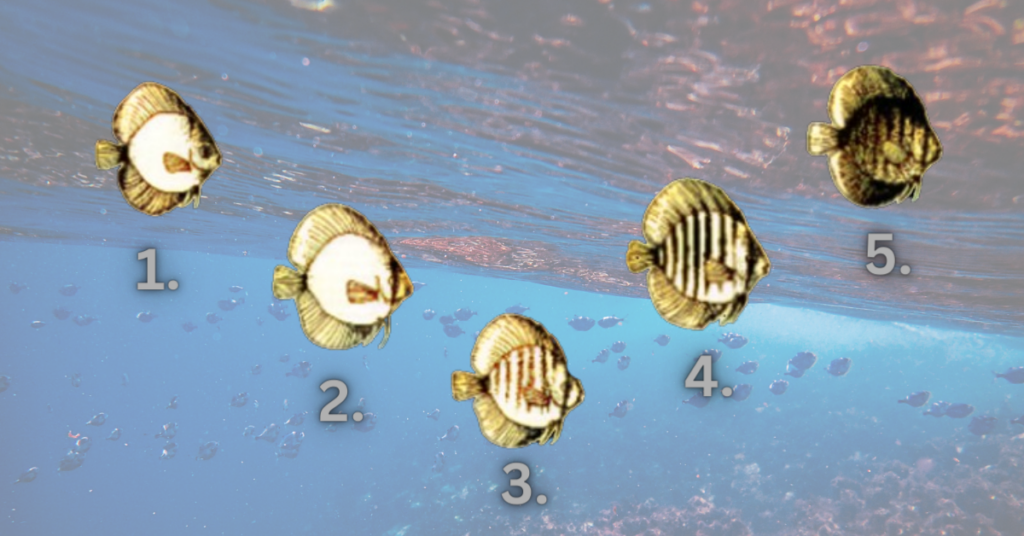
The patterning of discus fish is not just a visual trait but serves various behavioral and communicative functions, especially during interactions between equally matched fish. Here’s what different patterns indicate:
- During Encounters Between Equals: Fish exhibit specific patterns when they confront peers of similar strength.
- Dominance in Combat: The pattern of the dominant fish during a fight.
- Normal Patterning: The typical appearance of a discus fish when not under stress or confrontation.
- Submissive Display: When a fish feels inferior during a confrontation, it soon shows a pattern that acts as a pacifying gesture (similar to the normal patterning but more intense).
- High Arousal in Combat: This pattern appears when a fish is highly agitated in combat against an opponent or, in experimental setups, against a dummy. It feels dominant but senses no submission from its adversary.
These patterns play a crucial role in the social and competitive interactions among discus fish, reflecting their emotional state and intentions during various social encounters.
What to Do If Discus Fish Become Ill
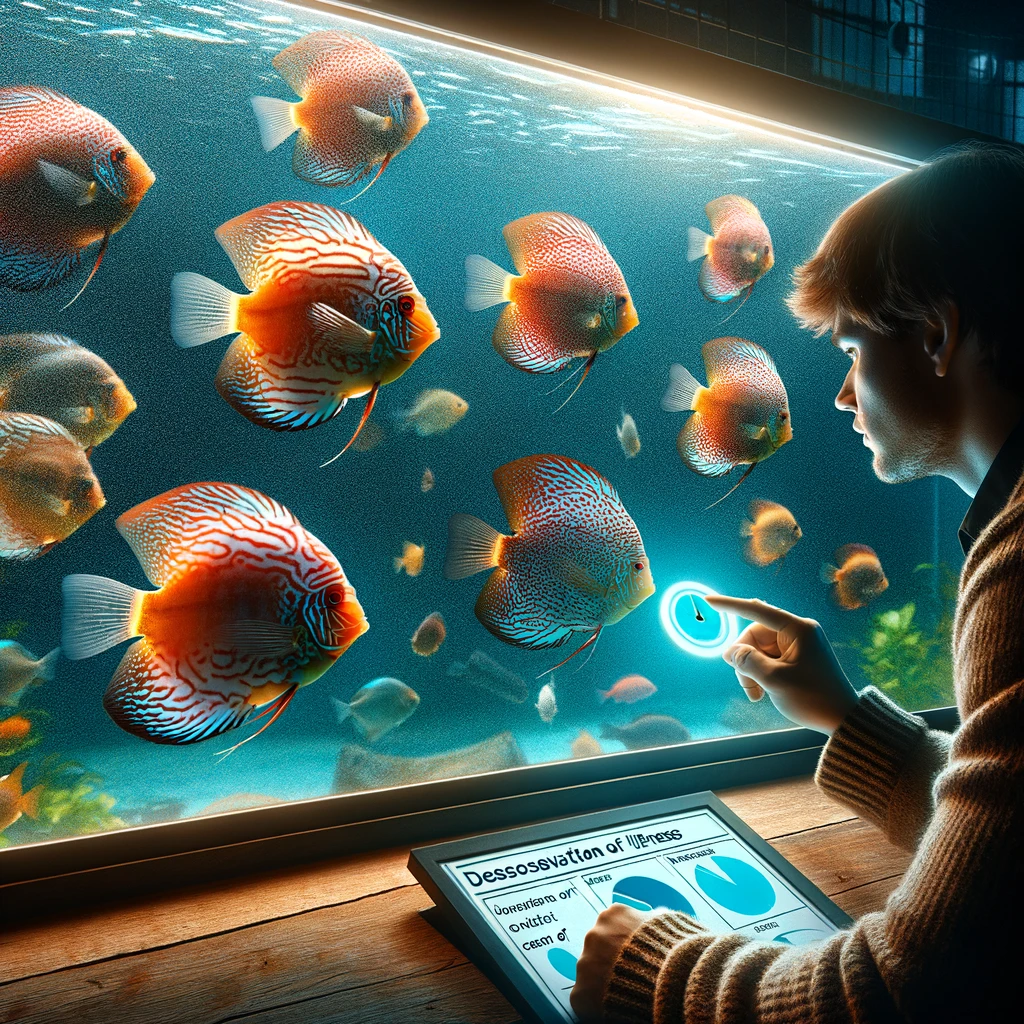
Observing Discus Fish
It’s crucial to monitor your discus fish closely, as their behavior and coloration can tell you a lot about their health. Natural discus (I emphasize this because some Asian color varieties may lack natural color change mechanisms) tend to show their “mood” clearly. If a discus darkens outside of the breeding season, it usually indicates discomfort. Similarly, extremely skittish discus or those isolating themselves in a corner of the tank often signal that something is amiss.
Dedicated caretakers who observe their fish during feeding time will quickly develop a sense for their pets’ conditions. Although discus have a reputation as problematic fish—a notion dating back to the 1970s—this has likely improved in recent years due to better care conditions, advancements in medicine, and a shift away from wild-caught imports. Most discus available in pet stores and from breeders are infected with Spironucleus (formerly known as Hexamita). Therefore, it is strongly advised to quarantine any new fish before introducing them to the main tank. The quarantine tank should be adequately sized, as sick fish might need to stay there for six weeks or longer.
Despite these precautions, if a fish seems unwell, avoid immediately resorting to medications. Often, a partial water change or a slight increase in water temperature can help, restoring the vibrant colors of your discus in the aquarium.
Treating Gill and Skin Worms in Discus Fish
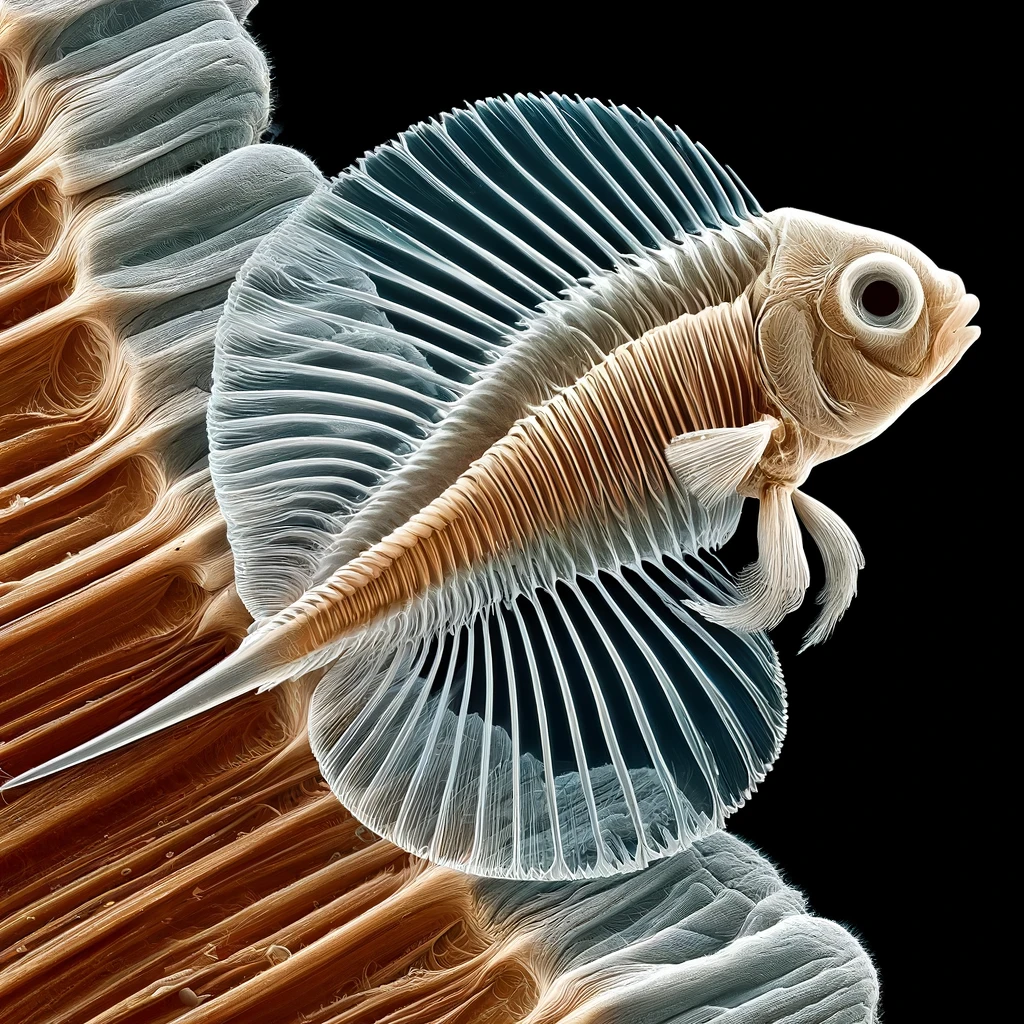
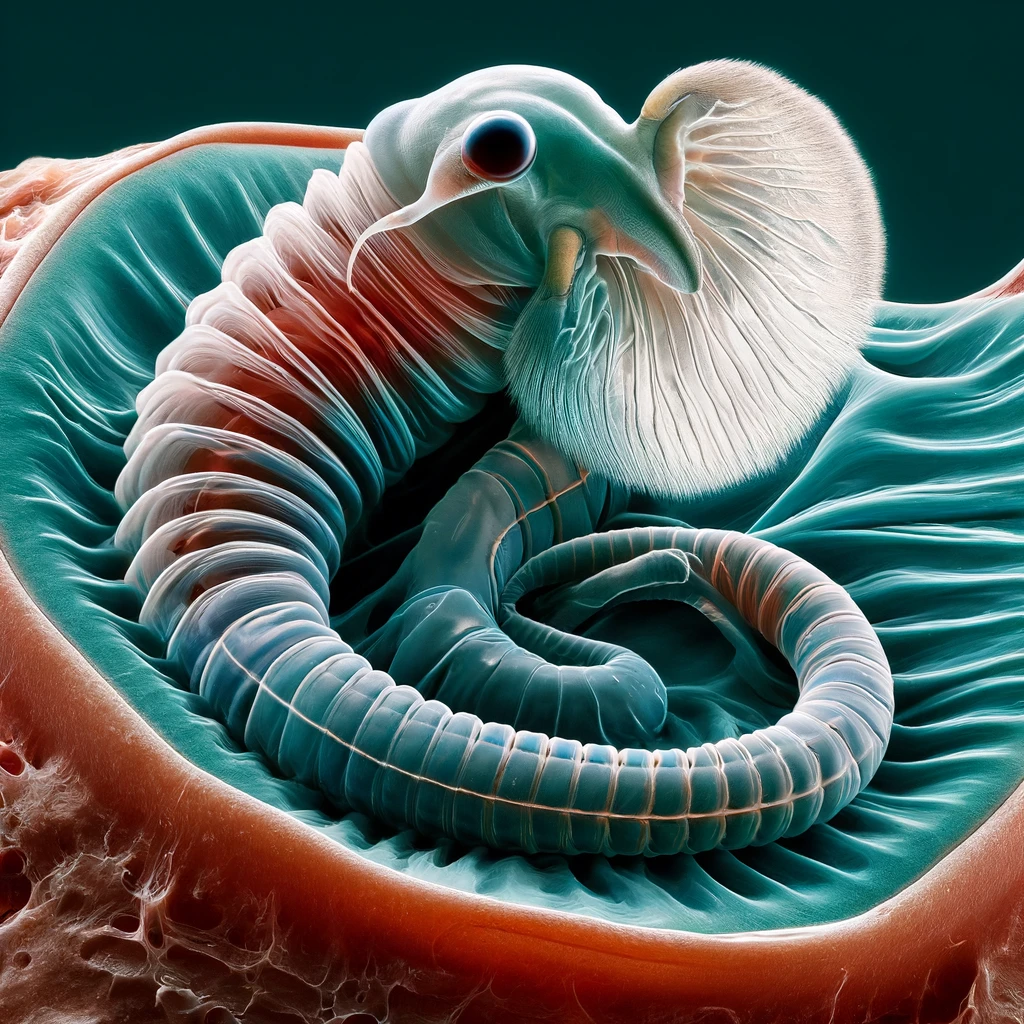
Identifying and Understanding the Problem
Gill and skin worms are common issues in discus fish. It’s likely that most discus are latently infected with these parasites but usually live without showing any symptoms. Issues typically arise in young fish or during stressful conditions, leading to symptoms like darkening colouration and refusal to eat. If not promptly and correctly addressed, this can lead to further complications, often misdiagnosed as Flagellate infections due to symptoms like white faeces.
Recommended Treatment Approaches
Immediate Action: If you notice your discus refusing food and showing darker colouration, consider gill and skin worms as the first potential culprits. Administer an appropriate medication without delay. Since most discus carry these parasites latently, starting treatment early is usually safe and, given that treatment often lasts only a couple of days, you won’t lose much time even if this isn’t the sole issue.
Medication Precautions:
- Always handle medications and treatments with care regarding dosage, storage, and disposal.
- Avoid using filter media like activated carbon, peat, ion exchange resins, or denitrification filters during treatment, as they can weaken the medication’s effects or cause harmful interactions.
- Omit water conditioners and plant fertilizers during treatment.
Specific Medications and Their Use
Gyrotox: Effective and commonly recommended. Ensure your pH is above 7.5; if not, adjust it using sodium bicarbonate. Generally well tolerated by discus and other fish, including catfish. Apply over 48 hours.
Chloramine-T-Trihydrate: A cost-effective alternative for treating large systems. Available from pharmacies or laboratory suppliers. Dose 5 grams per 300 liters with a pH over 7.5. Also well tolerated by most fish. Use for 48 hours. Note: not suitable for long-term storage.
Formalin 35%: Despite its effectiveness, it is not recommended due to its carcinogenic properties. Use cautiously in well-ventilated areas or not at all. Formalin is harsh on discus, particularly those with skin damage, and can lead to severe side effects for other fish.
Flubenol 5%: Generally considered less effective with a long treatment duration of one to three weeks. After treatment, swim bladder infections may occur, known as head standing. Typically tolerated well by other fish.
Masoten: A long-used aquaristics medication effective against worms. The effectiveness depends on water temperature, pH, and storage conditions. Always use fresh Masoten to ensure potency. Treat at a precise 25°C for 72 hours, followed by a substantial water change and carbon filtration.
Egg-laying Hookworms: Requires two treatments spaced four days apart, maintaining the water temperature at 25°C. Follow each treatment with a water change and carbon filtration to fully remove the medication from the water.
Managing Tapeworm Infections in Discus Fish
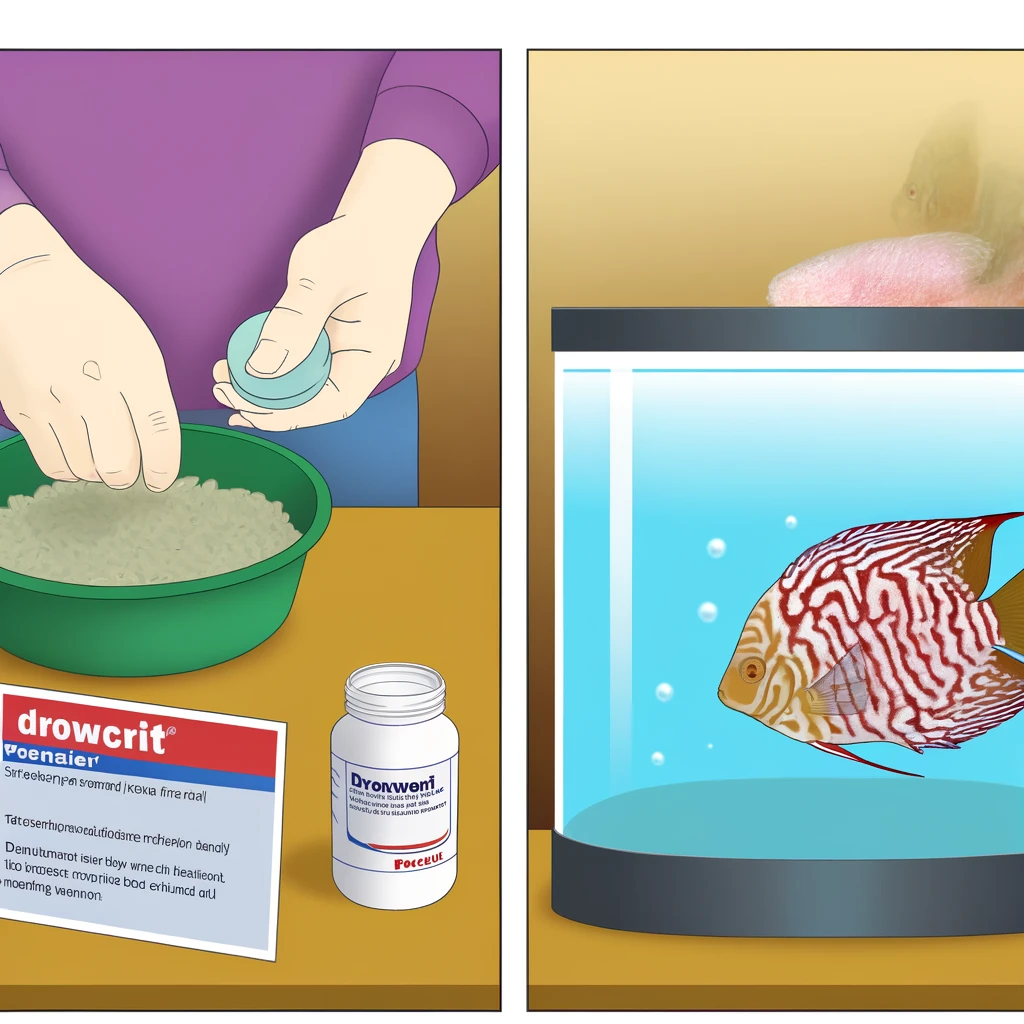
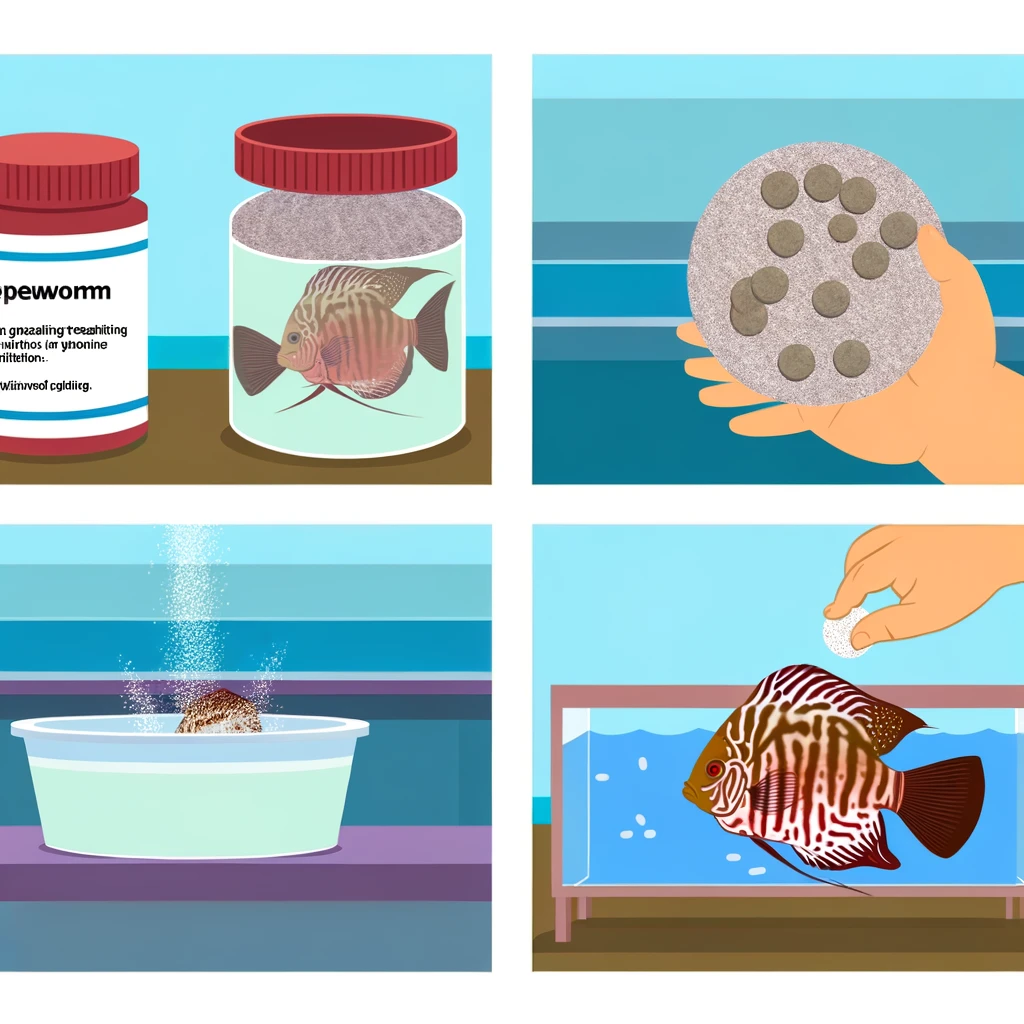
Introduction to Tapeworms
Tapeworms typically infect fish through live food, but there have been increasing reports of these parasites reproducing within aquariums, leading to recurrent infections. Treatment for tapeworms is effectively carried out using the drug Droncit, which contains the active ingredient Praziquantel, commonly used in veterinary medicine for cats and dogs.
Droncit and Its Applications
Droncit is specifically used to treat tapeworm infections in fish. While it originates from veterinary practices, it is suitable for aquarium use due to its efficacy and safety profile. There are two main methods of administration, detailed below:
Treatment Plans
Food Treatment Method: This is the preferred method due to its simplicity and tolerance. It involves mixing crushed Droncit tablets with thawed frozen food (200 grams of food per tablet). The mixture is then refrozen before feeding. This treatment should be the only food provided during the treatment period to ensure effective ingestion. A follow-up dose is necessary after 14 days because the initial treatment does not kill the tapeworm larvae.
Short Bath Method: This method requires Droncit 5% solution, with 1 ml mixed in 5 litres of aquarium water. Discus fish should be bathed in this solution for 4 hours under close supervision, as some fish may exhibit intolerance (e.g., imbalance, laying on their side). If adverse reactions occur, the fish should be immediately transferred to clean, medication-free water. Although rare, bath treatments can sometimes cause reversible infertility in treated fish.
Properties and Effects
Praziquantel is highly effective against Cestodes (tapeworms), targeting all intestinal stages of these parasites. It quickly absorbs through the parasite’s surface and spreads evenly, causing significant damage to the outer skin which leads to contraction and paralysis. Once administered, Praziquantel reaches peak serum levels within 3-4 hours and is metabolized in the liver, with the majority excreted through the kidneys within 48 hours.
Precautions
- Always handle medications with care regarding application, storage, dosage, and disposal.
- Be cautious of interactions with filter media that could reduce the medication’s effectiveness.
- Monitor fish closely for any signs of distress during treatment and act quickly to mitigate any adverse effects.
Quarantine: Essential Practices for New Fish and Plants
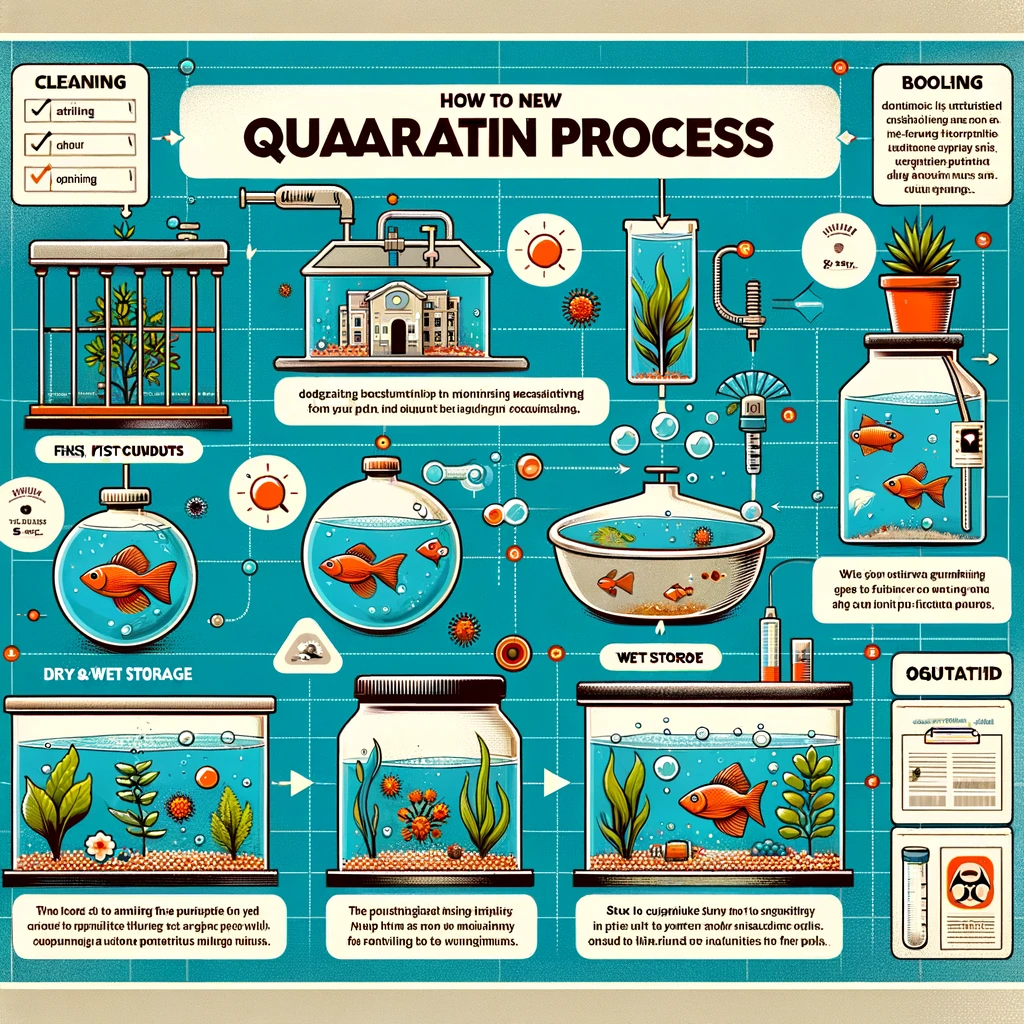
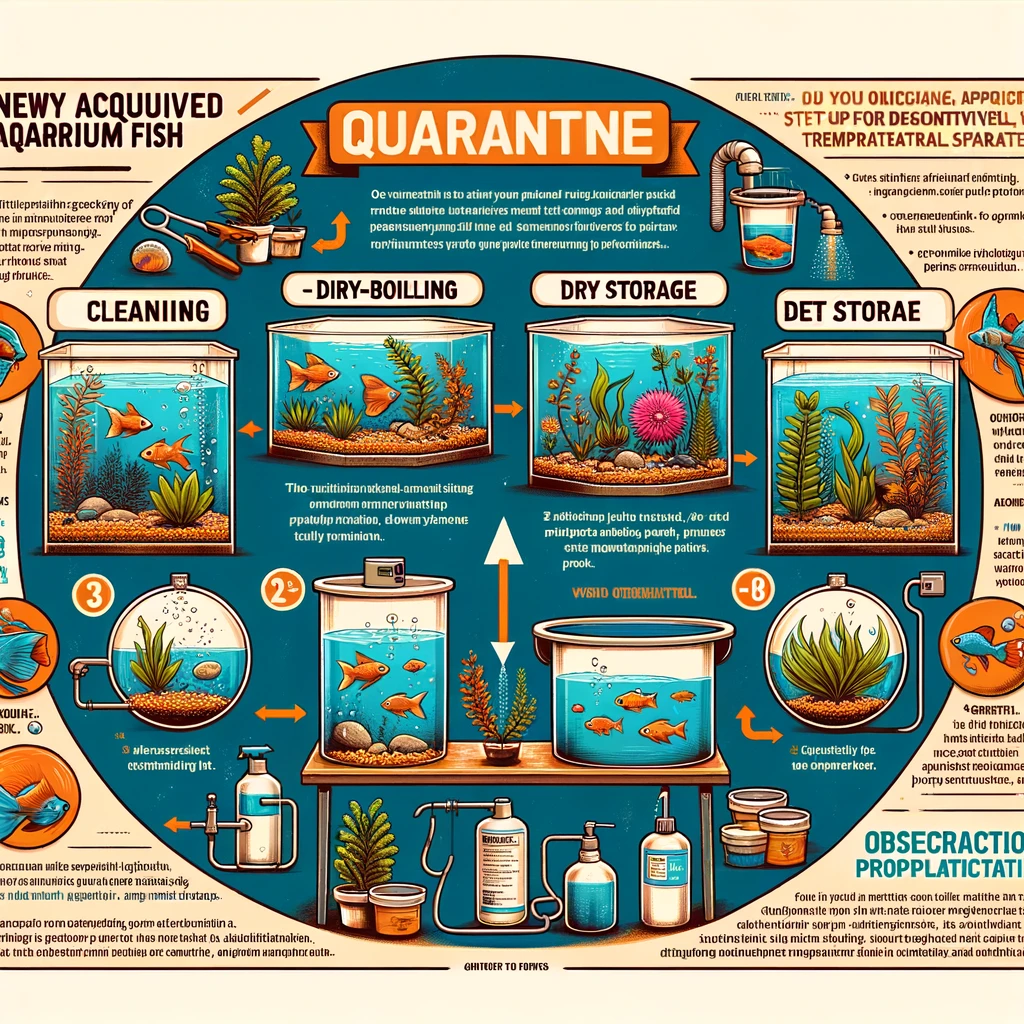
Why Quarantine?
Quarantine is critical to prevent introducing unwanted organisms into your existing setup. This topic requires detailed discussion due to its many variables.
Quarantine Procedures for Decorative Items
Decorative items like roots from other aquariums should undergo the following steps:
- Clean: Thoroughly clean all items.
- Boil: If possible, boil them to eliminate any pathogens.
- Dry Storage: Store them dry for a few days.
- Wet Storage: Then, store them wet, such as soaking roots in water for a few days.
Using specialized disinfectants is generally unnecessary and can be counterproductive without proper knowledge.
Plant Quarantine
The ideal quarantine for plants involves keeping them in a fish-free aquarium for an extended period. Alternatively, a small water container with appropriate water and temperature conditions will suffice for one to two weeks. If you aim to prevent snail infestations, quarantine is the perfect time to use anti-snail treatments.
Fish Quarantine
Quarantining new fish (not just discus) is advisable. Observe the fish during this period rather than administering prophylactic treatments. Ensure suitable living conditions are provided during quarantine, such as adequate aquarium size, filtration, and water quality. Consider that the fish undergo stress during capture and relocation, and discus, in particular, requires a long period to acclimate. The quarantine duration should balance sufficient observation time against the risk of causing additional stress, typically ranging from 2 to 8 weeks.
Consider the origin of the fish, whether they are freshly imported from distant regions or acquired from a known acquaintance whose aquarium conditions and health history you are familiar with. In pet stores, strict isolation between new and existing stock is rarely practised, and cross-contamination during routine feeding and cleaning is common.
Maintain quarantine until you are reasonably sure the new fish are healthy. Prolong the observation period as necessary to prevent any potential infections from spreading to your established stock.
Diseases and Their Treatment
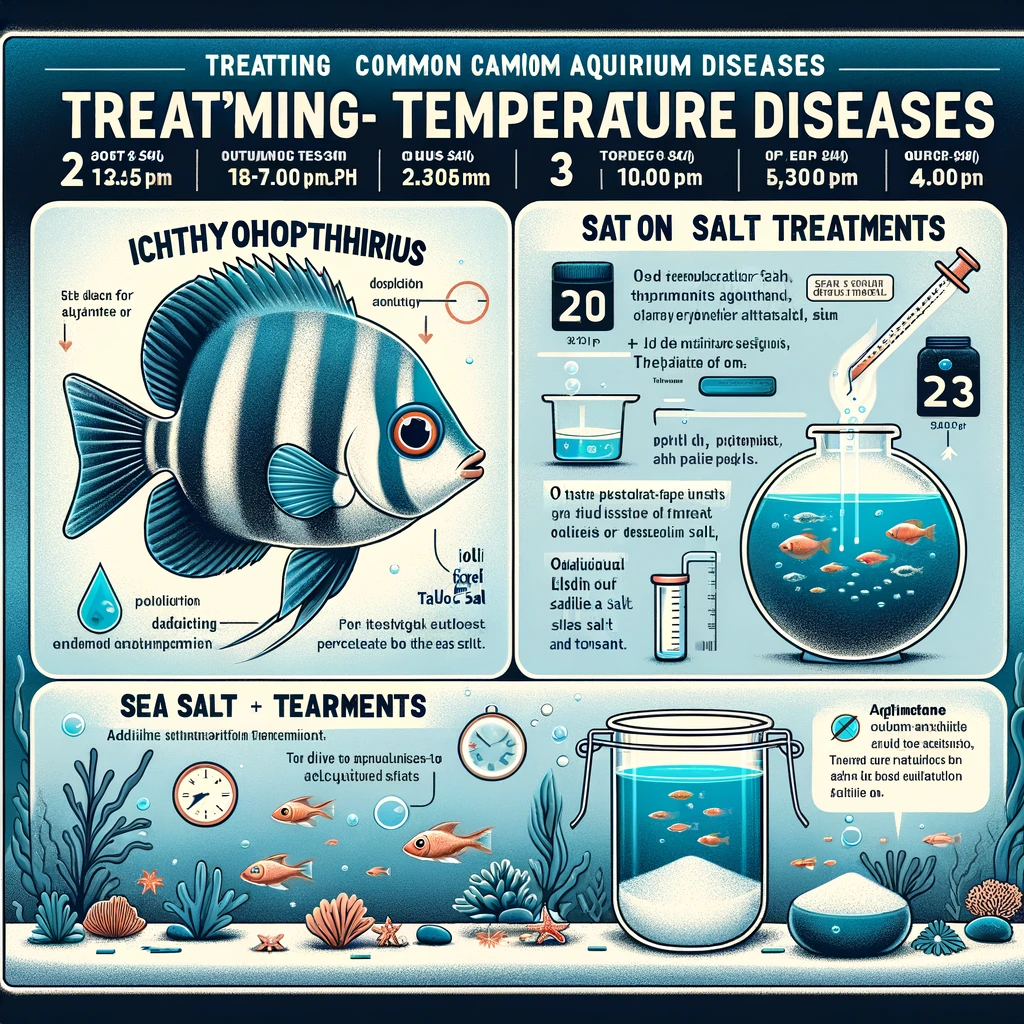
Overview of Treatments
This section introduces common medications and treatment methods that can manage most fish diseases without requiring expert knowledge. For those interested in a deeper understanding, the following books are highly recommended:
- “Krankheiten der Aquarienfische” by Dieter Untergasser, Kosmos Publishing, ISBN 3-440-06048-9
- “Krankheiten der Aquarienfische” by Reichenbach-Klinke/Körting, Ulmer Publishing, ISBN 3-8001-7259-3
Temperature Treatment
Fortunately, discus are kept at relatively high temperatures, which naturally hinders many ectoparasites. However, should there be an infestation, the following temperature adjustments are recommended:
- Ichthyophthirius: Increase to 30°C for 10 days.
- Costia: Increase to 32°C for 4 days.
- Oodinium: Increase to 33-34°C for 24-36 hours.
These temperature treatments are often as effective as using commercial treatments such as methylene blue, malachite green oxalate, or trypaflavin, which can undesirably stain everything blue, green, or yellow. This method offers a good opportunity to avoid chemicals.
Salt Treatment
Salt can be used to support the above treatments:
- Iodine-free Table Salt: For example, salt tablets used in water softening systems are available at building supply stores.
- Sea Salt: I use this.
Ektozon
Ektozon is a more costly medication available at pet stores.
- Dosage: According to Untergasser, use 1-3 grams per 10 litres of aquarium water for at least 5 days.
These simple but effective treatments can help manage common ailments in discus and other aquarium fish, minimizing the need for harsh chemicals while ensuring the health and vibrancy of your aquatic environment.
Deficiency Symptoms in Aquarium Fish
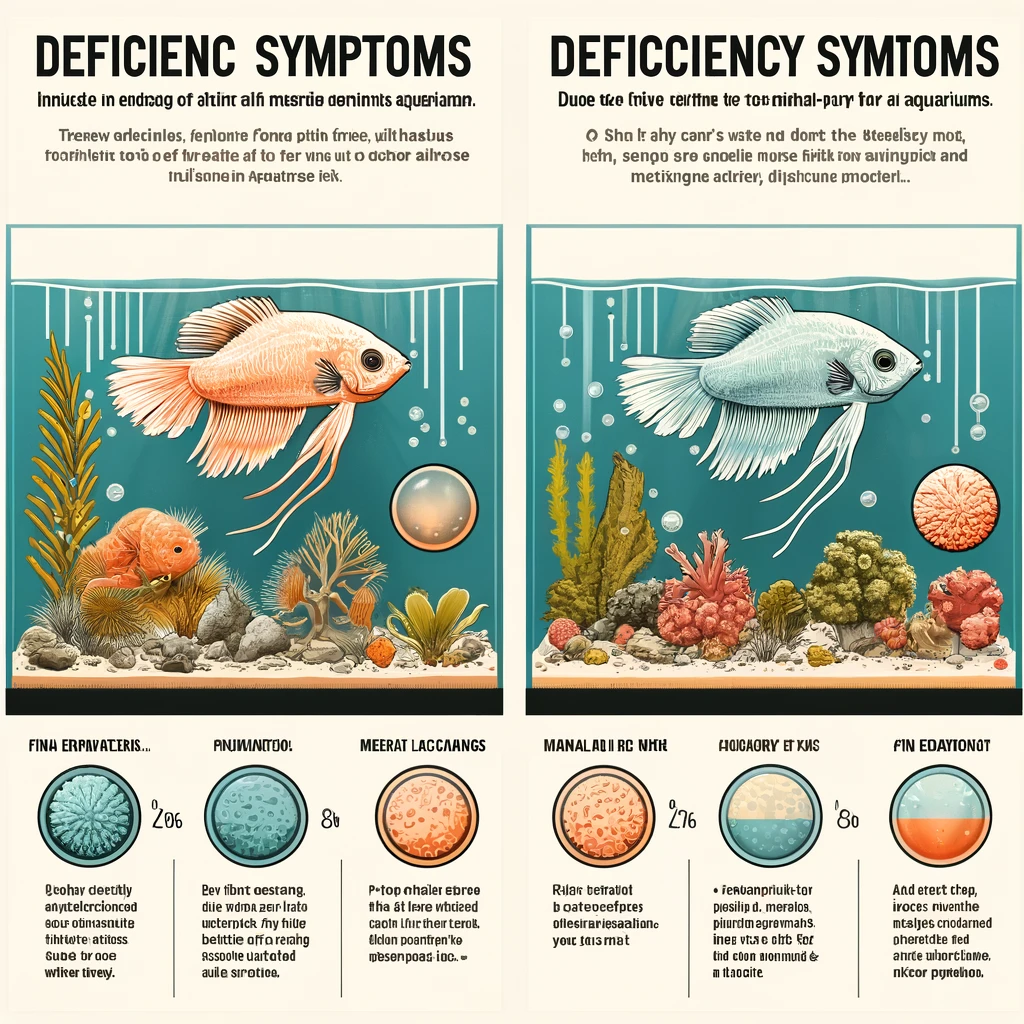
Causes and Symptoms
Deficiency symptoms in fish often occur due to poor maintenance practices and unbalanced feeding. Specifically, these issues can arise when aquariums are rarely cleaned or water changes are infrequent and irregular. Additionally, deficiency symptoms may manifest in soft or mineral-poor water, which can be identified by signs of fin erosion in growing fish.
Prevention and Treatment
To prevent and treat deficiency symptoms, ensure consistent aquarium maintenance and provide a balanced diet for your fish. For aquariums with mineral-poor water, it’s essential to supplement the water with trace elements. This not only supports overall fish health but also aids in the development and maintenance of strong fins and skeletal structure.
Stress in Aquarium Fish
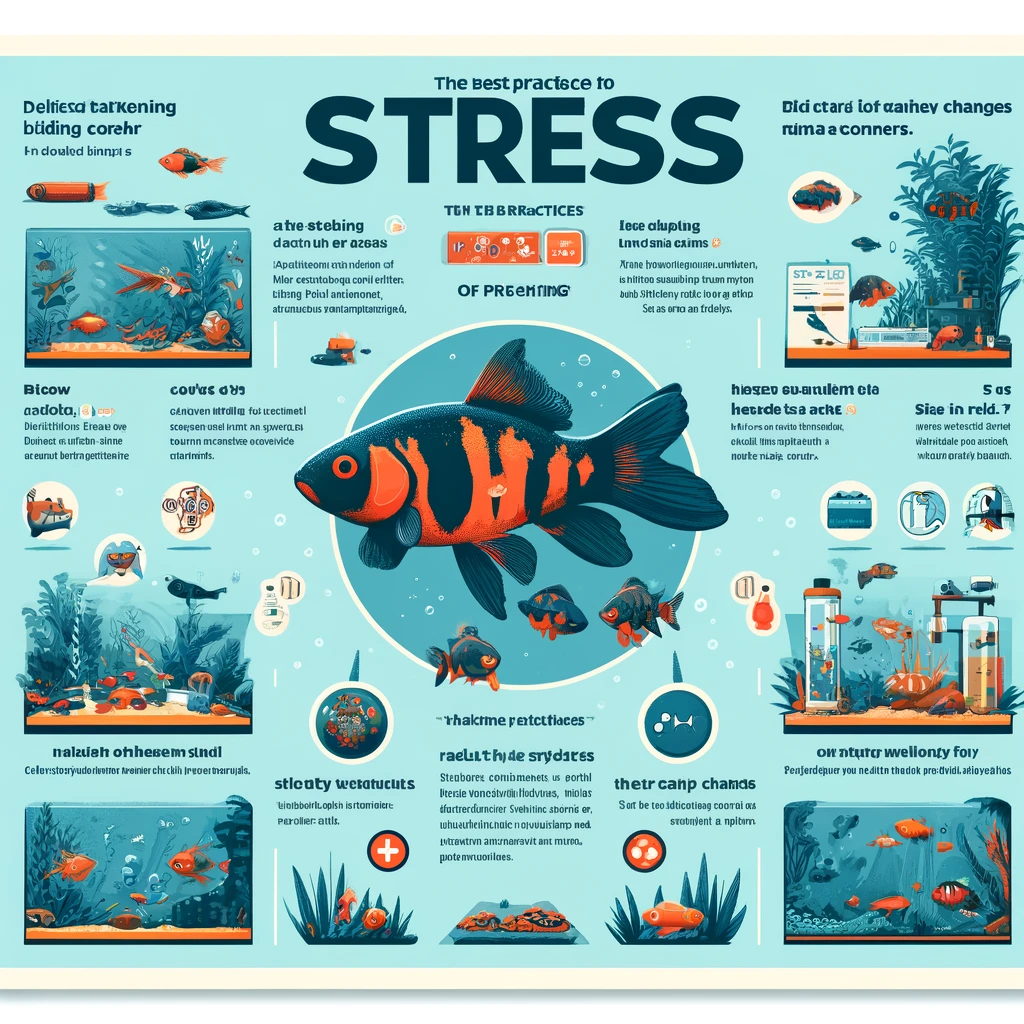
Causes of Stress
Stress is a major factor in triggering diseases in aquarium fish. It can be caused by frequent handling, such as netting and relocating fish, or by poor water conditions, including inadequate temperature, high levels of nitrites or nitrates, or overcrowding in small tanks. Initially, stressed fish may appear skittish, tend to hide in corners, darken in colour, eat less, and eventually may exhibit symptoms like white faeces.
Preventing Stress
The best prevention against stress-related issues is to maintain regular water changes and ensure a balanced diet for the fish. Consistent and proper aquarium maintenance not only minimizes stress but also enhances the overall health and well-being of the aquatic environment.
Shy Discus: Understanding and Addressing Their Behavior
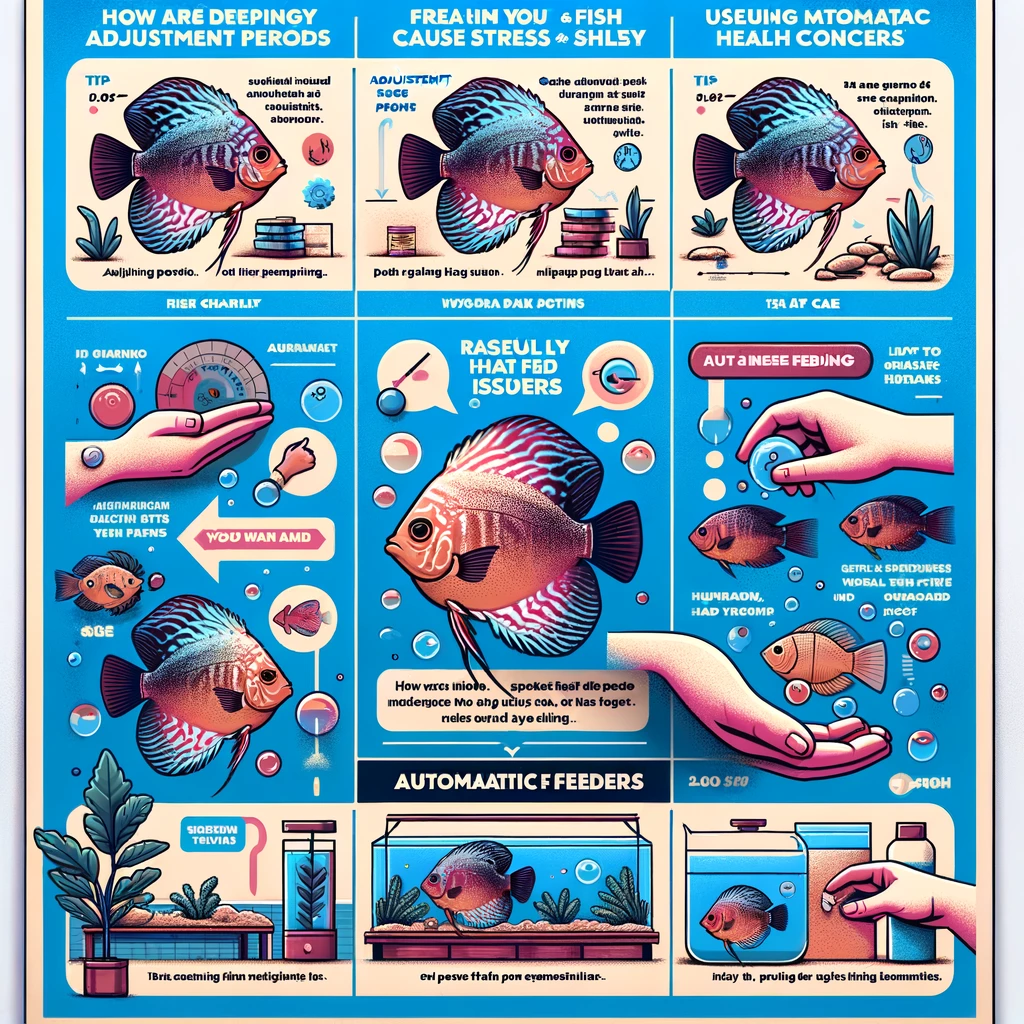
Possible Causes of Shyness in Discus Fish
Adjustment Period:
- Discus fish need time to acclimate to their new environment. Allow them at least a week to explore their new home and integrate into any existing social hierarchy within the tank.
- During this period, try to feed them their familiar food and offer a small treat every time you approach the tank. Eventually, they will associate your presence with feeding and begin to greet you at the front of the glass.
Water Quality Issues:
- If discus fish are uncomfortable with their water parameters, they often become skittish and may exhibit panic-stricken behaviours.
- Review your maintenance routines. Have there been infrequent water changes? Did you make any changes that could affect water quality, such as a thorough cleaning of the filter, or adding new decorations like roots?
Health Concerns:
- If you suspect illness, it’s crucial to stay calm and avoid diagnosing the fish without proper knowledge. If unsure, seek advice from experienced discus keepers or contact the breeder. Reputable breeders are usually willing to offer assistance.
Use of Automatic Feeders:
- Discus fish fed exclusively via automatic feeders may start to see the caretaker as an intruder or potential predator, leading to a loss of trust.
- Regular hand-feeding can help reestablish a positive relationship and reassure the fish of your role as a caregiver, not a threat.
Tips for Managing Shy Discus
Understanding the underlying causes of shyness in discus fish can help in creating strategies to make them more comfortable and sociable in their aquarium environment. Regular, consistent care and interaction are key to developing trust and reducing stress in these sensitive fish.
Lifespan of Discus Fish
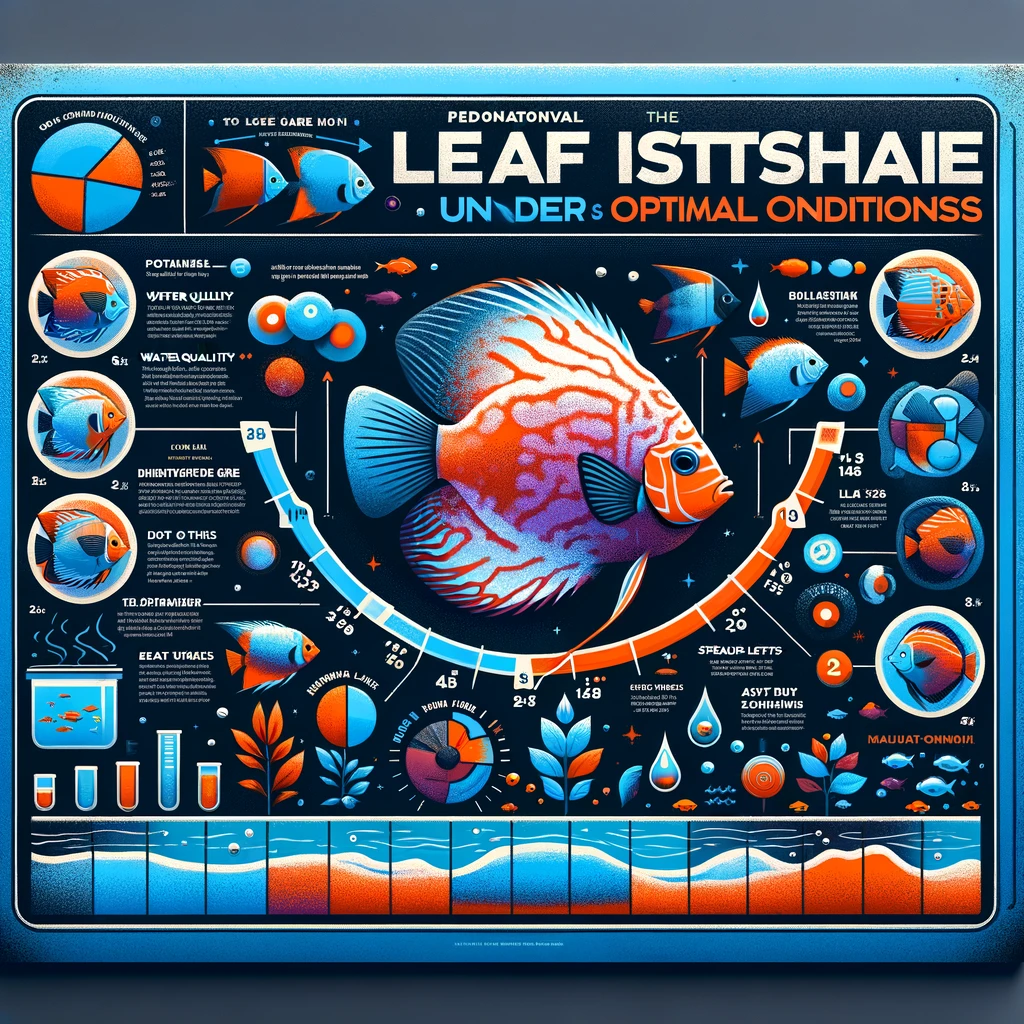
Expected Lifespan
Discus fish can live up to 10 years under optimal care conditions. There are reports of discus living even longer, with some reaching 16 years according to Udo Elster. However, a more realistic expectation would be between 5 to 7 years.
Lifespan in Captivity
Statistically, the average lifespan of discus fish in Germany is approximately 2 to 3 years. This shorter lifespan is likely not due to natural factors but rather poor aquarium conditions that lead to disease susceptibility and early death.
Improving Lifespan
Ensuring a long and healthy life for discus fish involves maintaining high standards of aquarium care, including regular water changes, appropriate feeding, and disease prevention. By improving living conditions, the likelihood of reaching or exceeding the average lifespan increases significantly.
Algae Problems in Aquariums
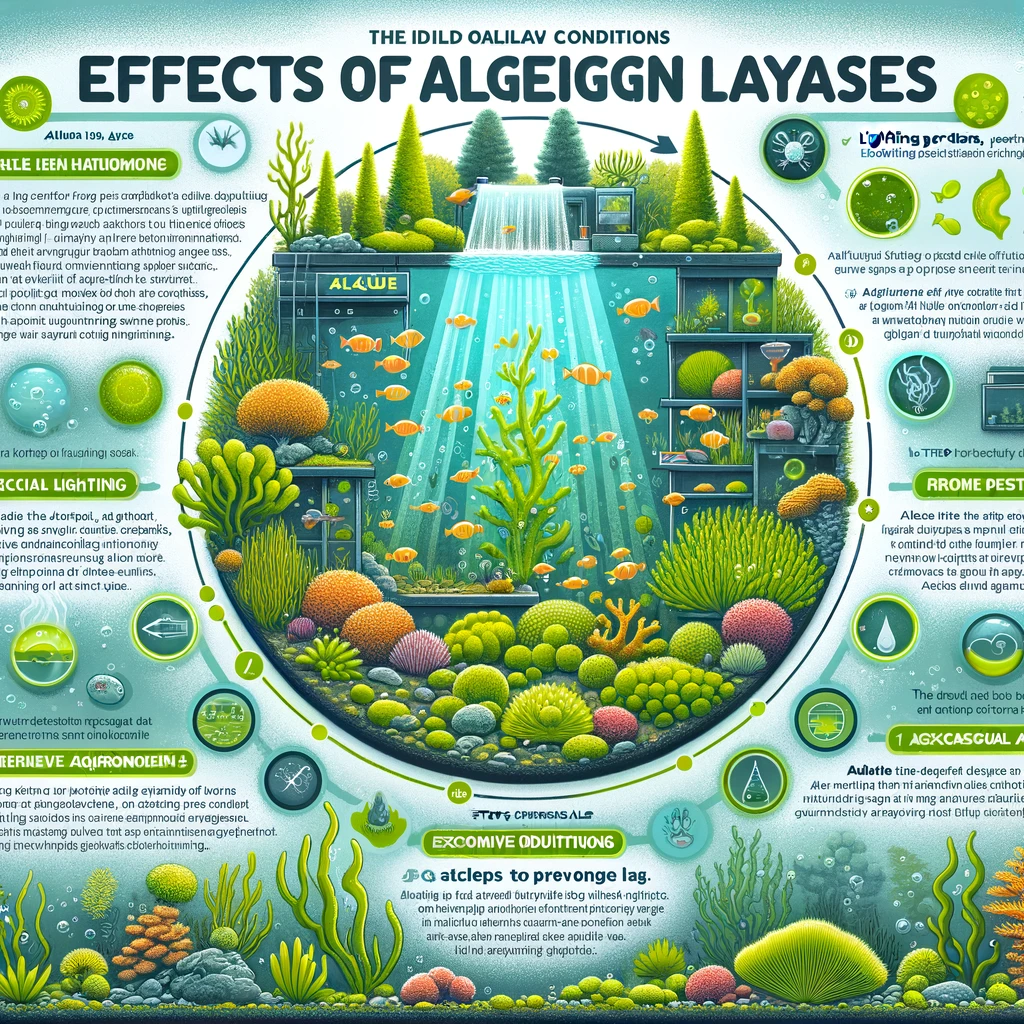
Understanding Algae
Except for blue-green algae, which are more closely related to bacteria, algae are plants that require the same necessities as aquarium plants: light, carbon dioxide, and nutrients. Algae are more adaptable than higher plants due to their simpler biological structure, which allows them to thrive under a broader range of conditions.
Impact of Algae on Aquariums
Algae can quickly spoil the enjoyment of the aquarium hobby, but today, their growth can be managed and even prevented. It is often said, “If you have algae in your aquarium, you are likely contributing to the problem.” Advances in our understanding of aquariums have shown that an aquarium is a tightly interconnected biological system. Changing one element can trigger a chain reaction affecting many others.
Algae’s Ideal Conditions and Consequences
Algae thrive in an oxidizing environment and can produce oxygen levels that are much higher than what fish can consume. They can increase oxygen to levels between 20-30 mg/l O2 (200-400% saturation), which is unnatural even for fish, as most aquarium fish are used to much lower levels (2-3 mg/l O2) in their natural habitats.
High oxygen levels can destroy natural chelates, making the water “aggressive.” This can degrade essential vitamins and cause trace elements to precipitate, rendering them ineffective. This leads to deficiencies in both plants and fish and can result in the eventual demise of aquatic plants due to being overrun by algae.
Managing Algae Growth
Understanding the interconnected nature of all processes in an aquarium is crucial. Implementing a two-hour pause during the middle of the lighting period is recommended to help manage and possibly eliminate algae growth.
Effortlessly Clean Your Aquarium with HOTOOLME 65 cm Algae Scraper
Keep your aquarium spotless with the HOTOOLME 65 cm Algae Scraper, a premium stainless steel cleaner designed for glass aquariums. Featuring an extendable handle that reaches up to 65 cm, this scraper is perfect for removing algae and other residues from various glass surfaces. The hollow design of the scraper blade reduces resistance and makes cleaning more efficient, effortlessly removing small green algae spots. Made from high-quality stainless steel, this scraper offers strong corrosion resistance, ensuring durability for use in both freshwater and marine aquariums. Easy to install, the blade can be removed and replaced to extend the product’s life. When the blade is detached, the scraper can also be used as a sand leveller, minimizing water disturbance and keeping your fish and plants undisturbed.
Check it out on Amazon and keep your aquarium glass clean with the HOTOOLME 65 cm Algae Scraper.
Disclaimer: As an Amazon Affiliate, I earn from qualifying purchases.
Blue-Green Algae (Cyanobacteria) in Aquariums
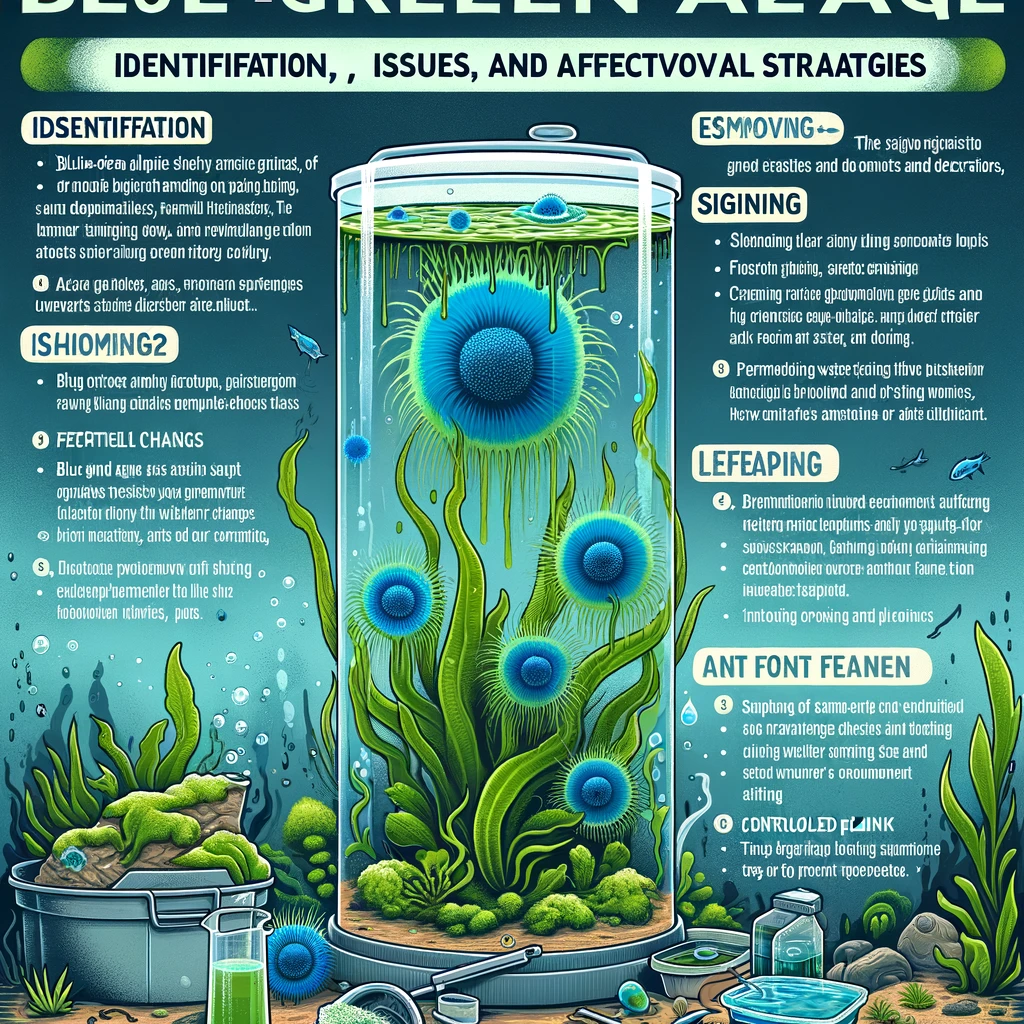
Characteristics and Causes
Blue-green algae, which closely resemble bacteria due to features like the absence of a true nucleus, can proliferate rapidly under certain conditions. While the average aquarium owner cannot verify cellular structures without a microscope, the growth rate of these algae is visibly noticeable. Common causes include overfeeding and nutrient saturation. Uneaten food decays on the substrate, providing an ideal food source for blue-green algae.
Identification and Issues
These algae often form a slimy, blue-green or black coating on the substrate, decorations, and glass of the aquarium, which can lead to a foul smell. Not only are blue-green algae unsightly, but they are also potentially harmful as they produce toxins similar to those of some bacteria.
Effective Removal and Prevention Strategies
- Manual Removal: Remove blue-green algae by siphoning it out of the aquarium.
- Water Changes: Perform regular water changes simultaneously to remove excess nutrients.
- Plant Addition: Introduce fast-growing plants to outcompete algae for nutrients.
- Controlled Feeding: Feed fish only as much as they can consume to avoid excess food decay.
Long-term Management
Maintaining regular partial water changes is crucial for creating a healthy aquatic environment that starves the algae of nutrients. Due to the resilient nature of blue-green algae, it is vital to monitor and adjust water parameters consistently to prevent reoccurrence.
Beard and Brush Algae (Red Algae) in Aquariums
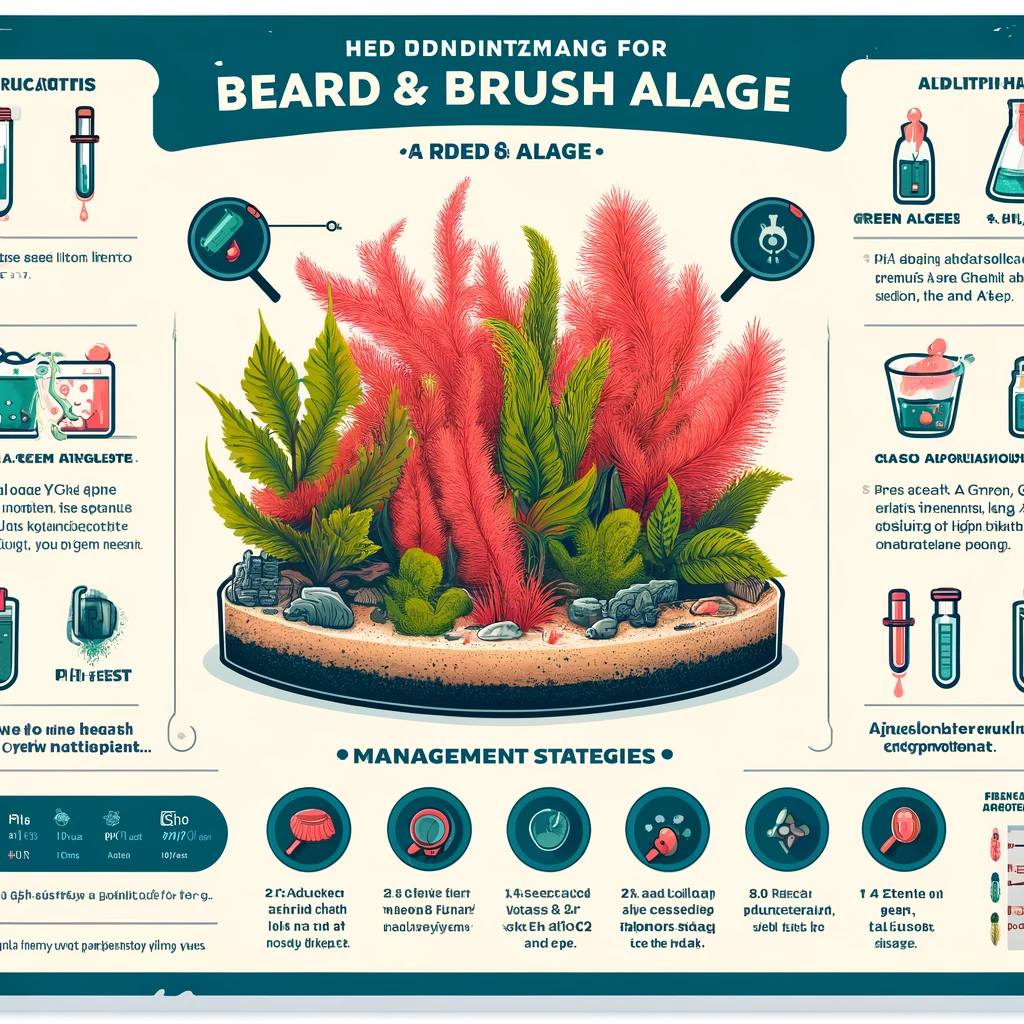
Description and Challenges
Beard and brush algae are among the most dreaded by aquarists. These algae form either in short tufts or long, slightly curly threads. They thrive in conditions with strong currents, high pH levels, and a lack of carbon dioxide.
Identification and Removal
Beard algae can be particularly tenacious once established. While they resemble green algae in appearance, a simple test can differentiate them: when immersed in alcohol, beard algae turn red, whereas green algae remain green. Brush algae frequently attach themselves to the edges of leaves on slow-growing plants such as Anubias.
Prevention and Treatment
- pH Adjustment: Measure the pH level and, if possible, adjust it to slightly below 7.
- Substrate Maintenance: Clean and aerate the substrate thoroughly to disrupt the algae’s environment.
- CO2 Supplementation: Consider installing a CO2 system to address the carbon dioxide deficiency that these algae exploit.
Long-Term Management
Managing beard and brush algae involves maintaining balanced water chemistry and providing adequate carbon dioxide to discourage their growth. Regular monitoring and maintenance are key to preventing these persistent algae from taking hold.
Green Algae in Aquariums
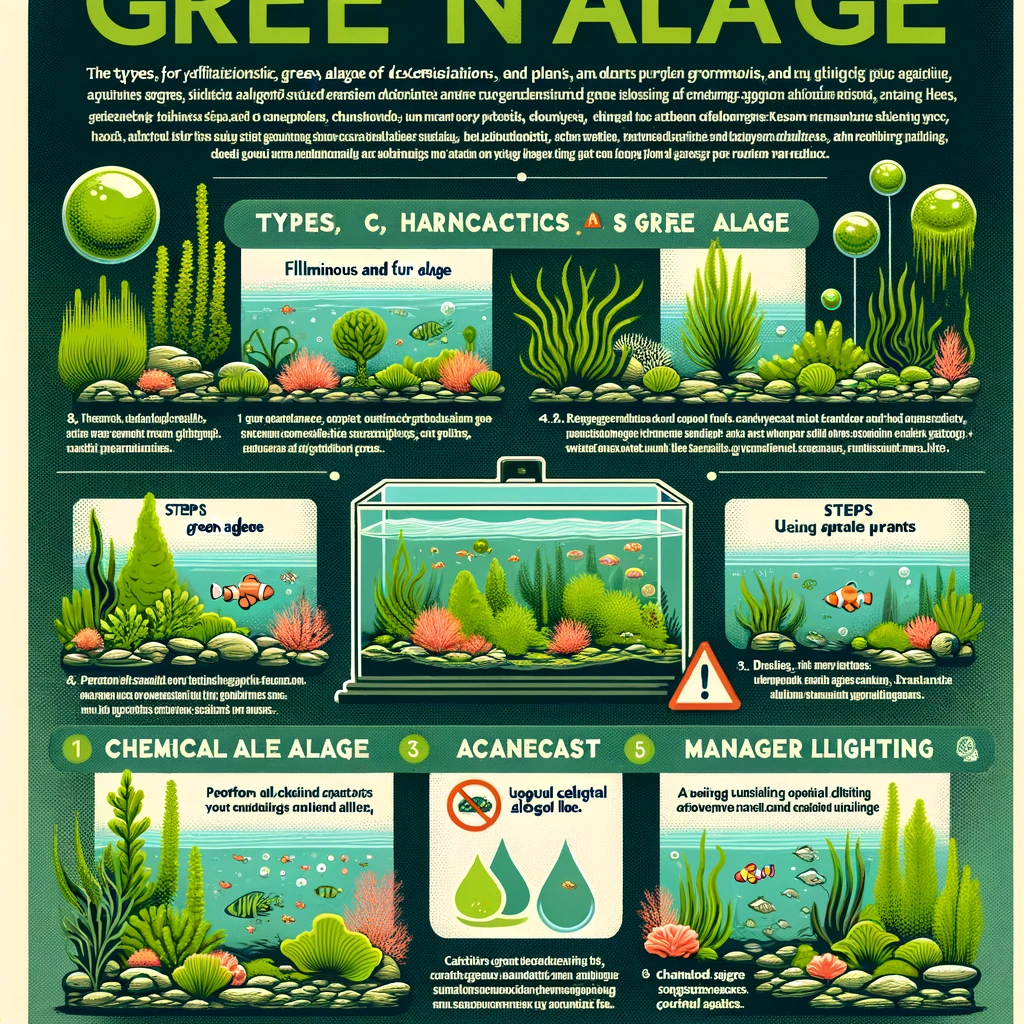
Types and Characteristics
Green algae encompass a variety of forms, including filamentous and fur algae, which cling to decorations, plants, and substrate. Other types include green spot algae and single-celled algae like those in the genus Volvox, which can cause water cloudiness and turn it green, often referred to as an algae bloom.
Causes
Green algae typically form due to an excess of phosphates and high nitrate levels, which can result from over-fertilization or excessive feeding. Strong lighting also promotes the growth of these algae. Volvox may sometimes be introduced into aquariums along with water fleas.
Management and Remediation
Controlling green algae is relatively straightforward:
- Water Change: Begin by changing one-third of the aquarium water to reduce excess nutrients.
- Darkening: Darken the aquarium completely for three to four days to inhibit algae growth.
- Lighting Control: Afterward, ensure the lighting is correct, adhering to about 12 hours per day to prevent regrowth.
- Avoid Chemicals: Chemical algae control agents are generally not recommended as they can harm both plants and fish.
These steps should help control the green algae without damaging the aquarium’s ecosystem.
Brown or Diatom Algae in Aquariums
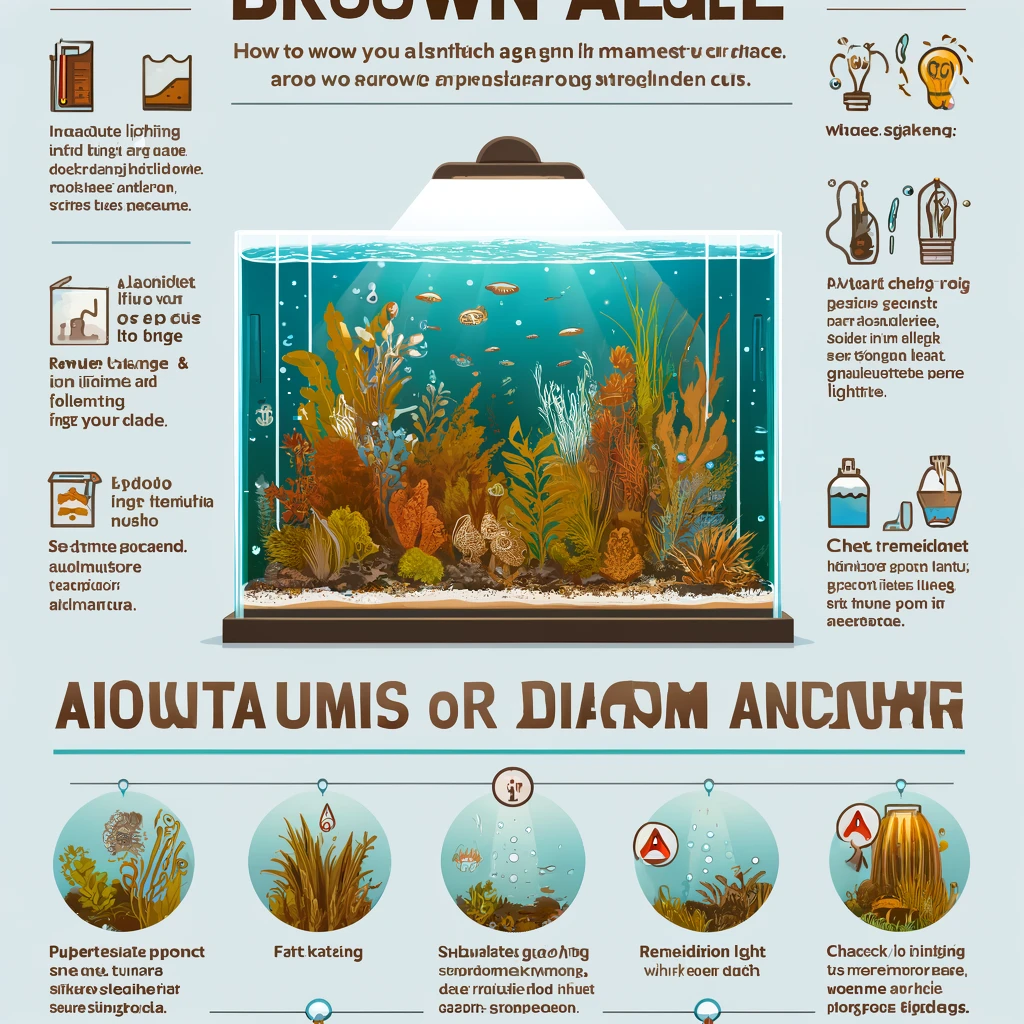
Characteristics and Causes
Brown algae, also known as diatom algae, are commonly an indication of inadequate or poor lighting. They form a brownish film that coats the aquarium glass and decorations, which can be challenging to remove mechanically. A high silicate content in tap water can also contribute to their growth. Like many types of algae, diatoms thrive on excessive nutrients, particularly nitrates, in the aquarium.
Remediation Steps
- Partial Water Change: Begin by performing a partial water change to reduce nutrient levels.
- Substrate Cleaning: Clean the aquarium substrate to remove any detritus that may be contributing to nutrient buildup.
- Lighting Check: Examine the aquarium lighting. Are the lights too old? Does the light spectrum suit your aquarium’s needs? Is the light intensity sufficient?
Lighting Maintenance
- Bulb Replacement: If the lights are older than 10-12 months, they should be replaced immediately to ensure optimal performance.
- Appropriate Spectrum and Wattage: Make sure the lighting spectrum and wattage are adequate for the types of plants and animals in your aquarium.
Preventative Measures
Regular maintenance of the lighting system and careful control of water chemistry are crucial to preventing the growth of brown algae. Ensuring that your aquarium receives the right kind and amount of light will help keep diatom algae at bay.
Water Blooms in Aquariums
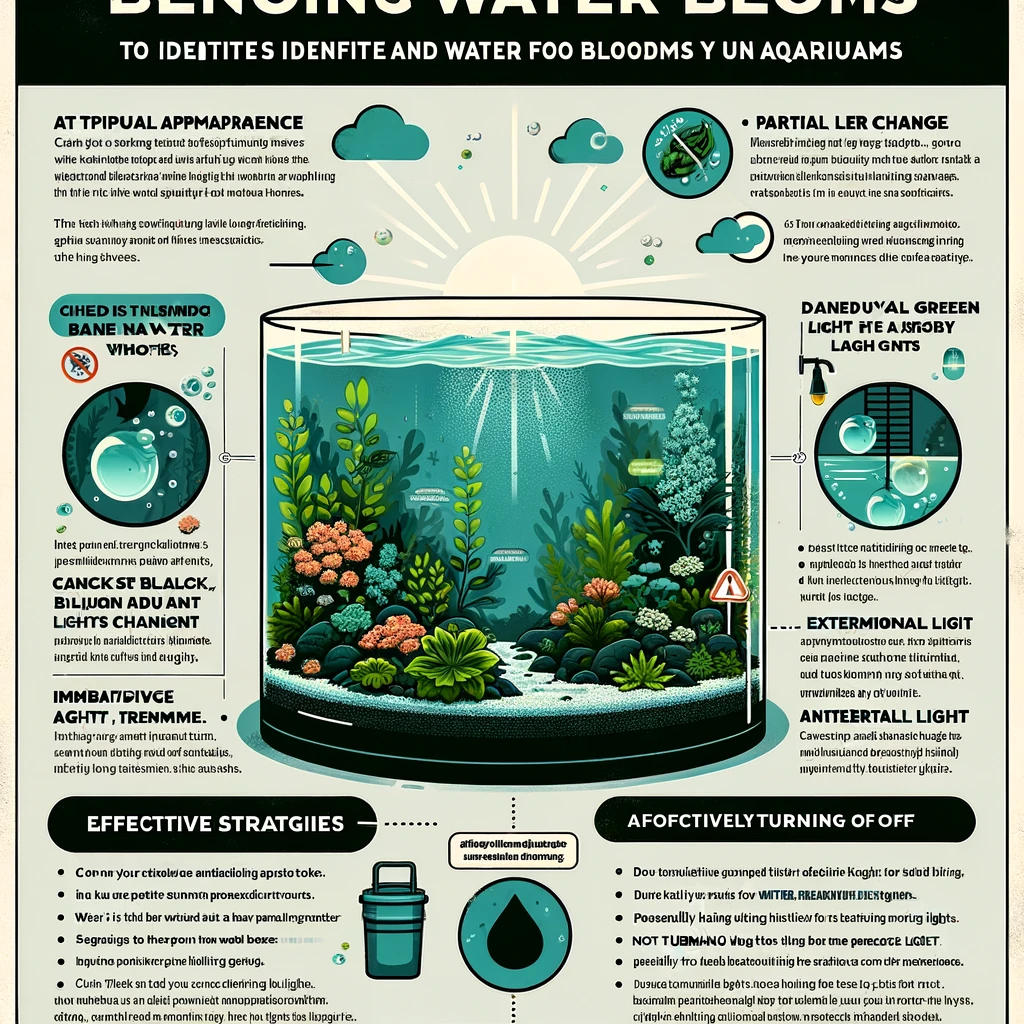
Causes of Water Blooms
Unlike diatom algae, water blooms in aquariums are typically caused by excessive light, particularly from external sources like sunlight. The stronger the light exposure, the more intense the bloom. Often, the issue stems from the aquarium being placed where too much daylight can enter.
Remediation Strategies
- Partial Water Change: Start with a partial water change, though this alone is unlikely to resolve the issue.
- Identify Light Sources: Determine from which direction excessive light is entering the aquarium.
- Light Blockage: Attempt to block out the excess light by covering the affected side of the aquarium with something opaque (e.g., taping a glass sheet on the outside).
Additional Recommendations
- Avoid Turning Off the Lights: Contrary to common advice, turning off the aquarium lights for several days is not recommended and is strongly advised against, as it can disrupt the balance of the ecosystem within the tank.
- Relocate the Aquarium: If dimming the external light doesn’t help, relocating the aquarium to a different location where light exposure is controlled might be necessary.
By addressing light exposure, you can effectively manage and eliminate water blooms, restoring the clarity and health of your aquarium.
Overview of Algae Types and Problems
Various types of algae commonly found in aquariums, including:
- Green Algae: Described as both free-floating and attached forms, indicating healthy water if not overly abundant.
- Brush or Beard Algae (Red Algae): Noted for their bushy appearances, these can be detrimental to plants if they proliferate.
- Blue-Green Algae (Cyanobacteria): Misclassified as algae, these are actually bacteria and can be harmful in large quantities.
Management Strategies
The text outlines several strategies for managing algae, emphasizing natural solutions and balanced aquarium conditions. Key points include:
- Regular water changes to maintain low nutrient levels.
- Proper lighting and avoiding direct sunlight to control algae growth.
- Use of algae-eating fish and snails as biological controls.
Algae Control Tips
- Avoid overfeeding to reduce nutrient build-up.
- Maintain plant health to outcompete algae for nutrients.
- Consider UV sterilizers if algae problems persist despite other measures.
Addressing Specific Algae Problems
Detailed advice is given for tackling persistent or problematic algae, such as ensuring that the aquarium setup avoids conditions conducive to algae growth like excess light and nutrients.
This information aligns well with modern aquarium management practices. It highlights the importance of maintaining a balanced ecosystem within the aquarium to naturally control algae levels. This approach is sustainable and emphasizes prevention over chemical interventions.
Suitable Plants for a Discus Aquarium
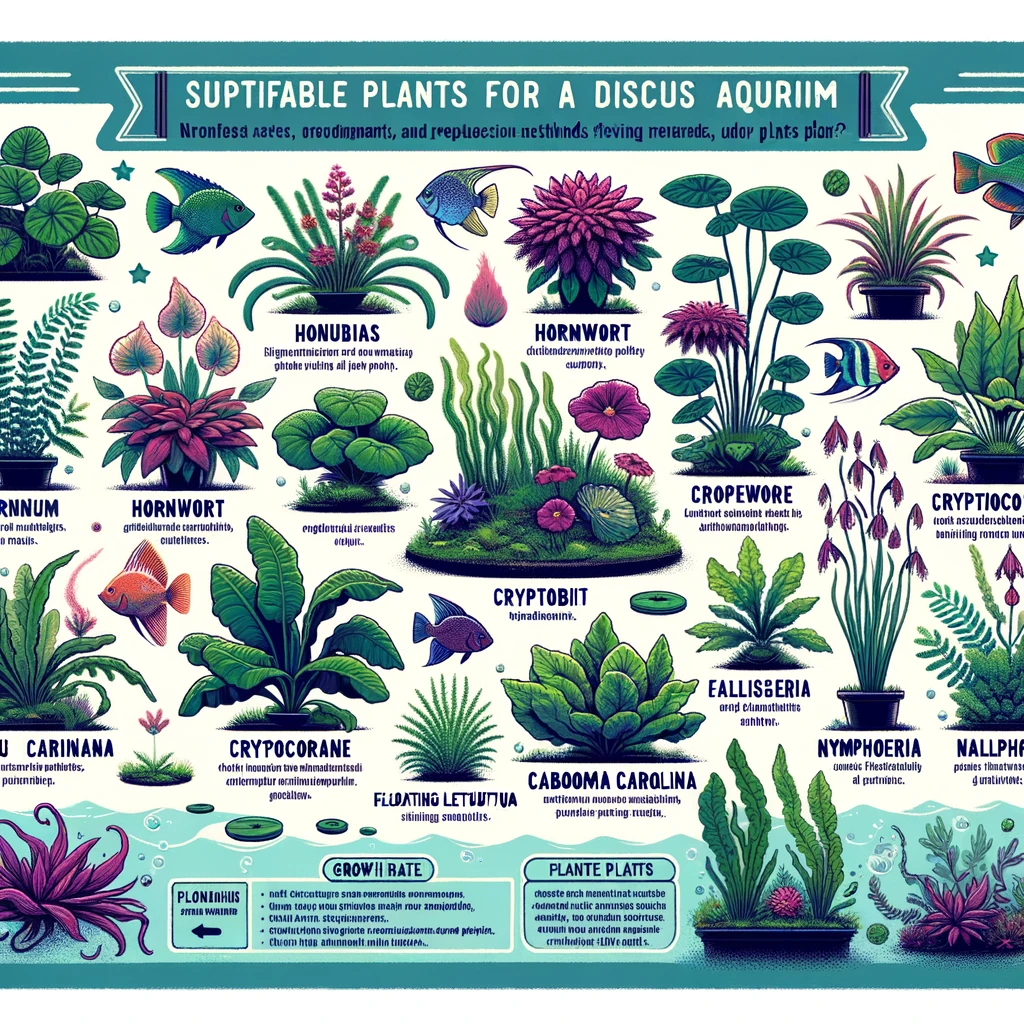
Creating a thriving environment for Discus fish involves incorporating suitable plant species that can adapt to the specific conditions of a Discus tank. Here are some recommended plants that are known for their resilience and compatibility with the environmental conditions favoured by Discus:
Anubias Species Overview
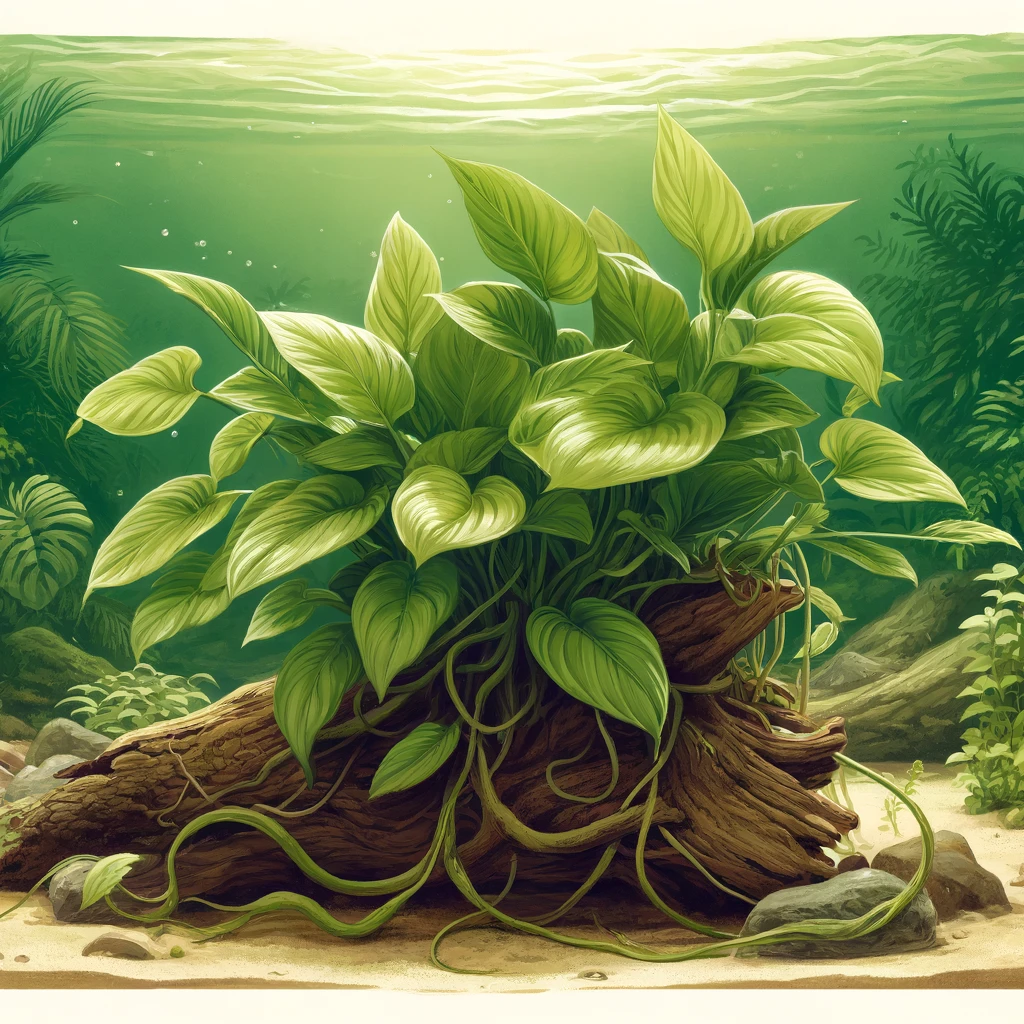
Anubias species are among the most popular aquarium plants due to their hardiness and low light requirements. Originating from tropical West Africa, these plants thrive under a variety of water conditions and are a favorite for both beginner and expert aquarists. Here’s a detailed look at their characteristics:
Origin
- Tropical West Africa: Anubias plants are native to streams, rivers, and marshes in tropical climates where they often grow attached to submerged wood or rocks.
Reproduction
- Side Shoots: Anubias propagate through rhizome division. They produce side shoots that can be separated and planted to grow new plants.
Culture
- Undemanding: Anubias are known for their minimal care requirements. They do not need strong lighting and can thrive in low-light aquariums, making them suitable for shaded areas under larger plants or in setups with subdued lighting.
Growth Rate
- Very Slow: Typically, Anubias add only a few leaves each year. Their slow growth rate makes them easy to maintain, as they seldom outgrow their space or require frequent pruning.
Temperature Range
- 22-28°C: Anubias are adaptable to a range of water temperatures, but they prefer the warmer conditions found in typical tropical aquariums.
Ideal Planting Conditions
Anubias are best mounted on rocks or driftwood, which mimics their natural habit of growing attached to submerged surfaces. This positioning helps prevent rotting of the rhizome, which can occur if buried in substrate.
These characteristics make Anubias a robust choice for various aquarium setups, especially where other plants might struggle. Their lush, green leaves and tolerance for lower light and varied water conditions provide aesthetic value and a habitat for fish and other aquatic creatures.
Hornwort (Ceratophyllum demersum)
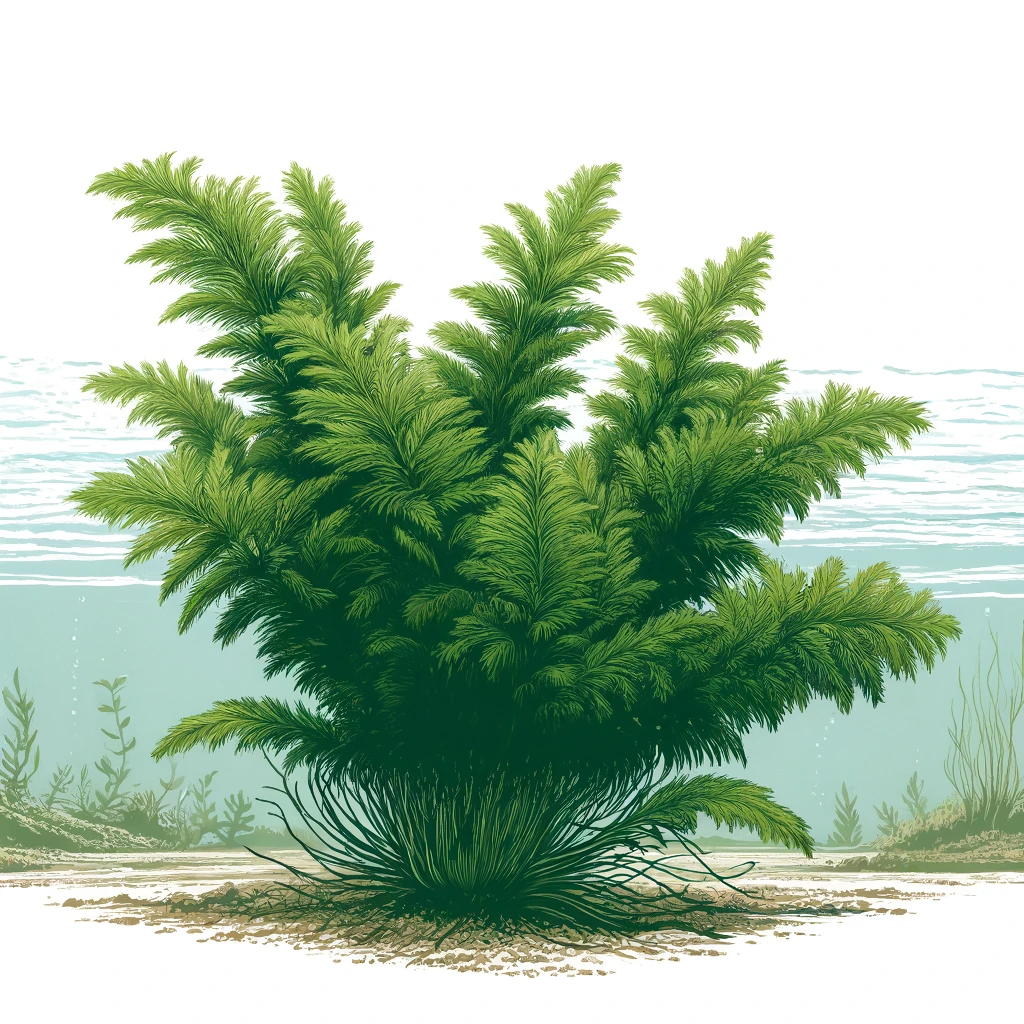
Hornwort, also known as Ceratophyllum demersum, is a popular freshwater aquarium plant and pond plant. It is notable for its adaptability and ease of care, making it a favorite among both novice and experienced aquarists. Here’s an in-depth look at its characteristics:
Features
- Rootless: Hornwort does not have traditional roots. It anchors itself with modified leaves or rhizoids, making it easy to plant and manage in various substrates or even floating freely.
- Stem Plant: It has long, branched stems that can grow between 50 to 100 cm in length, offering a lush, bushy appearance that is excellent for filling up space and adding greenery to the aquarium or pond.
- Branched Leaf Whorls: The leaves are arranged in whorls around the stem, giving it a feather-like appearance. These dense leaves are great for providing shelter and hiding spots for fish, especially fry.
Growth Rate
- Hornwort is a fast-growing plant that can extend its length by about 10 to 20 cm each week under optimal conditions. This rapid growth rate makes it an excellent option for new tanks, as it helps to establish biological filtration and stabilize the environment quickly.
Reproduction
- Vegetative Propagation: Hornwort primarily reproduces vegetatively. It grows side shoots that easily break off from the parent plant and then grow independently. These side shoots should be at least 20 cm long to ensure they survive and thrive when detached.
- Efficient at Absorbing Nutrients: Its ability to absorb excess nutrients from the water column makes it a natural choice for controlling algae, as it competes with algae for nutrients.
Temperature Range
- Wide Range: One of Hornwort’s significant advantages is its vast temperature tolerance, ranging from as low as 1°C up to 28°C. This broad range makes it suitable for many different climates and indoor aquarium conditions.
Hornwort’s resilience and low maintenance requirements, combined with its utility for improving water quality and providing a habitat for aquatic creatures, make it an ideal choice for both aesthetic and practical purposes in an aquarium or pond.
Crinum Species Overview
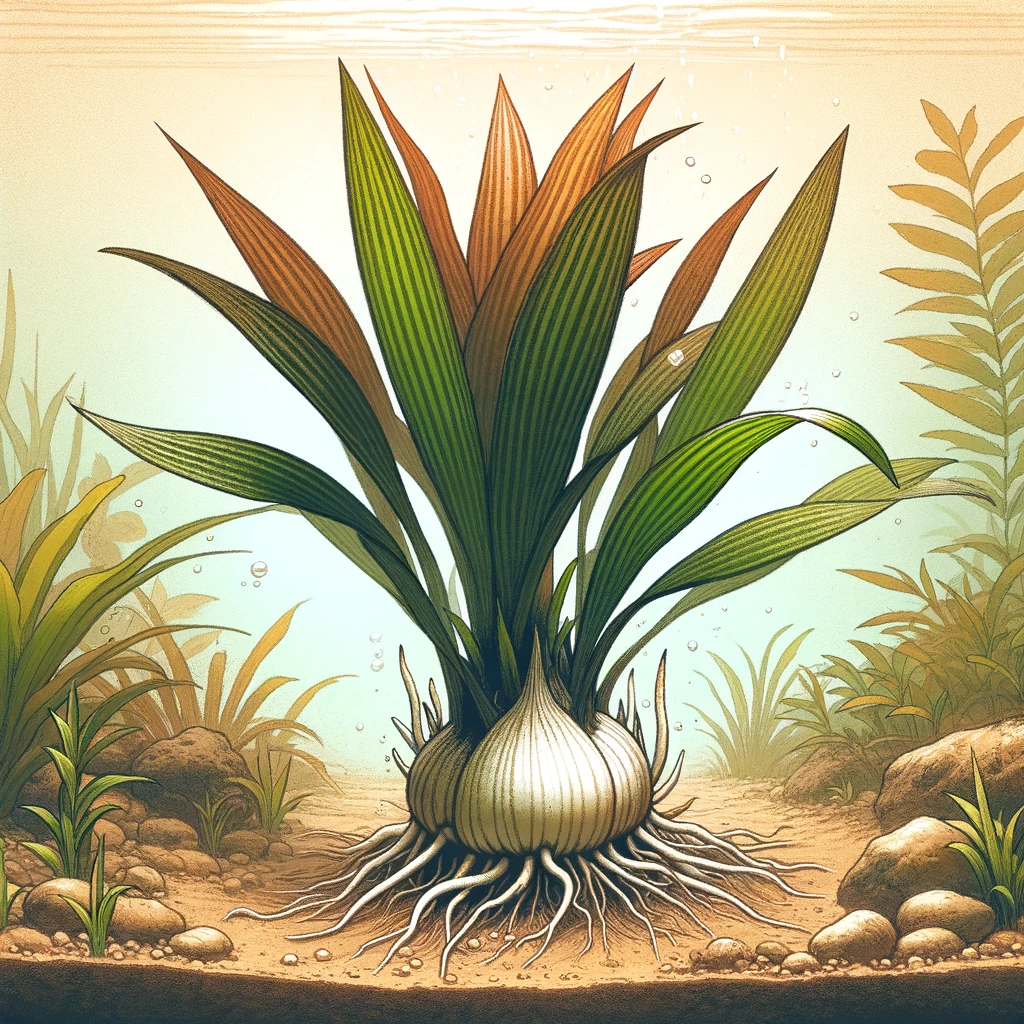
Crinum species are a group of aquatic plants that are valued for their striking appearance and resilience. These plants are suited to a variety of aquarium settings due to their undemanding nature and beautiful, strap-like leaves. Here’s a closer look at their characteristics:
Culture
- Undemanding: Crinum species are not particularly demanding regarding water parameters and lighting, making them suitable for both novice and experienced aquarists. They can thrive in a range of lighting conditions, from moderate to bright.
Growth Rate
- Moderate: Crinum species typically produce about 1-2 new leaves per month. While not the fastest growers, their steady development contributes to a gradually changing aquascape.
Reproduction
- Daughter Bulbs: These plants reproduce by forming daughter bulbs alongside the parent bulb. Over time, these can be separated and planted individually to propagate new plants.
Temperature Range
- 22-28°C: Crinum species are tropical plants that prefer warmer water, making them ideal for typical heated aquariums.
Ideal Planting Conditions
Crinum species are best planted in the substrate with their bulbs partially exposed to prevent rot. Their long leaves can create dramatic backgrounds or mid-ground accents in larger tanks, providing excellent coverage and hiding spots for fish.
These attributes make Crinum a popular choice for aquarists seeking durable yet attractive plants that add a vertical dimension to their underwater landscapes.
Cryptocoryne Species Overview
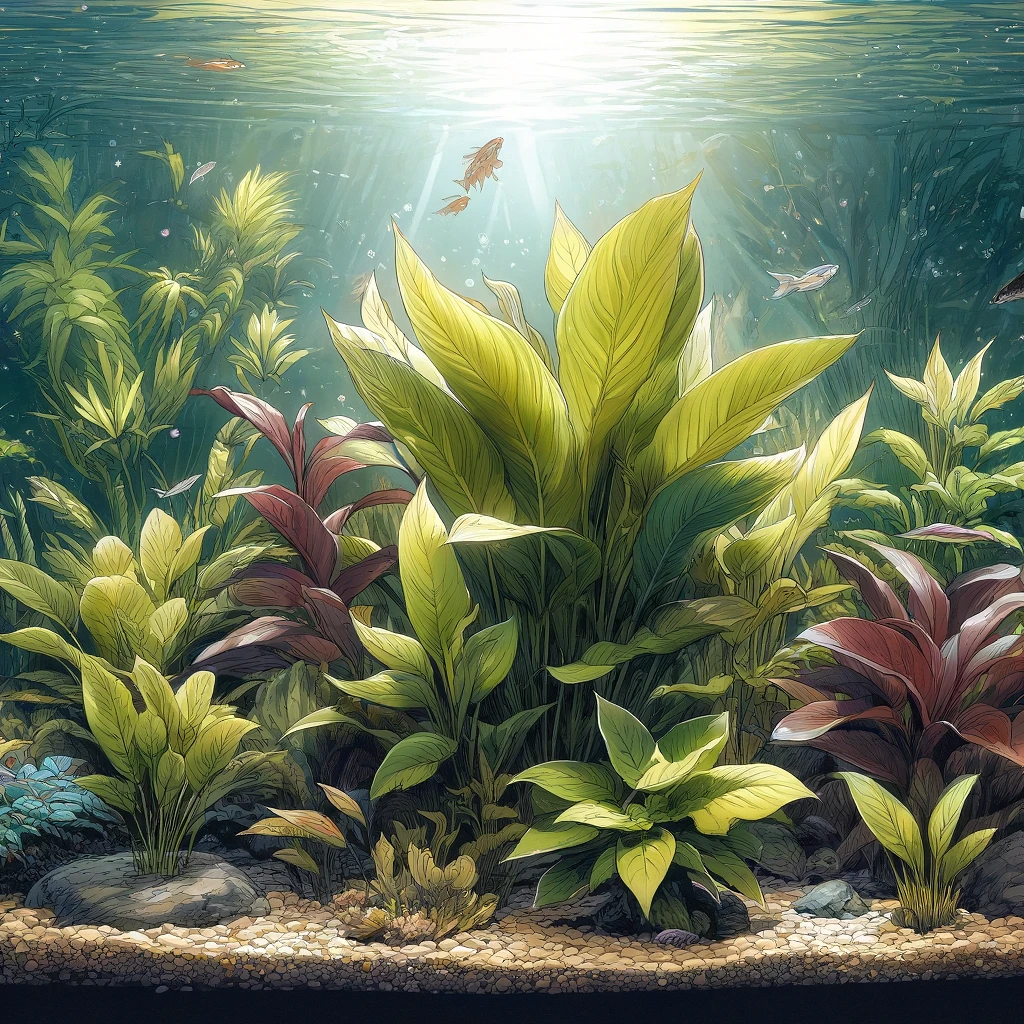
Cryptocoryne species, often referred to as “Crypts,” are among the most popular aquarium plants due to their aesthetic appeal and adaptability. These plants are native to tropical regions and offer a variety of leaf forms and colours, making them versatile additions to any freshwater aquarium. Here’s a detailed look at their characteristics:
Culture
- Undemanding: Cryptocoryne species are well-known for their low maintenance requirements. They thrive in a range of lighting conditions, from low to moderate, and are tolerant of different water qualities, making them suitable for a variety of tank setups.
Growth Rate
- Slow to Moderate: Crypts generally produce 4-12 new leaves annually. Their growth rate can vary depending on the species, water conditions, and lighting.
Reproduction
- Runners: Cryptocoryne plants reproduce by sending out runners that eventually grow into new plants. This vegetative propagation allows for easy natural spreading within the aquarium.
Temperature Range
- 22-28°C: Crypts prefer a warm tropical environment, which aligns with the typical temperature range for many home aquariums.
Ideal Planting Conditions
Cryptocoryne species are best planted in the substrate with their roots well-covered. They are ideal for foreground and midground placements, where their lush foliage can create dense clusters that enhance the tank’s visual depth and provide hiding spots for fish and invertebrates.
These characteristics make Cryptocoryne a favourite among aquarists who seek to create a natural, densely planted aquascape with minimal effort.
Echinodorus Species Overview
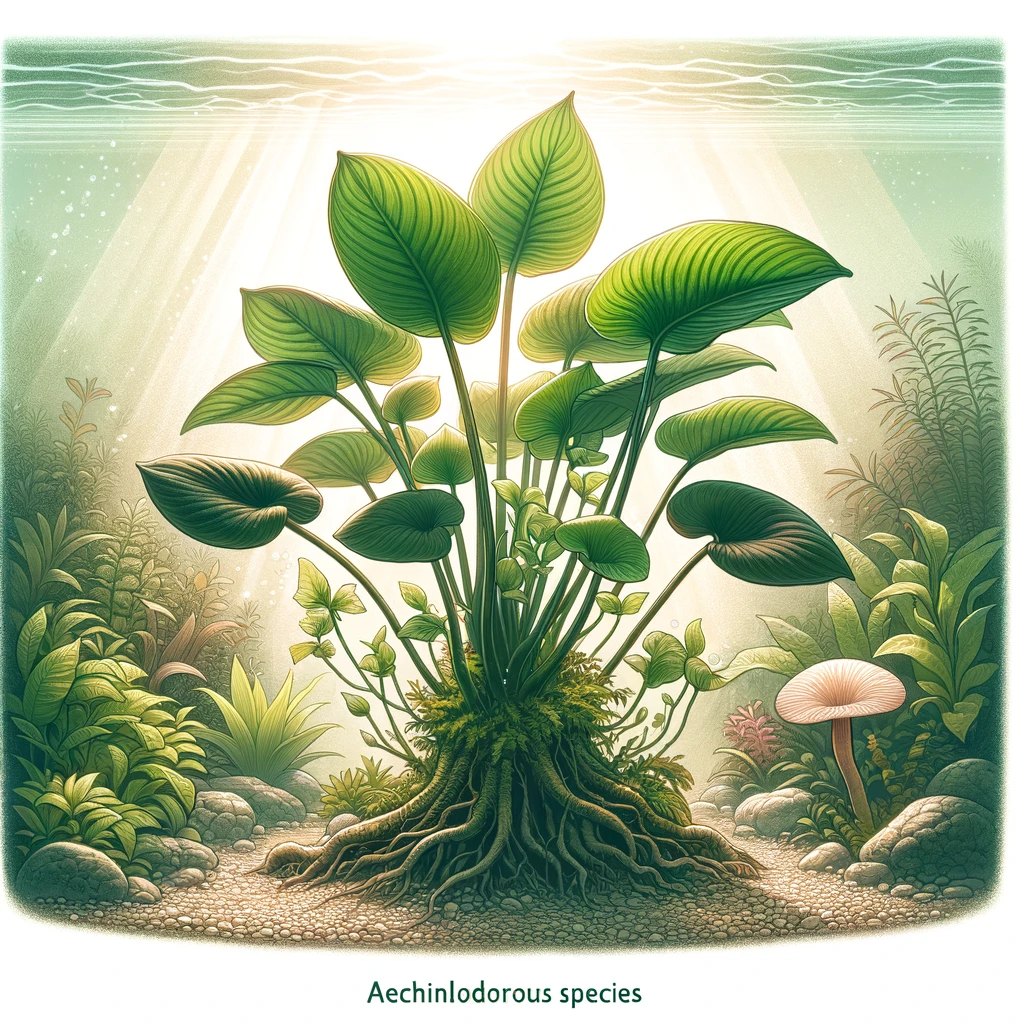
Echinodorus species, commonly known as Amazon Sword plants, are a staple in many freshwater aquariums. They are renowned for their large, broad leaves and robust growth, which make them a focal point in any aquatic setup. Here’s an in-depth look at their characteristics:
Culture
- Undemanding: Echinodorus are tolerant of a wide range of water conditions and do not require intense lighting, making them suitable for beginners as well as seasoned aquarists. They thrive in both soft and hard water, adapting easily to different tank environments.
Growth Rate
- Moderate: These plants typically produce 1-3 new leaves each month. Echinodorus can grow quite large, making them suitable for the background or centrepieces in larger tanks where they have space to spread.
Reproduction
- Adventitious Plants: Echinodorus reproduces through adventitious plants, commonly known as plantlets, which form on the flower stalk. These plantlets can be left to develop into sizable plants while still attached to the parent or can be removed and planted separately once they’ve formed sufficient roots.
Temperature Range
- 22-28°C: This temperature range is ideal for Echinodorus, coinciding with the conditions favoured by many tropical fish, making these plants compatible with a variety of community tanks.
Ideal Planting Conditions
Echinodorus should be planted in nutrient-rich substrate to support their robust root systems. They benefit from regular fertilization, especially in setups without a nutrient-dense substrate. Given their potential size, ensuring adequate space for growth is crucial to prevent overcrowding.
These attributes make Echinodorus a popular choice among aquarists for adding greenery and enhancing the natural beauty of aquariums. They provide excellent shelter and breeding grounds for fish, contributing to a healthy and balanced aquatic ecosystem.
Floating Plants Overview
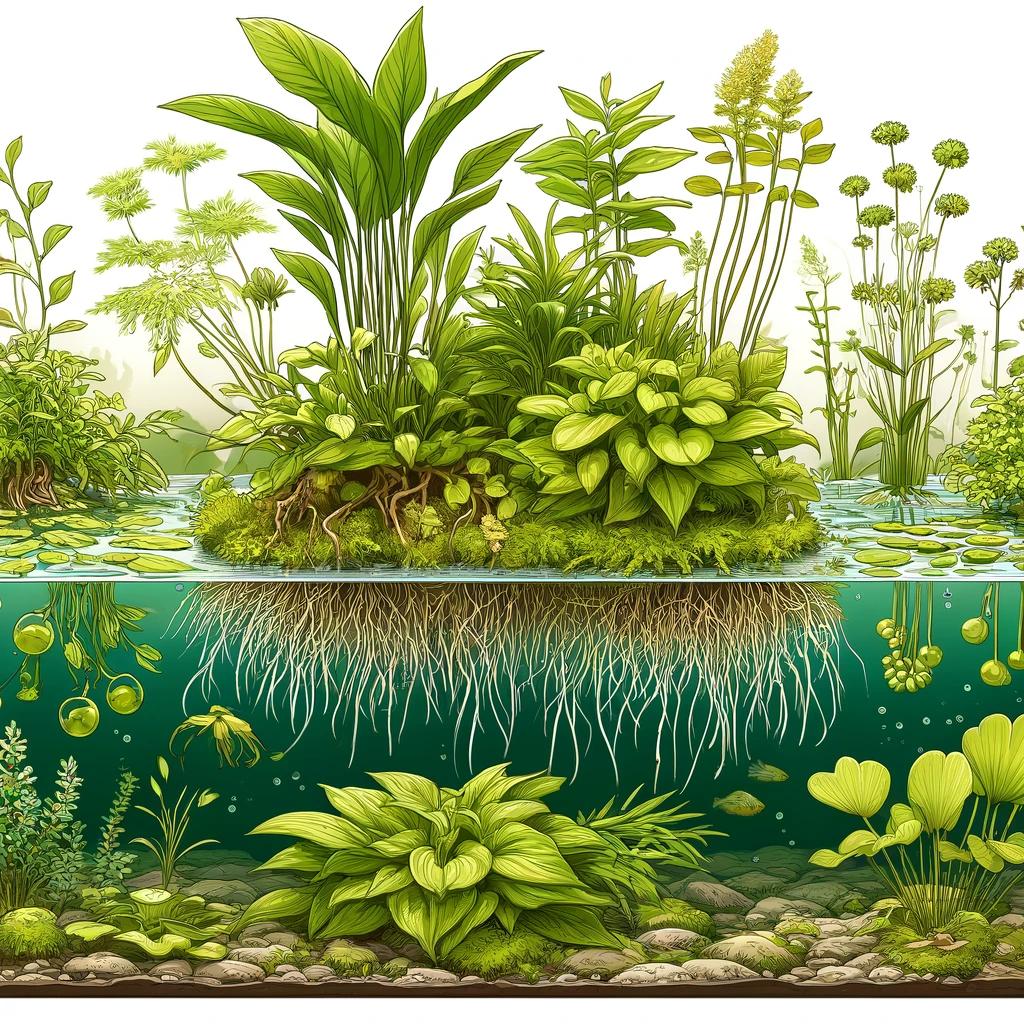
Floating Plants such as Water lettuce, Frogbit, Shellflower, and Duckweed are favoured in aquarium settings for their ease of care and the unique benefits they provide. These plants float on the surface of the water, offering shade and shelter to fish below while adding a dynamic layer to the aquarium landscape. Here’s a detailed look at their characteristics:
Examples of Floating Plants
- Water Lettuce (Pistia stratiotes): Features rosettes of light green leaves that resemble an open lettuce head.
- Frogbit (Limnobium laevigatum): Small, round leaves float on the surface, with roots that dangle underwater.
- Shellflower (Pistia stratiotes): Similar to water lettuce, with rosette-forming leaves.
- Duckweed (Lemna minor): Very small, simple floating plants that cover the water’s surface.
Culture
- Undemanding: Floating plants generally require minimal care. They do not need anchorage in the substrate, making them easy to manage and ideal for all types of aquariums.
Reproduction
- Offshoots: These plants reproduce quickly and easily, often forming dense mats. They reproduce primarily through vegetative means, with new plants budding off from the parent plant, quickly covering large areas if left unchecked.
Temperature Range
- 10-28°C: Floating plants are adaptable to a wide range of temperatures, making them suitable for both tropical and temperate aquariums.
Benefits of an Aquarium
- Water Quality: Floating plants help to improve water quality by absorbing excess nutrients, thereby reducing algae growth.
- Shade and Shelter: They provide shade, reducing stress for fish that prefer lower light levels, and their roots offer hiding spots for fry and shy fish.
- Aesthetic Appeal: Adds a lush green cover to the water surface, enhancing the natural beauty of the aquarium.
Floating plants are excellent for novice and expert aquarists alike, offering environmental benefits while requiring little in terms of care.
Cabomba caroliniana Overview
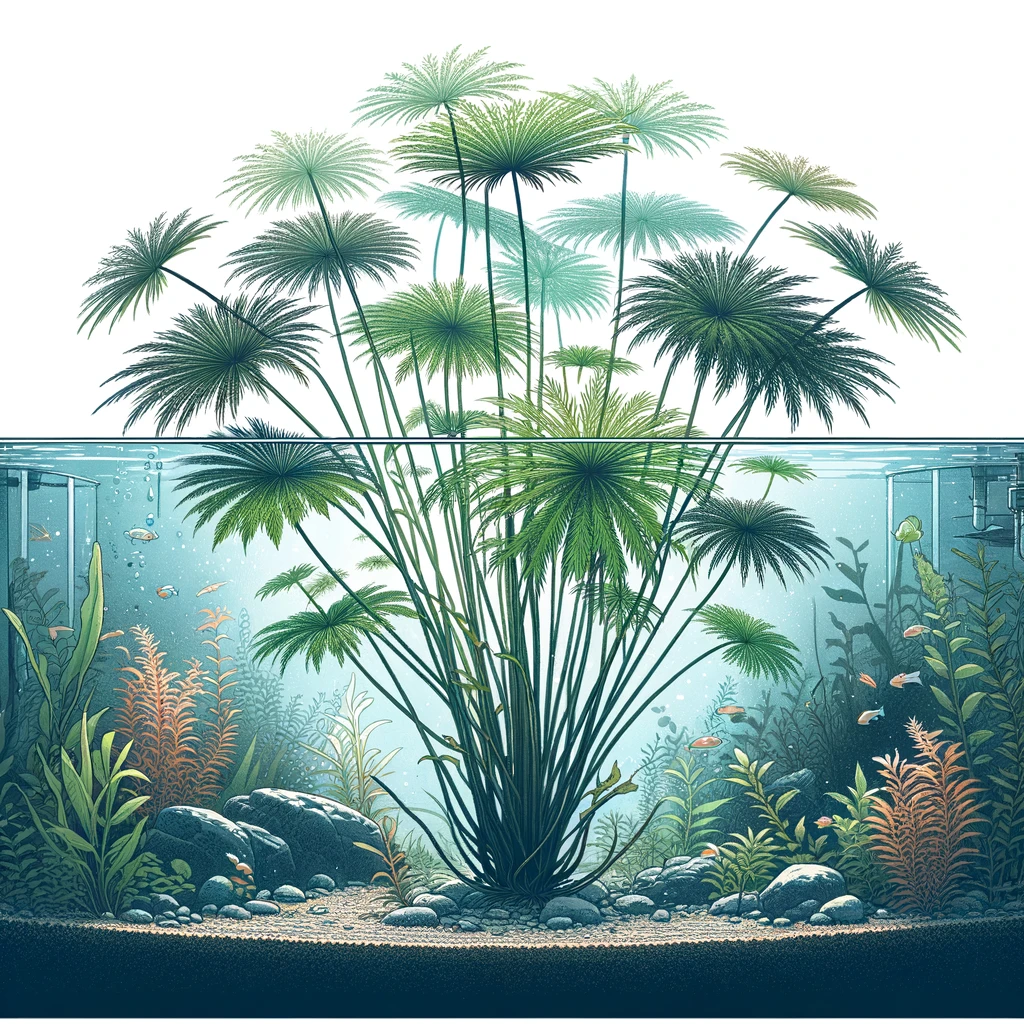
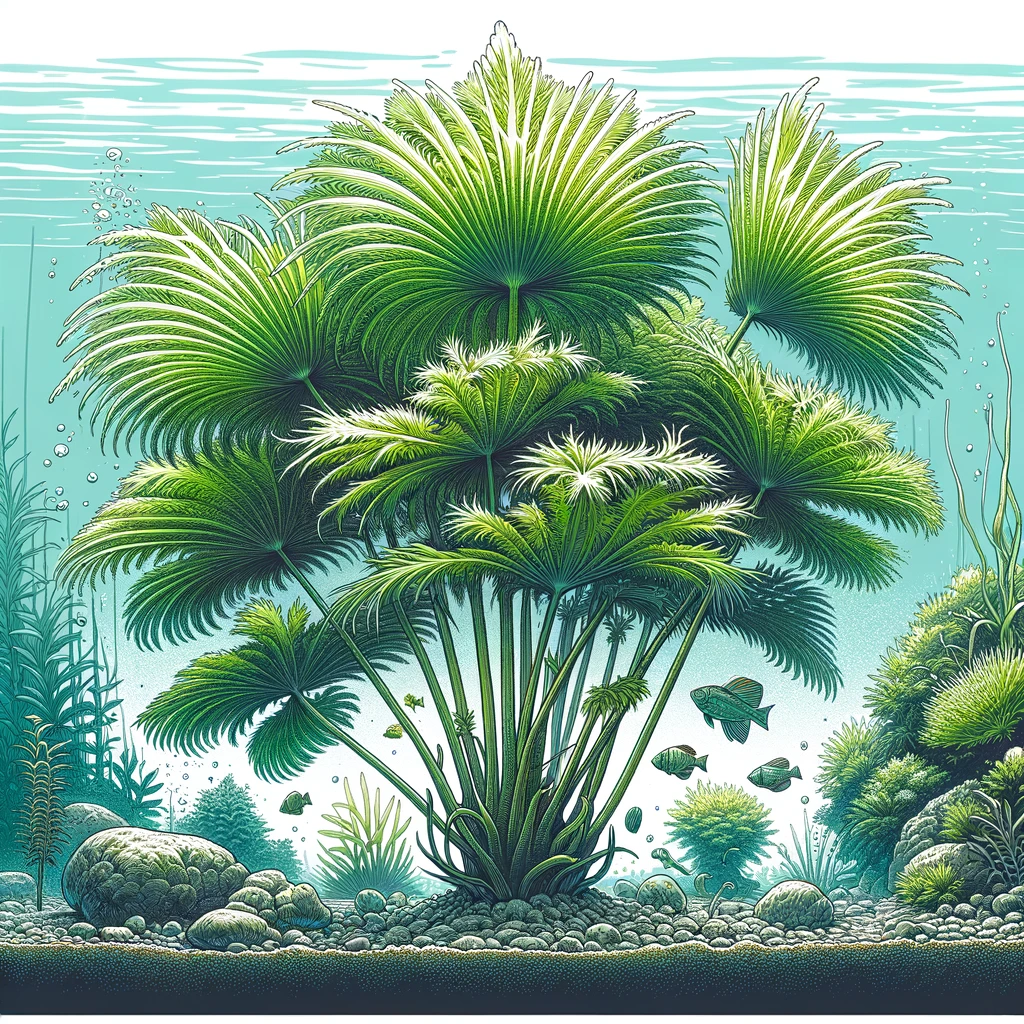
Cabomba caroliniana, commonly known as Carolina Fanwort, is a popular aquatic plant in the aquarium hobby due to its delicate, fan-like leaves and beautiful underwater presence. This plant is native to both North and South America and is often used to add a touch of greenery and to improve the habitat within fish tanks. Here’s an in-depth look at its characteristics:
Features
- Stem Length: Typically reaches up to 50 cm in length, making it suitable for midground to background placement in aquariums.
- Growth Rate: Fast-growing, Cabomba can extend 5-10 cm per month, quickly filling in the background of an aquarium and creating a dense plant bed.
- Reproduction: Propagation is achieved through top cuttings, which are about 25 cm long. These cuttings can be replanted in the substrate to grow new plants.
- Temperature Range: Thrives in a temperature range from 18°C to 28°C, allowing it to adapt to most tropical aquarium settings.
Ideal Planting Conditions
- Lighting: Cabomba Caroliniana requires moderate to high lighting to maintain its vibrant green colour and dense leaf structure. Insufficient light may cause the plant to become leggy and lose its appealing aesthetics.
- Water conditions: Prefers clean, slightly acidic to neutral water and can benefit from the addition of CO2, although it’s not strictly necessary.
Benefits of an Aquarium
- Aesthetic Appeal: Its feathery, fan-like leaves add a distinct texture contrast against other aquatic plants, enhancing the visual depth of the aquarium.
- Fish Habitat: Provides excellent cover and breeding grounds for fish and invertebrates, especially for fry which may use the dense foliage for protection.
- Water Filtration: Helps in filtering the water by absorbing nutrients, thereby reducing the likelihood of algal blooms.
Cabomba Carolinians’s fast growth rate and ease of propagation make it a favoured choice among aquarists who want to create a lush, green-planted aquarium with minimal effort.
Vallisneria Species Overview
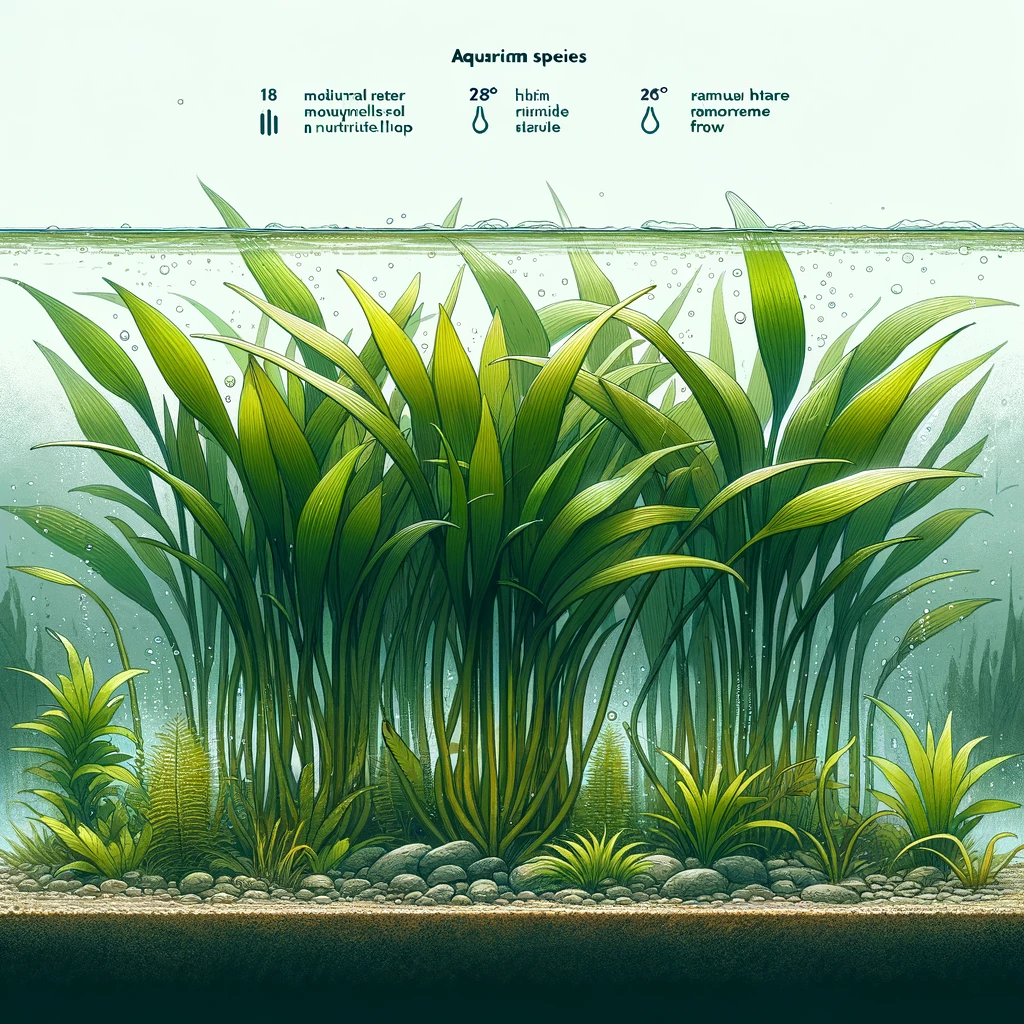
Vallisneria, commonly known as “Val” or “Eelgrass,” is a well-loved aquarium plant favoured for its straightforward care requirements and its striking, grass-like appearance. This plant originates from various freshwater habitats around the world and is ideal for creating a natural, underwater landscape. Here’s an in-depth look at its characteristics:
Features
- Green, Ribbon-like Leaves: Vallisneria features long, slender leaves that can grow several feet in length in some species, resembling eelgrass. These leaves spiral from a central base, creating a dense, grassy bed in the aquarium.
Growth Rate
- Moderate: Typically, Vallisneria will produce about 2 new leaves per month. While individual plants grow slowly, their propensity to spread via runners means they can quickly cover large areas of the aquarium floor.
Reproduction
- Runner Plants: Vallisneria reproduces prolifically through runners that extend from the parent plant. New plants will sprout from these runners and root themselves in the substrate, gradually forming extensive colonies.
Temperature Range
- 18-28°C: This broad temperature range makes Vallisneria suitable for a wide variety of aquarium setups, from tropical to temperate.
Ideal Planting Conditions
- Substrate: Vallisneria thrives best in a nutrient-rich substrate where their roots can anchor deeply.
- Water Flow: They prefer environments with moderate water flow that mimics their natural riverine habitats, helping to keep their leaves free of debris.
Benefits of an Aquarium
- Aquascaping: Vallisneria’s vertical growth and grass-like appearance make it excellent for background planting, where it can create a backdrop that enhances the depth and beauty of an aquarium.
- Habitat: Provides shelter and breeding grounds for fish, especially for species that prefer to spawn on plant leaves or in sheltered vegetative areas.
- Water Quality: Helps maintain water clarity and quality by absorbing excess nutrients, which can help control algae growth.
Vallisneria’s ease of care and beautiful appearance make it a popular choice for both novice and advanced aquarists looking to add a dynamic and natural element to their aquariums.
Nymphaea Species Overview
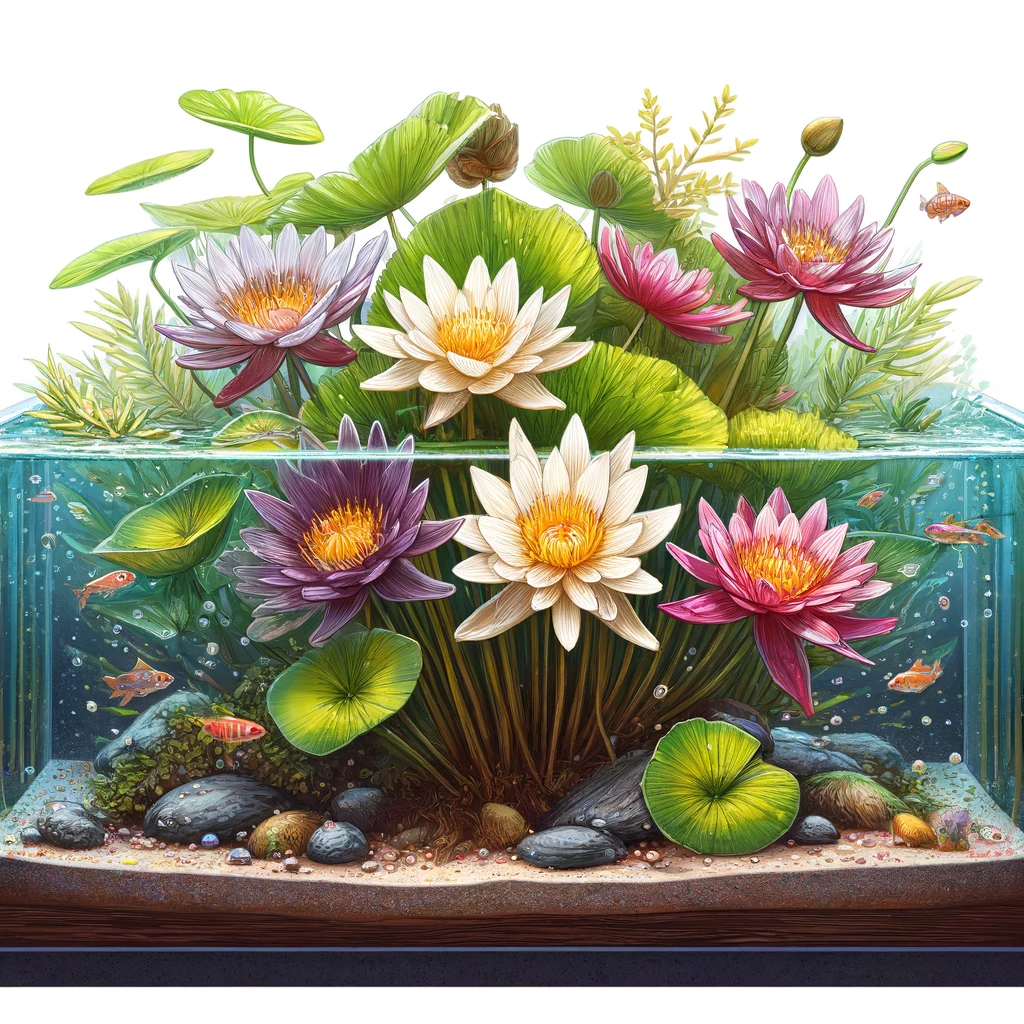
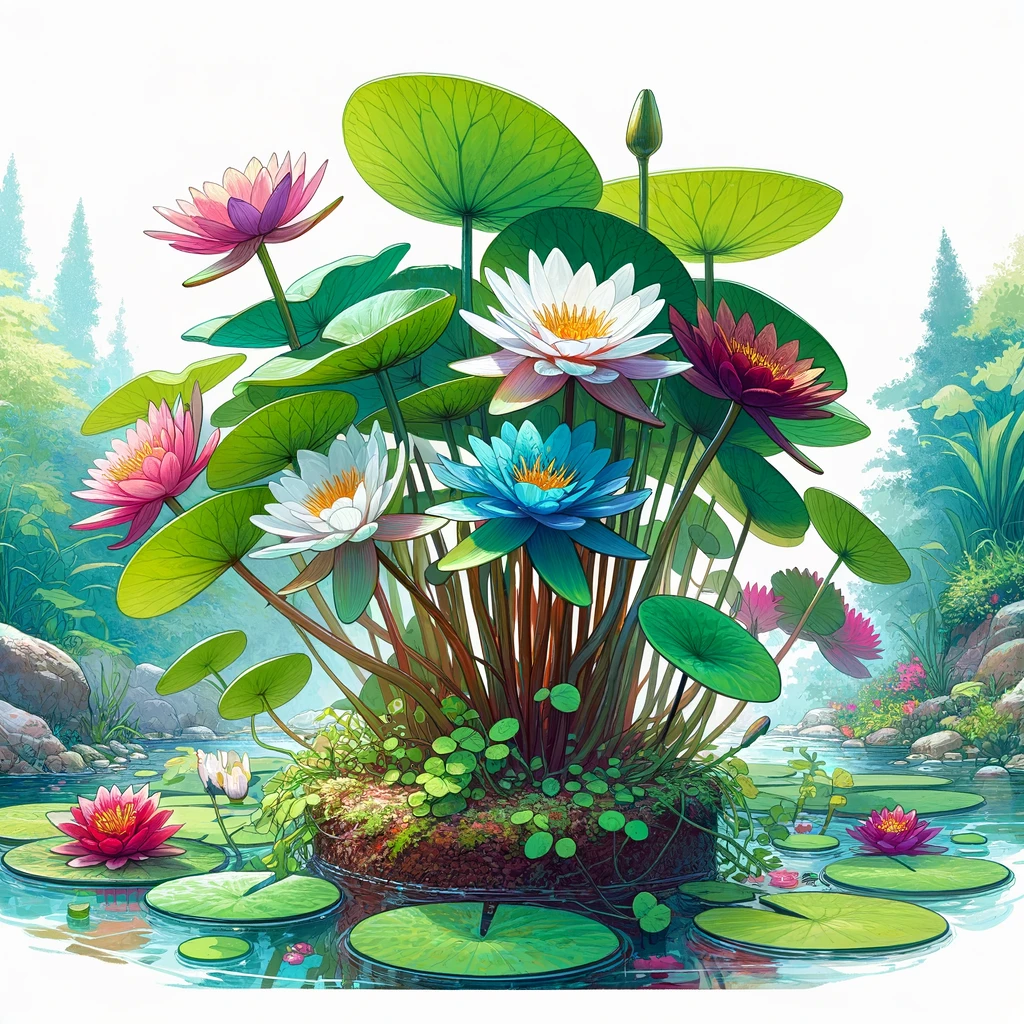
Nymphaea, commonly known as water lilies, are a distinguished group of aquatic plants that bring spectacular beauty to any freshwater aquarium or pond. These plants are not only visually appealing but also provide practical benefits within aquatic environments. Here’s a detailed look at their characteristics and care requirements:
General Features
- Leaf and Flower Characteristics: Nymphaea species produce broad, floating leaves and striking flowers that can range in colour from whites and yellows to deep reds and purples. The leaves typically spread across the water surface, offering shade which helps reduce algae growth by limiting light.
Culture
- Adaptable to Various Conditions: Water lilies are quite adaptable, thriving in a range of water conditions. They are suitable for Discus tanks, which generally have warmer water temperatures and stable pH levels.
- Planting: Water lilies are best planted in pots submerged in the aquarium or pond. They require a rich substrate to support their growth, typically a mix of clay and sand.
Growth and Care
- Growth Rate: Water lilies have a moderate growth rate. They extend their roots into the substrate and produce leaves that float to the surface.
- Reproduction: These plants propagate through both seeds and division. In aquarium settings, division is the more practical method, involving separating portions of the root system to grow new plants.
Temperature Range
- 22-28°C: This range is ideal for Nymphaea in aquarium settings, aligning well with the typical conditions required for Discus tanks.
Benefits of an Aquarium
- Aesthetic Appeal: Few plants can match the visual impact of a blooming Nymphaea. Its presence can transform an aquarium from a simple setup to a stunning display.
- Environmental Benefits: The broad leaves provide shade and hiding spots for fish, which can help reduce stress and offer protection for fry.
- Water Quality: By covering the surface, water lilies reduce light penetration and help control algae growth through shading.
Nymphaea species are an excellent choice for aquarists seeking to add both beauty and functional value to their tanks. Their resilience and dramatic appearance make them particularly popular among those who wish to create a naturalistic setting in their aquatic habitats.
Gender Determination in Discus Fish
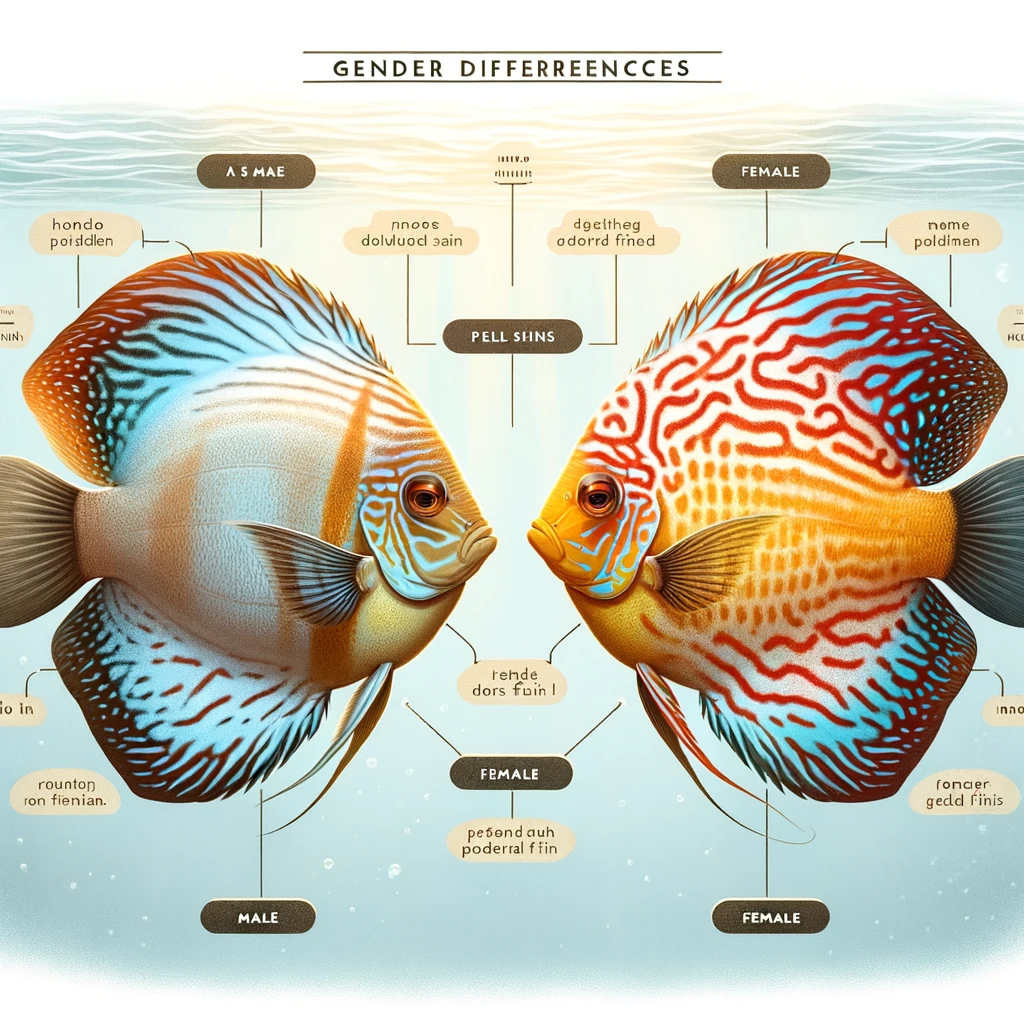
Determining the gender of Discus fish is notoriously challenging, requiring a significant amount of experience and observation. Here’s a detailed guide on how to potentially distinguish between males and females, although it’s important to note that these methods do not guarantee 100% accuracy.
General Observations:
- Experience Required: It often takes a practised eye to discern the subtle differences in appearance and behaviour that may indicate a Discus fish’s gender.
- Behavioural Clues: Sometimes, behavioural differences can provide hints about a fish’s gender before physical characteristics are apparent.
Physical Characteristics:
- Size and Head Shape: Males, particularly those of the same age as females, tend to be larger with a more robust head. When viewed from the front, the male’s head appears stronger and more pronounced. From the side, the male’s head is also more rounded, whereas females tend to have a slightly more pointed head shape.
- Fins:
- Dorsal Fin: The dorsal fin of males is more extended and pointed, while females typically have a rounder dorsal fin.
- Tail Fin: Males often have a wider tail fin, which aligns closely with the edges of both the dorsal and ventral fins.
- Pectoral Fins: Males may also exhibit slightly longer pectoral fins compared to females.
Challenges with Juveniles:
- Young Fish: In juveniles and sub-adults, gender differences are less pronounced or almost indistinguishable. Size can sometimes be a deceptive indicator, as males are generally larger than females even at a young age.
- Purchasing Advice: When buying a group of young Discus, it’s advisable not to select based solely on size, as this may not accurately reflect their gender.
Tips for Buyers:
- Mature Fish: When Discus reach a size of about 12-14 cm, the differences between genders become more noticeable, similar to those observed in adults.
Gender determination in Discus fish is complex and often uncertain without professional breeding experience. It involves careful observation over time, with attention to both physical traits and behavioural cues.
Lorem ipsum dolor sit amet, consectetur adipiscing elit. Ut elit tellus, luctus nec ullamcorper mattis, pulvinar dapibus leo.
Breeding Discus Fish: Strategies and Challenges
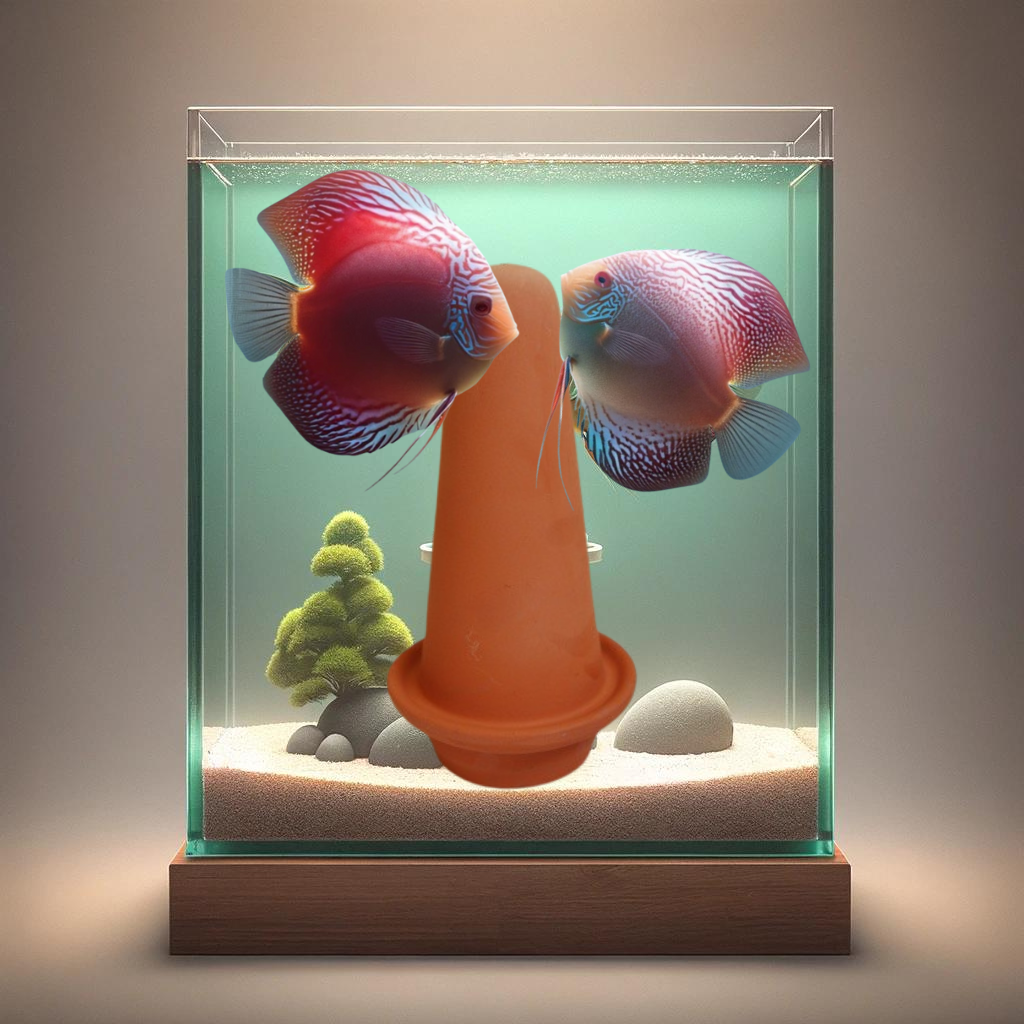
Breeding discus fish is a dream many enthusiasts hope to achieve, though it is not without its difficulties. Here, we will delve into the nuances of successful discus breeding, from selecting the right pair to managing the breeding environment.
Importing High-Quality Discus Varieties
In recent years, Germany has seen the import of striking red discus fish such as those from Alenquer and Rio Icá, which compete well with the colourful varieties from Asia. However, acquiring quality fish remains challenging as many discus sold under names like “Alenquer” are not true to their original regional varieties. This mislabeling and the preference for cheaper Asian breeds have made it difficult for enthusiasts to find authentic, high-quality discus for breeding purposes.
Natural Pairing and Breeding Preparation
Discus fish typically reach sexual maturity at around 10-12 months. When housed in groups, it’s almost certain that both males and females are present, leading to natural pairing after dominance battles. A potential breeding pair will isolate themselves in a corner of the aquarium, a behaviour that signifies their readiness to spawn.
Recommended Breeding Setup
For breeding, a simple “breeding cube” measuring either 50x50x50 cm or 60x60x60 cm works best. This setup should be devoid of substrate and decorations to prevent distractions and complications. An air-driven sponge filter is ideal for several reasons:
- It prevents fry from being sucked into the filter.
- It creates minimal current, facilitating effective egg fertilization.
- It enriches the water with oxygen, crucial for egg and fry development.
Water quality is crucial, with ideal parameters being a conductivity of 60-200 microsiemens and a pH between 4.5 and 6. Nitrate levels must be kept below 25 mg/l to prevent growth issues in the fry.
The Breeding Process
- Initial Steps: After introducing the pair to the breeding tank and allowing them to acclimate, they will start cleaning a provided spawning cone, indicating readiness to spawn.
- Spawning and Fertilization: The female lays eggs while the male fertilizes them, a process usually completed within 1-2 hours. A typical clutch contains 100-300 eggs.
- Post-Fertilization Care: Depending on the water temperature, it takes about 55-65 hours for the eggs to hatch into wriggling larvae attached to the cone. Keeping a night light or continuous lighting near the eggs during early development can positively influence the behaviour and health of the larvae.
- Initial Feeding: For the first four days post-hatching, the fry feeds exclusively on a special mucus secreted by the parents’ skin. From day five onwards, supplemental feeding with Artemia nauplii begins, necessitating more frequent water changes due to increased nitrate levels.
- Advancing Diet: By days 10-14, the fry can be fed finely ground lobster eggs, Bosmina, and freshly scraped beef heart multiple times a day. If parental disputes occur, it might be best to let the more attentive parent take over the rearing.
Post-Breeding Care
Approximately 3-4 weeks after spawning, it’s advisable to transfer the young discus to a separate, larger aquarium. Major water changes should be avoided to minimize stress and fluctuations in water conditions, which are critical for the young fish’s development.
Encourage Healthy Spawning with JBL DisCon Spawning Cone for Discus
Facilitate the breeding of your discus fish with the JBL DisCon Spawning Cone, an ideal egg-laying aid designed for discus females. Made from durable and neutral plastic, this stable, unbreakable cone features a conical shape that is highly accepted by discus fish, making it an excellent choice for encouraging natural spawning behaviour. Easy to clean and disinfect, the spawning cone can be submerged in hot water for about two hours to ensure a hygienic environment for egg laying. Measuring 25.5 cm in height and 11.1 cm in diameter, the JBL DisCon Spawning Cone is a reliable and essential tool for any discus breeder.
Disclaimer: As an Amazon Affiliate, I earn from qualifying purchases.
Hobby Breeding vs. Mass Production: What's Right for Discus Enthusiasts?
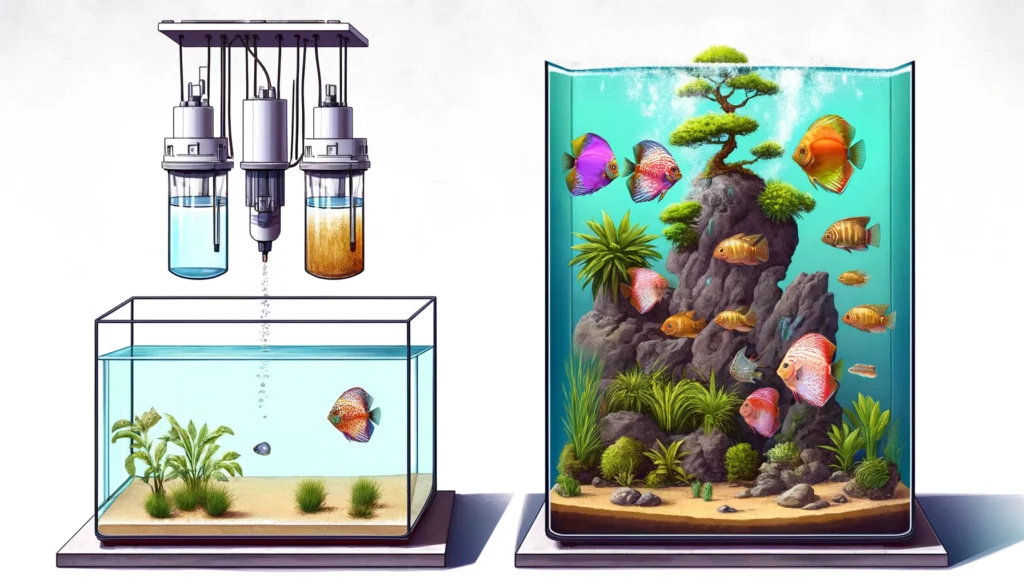
Breeding discus fish is a significant achievement for many enthusiasts, but the approach can vary greatly depending on one’s objectives and resources. Here we explore two different breeding setups: one focused on mass production and the other on hobby breeding, highlighting their respective advantages and drawbacks.
Mass Breeding Setup
The mass breeding approach often involves minimalistic setups designed for maximum efficiency and output. Typically, breeders use:
- Two 50cm x 50cm x 50cm cube aquariums and one 100cm x 50cm x 50cm aquarium.
- Each cube contains a spawning cone and no other decorations.
- The water used is pure reverse osmosis water, slightly hardened with salts and maintained at a temperature of 30-32°C.
- Water changes are aggressive, with 80-90% replaced daily, and pH levels are strictly controlled at around 6 using acids.
- The breeding pair, after acclimatization, will spawn, and the larvae will develop into brightly coloured juveniles, transferred to the larger tank and fed eight times a day on a diet of Artemia, mosquito larvae, and beef heart, enhanced with paprika powder and liquid vitamins.
Advantages:
- High yield of juveniles.
- Rapid growth and vibrant colours due to controlled feeding.
- Discus are less shy.
Disadvantages:
- Low immunity, makes them prone to diseases in less controlled environments.
- Not suitable for community tanks as 90% of the offspring are too weak.
- High rate of deformities.
- Sterile and visually unappealing tanks unsuitable for living areas.
- Boring upkeep with no natural fish behaviour visible.
- Misleading colours due to dietary additives.
Hobby Breeding Setup
In contrast, the hobby breeding setup is designed to mimic natural conditions more closely, making it a more satisfying and sustainable approach for many enthusiasts:
- Use a single 150cm x 50cm x 50cm aquarium.
- Pure reverse osmosis water is used, slightly hardened with salts or softened tap water adjusted with CO2 or peat to achieve a pH of around 6.
- The tank is decorated with sand or gravel, rocks, roots, and plants to create a more natural and visually appealing environment.
- The temperature is maintained at 28-30°C depending on the plants.
- Weekly water changes of about 30% are conducted, and the substrate is not cleaned.
- Stock includes two discus pairs and other biotope-appropriate fish, creating a dynamic and interactive environment.
Advantages:
- Strong immune system among the juveniles.
- Rarely carry pathogens and are robust against diseases.
- Suitable for community tanks with tap water.
- More natural growth and behaviour patterns.
- The aquarium is attractive and suitable for living spaces.
- Breeding is engaging and enjoyable, offering continual learning and discovery.
Disadvantages:
- The lower yield of juveniles.
- Slower growth and colour development.
- Potential for overcrowding if not managed properly.
Conclusion
For those aiming to produce large quantities of vibrant discus quickly, the first setup might be the best choice. However, for enthusiasts who value the natural beauty and behaviour of their fish, and who prefer a tank that enhances their living space, the hobby approach is recommended. Not only does it lead to healthier and more resilient fish, but it also offers a more rewarding and engaging aquaristic experience.
Effective Fish Catching Techniques for Aquarium Owners
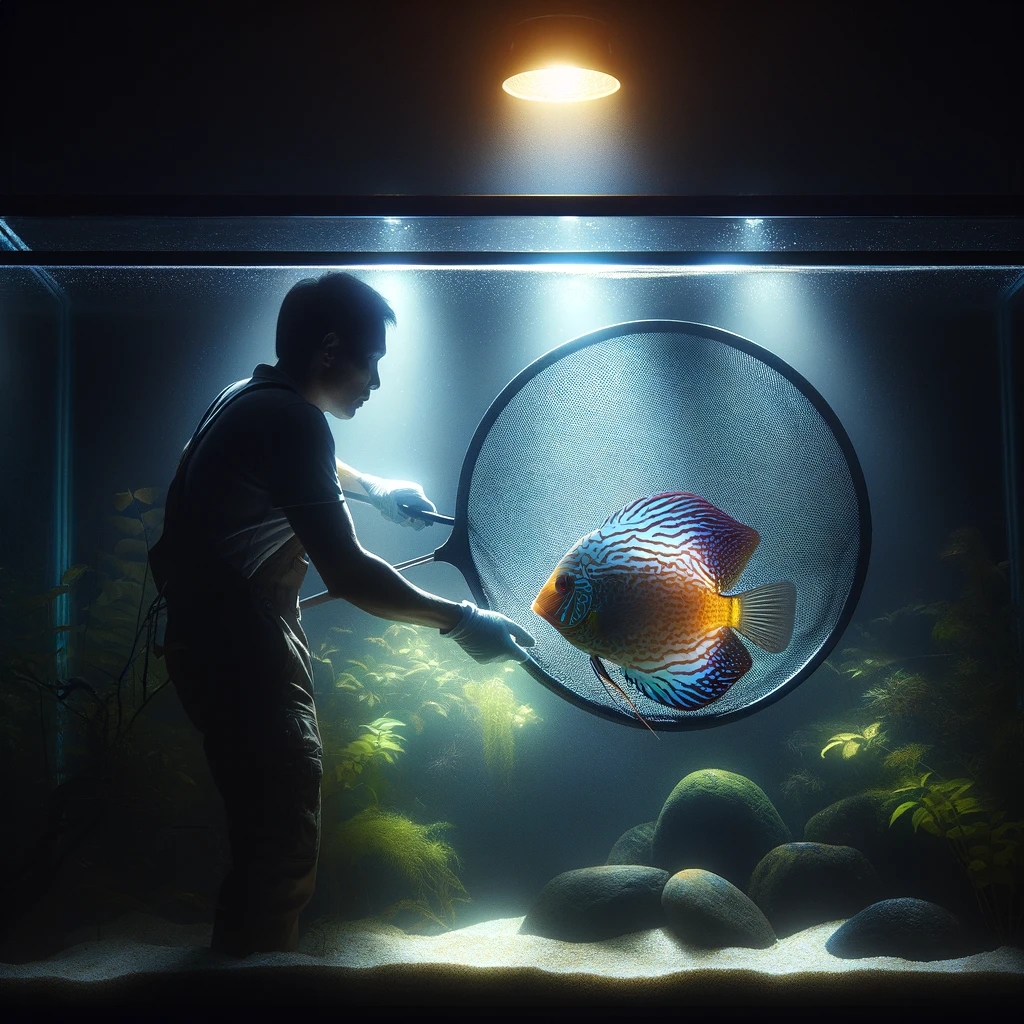
Catching fish from an aquarium can be a challenging task for many aquarists. This section provides practical tips and tricks for capturing fish efficiently without disrupting the entire aquarium setup.
Using Dual Net Technique for Stress-Free Capture
To catch fish effectively, especially larger species like discus, using two rectangular nets can be very effective. The first net should be large enough to comfortably contain the discus, while the second, smaller net is used to guide or herd the fish into the larger one.
Catching Fish at Night
One of the best times to catch fish is at night when the aquarium lights are off, and it is completely dark. Fish often rest on the bottom and are less alert, making them easier to approach. Using a flashlight, locate the fish and gently scoop it up with the larger net. Fish typically take about five minutes to fully awaken, providing ample time to catch them without causing panic.
Key Tips:
- Ensure total darkness to minimize stress and movement.
- Never remove the fish from the water during the catching process to prevent sudden movements that could lead to injury.
- Gently guide the fish into a container underwater for transfer to another tank.
Daytime Feeding Method
Another effective method involves catching fish during feeding times. Before feeding:
- Remove the tank’s cover to allow easier access.
- Place the net in the water beforehand to let the fish become accustomed to its presence without associating it with danger.
Start feeding the fish as usual. As they come to feed, use the opportunity to gently guide them into the net. This method requires quick reflexes and timing to catch the fish on the first try. If unsuccessful, you may need to wait until the next feeding, as the fish will likely hide.
Last Resort: Draining and Redecorating
If other methods fail, the final option involves more drastic measures:
- Remove all decorations and reduce the water level to about 10 cm. This makes it easier to catch the fish but should be done swiftly to minimize stress.
- This method should be used sparingly, as it can be highly stressful for the fish and disrupt the ecological balance of the aquarium.
Conclusion
Choosing the right method depends on the specific circumstances and the behaviour of the fish. Always prioritize the well-being of the fish, aiming to minimize stress and injury during the catching process. These methods provide a range of options to suit different situations, ensuring that both fish and aquarist remain safe and stress-free.
Co-Habitation of Discus Fish and Angelfish: Assessing the Risks and Precautions
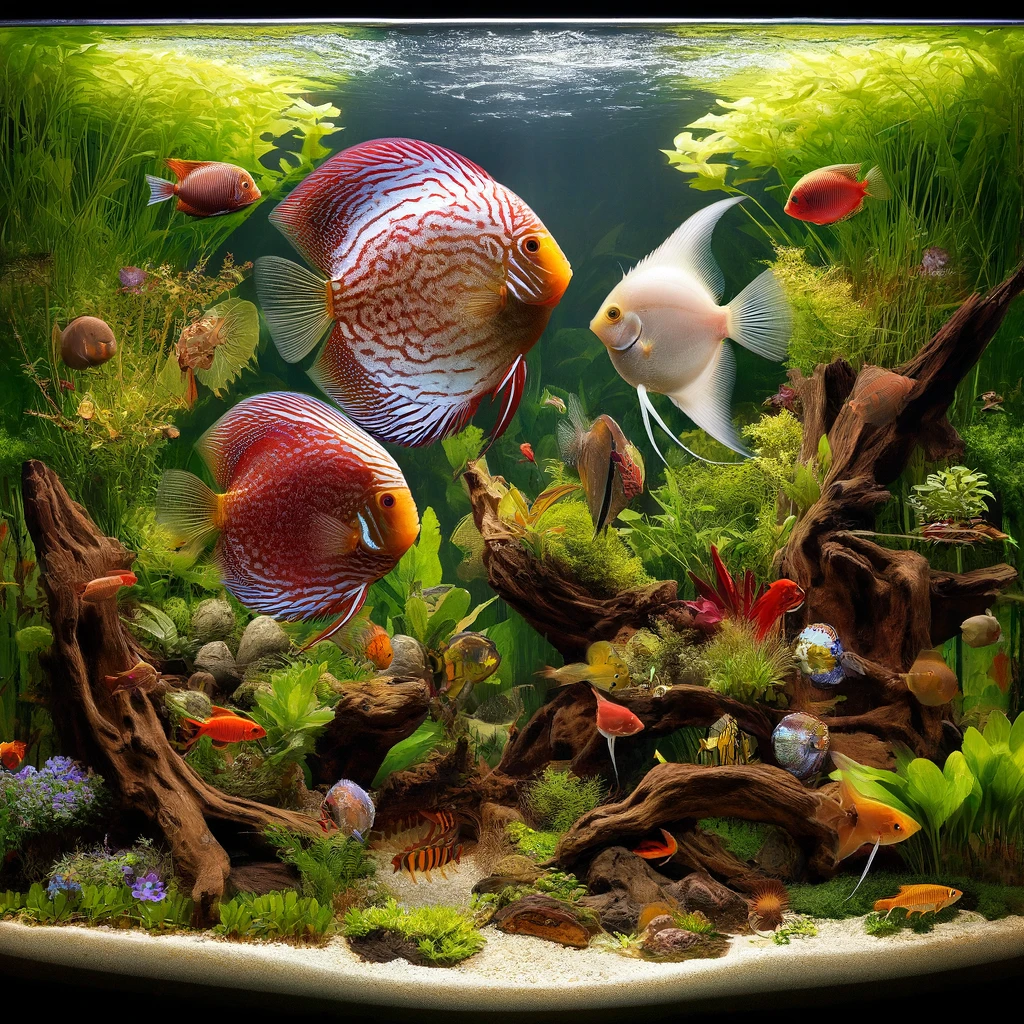
The practice of housing discus fish with angelfish (Pterophyllum scalare), particularly the altum variety (Pterophyllum altum), has long been debated among aquarists. Here, we’ll explore the potential risks and necessary precautions for such cohabitation.
Historical Concerns with Parasites
Historically, aquarists have been cautioned against keeping discus fish and angelfish together, primarily due to health concerns. Angelfish are known carriers of intestinal parasites that, while harmless to them, can pose lethal threats to discus fish. This risk is particularly pronounced with wild-caught specimens, which are more likely to carry a high parasite and pathogen load.
Behavioural and Feeding Differences
Discus fish are often described as “gourmet” eaters due to their selective eating habits and slower feeding pace. In contrast, angelfish are more aggressive during feeding and may dominate the food supply, leaving discus fish at a disadvantage. This difference in feeding behaviour can stress discus fish, leading to health issues and inadequate nutrition.
Similarities and the Possibility of Co-Habitation
Despite these challenges, many enthusiasts are drawn to both species due to their similar size, behaviour, and care requirements. Co-habitation is possible but comes with caveats:
Quarantine Measures: It is imperative to quarantine new angelfish, especially wild-caught ones, for several weeks to reduce the risk of transmitting parasites and pathogens to discus fish. Even with quarantine, the risk of infection can never be eliminated.
Feeding Strategies: To ensure that both discus and angelfish receive adequate nutrition without overfeeding, it’s crucial to design a feeding regimen that accommodates the slower eating habits of discus fish while managing the voracious appetite of angelfish. This may involve targeted feeding strategies or the use of barriers to temporarily separate the fish during feeding times.
Algae Control: Overfeeding can lead to excessive algae growth, further complicating tank maintenance. Ensuring balanced nutrition while controlling waste is essential to prevent this issue.
Recommendation for Separate Housing
Although it is technically possible to house these two species together, the complexities involved with managing their health and dietary needs generally lead to a recommendation for separate tanks. This approach not only simplifies care but also minimizes stress for both species, promoting healthier and more vibrant fish.
Conclusion
While the allure of keeping discus and angelfish together in a single aquarium is strong due to their similar aesthetic and care needs, the potential health risks and the challenge of managing their coexistence often outweigh the benefits. For aquarists who wish to enjoy both species, maintaining separate tanks is advisable to ensure the well-being of these beautiful fish.
Introduction to Farlowella acus: The Common Twig Catfish
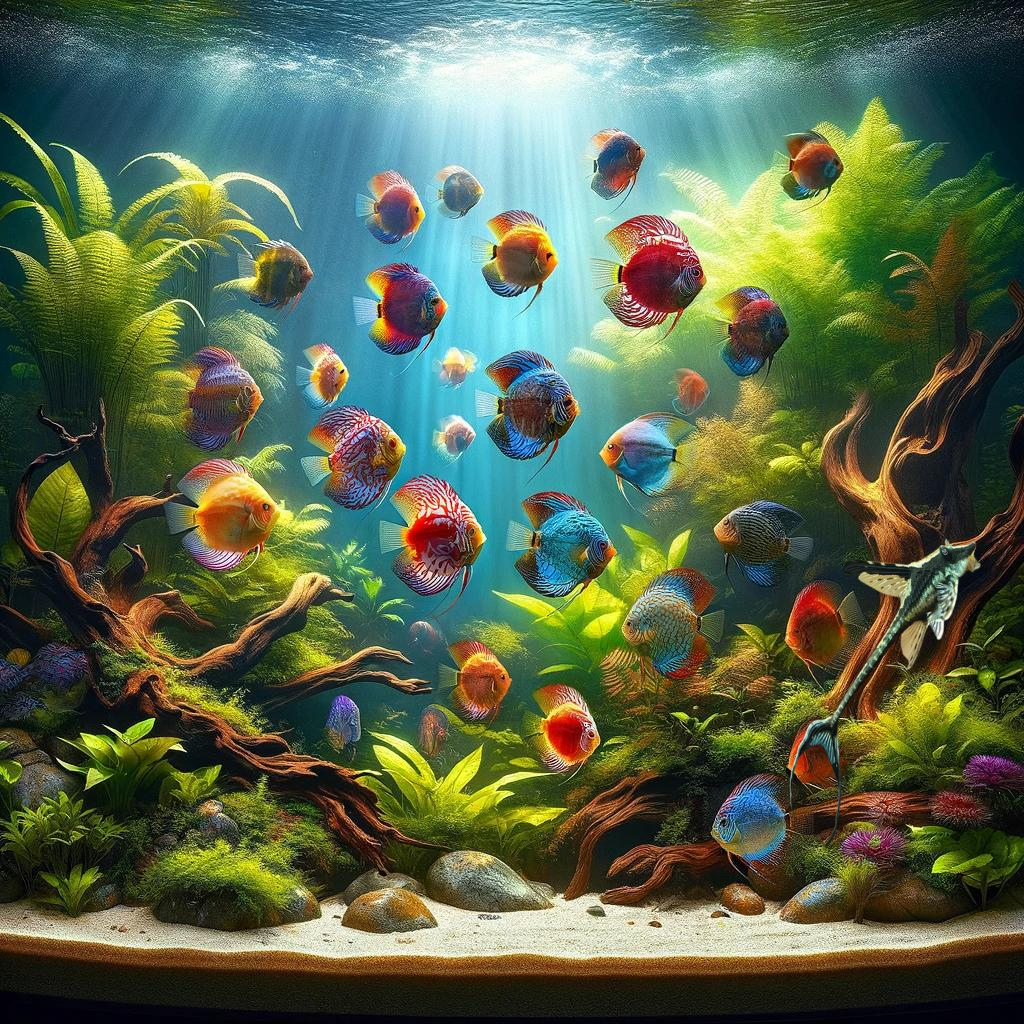
Farlowella acus, known as the Common Twig Catfish, originates from the rich aquatic ecosystems of middle and eastern Brazil, including the vast South Amazon Basin within the La Plata River basin. Growing up to 15 cm in length, these slender, elongated catfish are an excellent addition to discus fish tanks, enhancing both aesthetic appeal and ecological balance.
Habitat and Natural Range
In the wild, Farlowella acus thrives in diverse freshwater environments such as slow-moving rivers, tributaries, and flooded forests. These areas are replete with submerged vegetation and driftwood, providing perfect hiding spots and grazing surfaces for these catfish, mimicking their twig-like appearance. Their native waters are noted for their high biodiversity, offering abundant microorganisms and detritus as food sources.
Compatibility with Discus Fish
When pairing Farlowella acus with discus fish (Symphysodon spp.), it is crucial to consider their compatibility across water parameters, diet, and temperament. Both species prefer warm, soft, and slightly acidic water, similar to their natural Amazonian habitats. The inherently peaceful nature of Farlowella acus also makes them ideal tank mates for the similarly docile discus fish.
Benefits of Coexistence
Introducing Farlowella acus to a discus fish tank provides several ecological benefits:
- Algae and Biofilm Consumption: Their diet mainly consists of algae and biofilm, which helps control algae growth and maintains water quality.
- Harmonious Coexistence: The gentle and unobtrusive nature of Farlowella acus ensures they do not compete with discus fish for food or territory, promoting a peaceful tank environment.
Conclusion
Adding Farlowella acus to a discus fish tank not only boosts its visual appeal but also contributes to a healthier and more balanced aquatic environment. Their unique form, peaceful behavior, and algae-grazing habits make them invaluable companions for those looking to replicate the diverse and intricate ecosystem of the Amazon Basin in their home aquariums. Understanding the natural behaviors and needs of Farlowella acus allows aquarists to foster a flourishing community aquarium that mirrors the complexity and beauty of nature.
Ancistrus – Bristlenose Catfish
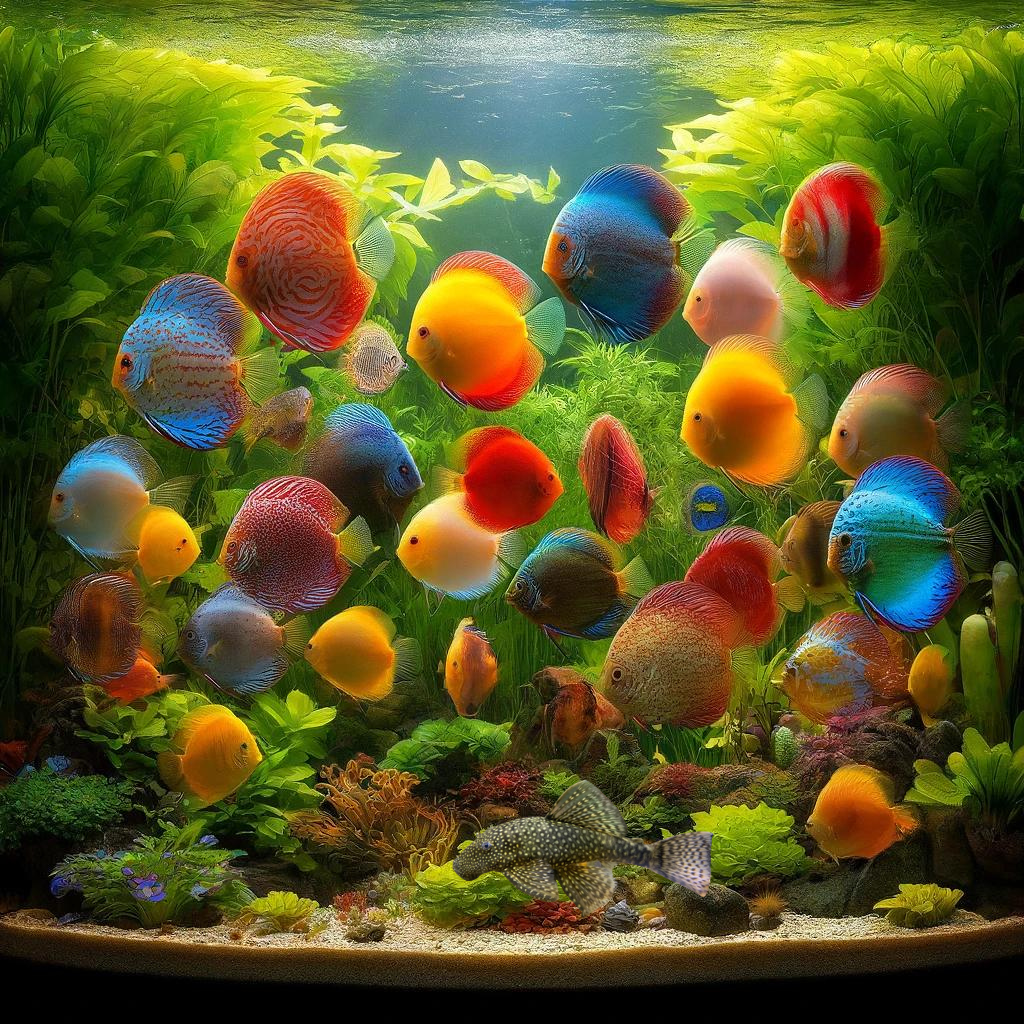
Enhanced Introduction
In the vibrant realm of freshwater aquariums, discus fish (Symphysodon) epitomize grace and beauty. To achieve a harmonious aquatic environment, selecting compatible tank mates is crucial. Among the myriad of potential companions, the Ancistrus, known commonly as the Bristlenose Catfish, stands out as an exceptional partner. This catfish enriches the aquarium landscape with its distinct characteristics and beneficial behaviours.
Overview of Ancistrus
The Ancistrus species, belonging to the Loricariidae family, thrive in the pristine waters of South America. Native to regions including Brazil, Guyana, Colombia, Paraguay, Peru, and Venezuela, these fish are adapted to environments with moderate to fast-flowing waters, lush vegetation, and ample hiding spots. Typically, Ancistrus grows to a manageable size of 8 to 20 centimetres, making them an ideal choice for various aquarium sizes.
Physical Characteristics
Ancistrus are distinguished by a robust body and unique facial features. Their most notable traits are the “antennae” or “bristles” on their faces, earning them the nickname “Bristlenose Catfish.” These bristles are not only visually striking but also serve important sensory and social functions. The colour palette of Ancistrus ranges from subdued earth tones to more striking shades, adding visual interest to any aquarium.
Behavioural Traits
In the aquarium, Ancistrus are known for their peaceful demeanour, making them compatible with the gentle discus fish. They have a strong appetite for algae and will actively clean various surfaces, which helps maintain the water quality. Ancistrus are primarily nocturnal, making them active during times when discus fish are less so, which helps balance the activity in the tank.
Compatibility with Discus Fish
Ancistrus and discus fish are well-matched due to their similar environmental needs and complementary behaviours. Both prefer warm, acidic waters akin to those of the Amazon basin, and Ancistrus contribute to the cleanliness of their shared habitat by controlling algae growth. This mutualistic relationship supports a healthy and attractive aquarium environment.
Conclusion
Integrating Ancistrus with discus fish brings both aesthetic and functional benefits to the aquarium. Understanding their specific needs and behaviours allows aquarists to create a thriving aquatic community. This partnership not only showcases the beauty of these species but also exemplifies the combined art and science of aquarium maintenance, providing a fulfilling experience for enthusiasts.
Introduction: Crafting Harmony in Aquariums with the Golden Nugget
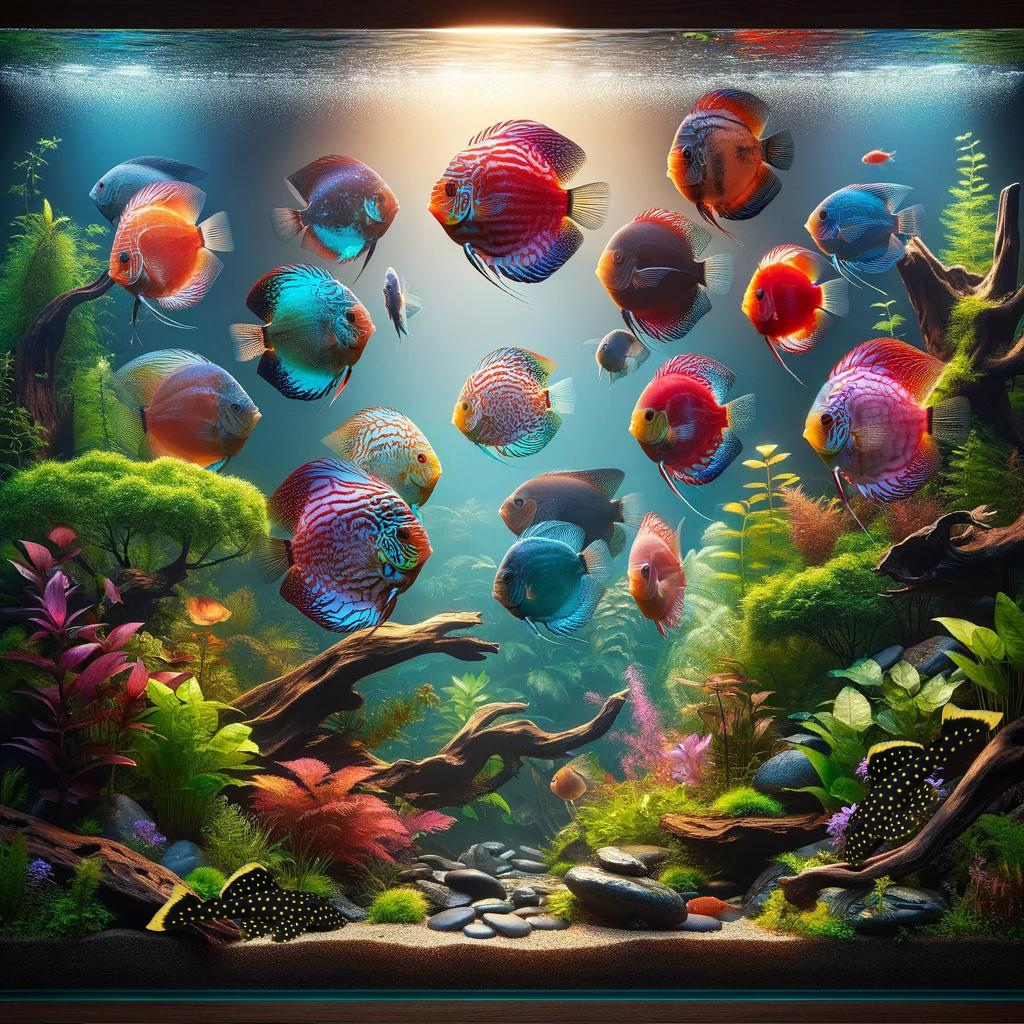
In the diverse world of ornamental aquatics, the pursuit of a visually appealing and balanced ecosystem is paramount. Among the choices for aquarium enthusiasts, the Baryancistrus sp. L 18, better known as the Golden Nugget pleco, stands out. Native to the clear waters of the Rio Xingu and Iriri in Brazil, this species offers a striking complement to the majestic Symphysodon discus, enhancing the aesthetic and ecological harmony of any aquarium.
Dimensions and Natural Habitat
- Size: 18-25 cm
- Native Locale: Rio Xingu and Iriri, Brazil
Understanding the physical size and natural environment of potential tank mates is crucial. The Golden Nugget pleco, with its manageable size of 18 to 25 centimetres, is well-suited for communal tanks. Its natural habitat, characterized by moderate currents and abundant plant life, provides valuable clues for replicating conditions that support its health and well-being in captivity.
Aesthetic Appeal and Visual Harmony
The aesthetic charm of the Golden Nugget extends beyond its size. Adorned with vibrant golden spots and a backdrop of rich blacks, it is a true work of natural art. When paired with the elegant discus fish, known for its bright colours and graceful movements, the tank transforms into a dynamic display of contrasting yet complementary beauty.
Behavioral Dynamics and Social Compatibility
The Golden Nugget pleco is known for its peaceful nature, making it an excellent companion for similarly tranquil species like the discus fish. This pleco tends to establish its territory without aggression, ensuring a serene environment where all inhabitants can thrive without undue stress or conflict.
Nutritional Considerations and Dietary Compatibility
Catering to the nutritional needs of your aquatic pets is essential for their health. Both the Golden Nugget and the Discus fish benefit from a varied diet that includes high-quality pellets, flakes, algae wafers, and occasional fresh vegetables. This shared dietary preference simplifies feeding routines and ensures all inhabitants receive the necessary nutrients to flourish.
Conclusion: A Symphony of Color and Calm
Introducing a Golden Nugget pleco to a discus fish tank is more than just adding a fish; it’s about creating a more vibrant and harmonious aquatic world. With careful consideration of each species’ needs and preferences, aquarists can establish a thriving ecosystem that highlights the beauty of both fish, providing a tranquil yet engaging spectacle for any observer. Embrace the journey of building this aquatic partnership, where each species enhances the life and beauty of the other, crafting a shared habitat that resonates with the tranquillity and allure of the natural world.
Introduction to Gelbsaumwels: The Yellow Seam Pleco
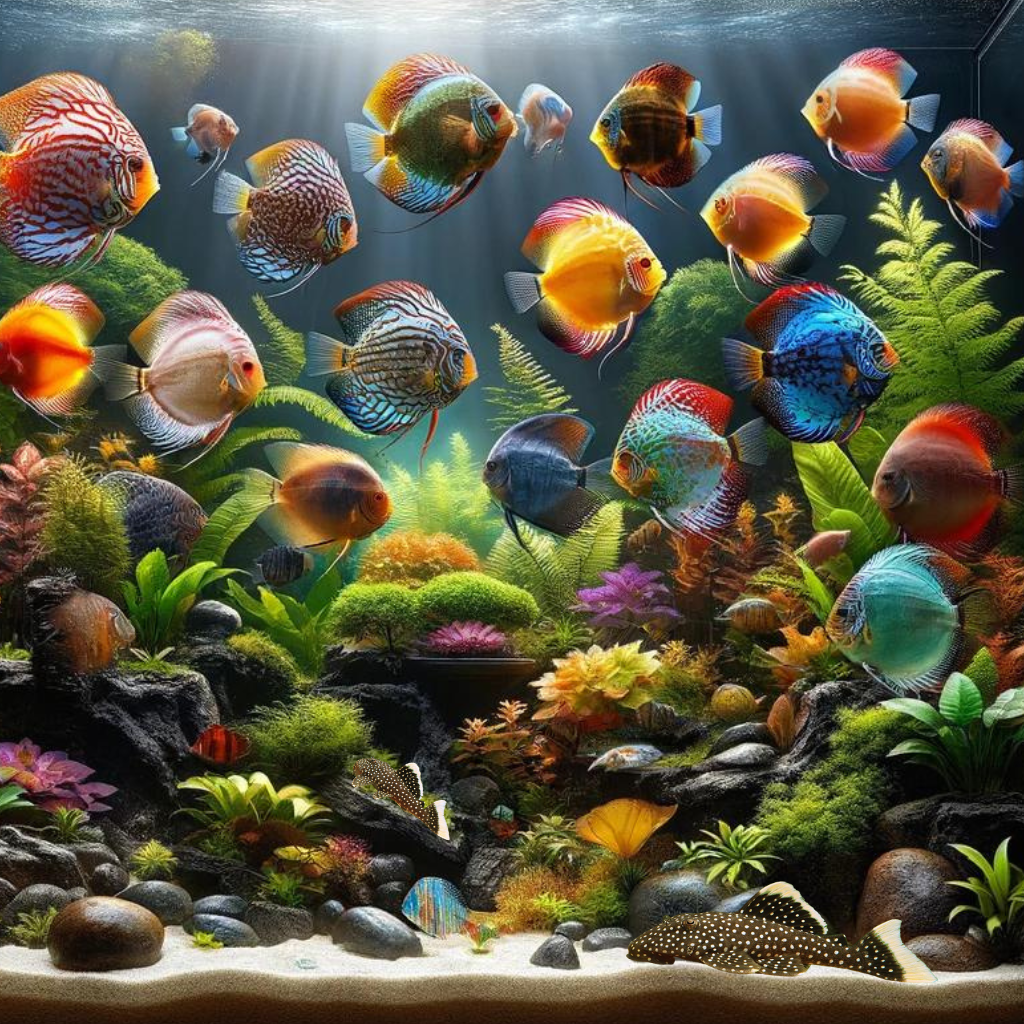
In the ornate world of aquariums, the allure of discus fish with their vibrant colours and graceful demeanours often captivates the hearts of many. However, the Baryancistrus sp. L 81, commonly known as Gelbsaumwels or Yellow Seam Pleco, brings its unique charm and characteristics, making it an intriguing subject for discussion alongside the beloved discus.
Taxonomic Classification of Yellow Seam Pleco
Gelbsaumwels, a member of the Loricariidae family, is classified within the armoured catfish category due to its distinctive bony plates and suction-cup-like mouth. The designation “sp. L 81” indicates that it is a part of the Baryancistrus genus, though it has not yet been formally described, adding an element of mystery to this species.
Physical Attributes
The Yellow Seam Pleco showcases a stunning appearance with a golden body accented by a vibrant yellow seam along its lateral line, making it a visually appealing addition to any aquarium. Typically growing between 10 to 15 centimetres in length, these fish are perfectly sized for home aquariums while boasting a body shape that is well-suited for their native fast-flowing river environments.
Natural Habitat and Behavior
Originating from the fast-moving, clear waters of the Rio Xingu and Iriri Rivers in Brazil, the Gelbsaumwels thrive in areas with dense vegetation and abundant submerged structures like rocks and driftwood. They are nocturnal creatures, hiding in crevices during the day and emerging at night to feed primarily on algae and detritus.
Aquarium Care and Maintenance
To replicate the natural conditions of the Yellow Seam Pleco, aquarium enthusiasts should maintain water temperatures between 26 to 30 degrees Celsius and a pH level from 6.5 to 7.5. The tank should include various hiding spots such as caves, PVC pipes, and pieces of driftwood to support their secretive nature and reduce stress.
Dietary Requirements
While the Gelbsaumwels are mainly herbivorous, it shows omnivorous tendencies in captivity. A balanced diet for these fish includes algae wafers, blanched vegetables, and sinking pellets, with occasional treats of protein-rich foods like bloodworms and brine shrimp to ensure they receive all necessary nutrients for health and vibrant colouration.
Conclusion
The Gelbsaumwels, with its striking yellow seam and intriguing behaviours, stand as a fascinating complement to the more widely recognized discus fish in the aquarium hobby. Understanding their taxonomy, natural habits, and care requirements allows aquarists to successfully integrate these captivating creatures into their aquatic ecosystems, adding diversity and intrigue to their fishkeeping adventures.
Discovering the Iriri Yellow Seam Pleco: A Hidden Treasure in Aquatic Biodiversity
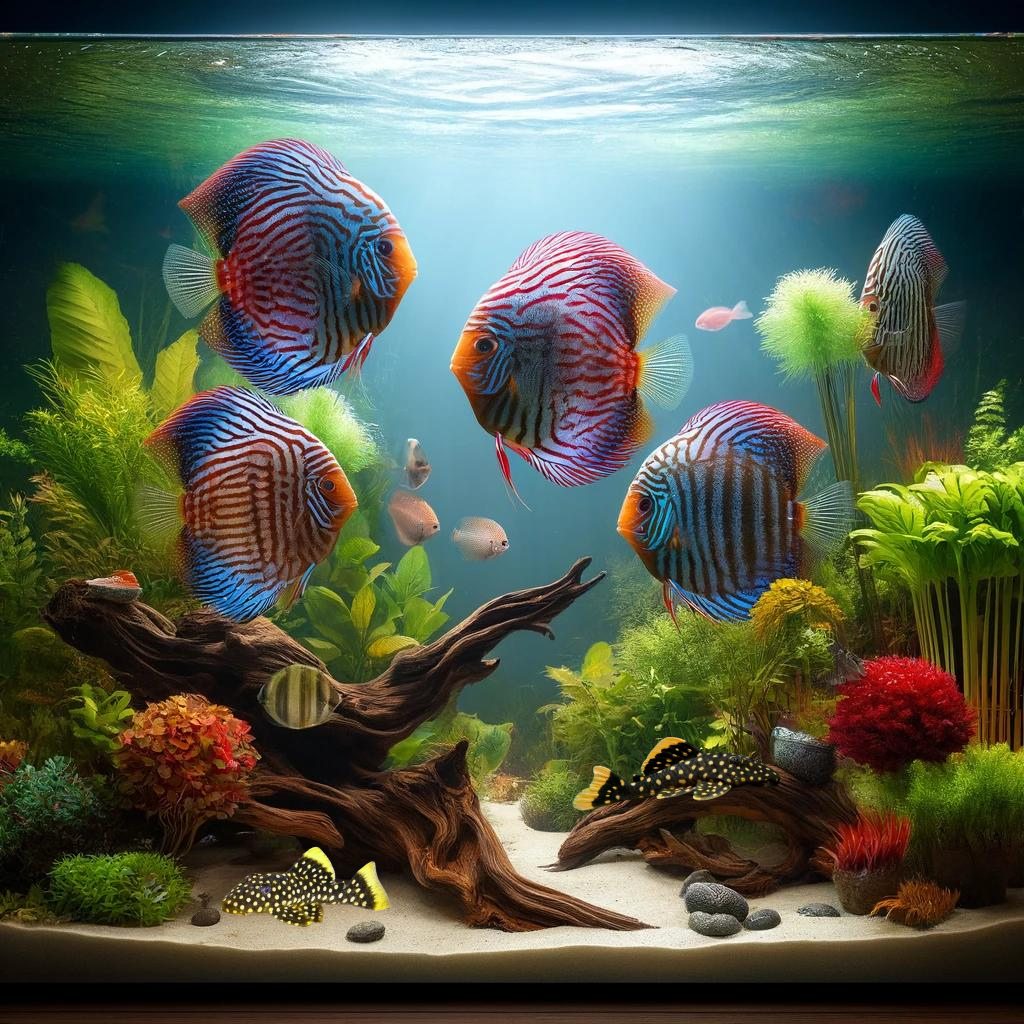
Unveiling the Dimensions
The Baryancistrus sp. L 177, commonly known as the Iriri Yellow Seam Pleco, showcases a modest size, typically ranging from 20 to 25 centimetres. Despite its smaller stature relative to other aquarium inhabitants, it stands out due to its striking appearance and unique features, making it a prized addition to any fish collection.
Exploring Its Natural Habitat
Originating from the lush, crystal-clear waters of Rio Xingu and Iriri in Brazil, the natural habitat of the Iriri Yellow Seam Pleco is as enchanting as the fish itself. These river systems are abundant with vegetation and provide a perfect backdrop for this species to flourish, reflecting the untouched beauty of their environment.
Ecological Significance and Conservation Status
While the Iriri Yellow Seam Pleco might not be as widely recognized as other aquatic species, its role in the ecosystem is significant. It contributes to the biodiversity and ecological balance of its native rivers. However, it faces threats from habitat degradation and overexploitation, highlighting the need for concerted conservation efforts to ensure its survival and the health of its ecosystem.
Conclusion: A Jewel of the Aquatic Realm
The Baryancistrus sp. L 177 – Iriri Yellow Seam Pleco is indeed a gem of freshwater aquariums. With its vibrant yellow seams and captivating presence, this species not only enhances the aesthetic appeal of an aquarium but also serves as a reminder of the rich biodiversity hidden beneath the waters of our planet. Embracing the conservation of such unique species is essential for maintaining the natural splendour and ecological integrity of their habitats.
Introduction to Corydoras: The Armor Catfish as Companions to Discus Fish
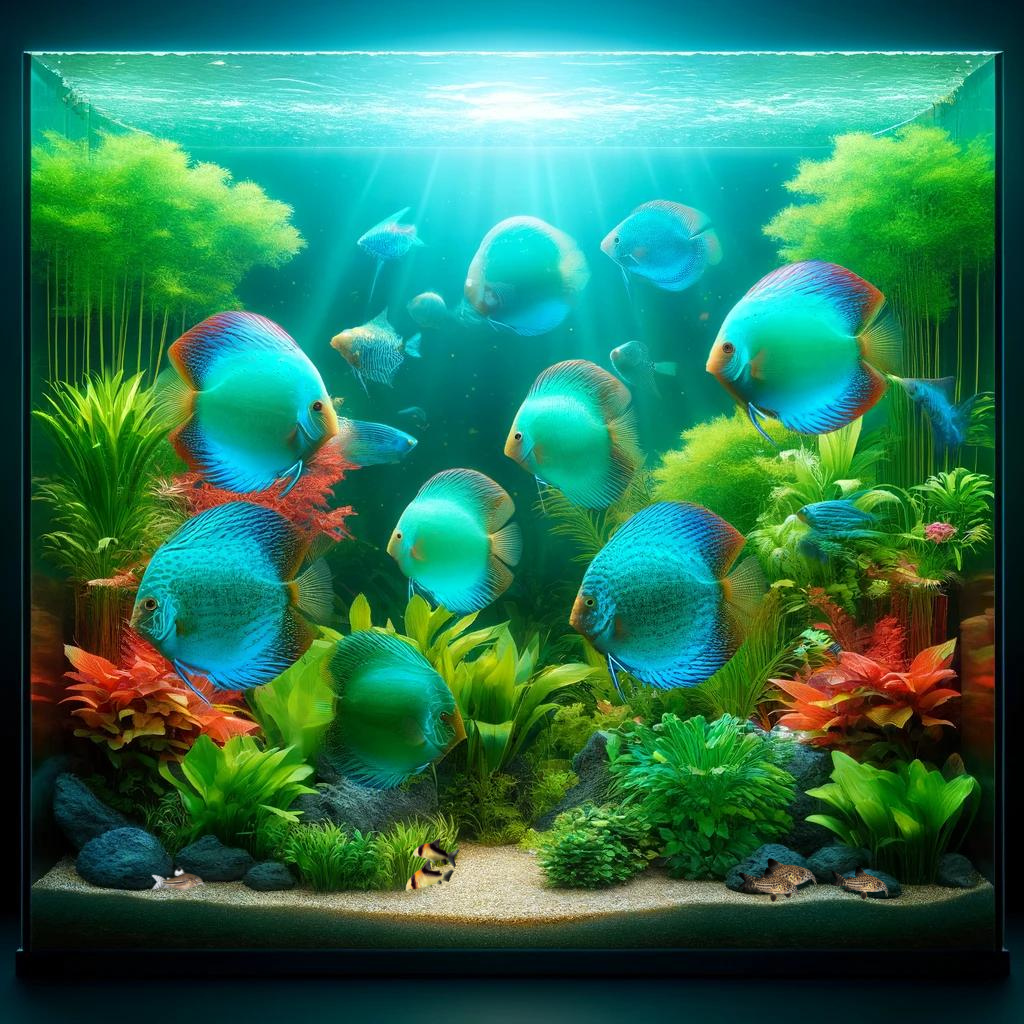
The Corydoras, commonly referred to as the Armor Catfish, belong to a diverse and intriguing genus of small, peaceful catfish native to South America. These fish are celebrated for their playful behaviour and striking appearance, making them favourites among aquarists globally. This section explores the role of Corydoras as ideal tank mates for the majestic Discus fish, providing insights into their taxonomy, natural habitats, and compatibility within the aquatic environment.
Taxonomy and Distribution of Corydoras
The genus Corydoras comprises numerous species, each characterized by unique morphological features and distinct geographic distributions. Here are some prominent Corydoras species along with their sizes and natural habitats:
- Corydoras adolfi: Found in the Rio Negro Uaupés region of Brazil.
- Corydoras aeneus: Indigenous to Venezuela, Trinidad, and extending to the La Plata basin.
- Corydoras agassizii: Native to Peru, specifically the Iquitos region.
- Corydoras barbatus: Inhabits rivers from Rio to Sao Paulo in Brazil.
- Corydoras bolivianus: Thrives in the Rio Mamoré waters of Bolivia.
- Corydoras burgessi: Found in the Amazonian waters of Brazil.
- Corydoras concolor: Resides in Western Venezuela.
- Corydoras duplicareus: Populates the upper Rio Negro in Brazil.
- Corydoras haraldschultzi: Indigenous to the upper Rio Guapore in central Brazil.
- Corydoras hastatus: Inhabits the Amazon near Villa Bella and the Rio Guaporé in Brazil.
- Corydoras Julii: Native to Brazil, specifically the lower Amazon.
- Corydoras melanistus: Occurs in Guayana (Essequibo) and possibly the Orinoco regions.
- Corydoras napoensis: Found in Ecuador and Peru.
- Corydoras natteri: Thrives in eastern Brazil.
- Corydoras paleatus: Indigenous to southeastern Brazil, particularly the La Plata basin.
- Corydoras panda: Inhabits the Ucayali system in Peru.
- Corydoras pygmäus: Populates the tributaries of the Rio Madeira in Brazil.
- Corydoras rabauti: Native to Peru and Brazil.
- Corydoras sterbai: Resides in the upper Rio Guaporé region of Brazil.
Role as Companions to Discus Fish
In the aquarium community, Corydoras and Discus fish are known to form a harmonious pairing. The gentle nature of Corydoras complements the tranquil demeanour of Discus fish, creating a peaceful environment conducive to the well-being of both species. Corydoras are particularly valued for their bottom-dwelling habits, where they diligently scavenge for food remnants and detritus, significantly aiding in maintaining optimal water quality within the tank.
Conclusion
Incorporating Corydoras into an aquarium with Discus fish not only enhances the visual appeal but also contributes positively to the ecological balance and overall health of the tank’s inhabitants. With their endearing behaviour and beneficial roles, Corydoras exemplify the essence of symbiotic relationships within the aquatic community, further promoting the joys and rewards of ornamental fishkeeping.
Introduction: The Allure of Ornamental Fishkeeping
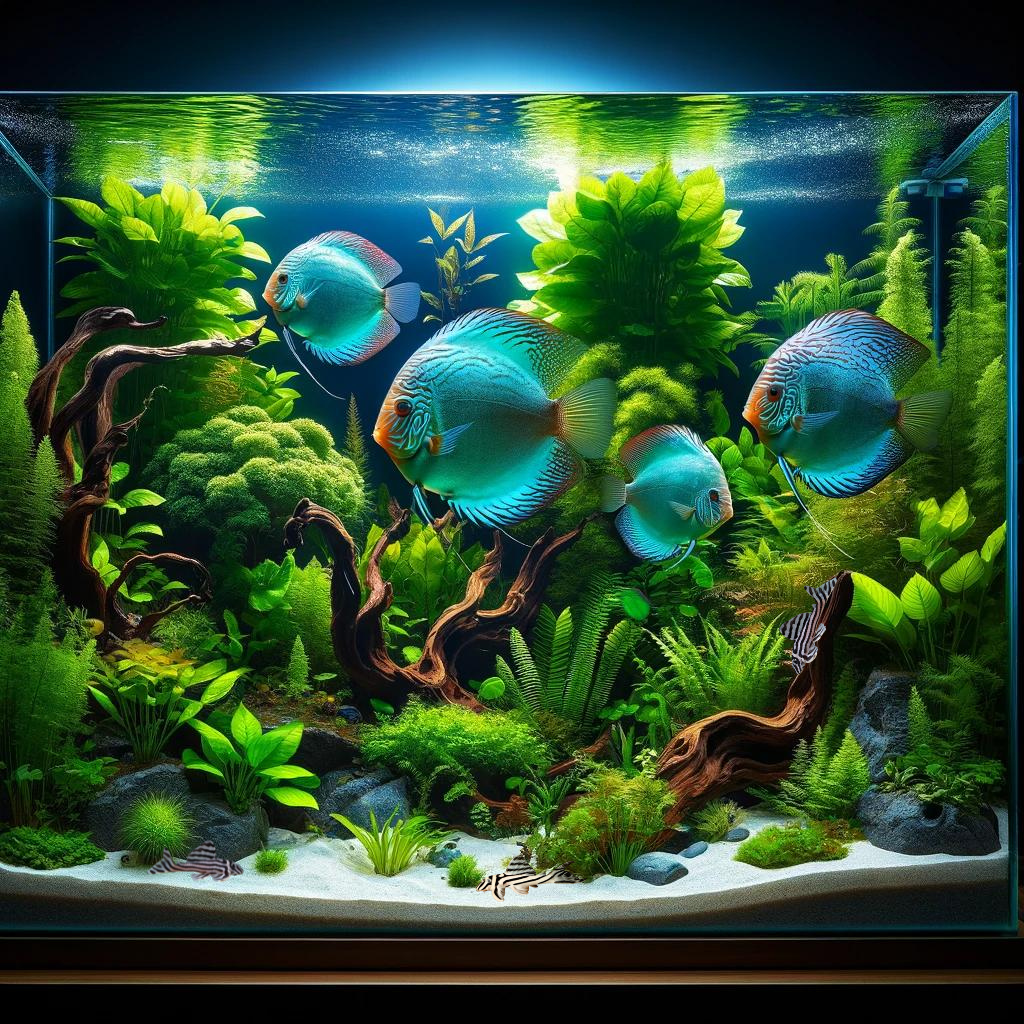
Ornamental fishkeeping is a world filled with vibrant colours and fascinating behaviours, where the illustrious discus fish (Symphysodon spp.) holds a place of honour. Known for their brilliant hues and elegant swimming, discus fish are a favourite among aquarists. Yet, there is another captivating species that also demands attention for its unique beauty and distinct characteristics—the Zebra Pleco (Hypancistrus zebra L46).
Exploring the Zebra Pleco (Hypancistrus zebra L46)
Native to the Rio Xingu in Brazil, the Zebra Pleco boasts a dramatic appearance with bold, dark stripes over a pale body, creating a stark contrast to the softer, rounded discus. Despite its smaller size, typically 8 to 12 centimetres, the Zebra Pleco captures the eye with its striking pattern and streamlined shape.
Physical Characteristics
The Zebra Pleco’s appeal isn’t just in its colouration but also in its body structure. Unlike the broad, disc-shaped body of the discus, the Zebra Pleco has a more elongated form, adapted for squeezing through the tight rocky crevices of its native habitat. Its stripes provide camouflage and deter predators, playing a crucial role in its survival strategy.
Habitat and Natural Environment
While the discus thrives in the still waters of the Amazon Basin, the Zebra Pleco prefers the faster currents and rocky landscapes of the Rio Xingu. This environment challenges the Zebra Pleco to find food and shelter among the crevices and submerged caves, contrasting sharply with the discus’s preference for open, plant-filled spaces.
Interactions with Discus Fish
In a shared aquarium, discus fish and Zebra Plecos can coexist peacefully. The discus occupies the higher strata of the tank, while the Zebra Plecos stick to the bottom, scavenging for food. This separation helps avoid conflicts over territory or resources, ensuring a harmonious environment.
Conclusion: Celebrating Diversity in Aquariums
The ornamental fishkeeping hobby is rich with opportunities to explore and appreciate the diverse forms of aquatic life. The majestic discus and the captivating Zebra Pleco each bring their unique beauty and charm to the aquarium, illustrating the vast array of shapes, sizes, and colours found under the water’s surface. By understanding and catering to the specific needs of these different species, aquarists can create stunning, balanced ecosystems that highlight the incredible diversity of our planet’s aquatic environments.
Introduction to Otocinclus Affinis: A Delightful Aquatic Companion
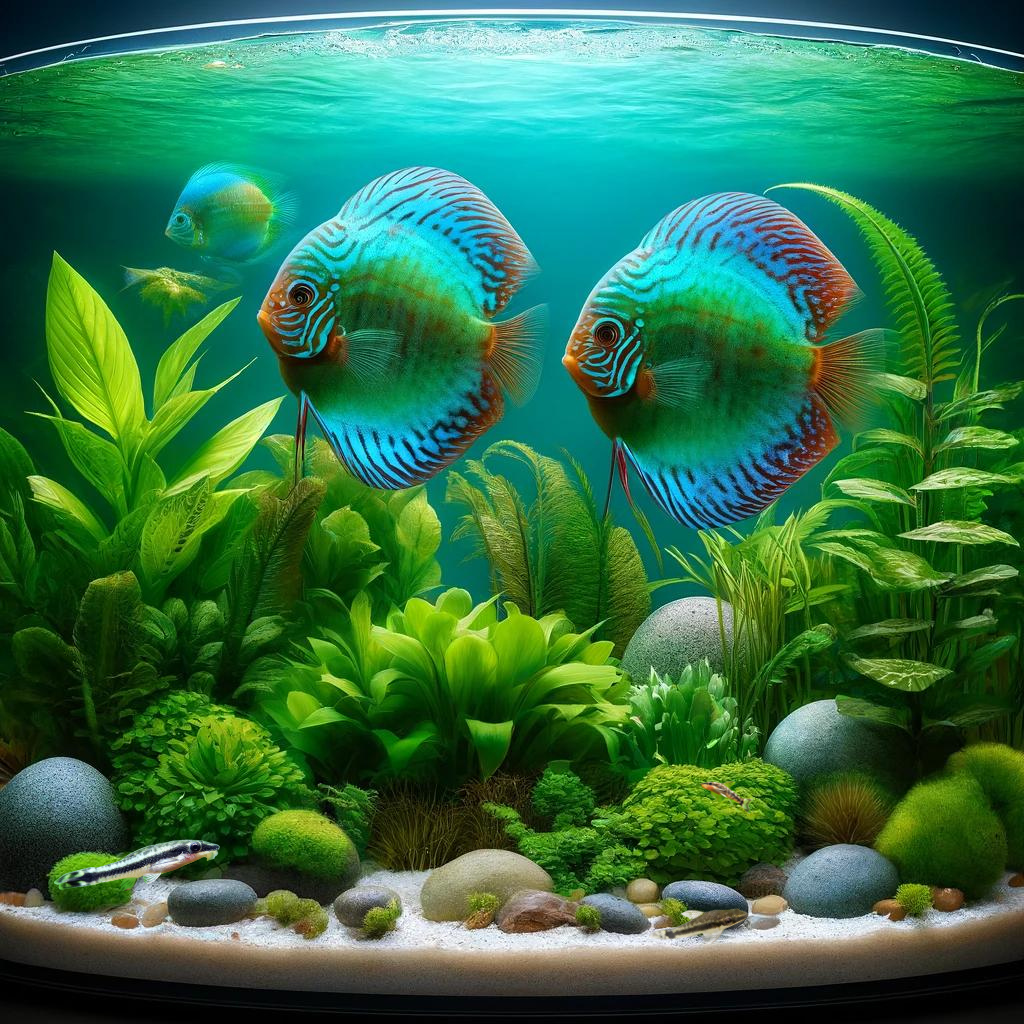
In the diverse and intricate world of aquarium hobbyists, the Otocinclus affinis, often referred to as the Striped Otocinclus or Otocinclus Catfish, stands out as a particularly enchanting species. Originating from the lush surroundings of Rio de Janeiro in Southeast Brazil, this small fish captivates with its subtle charm and peaceful demeanour, making it a beloved addition to many freshwater aquariums.
Physical Characteristics
The Otocinclus affinis is noted for its modest size, typically remaining under 7 centimetres in length. Despite its small stature, it boasts an intricate pattern of subtle stripes that traverse its sleek body. These markings, reminiscent of delicate brushstrokes, enhance the fish’s visual appeal and blend seamlessly with the tranquil ambience of an aquarium setting.
Habitat and Natural Environment
Native to the slow-moving, densely vegetated freshwater habitats around Rio de Janeiro, the Otocinclus affinis thrives in environments where it can harmoniously coexist with a diverse range of aquatic life. This setting is a testament to the complex interdependencies that characterize these ecosystems.
Behavioural Insights
The Otocinclus affinis displays a remarkably social nature despite its small size. It is commonly found in small groups, where it engages in various communal activities such as grazing on algae-covered surfaces and participating in subtle social interactions that reveal a hierarchical structure within the group.
Ecological Importance
The Otocinclus affinis is more than just an attractive aquarium inhabitant; it plays a crucial role in the ecological health of its native environments. As an efficient algae grazer, it helps control algae growth, maintaining the cleanliness and balance of the aquatic ecosystems it inhabits.
Conclusion: A Harmonious Addition to Any Aquarium
For aquarium enthusiasts, the Otocinclus affinis is a prized species that not only complements the grandeur of larger fish like the Discus but also contributes to a balanced and healthy aquatic environment. Its modest size, intricate colouration, and sociable nature make it an ideal choice for fostering harmony within the aquatic community. Together with other species such as the Discus fish, the Otocinclus affinis underscores the beauty and complexity of the aquatic world, captivating hobbyists with its enduring allure and ecological significance.
Exploring the Enigmatic Peckoltia Pulchra: A Jewel of the Freshwater World
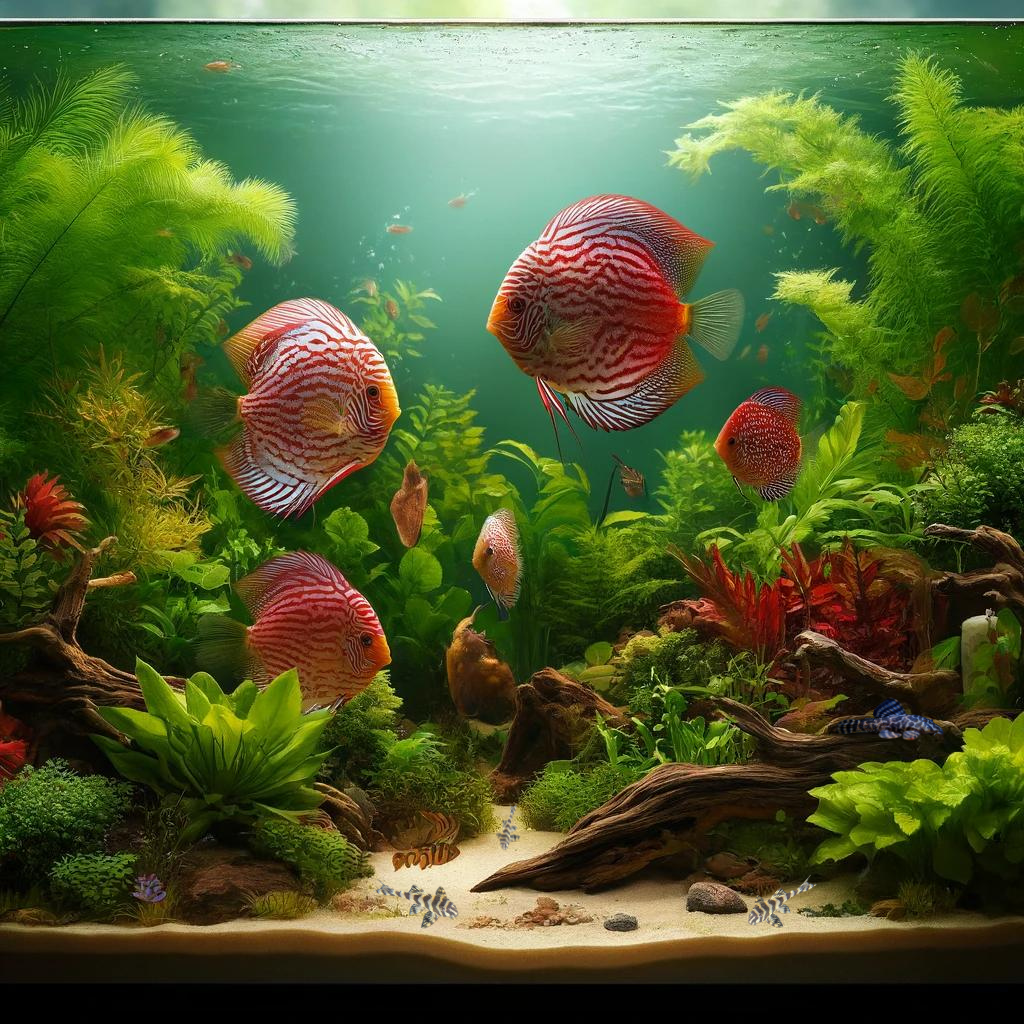
The freshwater realms boast an incredible diversity of life, and among this rich tapestry, the Peckoltia Pulchra, commonly known as the Banded Dwarf Pleco, shines as a particularly fascinating species. This segment explores the physical attributes, natural habitat, and ecological significance of this captivating creature within the aquarium community and its native ecosystem.
I. Introduction to Peckoltia Pulchra
Belonging to the Loricariidae family, the Peckoltia Pulchra stands out for its small size and visually striking appearance. It is highly valued in the aquarium trade not only for its beauty but also for its role in maintaining cleanliness by consuming algae.
II. Physical Characteristics
- Size: Typically, the Banded Dwarf Pleco reaches up to 6 centimetres, making it a manageable size for aquariums.
- Colouration and Markings: Its body is adorned with alternating bands of dusky browns and rich ochres, which not only contribute to its aesthetic appeal but also provide camouflage against the rocky riverbeds of its home.
III. Natural Habitat
- Geographical Range: This species is native to the Rio Negro basin in Brazil, a region known for its dark waters enriched with tannins.
- Ecological Niche: The Banded Dwarf Pleco thrives in environments with abundant rocky substrates and submerged vegetation. It plays a vital role in its habitat by feeding on detritus and algae, helping maintain the ecological balance.
IV. Conservation Status and Considerations
While popular among aquarists, the Peckoltia Pulchra faces threats from habitat destruction, overfishing, and competition from invasive species. These challenges underscore the need for conservation efforts to ensure the survival of this species and its habitat.
V. Conclusion
The Peckoltia Pulchra exemplifies the beauty and complexity of aquatic life. Its role in the ecosystem and the aquarium trade highlights the interconnectedness of nature and human activity. By valuing and protecting such species, we contribute to the health of our planet and preserve its biodiversity for future generations.
In showcasing the Peckoltia Pulchra, we are reminded of the delicate balance of nature and the responsibility we share in preserving these natural wonders.
Introduction to the Enigmatic Peckoltia sp. vittata L 134 and the Regal Discus Fish

In the vibrant world of aquarists, the allure of ornamental fish captivates enthusiasts far and wide. Among these, the symphysodon discus, or discus fish, is celebrated for its striking colours and graceful movements. Yet, in the diverse ecosystem of the aquarium, another species, the Peckoltia sp. vittata L 134—commonly known as the Zierbinden-Zwergschilderwels—holds its own with unique charm and beauty.
Taxonomy and Nomenclature
Belonging to the Loricariidae family, the Peckoltia sp. vittata L 134 is a noteworthy member of the freshwater catfish community. Its name, derived from the Latin vittata meaning “striped,” highlights the distinctive markings that decorate its body, making it a standout species in its family.
Physical Attributes
Though smaller in stature than the discus, typically measuring 10-15 centimetres, the Zierbinden-Zwergschilderwels does not fall short in visual appeal. It thrives in the Amazon basin’s Rio Xingu, Rio Madeira, and Rio Tapajos rivers, where its striking stripes harmonize with the rich underwater flora.
Behavioural Ecology
This species shares its preference for soft, acidic waters with the discus fish, reflecting their mutual Amazonian origins. Its diet is omnivorous, encompassing algae, detritus, and small invertebrates, showcasing its versatility within its ecological niche.
Comparative Analysis
While the discus fish is known for its vivid colouration and elegant swimming, the Zierbinden-Zwergschilderwels offers a subtle elegance with its intricate striping pattern. This fish may not command the immediate attention that a discus does, but it captivates with a quiet, sophisticated charm that adds a different dimension to the aquarium experience.
Conclusion
The Peckoltia sp. vittata L 134 exemplifies the rich diversity of the aquatic world, serving as a fascinating counterpart to the more visually striking discus fish. For aquarists, it presents an opportunity to delve deeper into the variety of species that populate our waters, highlighting the importance of preserving these diverse ecosystems. By fostering an appreciation for both the bold and the understated, the aquaristics community continues to celebrate the intricate beauty of life beneath the water’s surface.
Introduction: The Enigmatic World of Rineloricaria
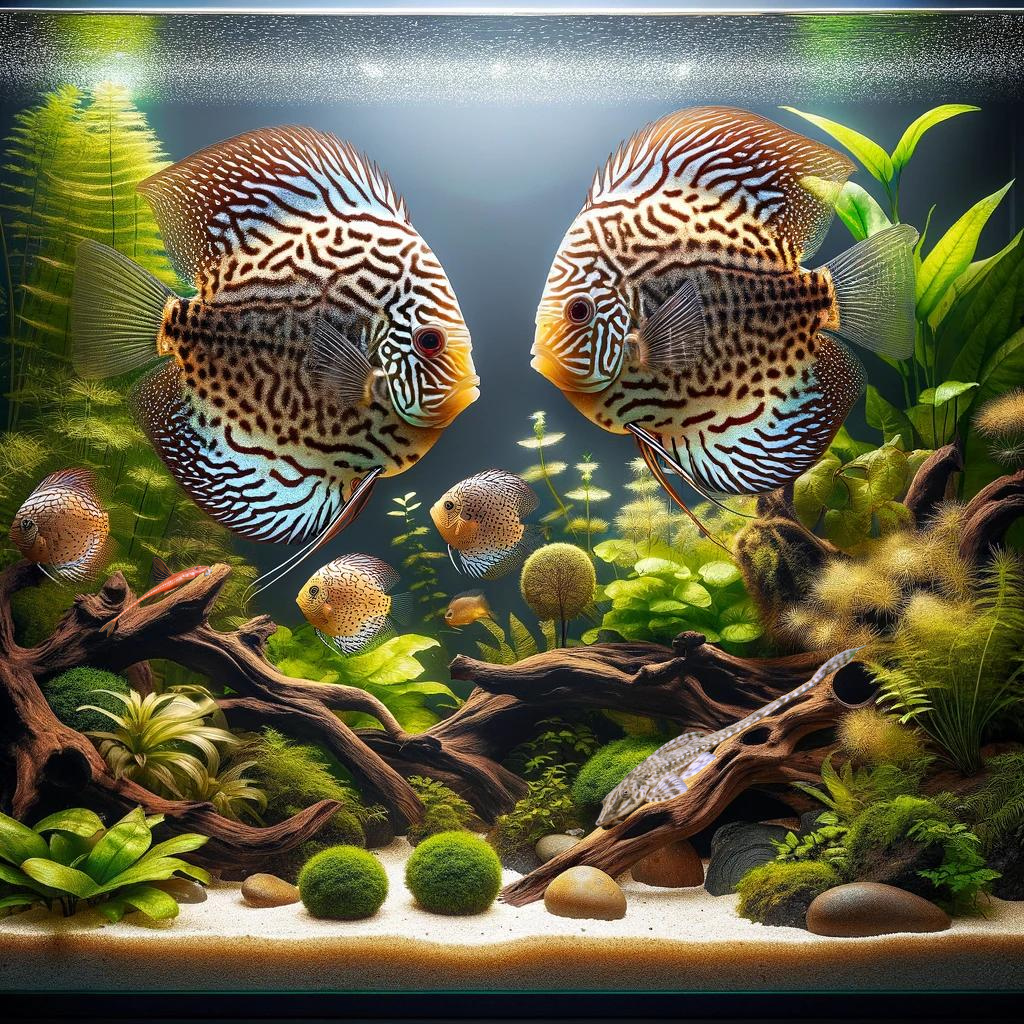
In the expansive realm of aquatic species, while the splendid discus fish often captures the limelight, another group of fascinating creatures, the Rineloricaria, known in German as “Hexenwelse” or witch catfish, offers an equally captivating narrative. This introduction explores the unique world of Rineloricaria, highlighting its distinct characteristics, ecological significance, and the intrigue it holds within the German-speaking aquarist community.
Size Specifications: The Stature of Witch Catfish
Rineloricaria species vary in length from 10 to 25 centimetres, standing out not just for their size but for the pivotal roles they assume in their ecosystems. These fish are not merely inhabitants of their habitats but are key players in maintaining ecological balance.
Distribution and Habitat: A Journey Through Diverse Waters
Rineloricaria species are adept at navigating a variety of environmental conditions, from the verdant Amazon to the calm streams of Rio Paraguay. Each species adapts uniquely to its environment, demonstrating remarkable resilience and versatility:
- Rineloricaria lanceolata: Found in the lush regions of Amazonas, Xerebros, and Canelos in Ecuador, this species is a testament to adaptability in dynamic ecosystems.
- Rineloricaria microlep.: Inhabiting the tranquil waters of Rio Grande do Sul in Brazil, this variant exemplifies peaceful coexistence with its terrestrial surroundings.
- Rineloricaria parva: Spanning the waters of Paraguay to La Plata, this species highlights the interconnected nature of aquatic ecosystems across different regions.
- Rineloricaria sp. “Rot” (Red): This striking red variant from Brazil’s Rio Tocantins dazzles with its vivid colouration, showcasing the rich biodiversity of the aquatic world.
Conclusion: Appreciating the Mystique of Rineloricaria
Rineloricaria transcends cultural and linguistic barriers, enchanting aquarists worldwide with its beauty and ecological importance. By delving into its dimensions, distribution, and habitats, we gain a fuller understanding of the complex life beneath the water’s surface. As we continue to explore and learn, these witch catfish teach us about the delicate interplays within aquatic ecosystems, urging us to appreciate and preserve the natural world’s intricate beauty.
Botia macracanthus – Prachtschmerle: A Fascinating Companion to Discus Fish
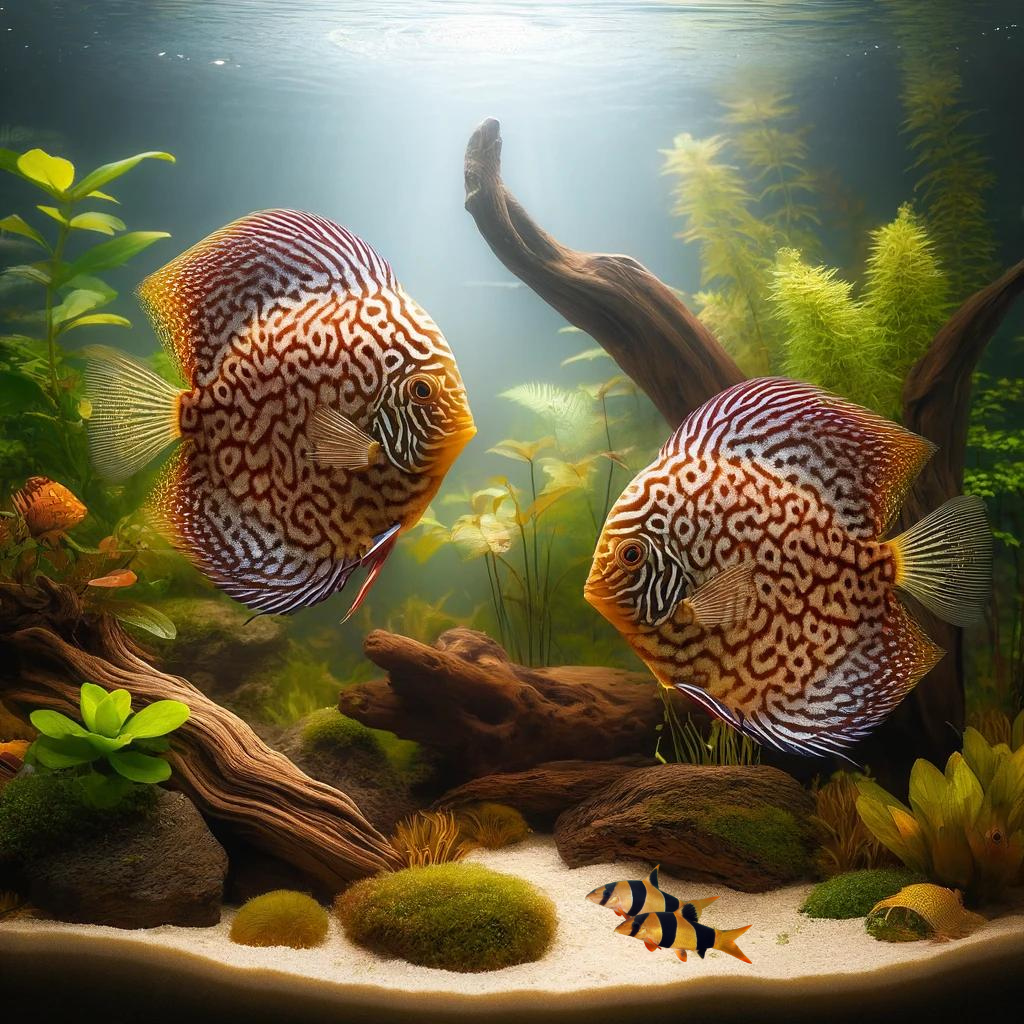
Introduction: A New Companion for the Discus Aquarium
In the world of freshwater aquarium enthusiasts, the passion for ornamental fish often extends beyond the majestic discus fish to include a variety of species that enhance and complement the aquatic environment. Among these, the Botia macracanthus, commonly known as Clown Loach, stands out as an engaging companion. Native to the lush environments of Sumatra and Borneo, this species is celebrated for its unique appearance and behaviours, making it a fascinating addition to the discus tank.
Size Considerations for Harmonious Cohabitation
One crucial factor in selecting tank companions is ensuring size compatibility. The Clown Loach typically grows to about 30 cm, making it well-suited for living alongside discus fish. Its moderate size allows it to integrate smoothly into the discus habitat without overwhelming the space or competing aggressively with discus fish for territory.
Replicating the Natural Habitat
Understanding the natural environment of the Botia macracanthus is vital for maintaining their health and wellness in captivity. Originating from the rivers of Sumatra and Borneo, these fish thrive in settings that mimic their riverine homes, complete with slow-moving waters and abundant vegetation. Aquariums aiming to house Clown Loaches should strive to replicate these conditions to provide a stress-free environment conducive to their health.
Behavioral Dynamics and Social Interaction
Clown Loaches are known for their social and active behaviour. They typically form close-knit groups and can often be seen engaging with each other within the aquarium. This gregarious nature not only adds a dynamic aspect to the tank but also helps in creating a balanced community, where stress is minimized, and natural behaviours are encouraged.
Diverse Dietary Needs
The dietary habits of Clown Loaches should be carefully managed to ensure their longevity and vitality. As omnivorous scavengers, they enjoy a varied diet that includes everything from small invertebrates and plant matter to specialized aquarium foods. A diet rich in quality pellets, supplemented with fresh and frozen treats, can help maintain their health and vibrant colours.
Conclusion: Creating a Thriving Community
The inclusion of Botia macracanthus, with its striking appearance and engaging behaviours, can significantly enhance the biological and aesthetic diversity of a discus fish aquarium. By paying close attention to size compatibility, habitat needs, and dietary requirements, aquarium enthusiasts can create a vibrant and healthy ecosystem that supports a diverse range of freshwater species.
The Enigmatic Beauty of the Marbled Hatchetfish
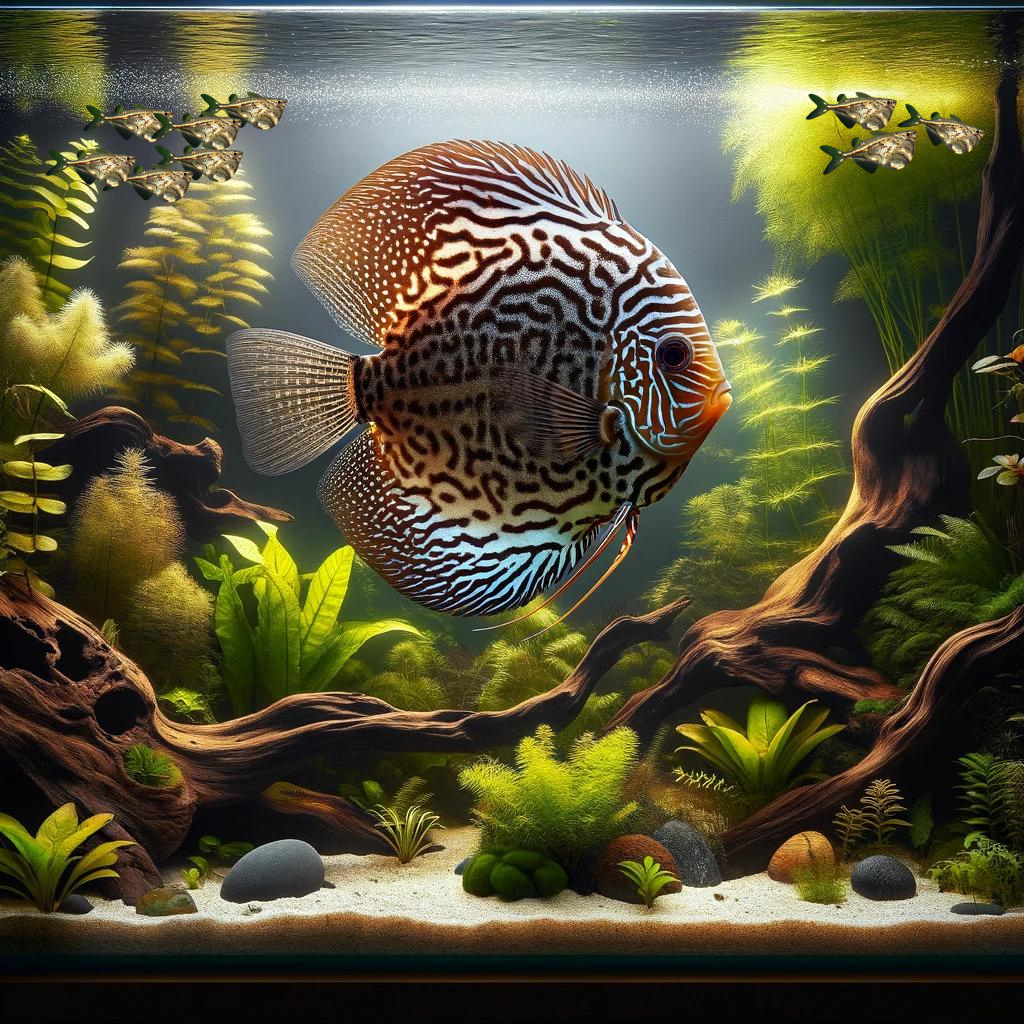
Amidst the world of aquatic wonders dominated by grand species like the discus fish, the Marbled Hatchetfish (Carnegiella strigata and fasciata) stands out with its subtle charm and intriguing adaptations. This section explores the beauty, habitat, and ecological niche of this lesser-known yet captivating fish.
Dimensions and Habitat: A Closer Look
- Size: 4 cm
- Habitat: Guayana
The Marbled Hatchetfish, although small in size at just 4 centimetres, captivates with its striking appearance and graceful movements. Originating from the verdant waterways of Guayana, this species thrives in the lush, tropical ecosystems that provide abundant resources and shelter from the complexities of the natural world.
Ethereal Elegance: The Aesthetics of Survival
The beauty of the Marbled Hatchetfish is not merely skin-deep; it reflects an evolutionary mastery of camouflage and survival. Its body, adorned with marbled patterns, mirrors the mottled sunlight filtering through the water’s surface, making it less visible to predators.
- Appearance: The fish’s body is equipped with a unique adaptation: enlarged pectoral fins that resemble the shape of a hatchet, which not only aid in swift, agile swimming but also in skimming the water’s surface for food.
- Colouration: The intricate, marbled pattern on its body helps it blend seamlessly with the water’s reflective surface, enhancing its survival by masking its presence from both predators and prey.
Adaptation and Survival Strategies
In the serene but treacherous waters of Guayana, the Marbled Hatchetfish exemplifies perfect adaptation. It utilizes its hatchet-shaped fins for both rapid movement and subtle navigation through the densely vegetated waterways, dodging predators and capturing prey.
- Diet: Primarily insectivorous, it often leaps out of the water to catch insects hovering above the surface, showcasing an impressive display of aerial feeding.
- Behaviour: The Marbled Hatchetfish prefers to dwell near the water’s surface where it can easily access food sources, utilizing both the aquatic and slightly aerial zones to its advantage.
Conclusion: A Marvel of Nature
The Marbled Hatchetfish, while modest in size, offers a profound lesson in the beauty and complexity of aquatic life. It serves as a reminder of the diverse strategies employed by different species to thrive in their respective environments. In the vast pantheon of aquatic creatures, the Marbled Hatchetfish is a testament to the delicate balance of nature in the lush waterways of Guayana, offering a unique perspective on survival and beauty in the animal kingdom.
Exploring the Roles of Ringelhandgarnelen, Amanogarnelen, and Zebragarnelen in the Aquarium Ecosystem
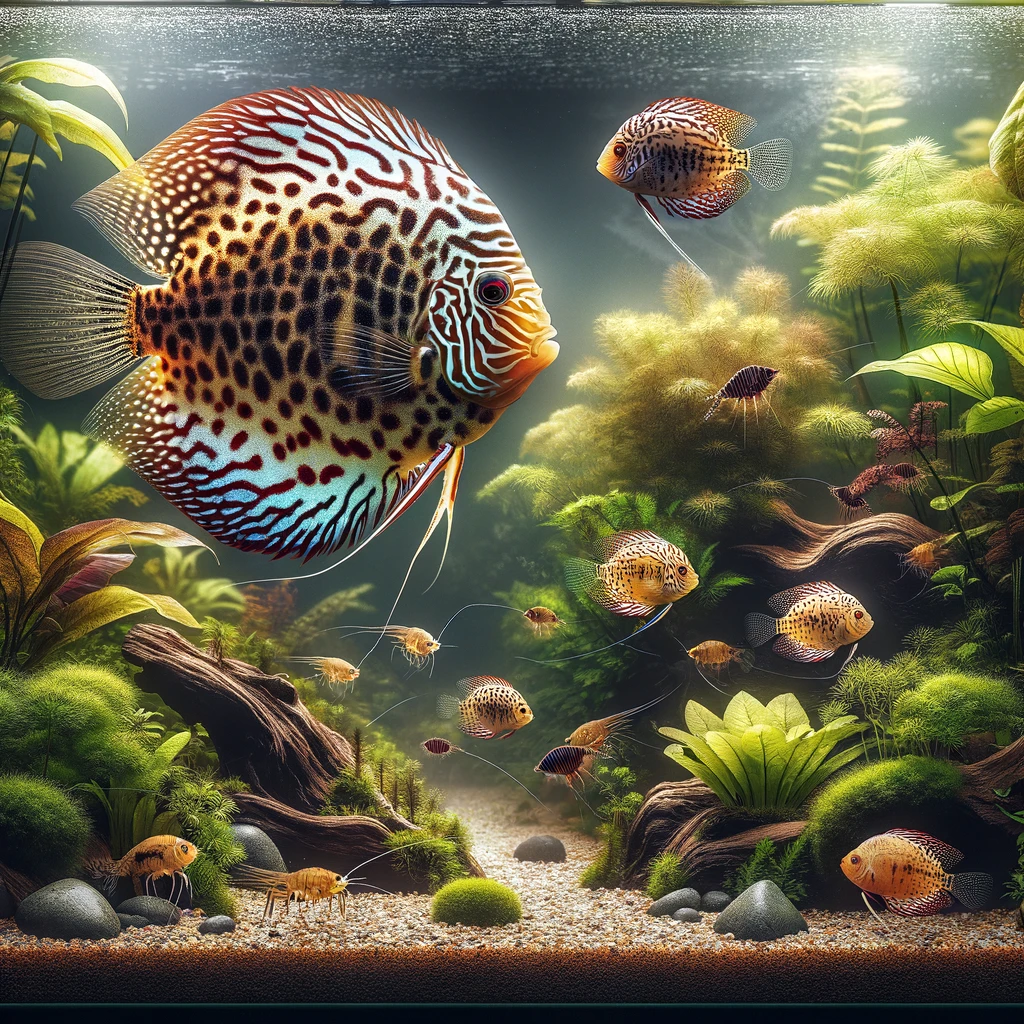
The world of aquarists is enriched not only by the grandeur of larger aquatic species like the Symphysodon discus but also by the presence of smaller, yet vitally important inhabitants such as the Ringelhandgarnelen, Amanogarnelen, and Zebragarnelen. These shrimp species each bring unique attributes and functionalities that enhance both the beauty and the ecological balance of aquariums.
Ringelhandgarnelen: Elegant Algae Managers
Origins and Taxonomy
Ringelhandgarnelen, also known as ringed hand shrimp, belong to the genus Caridina. Native to Southeast Asia’s freshwater habitats, these shrimp are celebrated for their ornamental beauty and adaptability to various aquatic environments. They come in a range of subspecies, each with distinct colour patterns that add visual interest to their tanks.
Ecological Role and Behavior
In aquarium settings, Ringelhandgarnelen are prized for their effective algae management. They consume algae, helping control its growth and contributing to the cleanliness and clarity of the water. Their scavenging habits also reduce detritus and help maintain a healthier environment for tank mates like the delicate discus fish.
Amanogarnelen: Custodians of Water Clarity
Taxonomic Classification and Habitat
The Amanogarnelen, or Caridina multidentata, originate from Japan’s freshwater streams. Known for their hardiness and ecological versatility, these shrimp play a crucial role in maintaining the biological balance of their aquatic surroundings. Their bodies are translucent and decorated with fine patterns, making them subtly beautiful additions to any aquarium.
Ecological Contributions
Amanogarnelen is integral to sustaining high water quality. They feed on detritus and decaying matter, minimizing the accumulation of waste and harmful substances. Their appetite for algae also prevents unsightly build-ups, preserving the aesthetic appeal of the aquarium.
Zebragarnelen: Striped Symbols of Harmony
Taxonomic Classification and Origins
Zebragarnelen, or Caridina cf. cantonensis, are known for their striking zebra-like stripes. They hail from Southeast Asia and are favoured in aquascaping for both their beauty and their functionality. The contrast of their striped bodies against lush greenery or dark substrates makes them visually captivating.
Role in the Aquarium
Zebragarnelen thrive under a variety of conditions, making them resilient and versatile aquarium residents. Their omnivorous diet helps keep the tank clean by breaking down detritus and algae. They contribute to the overall health and stability of the aquatic ecosystem, ensuring a balanced environment for all inhabitants.
Conclusion
The integration of Ringelhandgarnelen, Amanogarnelen, and Zebragarnelen into an aquarium does more than just enhance its visual appeal. These shrimp are vital for maintaining ecological balance, controlling algae, and cleaning up waste. They exemplify the symbiosis between beauty and functionality, making them indispensable for both novice and experienced aquarists aiming to create a thriving aquatic world.
Introduction to the Hemigrammus Bleheri: A Jewel of the Amazon
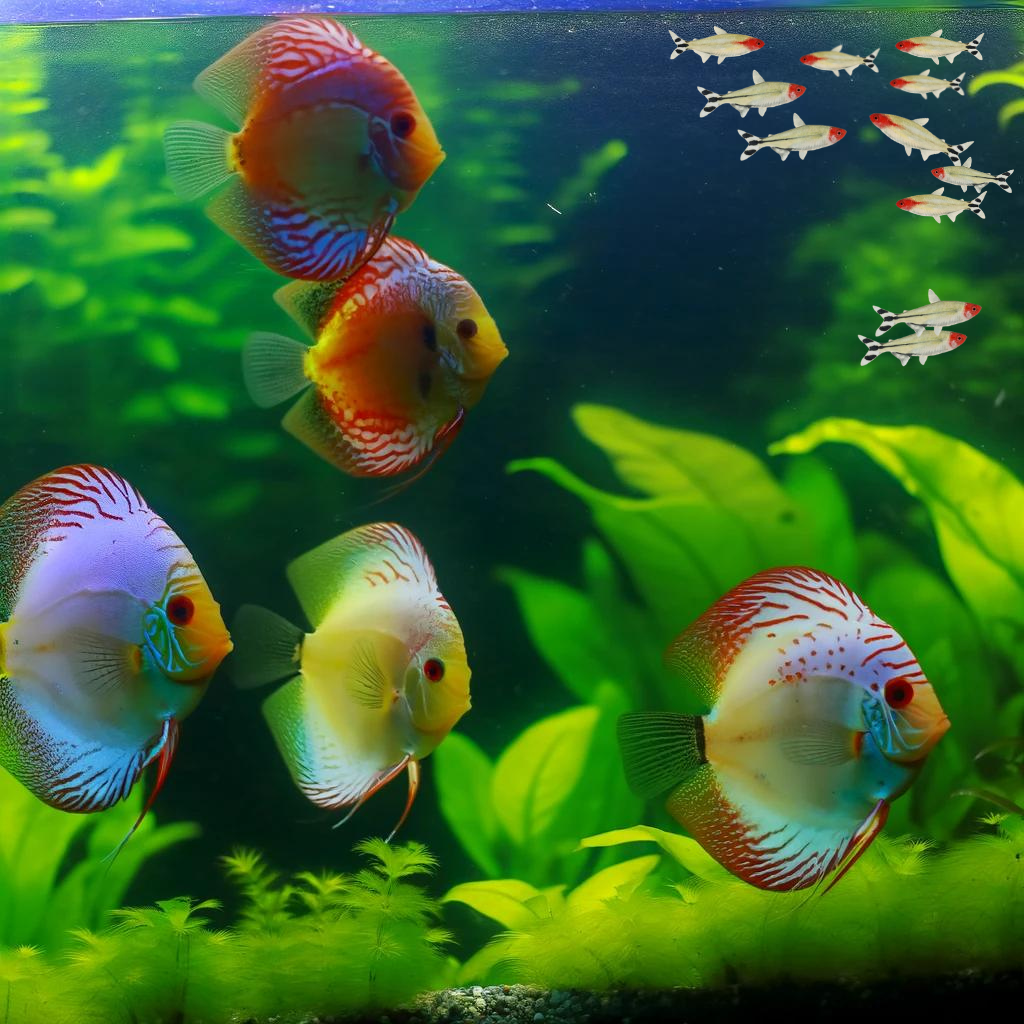
In the vast and diverse aquatic world of the Amazon basin, the Hemigrammus bleheri, commonly known as the Red-Headed Tetra or Rotkopfsalmer in German, stands out as a particularly captivating species. This introduction aims to explore the nuances of this small yet significant fish, detailing its size, habitat, and ecological importance, while drawing comparisons with the famed Symphysodon discus, or discus fish, to enrich our understanding of Amazonian aquatic life.
Dimensions and Habitat
Size and Physical Characteristics: The Rotkopfsalmer reaches a modest length of approximately 4.5 cm, exemplifying that in nature, size does not necessarily correlate with ecological importance. This small stature belies the fish’s vibrant appearance and resilience.
Natural Environment: Found in the lush, verdant waterways of Brazil and Colombia, the Red-Headed Tetra thrives in the complex ecosystems of the Amazon basin. It is particularly adapted to life in areas with abundant foliage and slow-moving currents, which provide both shelter and feeding opportunities.
Origins and Evolution
Geographical Distribution: The presence of the Rotkopfsalmer in both Brazilian and Colombian waters highlights its adaptability and the porous nature of ecological borders within the Amazon. This distribution is a testament to its evolutionary success, navigating the challenges of a dynamic environment over millennia.
Ecological Significance
Role in the Ecosystem: The Red-Headed Tetra is more than just an aquatic inhabitant; it serves as an indicator species, reflecting the health of its environment. Its sensitivity to changes in water quality makes it an important gauge for ecological stability. Additionally, as a member of the Hemigrammus genus, it plays a crucial role in the food web, aiding in nutrient cycling and energy transfer within its habitat.
Conclusion
The study of Hemigrammus bleheri offers a window into the rich biodiversity of the Amazon basin. Despite its small size, its ecological role and the beauty it brings to the natural world are immense. By comparing the Rotkopfsalmer with the larger and equally majestic discus fish, we gain a broader perspective on the intricacies and interdependencies of aquatic life forms.
Further Exploration
For enthusiasts drawn to the unique charm of the Rotkopfsalmer, the journey is just beginning. Further study into its behaviour, reproductive strategies, and overall role in freshwater ecology offers endless opportunities for discovery. Each aspect of its existence invites us to delve deeper into the wonders of the aquatic ecosystems of the Amazon, inspiring both awe and a deeper respect for these complex natural systems.
This narrative not only educates but also inspires continued exploration and appreciation of one of the world’s most fascinating ecological treasures.
Introduction to the Enchanting Red Neon Tetra
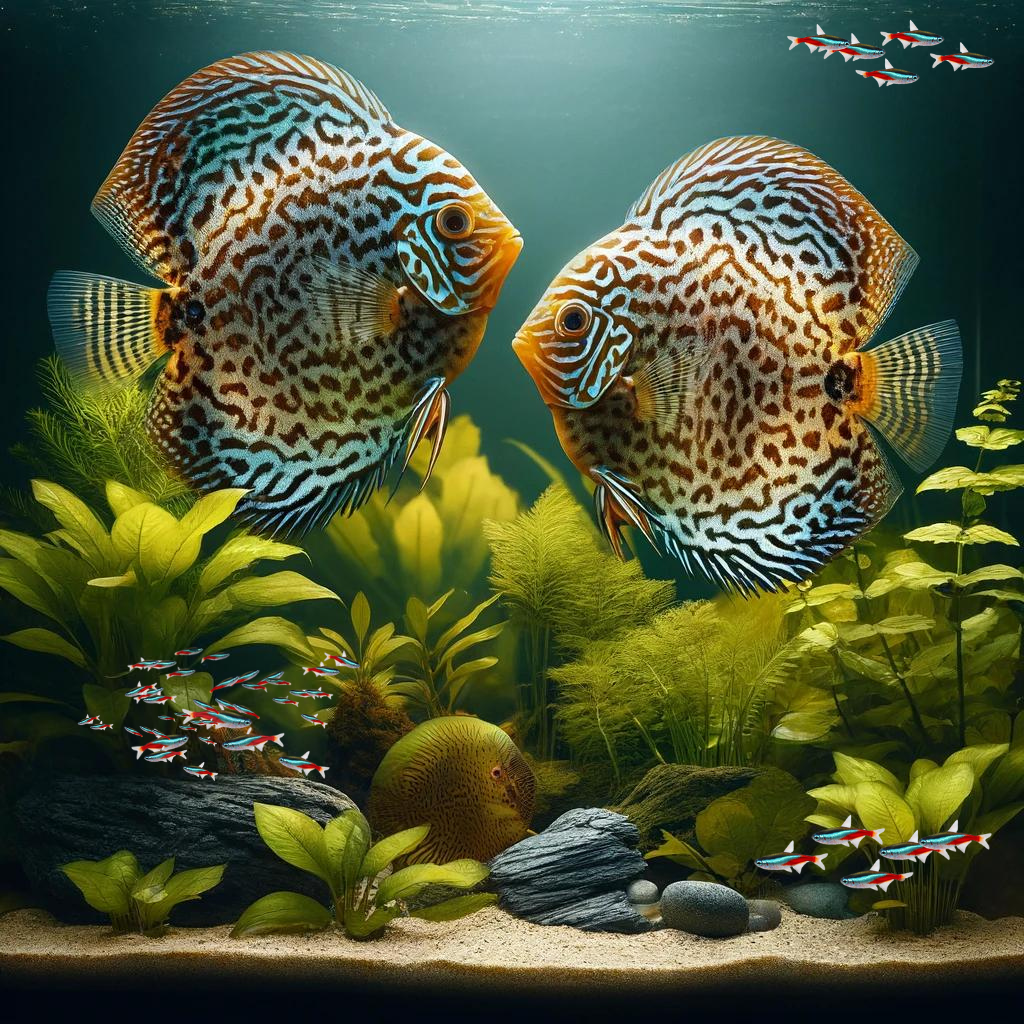
In the vibrant mosaic of aquatic life, few species capture as much wonder and admiration as the majestic discus fish, Symphysodon discus. Yet, in this same colourful ecosystem, there dwells another equally mesmerizing species—the Red Neon Tetra, Paracheirodon axelrodi. Despite its smaller size, this species stands out with its radiant colours and elegant movements, captivating aquarists and enthusiasts alike. This section is dedicated to exploring the intriguing world of the Red Neon Tetra, delving into its origins, size, and captivating nature.
Origins and Habitat
Paracheirodon axelrodi, commonly known as the Red Neon Tetra, is a testament to the seamless blend of beauty and elegance in the aquatic world. Native to the lush, slow-flowing rivers of West Brazil, Colombia, and Venezuela, these vibrant fish thrive in densely vegetated waters. Their wide distribution across these regions highlights their versatility and adaptability, making them a prevalent and significant species in freshwater aquatics.
Size and Appearance
The Red Neon Tetra is typically small, with an average size of about 5 cm (2 inches). What it lacks in size, it more than makes up for in visual impact. Known for its vivid red colouration and shimmering iridescent line that runs horizontally along its body, the Red Neon Tetra’s appearance is both striking and delicate. This contrast, set against the rich greens of aquatic plants, creates a stunning visual spectacle in any aquarium.
Cultural and Aquatic Significance
Beyond their visual appeal, Red Neon Tetras hold a significant place in aquaculture due to their peaceful nature and compatibility with various tank mates. Their presence in community tanks not only enhances the aesthetic value but also contributes to a balanced and dynamic ecosystem. Their ease of care and striking appearance make them a favourite among both novice and experienced aquarists, symbolizing tranquillity and the beauty of a well-maintained aquarium.
Conclusion
The Red Neon Tetra, Paracheirodon axelrodi, exemplifies the incredible diversity and beauty found in freshwater ecosystems. From its roots in the nutrient-rich waters of South America to its role as a staple in the aquarium hobby, this species embodies the perfect harmony of form and function. As enthusiasts and aquarists continue to explore and appreciate the depths of freshwater habitats, the Red Neon Tetra remains a symbol of enduring allure and elegance, inspiring awe and fascination in all who observe it.
The Enchanting Blue Discus: A Guide to Their Care and Habitat
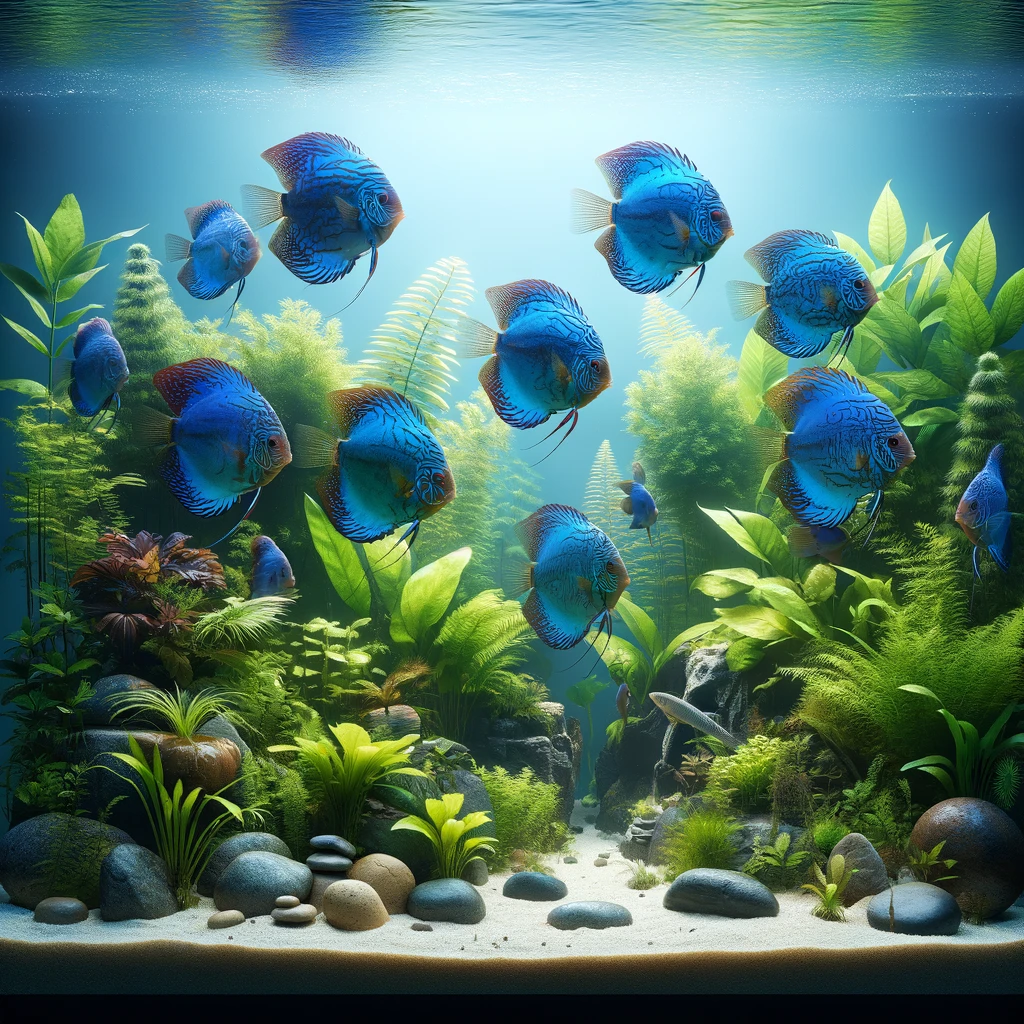
The Blue Discus (Symphysodon aequifasciatus) is a striking species originating from the river systems of South America, particularly the Amazon basin. Known for their vibrant colouration and graceful swimming, these fish are a popular choice among aquarists seeking to add beauty and elegance to their tanks.
Habitat and Water Conditions
Origin and Natural Habitat: The lush waters of South America, including the Amazon river system, are the natural habitat of the Blue Discus. These areas are characterized by their rich biodiversity and complex ecosystems, providing the perfect backdrop for the life of these ornate fish.
Preferred Water Temperature: Thriving in tropical climates, the Blue Discus prefers water temperatures between 26 to 30°C (78.8 to 86°F). This range helps simulate their natural environment, promoting health and vitality.
Recommended Aquarium Size: To accommodate their graceful swimming patterns, an aquarium size of up to 120 cm (approximately 47 inches) is recommended. This provides ample space for movement and helps in mimicking the vastness of their natural habitats.
Water pH Level: A pH level ranging from 6.00 to 7.00 is ideal, reflecting the slightly acidic to neutral waters typical of their natural environments.
General Hardness (GH) Level: A GH level between 2 and 10 °dGH is conducive to the well-being of the Blue Discus, replicating the mineral content of their native waters.
Fish Characteristics and Care
Maximum Fish Size: The Blue Discus can grow up to 15 cm (approximately 6 inches), making it a captivating centrepiece in any aquatic display.
Social Behavior: Known for their sociability, Blue Discus thrive in groups. However, selecting compatible tank mates is crucial to avoid aggression and ensure a peaceful community.
Nutritional Requirements: A diet rich in high-quality flake food, pellets, and live or frozen foods such as bloodworms and brine shrimp is essential. Including vegetables like blanched spinach or zucchini can provide additional nutrients necessary for their health.
Breeding and Environmental Considerations
Breeding: While breeding Blue Discus can be rewarding, it demands attention to detail, especially in maintaining pristine water conditions and monitoring environmental parameters closely.
Creating a Suitable Environment: Emulating their natural habitat is key. This includes stable water parameters, sufficient swimming space, and strategic placement of hiding spots like plants and driftwood within the aquarium.
Conclusion
The Blue Discus is more than just an attractive addition to your aquarium; it’s a testament to the beauty and complexity of aquatic life. By understanding and addressing their specific needs, aquarists can ensure these magnificent creatures thrive, providing years of enjoyment and satisfaction. Understanding their requirements allows enthusiasts to maintain a healthy, vibrant aquatic environment conducive to the well-being and longevity of these spectacular fish.
Blue-Turquoise Discus: A Gem of the Aquarium World
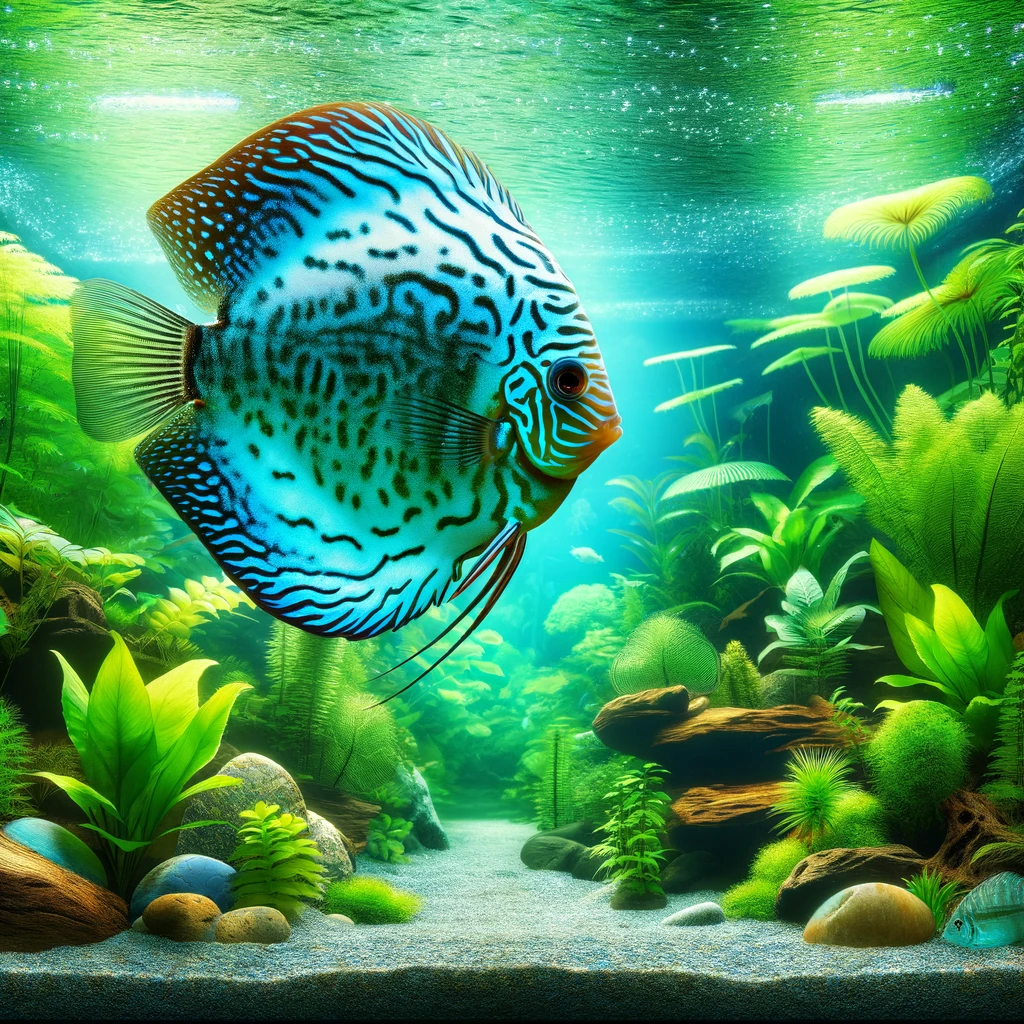
The Blue-Turquoise Discus (Symphysodon aequifasciatus) is a stunning exemplar of the diverse and vibrant discus fish species. Renowned for its breathtaking blue and turquoise hues, this species offers both aesthetic delight and a captivating presence in the freshwater aquarium.
Habitat and Origin
Native to the tropical waters of South America, Blue-Turquoise Discus thrive in warm, slow-moving rivers and tributaries, as well as flooded forest areas. These habitats provide an abundance of vegetation and shelter, essential for the natural behaviours and survival of these fish.
Water Parameters
To ensure the health and vitality of Blue-Turquoise Discus, maintaining optimal water conditions is crucial:
- Temperature: A warm range of 26 to 30°C is ideal, reflecting their tropical origins.
- pH Levels: A slightly acidic to neutral pH of 6.00 to 7.00 is preferred.
- General Hardness: Water hardness should be kept soft, between 2 to 10 °dGH, to mimic their natural river environments.
Aquarium Requirements
A spacious aquarium, ideally up to 120 cm in length, is recommended to provide sufficient space for these active swimmers. The aquarium should include:
- Live Plants and Decor: These are not just decorative but serve as hiding and resting spots, promoting natural behaviours and reducing stress.
- Adequate Filtration: To maintain clean and stable water conditions, effective filtration is necessary.
Behaviour and Compatibility
Blue-Turquoise Discus are peaceful and sociable, making them suitable for community tanks with other non-aggressive fish. However, selecting tank mates that require similar water conditions and have a calm demeanour is vital. Suitable companions might include:
- Other Discus Variants: They typically enjoy the company of their kind.
- Tetras and Peaceful Bottom Dwellers: These fish do not compete aggressively for food and are not territorial.
Conclusion
The Blue-Turquoise Discus is more than just an aquatic pet; it’s a vibrant contribution to any aquarium, capable of transforming an ordinary tank into a piece of living art. For enthusiasts willing to meet their specific care requirements, these discus fish can provide a rewarding, long-term commitment to tropical fishkeeping. Their striking colours and graceful movements make them a favourite among aquarists, symbolizing the beauty and diversity of aquatic life.
Brown Discus (Symphysodon aequifasc. axelrodi): Captivating Inhabitants of the Amazon
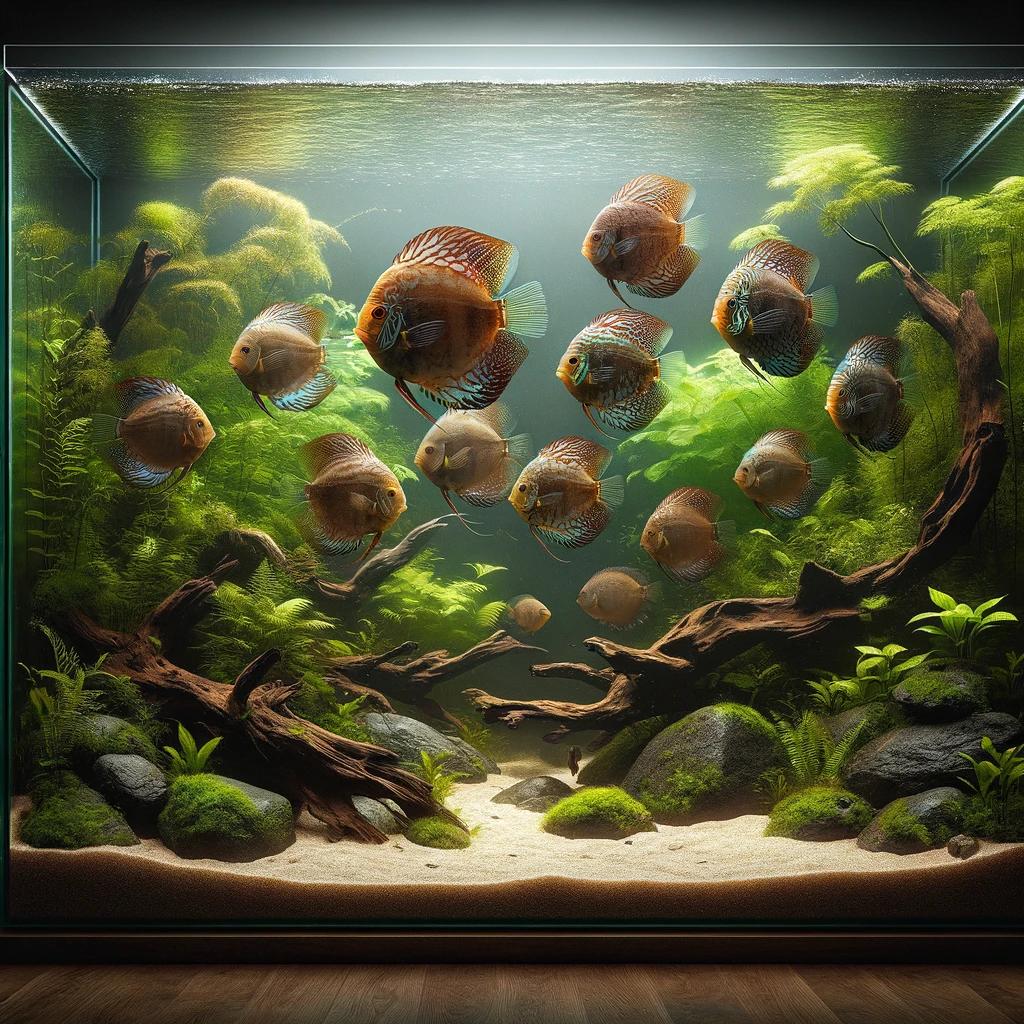
The Brown Discus is a distinguished resident of South America’s lush aquatic ecosystems, renowned for its serene beauty and striking adaptability. Native to the Amazon River and its myriad tributaries, these fish are adept at navigating the tranquil waters filled with lush vegetation and submerged woodlands. For aquarists aiming to emulate their natural habitat, here are essential care guidelines to ensure their health and vibrancy in a home aquarium.
Habitat and Natural Environment
The Brown Discus naturally thrives in the warm, soft waters of river basins. In these environments, they are surrounded by a rich array of submerged vegetation and driftwood, which provide natural cover and foraging grounds.
Optimal Water Temperature
To mimic the warm tropical conditions of the Amazon, the ideal water temperature for housing Brown Discus should be maintained between 26 to 30 degrees Celsius. This range supports their optimal physiological functioning and overall health.
Aquarium Size Recommendations
A spacious aquarium is crucial for the well-being of Brown Discus. An ideal aquarium should measure up to 120 centimetres, allowing ample space for swimming, foraging, and social interactions, which are pivotal to the natural behaviour of these fish.
Water Quality Parameters
- pH Level: The water’s pH should be slightly acidic, ranging from 6.00 to 6.80, to replicate the natural acidity of their habitat. This level is essential for their digestion, respiration, and overall metabolic health.
- General Hardness (GH): The GH level should be maintained between 2 to 10 degrees of General Hardness (°dGH). This ensures the water contains sufficient minerals and ions necessary for their skeletal development and osmoregulation.
Growth and Size
The Brown Discus can grow to a maximum size of about 15 centimetres. Growth rates can vary based on factors like diet, water quality, and the fish’s overall living conditions.
Conclusion
The Brown Discus offers aquarists a unique opportunity to bring a piece of the Amazon right into their living rooms. By maintaining the recommended water parameters and providing a spacious, well-structured environment, enthusiasts can ensure the thriving presence of these majestic creatures. This not only enhances the aesthetic appeal of their aquariums but also contributes to the health and longevity of the fish, allowing them to exhibit their natural beauty and behaviours vividly.
Brilliant-Turquoise Discus: A Comprehensive Care Guide
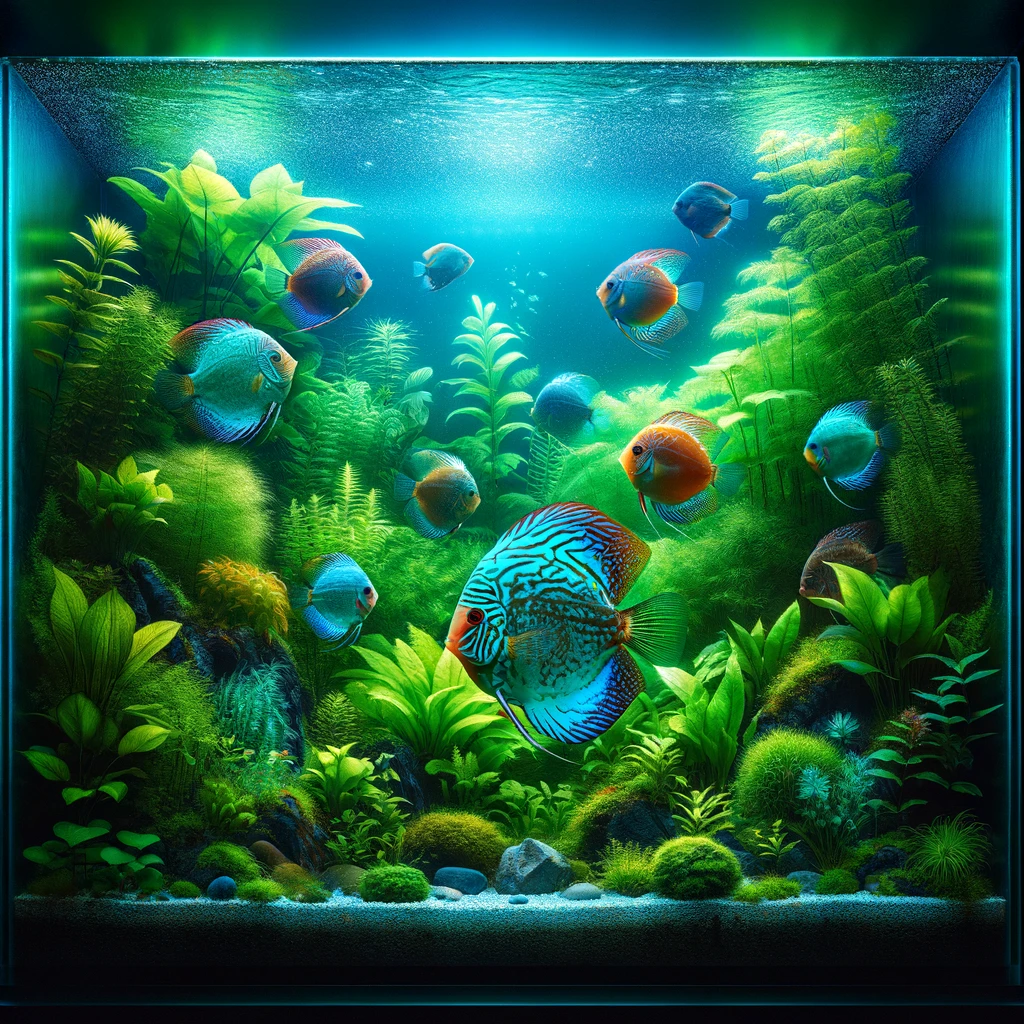
The Brilliant-Turquoise Discus, scientifically known as Symphysodon aequifasciatus, is a captivating species from the vibrant aquatic ecosystems of South America. This guide delves into the essential care requirements needed to maintain these stunning fish in an aquarium setting.
Habitat Requirements
The natural habitat of the Brilliant-Turquoise Discus is characterized by lush vegetation and slow-moving waters typical of South American riverbeds. These environments are densely vegetated, providing the discus with ample space to navigate through the interplay of light and shadow, which beautifully highlights their iridescent hues.
Aquarium Setup:
- Size: An aquarium of up to 120 centimetres in length is ideal, accommodating the sociable nature and spatial needs of these fish. Such dimensions allow for graceful swimming and interactions, essential for their physical and psychological health.
- Vegetation: Mimicking their natural habitat, the aquarium should be densely planted with aquatic flora to replicate the densely vegetated riverbeds they originate from.
Water Conditions
Maintaining optimal water conditions is crucial for the health and vitality of the Brilliant-Turquoise Discus.
- Temperature: The water temperature should be consistently maintained between 26 to 30 degrees Celsius, reflecting the tropical conditions of their native habitat.
- pH Level: A pH range of 6.00 to 7.00 is optimal. This slightly acidic to neutral range helps ensure the discus’ metabolic functions and physiological processes run smoothly.
- General Hardness (GH): The GH should be kept between 2 to 10 degrees of German hardness (°dGH). This range helps maintain the osmotic balance necessary for their health and vitality.
Nutrition and Feeding
Brilliant-Turquoise Discus are discerning eaters, requiring a balanced diet rich in variety. They thrive on a mixture of high-quality pellets, frozen or live foods such as bloodworms and brine shrimp, and vegetable-based foods to ensure a well-rounded diet.
Social Behavior
These discuses are generally peaceful but can be territorial during breeding. They thrive in groups, which helps mimic their natural social interactions. However, careful attention should be paid to tank mates to avoid aggression or competition.
Health and Maintenance
Regular monitoring of water quality, including ammonia, nitrate levels, and frequent water changes, is essential. Discus are sensitive to poor water conditions, so ensuring the cleanliness and stability of their environment is key to preventing stress and disease.
Conclusion
Caring for the Brilliant-Turquoise Discus involves a commitment to replicating their natural habitat as closely as possible within the confines of an aquarium. By adhering to these care guidelines, aquarists can create a thriving environment that not only supports the health and well-being of these exquisite fish but also enhances the aesthetic appeal of their aquascape. This stewardship not only ensures the vitality of the discus but enriches the aquaristic experience, inviting observers into a mesmerizing aquatic world.
Section: Discus Fish - Symphysodon discus
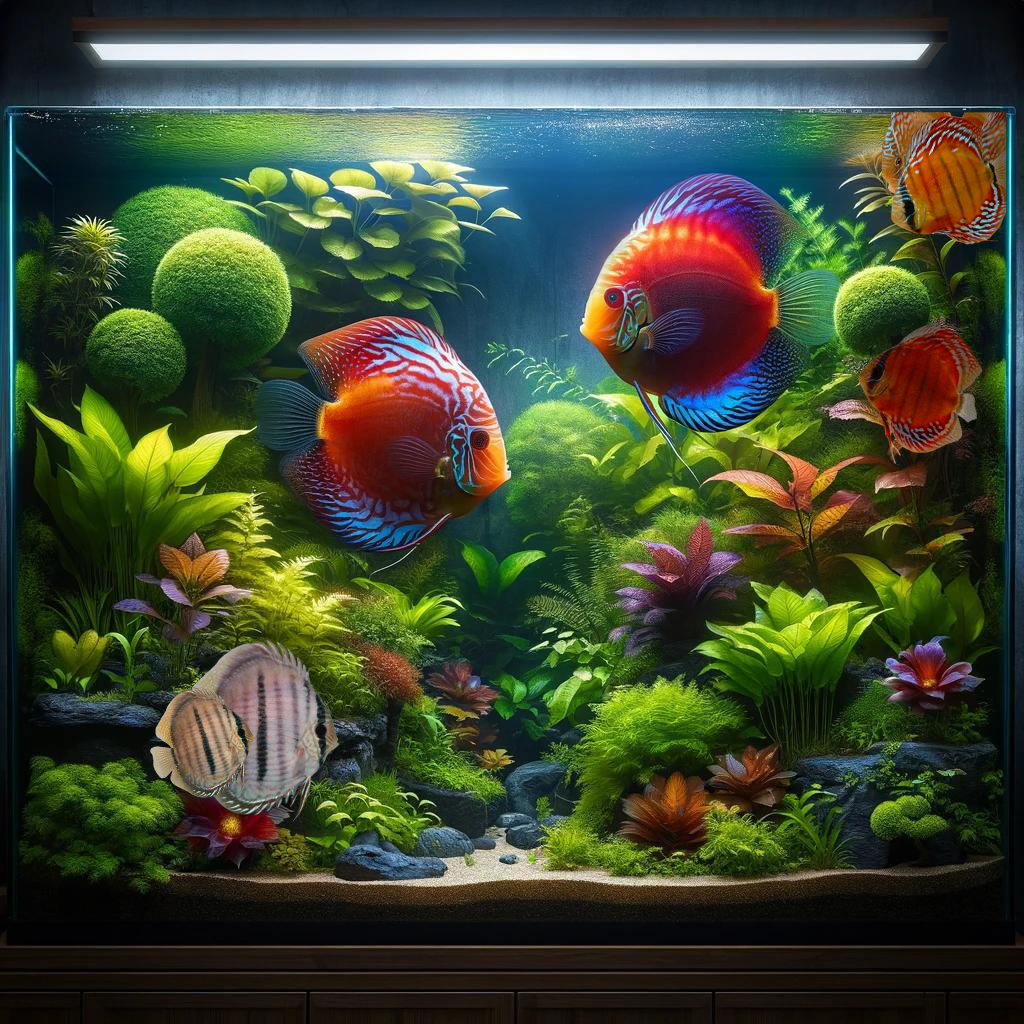
The discus fish, or Symphysodon discus, is renowned for its stunning beauty and complex care requirements. Native to the tropical waters of the Amazon basin, this species thrives in warm, slow-moving tributaries and floodplain lakes. Here’s a guide on how to create the ideal conditions for these captivating creatures in captivity:
Habitat Requirements
1. Preferred Water Temperature
- Range: 26 to 30 degrees Celsius (78.8 to 86 degrees Fahrenheit)
- Discus fish demand stable, warm water temperatures to mimic the tropical conditions of their natural habitat.
2. Recommended Aquarium Size
- Minimum Size: 120 centimetres (47 inches) in length
- A larger aquarium provides necessary swimming space and helps prevent territorial conflicts, which are crucial for the well-being of these sociable yet territorial fish.
3. Water Chemistry
- pH Level: 6.00 to 6.80
- The slightly acidic to neutral range is essential to replicate the water conditions of the Amazon basin, supporting the fish’s physiological functions and health.
- General Hardness (GH) Level: 2 to 10 °dGH
- This range provides the mineral content needed for proper osmoregulation and metabolic processes in discus fish.
4. Maximum Fish Size
- Discus fish can grow up to 20 centimetres (7.9 inches). Their large size, coupled with vibrant colouration and distinct patterns, makes them highly desirable for aquarists but also underscores the need for adequate space and optimal water conditions.
Creating the Ideal Environment
To ensure the health and vitality of discus fish, it is essential to maintain water quality and environmental stability:
- Regular Water Changes: Perform regular water changes to keep parameters stable and to remove toxins and waste products.
- Filtration: Use high-quality filters to maintain clean and clear water, ensuring that they do not create excessive current, as Discus prefer calmer waters.
- Aquascaping: Include plenty of hiding places and visual barriers with plants and decor to mimic the natural environment and reduce stress.
- Companion Species: Carefully consider tank mates, as discus fish can be stressed by overly active or aggressive fish.
In summary, while discus fish are among the most beautiful aquarium species, they require meticulous care to thrive. By replicating their natural conditions and closely monitoring their environment, aquarists can ensure these majestic fish live healthy and fulfilling lives in captivity.
Care Guide for Green Discus (Symphysodon aequifasciatus)
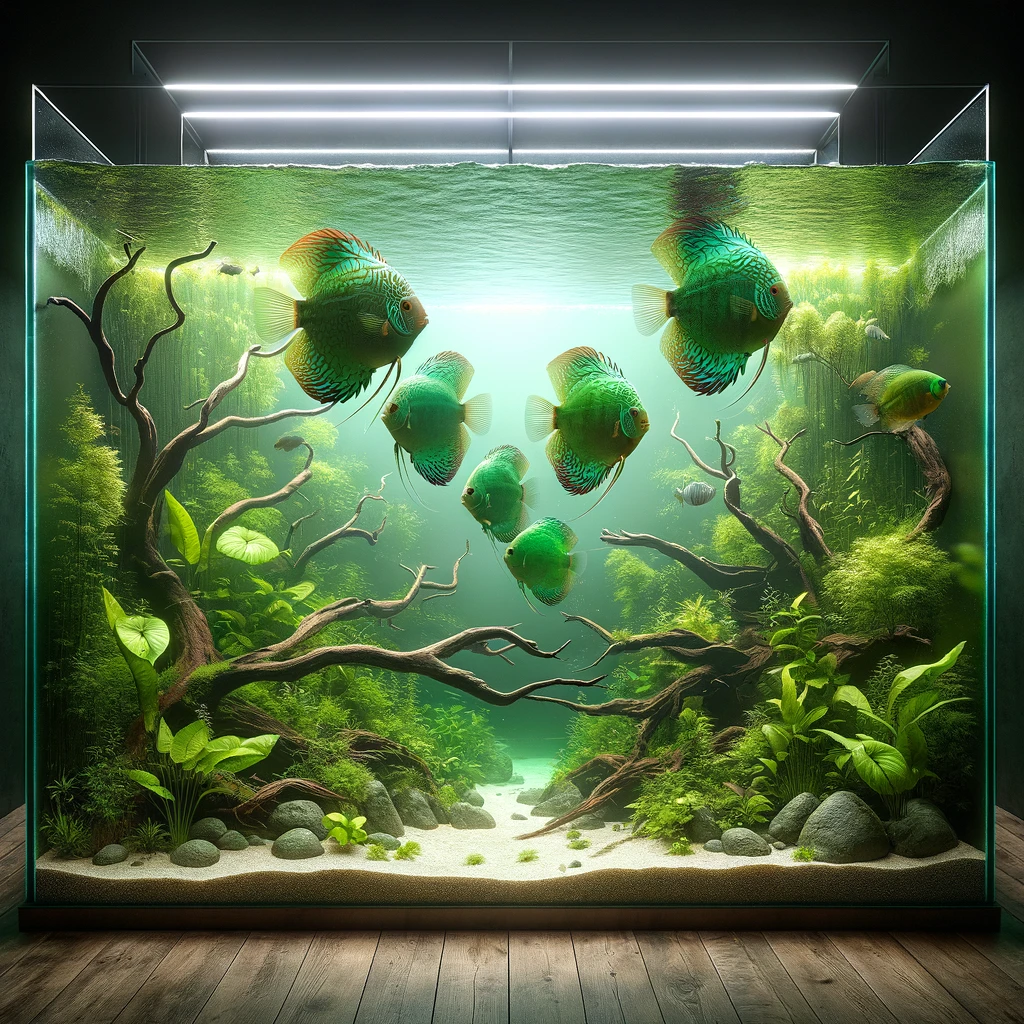
The Green Discus, known scientifically as Symphysodon aequifasciatus, is a stunning freshwater fish native to South America, celebrated for its vibrant colours and engaging behaviour. Here’s a comprehensive care guide to help aquarists maintain the perfect conditions for this species.
Origin and Natural Habitat
The Green Discus thrives in the warm, soft waters of the Amazon Basin, where it enjoys the shelter provided by dense vegetation and submerged tree roots. These conditions are crucial to replicate in home aquariums to support their health and natural behaviours.
Preferred Water Temperature
- Optimal Range: 26 to 30°C (78.8 to 86°F)
- Purpose: This temperature range emulates the tropical climates of its native environment, providing the warmth necessary for optimal physiological functioning.
Recommended Aquarium Size
- Minimum Size: 120 cm in length
- Purpose: A larger tank is essential to accommodate their territorial behaviour and natural swimming patterns, ensuring ample space for movement and reducing stress.
Water Chemistry
- pH Level: 6.00 to 6.80
- Maintaining a slightly acidic to neutral pH mirrors the water conditions of their natural habitat, promoting healthier life processes.
- General Hardness (GH): 2 to 10 °dGH
- Appropriate GH levels are crucial for supporting the fish’s internal osmoregulation and overall well-being. This range helps provide essential minerals while safeguarding against the detrimental effects of hard water.
Maximum Fish Size
- Adult Size: Up to 15 cm (6 inches)
- Characteristics: The Green Discus showcases a disc-shaped body and impressive colouration as it matures, making it a centrepiece in any aquarium.
Conclusion
To ensure the well-being of the Green Discus, aquarists must create an environment that closely mimics the fish’s natural habitat. By maintaining the recommended water temperature, pH, and hardness, and providing a sufficiently large aquarium, enthusiasts can help their Green Discus thrive. This careful attention to their living conditions will allow the natural beauty and health of the Green Discus to flourish, making them a truly rewarding addition to any freshwater aquarium.
Red Discus Fish (Symphysodon aequifasciatus) Care Guide
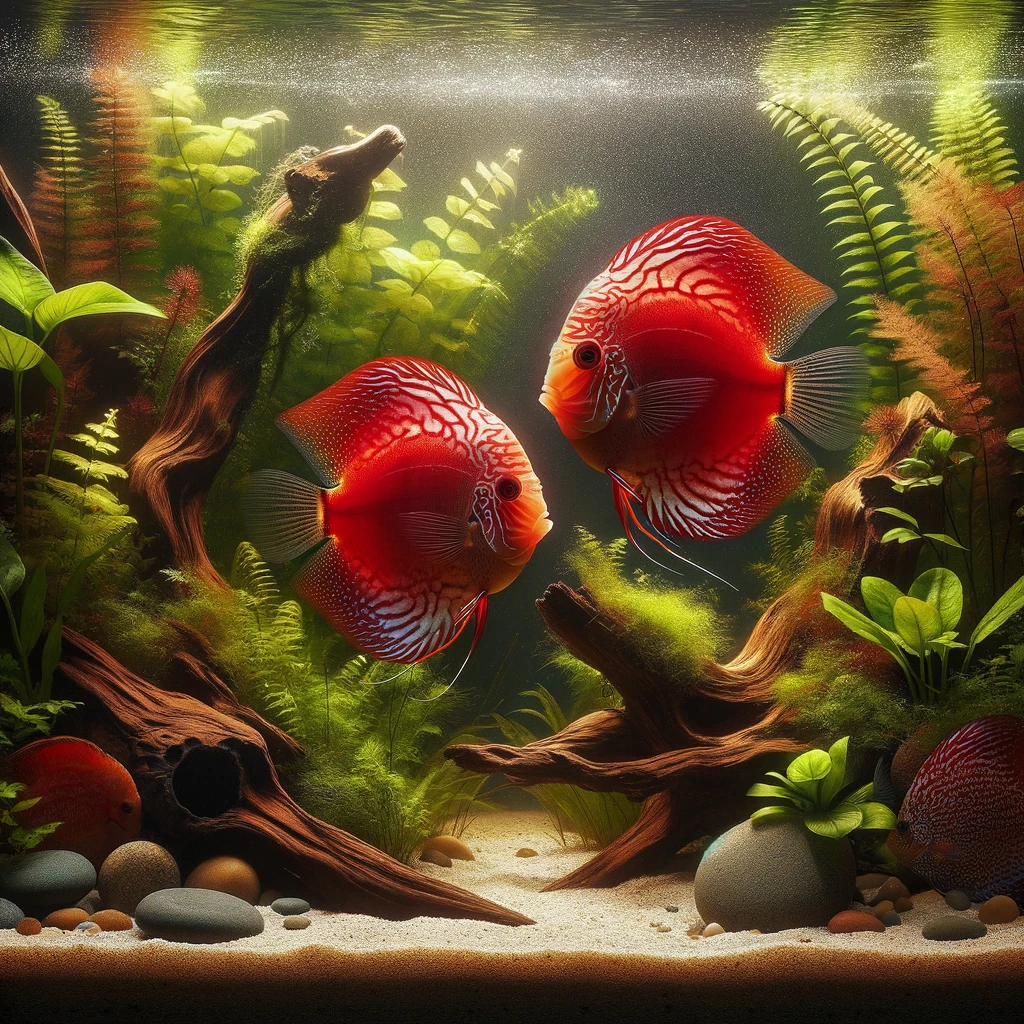
The Red Discus, known for its stunning appearance and graceful demeanour, is a cherished species among aquarium enthusiasts. Originating from the warm, tropical waters of South America, this species requires specific care to thrive in captivity. Here’s a comprehensive guide to creating the ideal environment for your Red Discus.
Habitat and Origin
The Red Discus is native to the lush, tropical river systems of South America where the climate is consistently warm. These fish are adapted to environments with dense vegetation and soft, acidic water, typical of their natural habitat.
Preferred Water Temperature
To ensure the health and well-being of the Red Discus, maintaining a water temperature between 26°C to 30°C is crucial. This temperature range closely mimics the tropical conditions of their native waters, providing a comfortable and stress-free environment.
Recommended Aquarium Size
Given their active nature and need for space, Red Discus should be housed in aquariums that are at least 120 cm in length. This size allows ample room for swimming and interaction, which is vital for the social behaviour of these fish.
Water pH Levels
The pH level of the water is a critical factor in the care of Red Discus. A pH range of 6.00 to 7.00 is ideal, as it closely replicates the slightly acidic conditions of their natural rivers. Regular monitoring and adjustments are necessary to maintain these levels, ensuring a stable environment that promotes their health.
Water Hardness (GH)
Red Discus thrive in soft to moderately hard water, with a general hardness ranging from 2 to 10 °dGH. This range helps simulate the mineral content of their native habitat, which is crucial for their overall physiological health.
Maximum Size
The Red Discus typically grows to a maximum size of about 15 cm. This moderate size makes them well-suited for medium to large aquarium setups, where they can display their full splendour and activity.
Summary
The vibrant colouration and serene swimming style of the Red Discus make them a captivating addition to any aquarium. However, replicating the conditions of their natural habitat is essential for their survival and health in captivity. By carefully managing water temperature, pH, and hardness, along with providing sufficient space, aquarists can enjoy the beauty of Red Discus in their home aquariums, ensuring these magnificent fish live healthy and vibrant lives.
For enthusiasts looking to bring the natural beauty of Red Discus into their homes, consider incorporating visual elements such as lush aquatic plants and soft substrates to further emulate their South American rivers, enhancing both the health of the fish and the aesthetic appeal of your setup.
Rot-türkis Discus - Symphysodon aequifasciatus
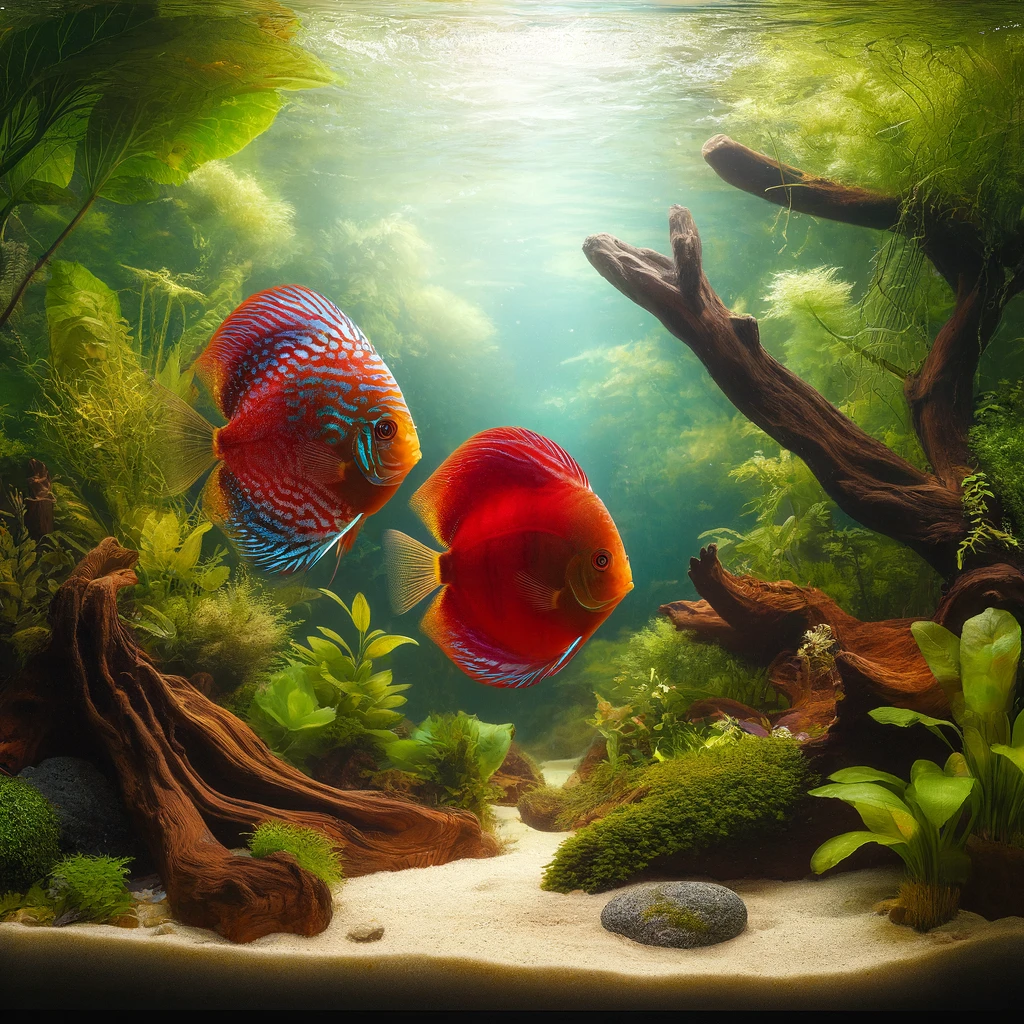
The Rot-türkis Discus, scientifically identified as Symphysodon aequifasciatus, is a stunning freshwater fish native to South America’s lush aquatic ecosystems. Below, we delve into the crucial aspects of their care, habitat, and tank requirements to ensure they thrive in a home aquarium setting.
Native Habitat and Environmental Needs
Natural Environment: Rot-türkis Discus are predominantly found in slow-moving rivers, peaceful tributaries, and seasonally flooded forest areas. These locations offer warm, stable water temperatures and are rich in vegetation, providing natural shelters and abundant foraging opportunities.
Tank Conditions
Optimal Water Temperature: To mimic their natural habitat, maintain aquarium water temperatures between 26°C to 30°C. This range supports their metabolic activities essential for growth and overall health.
Aquarium Size: Rot-türkis Discus are sociable yet territorial. They require spacious tanks to accommodate their behaviours, with a recommended minimum length of 120 centimetres. This space not only allows for free movement but also aids in the establishment of social hierarchies, enhancing their communal interactions.
Water Chemistry:
- pH Level: The ideal pH for these fish ranges from 6.00 to 7.00, slightly acidic to neutral, which aligns with the water chemistry of their native environments.
- General Hardness (GH): A GH level of 2 to 10 °dGH is ideal, mirroring the mineral content of their natural habitats. This helps maintain osmoregulatory balance and reduces stress.
Living Conditions
Community and Territory: When setting up a community aquarium, consider the Rot-türkis Discus’s need for defined territories to prevent stress and promote natural behaviours. They should be housed with other peaceful species that share similar water requirements.
Maintenance and Care: Regular water changes, consistent temperature checks, and monitoring of water parameters are essential to mimic the stable conditions of their native waters. Proper filtration should be used to maintain clean and clear water, avoiding fluctuations in water chemistry that can lead to stress.
Conclusion
Caring for Rot-türkis Discus involves creating an environment that closely resembles their natural habitats in terms of space, water quality, and temperature. By adhering to these guidelines, aquarists can ensure the health, vitality, and longevity of these magnificent fish, making them a captivating addition to any freshwater aquarium.
Caring for the Taubenblut Discus: A Guide to Their Habitat and Needs
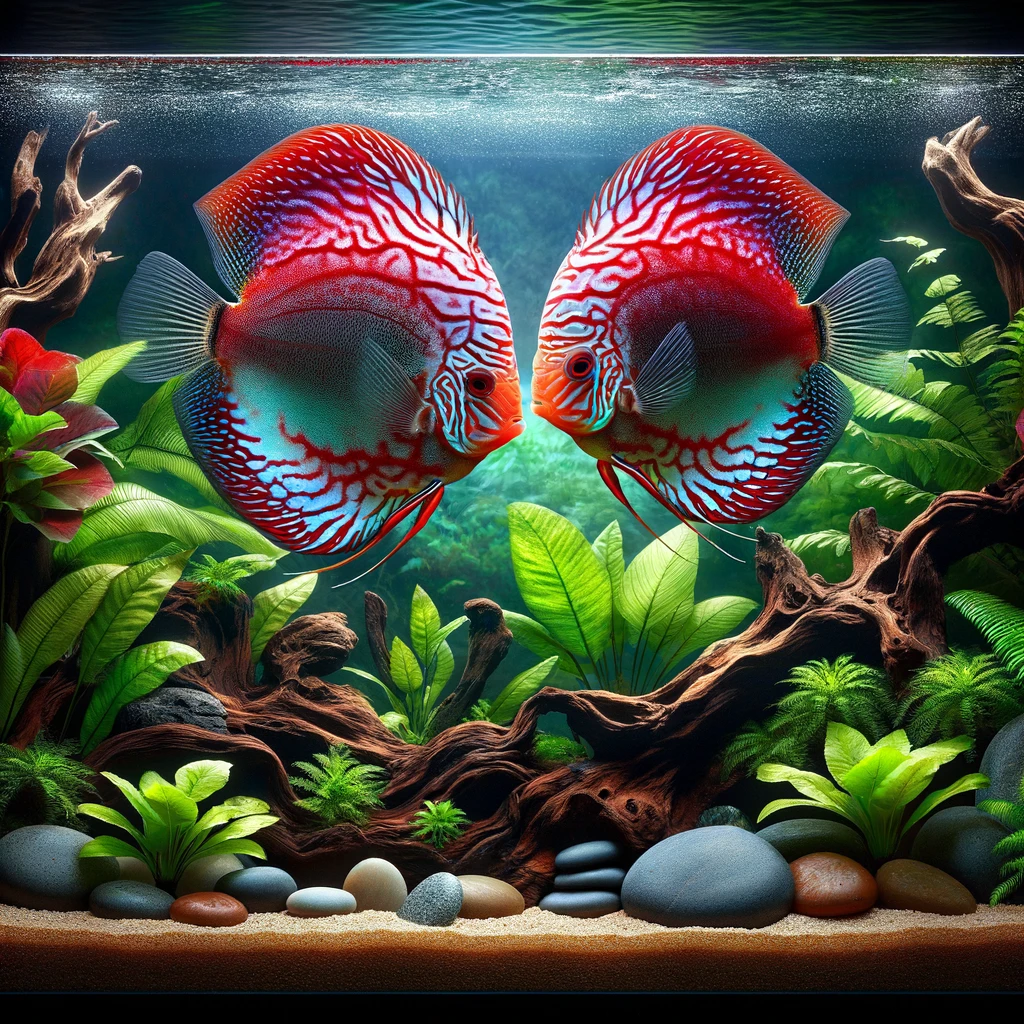
The Taubenblut Discus, known scientifically as Symphysodon aequifasciatus, is a stunning freshwater fish from the Amazon River basin. Understanding their natural habitat and specific care requirements is crucial for maintaining a healthy environment for these fish in captivity.
Natural Habitat
Taubenblut Discus originate from the vast and intricate waterways of South America, particularly within the Amazon River basin. These areas are known for their warm waters, dense vegetation, and slow-moving streams, providing an ideal setting for these fish.
Preferred Water Temperature
To thrive, Taubenblut Discus require warm water temperatures between 26 to 30°C (79 to 86°F). This range mimics the tropical climate of their natural habitat and supports their health and vibrant colouration.
Recommended Aquarium Size
Given their graceful nature and social behaviour, Taubenblut Discus need spacious aquariums to exhibit their natural behaviours freely. An aquarium with dimensions up to 120 cm (about 47 inches) in length is ideal, allowing ample space for swimming and interaction among fish.
Water Chemistry
- pH Level: The optimal pH range for Taubenblut Discus is 6.00 to 7.00, which matches the slightly acidic conditions of their native waters. Maintaining this pH level is vital for their overall health and well-being.
- General Hardness (GH): A GH level of 2 to 10 °dGH is suitable for these fish, reflecting the soft to moderately hard water conditions found in their natural environment. Proper hardness levels are essential for supporting their physiological functions.
Maximum Size
Taubenblut Discus typically grow up to 15 cm (about 6 inches) in length. Their elegant and colourful appearance makes them a favourite among aquarists who aim to add beauty and sophistication to their tanks.
Conclusion
Properly caring for Taubenblut Discus involves replicating the conditions of their natural habitat as closely as possible and adhering to the specific water chemistry requirements. By providing an environment that caters to their needs, aquarists can ensure the health, vitality, and longevity of these magnificent fish in home aquariums.
Türkisgestreifter Diskus - Symphysodon aequifasciatus
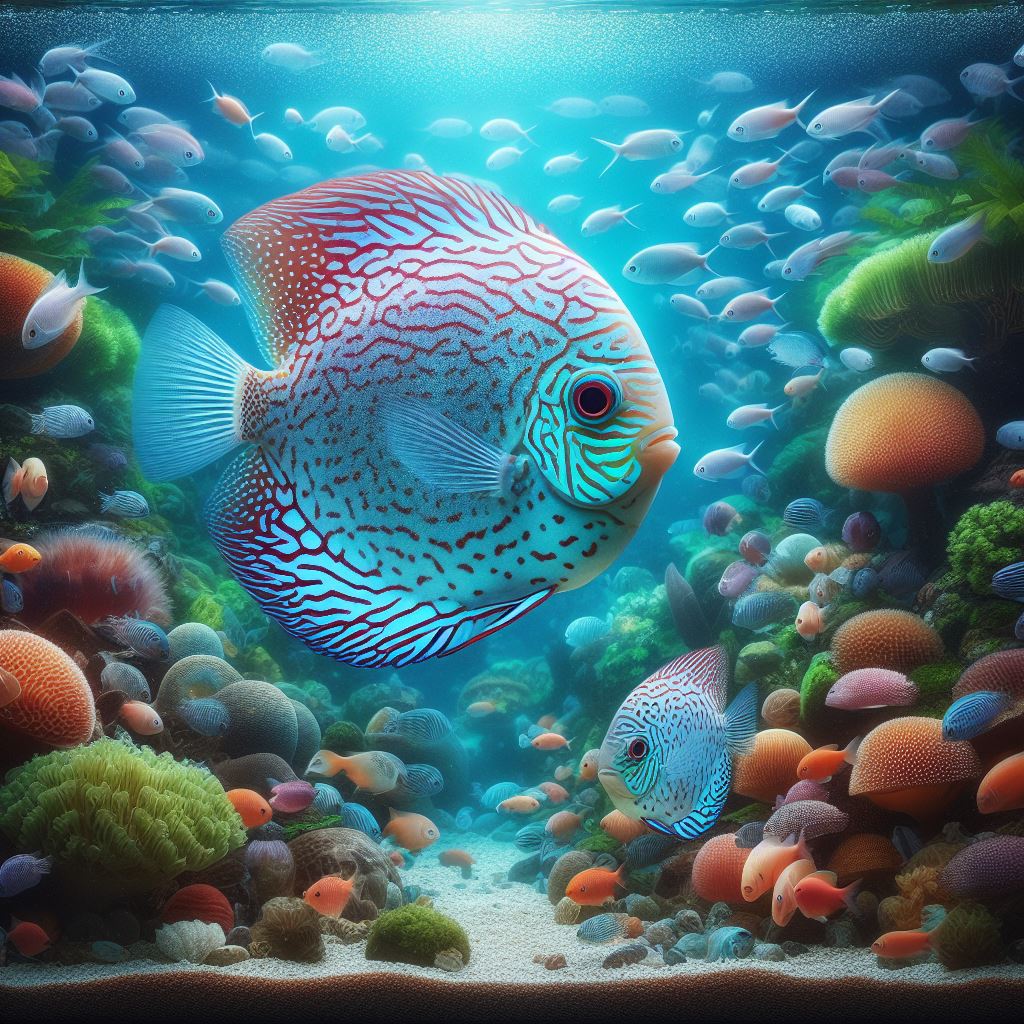
The Turkisgestreifter Diskus, also known as the turquoise striped discus, is a species that epitomizes the beauty and complexity of aquatic life native to South America. Here’s an in-depth look at their habitat, environmental preferences, and care requirements, which are crucial for anyone considering adding these stunning fish to their aquarium.
Habitat and Distribution
The turquoise-striped discus is indigenous to the vast and biodiverse Amazon River basin. This includes not only the main river but also its numerous tributaries and oxbow lakes, which provide the varied and rich environments crucial for the survival of this species. The warm, soft, and slightly acidic waters of these habitats play a significant role in the life cycles and behaviours of these fish.
Environmental Preferences
Thriving in warm waters, the turquoise striped discus prefers temperatures ranging from 26°C to 30°C. They are best suited to slightly acidic to neutral waters, with pH levels ideally maintained between 6.00 and 7.00. Additionally, a general hardness (GH) of 2 to 10 degrees of German hardness (°dGH) is optimal, ensuring the water remains soft yet conducive to their health.
Aquarium Considerations
To replicate their natural environment in captivity:
- Aquarium Size: A minimum length of 120 centimetres is recommended, allowing ample space for swimming and exploring.
- Water Quality: Regular monitoring and adjusting of temperature, pH, and GH levels are crucial to mimic the natural conditions of the Amazon basin.
Behavior and Compatibility
Turquoise striped discus are known for their peaceful yet sometimes territorial nature, especially during breeding. They exhibit stunning colouration and graceful swimming movements that make them highly desirable to aquarists. When introducing these discus to a community tank, it’s important to:
- Choose compatible tank mates that are peaceful and can thrive in similar water conditions.
- Provide plenty of hiding spots and visual barriers to reduce stress and potential conflicts.
Nutritional Requirements
As omnivores, these discus require a varied diet:
- Base Diet: High-quality commercial pellets or flakes form a good foundation.
- Supplementary Foods: Live or frozen foods like bloodworms, brine shrimp, and daphnia not only provide essential nutrients but also encourage natural foraging behaviours.
Conclusion
The turquoise-striped discus offers a glimpse into the vibrant life of the Amazon’s aquatic ecosystems. Successfully keeping these fish in an aquarium setting requires a deep understanding of their natural habits and precise care. By establishing appropriate environmental conditions and providing a balanced diet, aquarists can ensure the health and vitality of these magnificent creatures, making them a rewarding addition to any freshwater aquarium setup.
Ideal Fish for Beginners: A Guide to Easy-to-Care-for Species
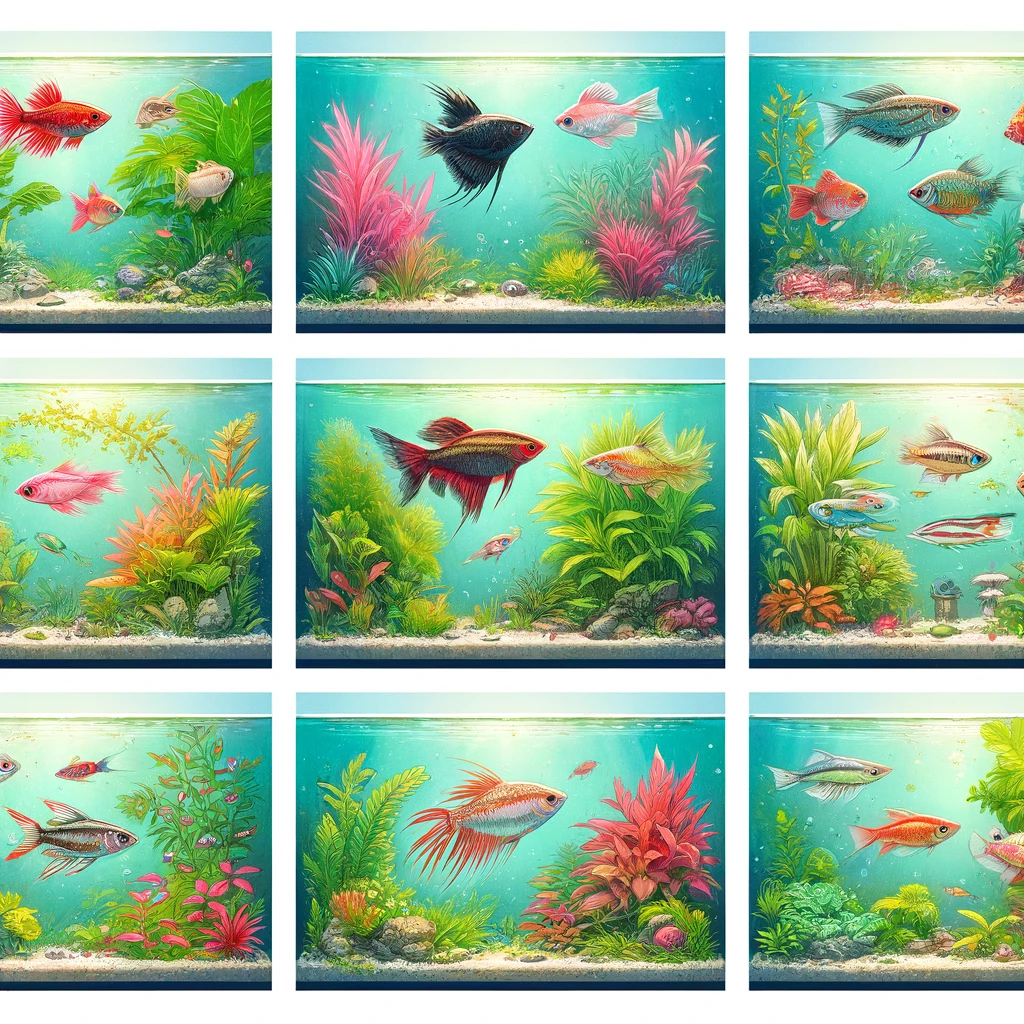
While labelled as “beginner fish,” the species listed below are not only suitable for newcomers but can also be appreciated by advanced aquarists. These fishes are generally easy to care for, primarily due to their low dietary requirements and adaptability to a range of water conditions.
General Care
Most of these beginner fish are omnivores and thrive on a simple diet of flake food, although occasional live food can enrich their diet and is usually welcomed. Additionally, they are not particularly demanding regarding water parameters, tolerating a wide range of temperatures and pH levels.
Featured Beginner Fish
Red Phantom Tetra (Aphyocharax anisitsi)
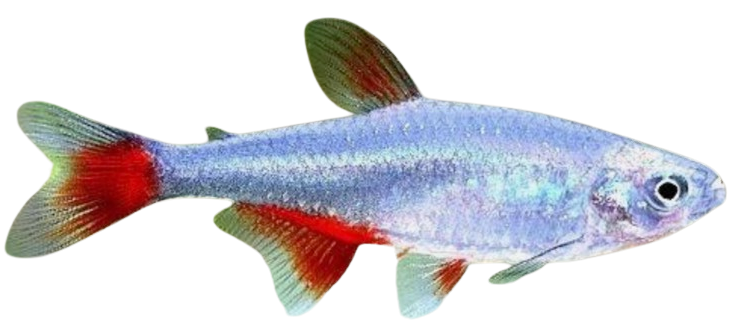
- Behaviour: Peaceful schooling fish
- Size: 5 cm
- Temperature: 20-28°C
- General Hardness (dGH): Up to 30°
- pH Range: 6.0-8.0
- Diet: Omnivorous
Red Phantom Tetra (Aphyocharax anisitsi) Overview
The Red Phantom Tetra, scientifically known as Aphyocharax anisitsi, is a vibrant and captivating choice for both beginner and experienced aquarists. This species belongs to the Characidae family, which is known for its colourful and active members. Here’s a deeper look into the behaviour, care, and requirements of the Red Phantom Tetra to help you maintain a healthy environment for them.
Behaviour
Red Phantom Tetras are peaceful schooling fish that thrive in groups. In the wild, they are found swimming in large schools, and they bring this same behaviour into the aquarium. Keeping them in groups of at least five to six individuals helps to promote natural behaviour and reduces stress in these social fish. The presence of a school can also enhance their vibrant colouration, making them more striking in a planted aquarium.
Size and Appearance
The Red Phantom Tetra typically reaches about 5 cm in length. They have a primarily translucent body with a splash of red on their fins and sometimes along their body, depending on the lighting and their diet. Their small size makes them ideal for community tanks, where their peaceful nature allows them to coexist with other similarly sized and tempered fish.
Water Conditions
To keep your Red Phantom Tetras healthy, maintain tank water temperatures between 20°C and 28°C. They are adaptable to various water hardness levels but prefer a general hardness (dGH) up to 30°. The pH should be kept between 6.0 and 8.0. While they are somewhat tolerant of different water parameters, consistency is key in avoiding stress and maintaining their vibrant appearance and health.
Diet
Red Phantom Tetras are omnivorous and are not particularly fussy eaters. A balanced diet consisting of high-quality flake food, along with the periodic inclusion of live or frozen foods such as brine shrimp or daphnia, can help ensure they receive all necessary nutrients. Occasional vegetable supplements can also be offered to mimic their natural diet and provide variety.
Tank Setup
A well-planted aquarium with ample swimming space is ideal for these active swimmers. They appreciate a setup that mimics their natural habitat, which includes soft, subdued lighting, dark substrates, and the presence of driftwood or leaf litter. These elements not only provide hiding spots but also help in simulating a natural environment that can reduce stress and promote health.
Adding Red Phantom Tetras to your aquarium brings a dynamic and colourful movement that can liven up any aquatic setup. Their easy care and beautiful appearance make them a popular choice among aquarists looking to add some flair and activity to their tanks.
Black Skirt Tetra (Gymnocorymbus ternetzi)
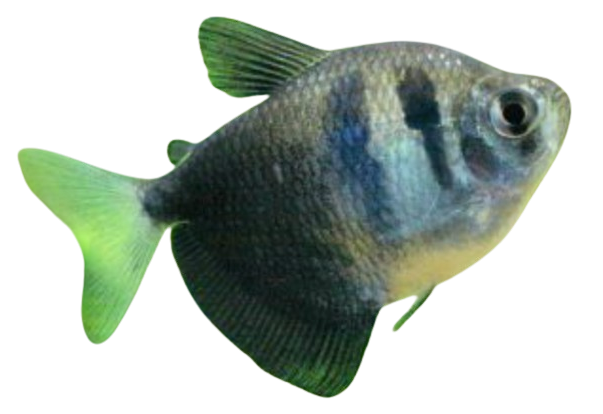
- Behaviour: Peaceful schooling fish
- Size: 5.5 cm
- Temperature: 20-26°C
- dGH: Up to 30°
- pH Range: 6.0-8.0
- Diet: Omnivorous
Black Skirt Tetra (Gymnocorymbus ternetzi)
The Black Skirt Tetra, also known as Gymnocorymbus ternetzi, is a popular choice among aquarists due to its striking appearance and peaceful temperament. Originating from the waterways of South America, particularly the Amazon and its tributaries, this tetra is known for its unique, flowing black fins that resemble a skirt, giving it its common name.
Behaviour
Black Skirt Tetras are peaceful schooling fish that thrive when kept in groups of six or more. Their social nature not only makes them more active and lively but also helps in reducing stress within the school. They are typically non-aggressive but can become fin nippers if not kept in a sufficiently large group or if housed in a tank that’s too small.
Size and Appearance
Adult Black Skirt Tetras typically reach about 5.5 cm in length. Their bodies are predominantly silver-grey with a noticeable black vertical stripe that runs through the body and fins. The distinctive ‘skirt’ of black on their fins makes them a visually appealing addition to any community tank.
Tank Conditions
- Temperature: The ideal water temperature for Black Skirt Tetras is between 20-26°C. Consistency in water temperature is crucial to prevent stress.
- Water Hardness: They adapt well to a range of water hardness but prefer a dGH of up to 30°.
- pH Range: A pH range of 6.0-8.0 is suitable, making them versatile for various community tank setups.
Diet
Black Skirt Tetras are omnivorous and are not particularly picky eaters. A diet consisting of high-quality flake food serves as a good base. However, for optimal health and colouration, it’s beneficial to supplement their diet with a variety of foods such as brine shrimp, daphnia, and freeze-dried bloodworms. Occasional vegetable supplements can also be included to provide a balanced diet.
Compatibility
Being peaceful makes them excellent candidates for community tanks. They best coexist with other peaceful fish that share similar water requirements. Avoid pairing them with large, aggressive fish as the tetras can become stressed or targeted due to their smaller size and active nature.
Additional Tips
- Regular water changes and a well-maintained tank are essential to keep these fish healthy.
- Providing plants and hiding spots in the aquarium will mimic their natural environment, helping to keep stress levels low.
The Black Skirt Tetra offers both beginner and experienced aquarists a hardy and attractive option for a well-rounded community aquarium. Their care requirements are manageable, and their peaceful nature makes them ideal companions for a variety of other fish species.
Neon Tetra (Paracheirodon innesi)
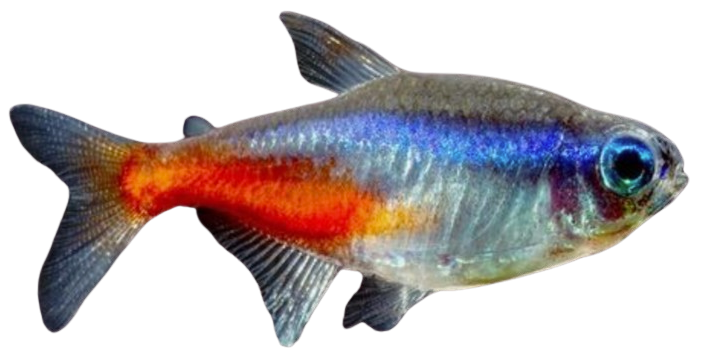
- Behaviour: Peaceful, shy schooling fish
- Size: 4 cm
- Temperature: 20-26°C
- dGH: Up to 30°, ideally around 10°
- pH Range: Around 7.0
- Diet: Flake food, food tablets, Artemia
- Note: Do not confuse with the more delicate Cardinal Tetra (P. axelrodi) or Green Neon Tetra (P. simulans).
Neon Tetra (Paracheirodon innesi): A Vibrant Gem for Your Aquarium
The Neon Tetra, with its iridescent blue line from nose to tail and a complementary red stripe that runs from the middle of the body to the base of the tail, is a standout species in the freshwater aquarium hobby. This small but striking fish is known for its peaceful and somewhat shy demeanour, making it an ideal inhabitant for community tanks.
Behaviour
Neon Tetras thrive in groups and are quintessential schooling fish. Observing a shoal of Neon Tetras moving in harmony through the water is not only calming but also a beautiful sight to behold. Their peaceful nature makes them excellent tank mates for other non-aggressive species. Due to their timid nature, they are best kept with other small, peaceful fish to avoid any potential bullying from larger, more dominant tank mates.
Ideal Tank Conditions
- Size: Neon Tetras grow up to approximately 4 cm in length, making them a perfect choice for smaller aquariums, though they do best in groups within larger tanks that provide ample space for schooling.
- Temperature: The ideal water temperature for maintaining healthy Neon Tetras is between 20-26°C.
- Water Hardness (dGH): They are adaptable to a range of water hardness up to 30°, but they thrive best in softer water, ideally around 10°.
- pH Range: A neutral pH of around 7.0 is perfect for these tetras.
Diet and Nutrition
Neon Tetras are not fussy eaters. Their diet can consist of high-quality flake food and food tablets, supplemented regularly with live or frozen foods such as Artemia (brine shrimp), which provide essential nutrients and help maintain their vibrant colouration. It’s important to feed them small amounts several times a day to avoid overfeeding and potential water quality issues.
Important Note
It is crucial not to confuse Neon Tetras with their relatives, the Cardinal Tetra (Paracheirodon axelrodi) and the Green Neon Tetra (Paracheirodon simulans), as these species require slightly different care. Cardinals, for instance, prefer even softer water and are a bit larger, necessitating slightly different environmental conditions.
Community Tank Compatibility
When setting up a community tank, Neon Tetras are an excellent choice due to their peaceful nature and stunning appearance. They do well with other peaceful fish such as small rasboras, other types of tetras, and non-aggressive bottom dwellers like Corydoras catfish. Avoid pairing them with large, aggressive eaters which might stress them out or see them as potential food.
The Neon Tetra’s blend of vibrant colours, ease of care, and peaceful temperament makes it a beloved staple in the aquarium hobby. It’s a fish that brings both life and light to the freshwater community tank, appealing to both novice and experienced aquarists alike.
Flame Tetra (Hyphessobrycon flammeus)
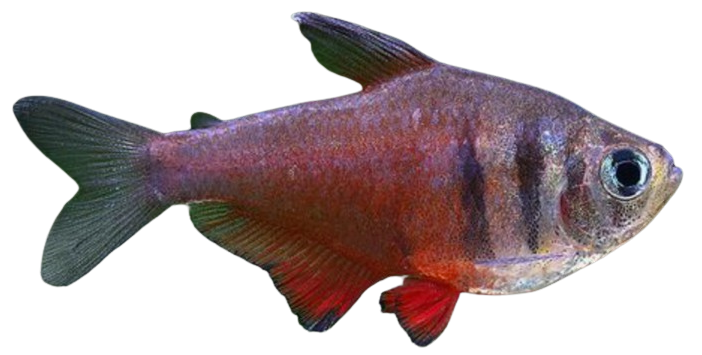
- Behaviour: Peaceful schooling fish
- Size: 4 cm
- Temperature: 22-28°C
- dGH: Up to 25°
- pH Range: 6.0-7.0
- Diet: Omnivorous
Flame Tetra (Hyphessobrycon flammeus): A Vibrant Addition to Your Aquarium
Behaviour: The Flame Tetra, known for its peaceful and sociable nature, thrives in groups and is an excellent candidate for community tanks. These schooling fish exhibit more vivid colours and engaging behaviours when kept in groups of six or more. Their peaceful temperament makes them compatible with other non-aggressive fish, contributing to a harmonious aquarium environment.
Size: The Flame Tetra is a small-sized fish, reaching up to about 4 cm in length. Its petite size makes it ideal for smaller aquarium setups, but care should be taken to ensure they are not housed with large or aggressive fish that might see them as prey.
Temperature: Flame Tetras are adaptable to various water temperatures, thriving in a range between 22-28°C. This flexibility makes them suitable for many home aquariums without the need for stringent temperature control.
Water Hardness and pH: These tetras are adaptable to a range of water conditions but prefer a dGH up to 25°, which corresponds to moderately soft to slightly hard water. They are best kept in slightly acidic to neutral water, with a pH range of 6.0 to 7.0, mimicking their natural Amazonian habitat.
Diet: Flame Tetras are omnivorous, which means they have a varied diet that should include both plant-based and protein-rich foods. They will readily eat high-quality flake foods, but for optimal health and colouration, their diet should be supplemented with live or frozen foods such as brine shrimp or daphnia. Occasional vegetable supplements can also be beneficial.
Aquarium Care: Setting up the ideal tank for Flame Tetras involves incorporating plenty of plants and hiding spaces to replicate their natural environment. They appreciate areas of low to moderate current and subdued lighting, which can be achieved with floating plants or by positioning the lighting strategically to create shaded areas within the tank.
Community Tank Compatibility: Flame Tetras are well-suited for community tanks with other peaceful fish of similar size. They can be kept with other small tetras, danios, rasboras, and non-aggressive bottom dwellers like Corydoras catfish. Avoid pairing them with large, aggressive fish that may stress or harm them.
Adding Flame Tetras to your aquarium not only brings a dash of color but also activity and life. Their ease of care and striking appearance make them a beloved choice for both novice and experienced aquarists alike.
Siamese Algae Eater (Crossocheilus siamensis)
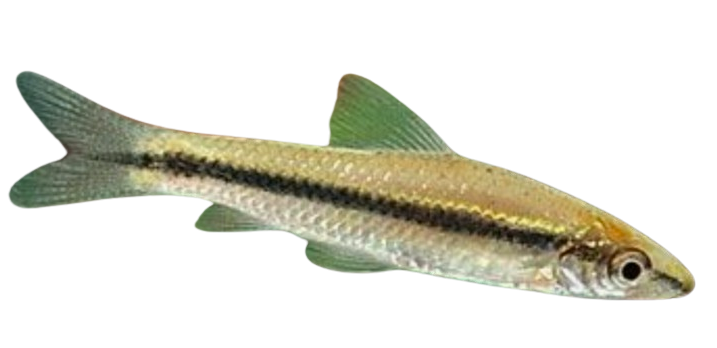
- Behaviour: Generally peaceful but can be territorial with its species
- Size: 14 cm
- Temperature: 23-26°C
- dGH: Up to 10°
- pH Range: 6.5-7.0
- Diet: Algae, vegetables, varied live foods, flake food, food tablets
Siamese Algae Eater (Crossocheilus siamensis)
Overview The Siamese Algae Eater (SAE) is a prized aquarium inhabitant, renowned for its efficacy in controlling algae growth in freshwater tanks. This fish is characterized by a sleek, elongated body and a distinct black stripe running from its snout to the base of the tail fin. Despite its peaceful nature, it can exhibit territorial behaviour towards other members of its species, making careful management of its social environment important.
Behaviour
- Social Interaction: Generally peaceful, the Siamese Algae Eater can coexist well with a variety of tank mates. However, it can be territorial towards other algae eaters, including its kind. To minimize aggression, it is advisable to keep them either singly or in larger groups in spacious tanks where they can establish their territories without conflict.
- Activity Level: This species is active and spends most of its time grazing on surfaces within the aquarium, making it an engaging addition to observe.
Size
- Maximum Length: Approximately 14 cm (5.5 inches), which requires consideration for adequate tank size to ensure optimal health and mobility.
Water Conditions
- Temperature: Ideal water temperatures range from 23°C to 26°C (73°F to 79°F).
- dGH: They thrive in water hardness up to 10 dGH, preferring softer water conditions.
- pH Range: The preferred pH level is slightly acidic to neutral, between 6.5 and 7.0.
Diet
- Primary Diet: Algae is the staple of their diet, but reliance solely on tank algae can lead to nutritional deficiencies.
- Supplementary Feeding: It is crucial to supplement their diet with various foods such as blanched vegetables (zucchini, cucumbers, and peas are favourites), high-quality flake foods, and occasional live or frozen foods like bloodworms or brine shrimp to ensure a balanced diet.
- Feeding Strategy: Offer a varied diet to prevent nutritional deficiencies and ensure robust health. Feeding should be regulated to prevent overeating and maintain optimal water quality.
Aquarium Care Tips
- Tank Setup: Incorporate plenty of live plants and driftwood, which not only contribute to the tank’s ecosystem by providing hiding spots but also encourage natural algae growth for the SAE to graze on.
- Compatibility: Ideal tank mates include other peaceful community fish. Avoid housing them with aggressive species or very small, timid fish that could be stressed by the SAE’s active nature.
- Maintenance: Regular water changes and monitoring of water parameters are essential to maintain the health of Siamese Algae Eaters and their environment.
Incorporating Siamese Algae Eaters into an aquarium not only helps in maintaining cleaner, algae-free glass and decor but also adds a level of dynamism to the aquatic scene. Their presence is beneficial to the overall health of the aquarium, provided their specific care needs are met.
Copper Tetra (Hasemania nana)
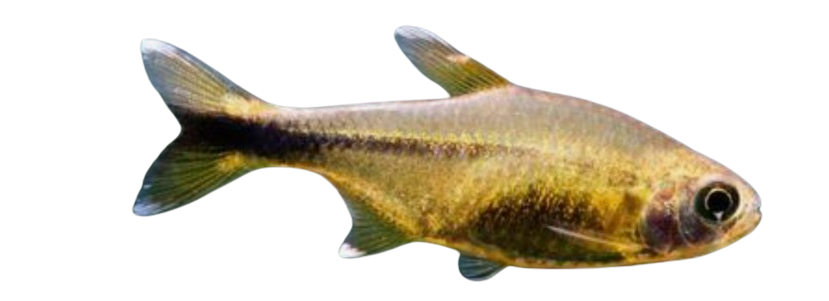
- Behavior: Peaceful schooling fish
- Size: 5 cm
- Temperature: 22-28°C
- dGH: Up to 25°
- pH Range: 6.0-7.0
- Diet: Flake food, food tablets, Artemia
Copper Tetra (Hasemania nana): A Vibrant Addition to Any Freshwater Aquarium
Overview: The Copper Tetra, also known as Hasemania nana, is a charming and vibrant schooling fish that brings a flash of brilliance to any aquarium. Originating from the clear waters of Brazil, these fish are prized for their shimmering copper colour and lively behaviour.
Ideal Conditions:
- Size: Typically reaches about 5 cm in length, making them a perfect choice for smaller to medium-sized tanks.
- Temperature: Thrives in warmer water, between 22-28°C, which should be stable to avoid stress.
- Water Hardness: Adapts well to a range of water conditions, but prefers a general hardness of up to 25° dGH.
- pH Range: Best kept in slightly acidic to neutral water, with pH levels between 6.0 and 7.0.
Behaviour and Compatibility: Copper Tetras are peaceful fish that do best in groups of six or more, as their schooling nature helps them feel secure and reduces stress. Their gentle temperament makes them ideal tank mates for other peaceful fish of similar size. However, they might not do well with larger, more aggressive species.
Dietary Needs: Their diet is quite straightforward, which is one of the reasons they are recommended for beginners. They are not fussy eaters and will readily accept flake food, food tablets, and occasionally, live foods such as Artemia (brine shrimp). Offering a mix of these foods not only ensures balanced nutrition but also enhances their vibrant colouration.
Aquarium Setup: Copper Tetras are active swimmers and appreciate space to roam. An aquarium with plenty of swimming room and a few planted areas mimics their natural environment and contributes to their well-being. They are mid-water dwellers, so ensure their space is not overcrowded with decorations. Moderate lighting and a substrate of fine sand or small pebbles complete their habitat needs.
Health and Care: Regular maintenance, including partial water changes and monitoring of water quality, is crucial to keep these tetras healthy. They are relatively hardy but can be susceptible to common fish ailments if water conditions deteriorate.
Breeding: Breeding Copper Tetras in home aquariums can be a rewarding experience, though a bit challenging for a novice. They require specific breeding conditions with softer water and a slightly lower pH. Eggs are usually scattered among plants, and fry emerge requiring fine, infusorial-type food.
White Cloud Mountain Minnow (Tanichthys albonubes)

- Behavior: Peaceful schooling fish
- Size: 4 cm
- Temperature: 16-26°C
- dGH: Up to 20°
- pH Range: 6.0-7.5
- Diet: Omnivorous
Spotlight on White Cloud Mountain Minnow (Tanichthys albonubes)
Overview: The White Cloud Mountain Minnow, affectionately known as the “White Cloud,” is a gem in the world of freshwater aquatics. Originating from the cool streams of China’s White Cloud Mountains, this fish is highly recommended for beginners due to its hardiness and undemanding nature.
Behaviour: White Cloud Mountain Minnows are peaceful and thrive best in small schools. Their gregarious nature makes them excellent additions to community tanks where they add activity and color without aggression. They are particularly suited for the upper and middle levels of the aquarium, where they gracefully swim and interact with their environment and tank mates.
Size and Appearance: Reaching up to 4 cm in length, these small fish are not only manageable in size but also strikingly beautiful. They exhibit a silvery body with a horizontal stripe running from the nose to the tail, which can shimmer with iridescent colours under the right lighting conditions. During breeding, males become especially vibrant, displaying richer colours and finnage.
Aquarium Conditions:
- Temperature: White Clouds are adaptable to a wide range of temperatures from 16°C to 26°C, making them suitable for unheated tanks as long as the environment remains stable.
- Water Hardness: They are tolerant of a variety of water conditions with a general hardness of up to 20 dGH.
- pH Levels: Ideal pH levels for their health and well-being range from 6.0 to 7.5, reflecting their natural mildly acidic to neutral water habitats.
Diet: Omnivorous by nature, White Cloud Mountain Minnows are not fussy eaters. A diet of high-quality flake foods, supplemented with small, live or frozen foods such as daphnia or brine shrimp, ensures they receive adequate nutrition. Occasional vegetable supplements can also be beneficial.
Tank Setup: A setup mimicking their natural habitat will include a well-planted aquarium with ample swimming space. They appreciate a gentle current and plenty of hiding spots among plants and rocks. Although they are tolerant of lower temperatures, consistent conditions without drastic changes are crucial for their health.
Community Compatibility: Their peaceful disposition makes them compatible with many other non-aggressive species of similar size. Avoid pairing them with large or aggressive fish that may see them as prey.
Sumatra Barb (Barbus tetrazona)
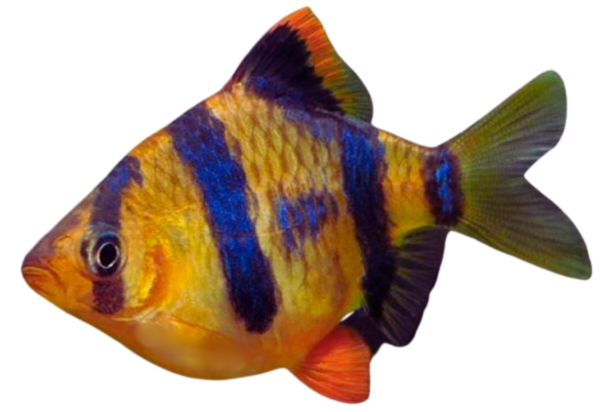
- Behavior: Active schooling fish
- Size: 7 cm
- Temperature: 20-27°C
- dGH: Up to 10°
- pH Range: 6.5-7.5
- Diet: Omnivorous
Spotlight on the Sumatra Barb (Tiger Barb – Barbus tetrazona)
The Sumatra Barb, popularly known as the Tiger Barb, is a vibrant and energetic addition to many freshwater aquariums. Recognized for its striking colouration and lively behaviour, this species is a favourite among both novice and experienced aquarists.
Characteristics and Care
- Behaviour: The Tiger Barb is known for its active and sometimes boisterous nature. It thrives in groups and can exhibit nipping behaviour if not kept in sufficient numbers or if housed with fish that have long fins. To avoid aggressive tendencies, it’s recommended to keep them in schools of six or more.
- Size: This species typically grows to about 7 cm in length, making it a suitable choice for medium-sized tanks.
- Optimal Water Conditions:
- Temperature: The ideal water temperature for Tiger Barbs ranges from 20°C to 27°C.
- General Hardness (GH): They prefer softer water conditions, with hardness up to 10°.
- pH Range: A slightly acidic to neutral pH of 6.5-7.5 is optimal.
- Diet: Tiger Barbs are omnivorous and will accept a wide variety of foods. Their diet should include high-quality flake foods, pellets, and occasional treats of live or frozen foods such as brine shrimp, daphnia, and bloodworms to ensure proper nutrition and colour vibrancy.
Aquarium Setup
When setting up an aquarium for Tiger Barbs, consider their need for swimming space and areas to explore. They do well in planted aquariums that also offer open areas for swimming. Decors such as rocks and driftwood can add structural interest and hiding places, creating a dynamic environment for these active fish.
Compatibility
Due to their nippy nature, it’s essential to choose tank mates carefully. Ideal companions include other fast-moving and similarly sized species. Slow-moving or long-finned fish should generally be avoided to prevent fin-nipping incidents.
Summary
The Tiger Barb is a delightful species that brings energy and colour to a compatible community tank. With appropriate care, the right group size, and suitable tank mates, they can make a visually appealing and enjoyable addition to your aquatic family.
Kribensis (Pelvicachromis pulcher)
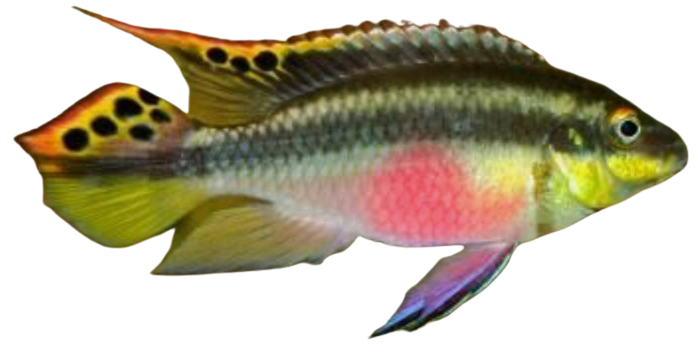
- Behavior: Relatively peaceful, territorial when breeding
- Size: 10 cm
- Temperature: 23-27°C
- dGH: Up to 10°
- pH Range: 6.0-7.0
- Diet: Live food, flake food
Kribensis (Pelvicachromis pulcher): A Vibrant Addition to Your Aquarium
Behaviour: The Kribensis is known for its relatively peaceful demeanour, making it a wonderful addition to many community tanks. However, it’s important to note that this species can become territorial during breeding periods. To minimize aggression, provide ample space and hiding spots such as caves or dense vegetation. This allows non-breeding fish a refuge and gives breeding pairs a private area to guard.
Size: The Kribensis typically grows to about 10 cm in length, making it a manageable size for most aquariums. Its size allows it to be housed in smaller tanks compared to larger cichlid species, though a larger tank is beneficial for maintaining water quality and reducing stress.
Water Conditions:
- Temperature: The ideal water temperature for Kribensis ranges from 23 to 27°C. Consistent temperature helps prevent stress and promotes healthy immune function.
- General Hardness (GH): Up to 10°. They thrive in moderately soft to slightly hard water, accommodating a range of water conditions.
- pH Range: 6.0 to 7.0. They prefer slightly acidic to neutral pH levels, which can be achieved through careful monitoring and regular water changes.
Diet: Kribensis are not particularly picky eaters. Their diet can include a variety of live foods, such as brine shrimp and bloodworms, which are particularly beneficial during breeding as they help induce spawning. For regular feeding, high-quality flake food or pellets designed for cichlids provide a balanced diet. Supplementing with vegetable matter or blanched vegetables can also promote optimal health and colouration.
Aquarium Setup: When setting up an aquarium for Kribensis, include plenty of substrate for them to sift through and areas to explore. They are known to dig, so choose a substrate that is not too coarse to prevent injury. Plants, either real or artificial, provide excellent cover and contribute to the natural environment that Kribensis favour.
Breeding: Kribensis are one of the easier cichlid species to breed in captivity. They are cave spawners, so providing them with appropriate caves or similar structures will encourage breeding behaviours. Once a pair forms, they will clean a flat surface inside their chosen cave where the female will lay eggs. Both parents typically show excellent parental care, guarding the eggs and later, the fry.
The Kribensis is a colourful and engaging species that adds a splash of colour and activity to any tank. With their interesting behaviours and manageable care level, they are a great choice for both novice and experienced aquarists looking to add some diversity to their aquatic community.
If you’re planning to integrate Kribensis into your tank, it’s a good idea to consider their social and environmental needs to ensure they thrive and display their best colours and behaviours.
African Butterfly Cichlid (Anomalochromis thomasi)
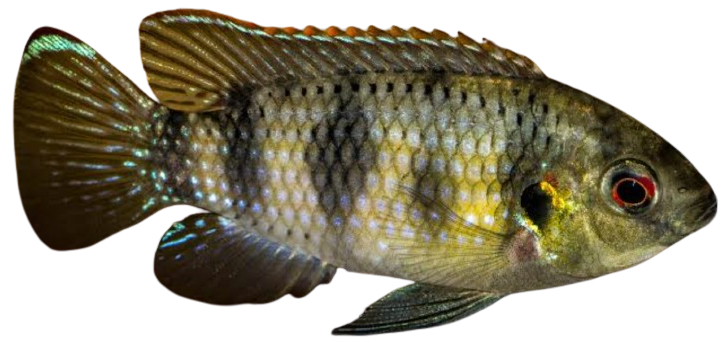
- Behavior: Peaceful, pair-forming and territory-establishing
- Size: 10 cm
- Temperature: 23-27°C
- dGH: Up to 25°
- pH Range: 6.0-7.0
- Diet: Live food, flake food
African Butterfly Cichlid (Anomalochromis thomasi) – A Profile
The African Butterfly Cichlid, Anomalochromis thomasi, is a captivating species that combines beauty with a manageable care level, making it an appealing choice for both novice and experienced aquarists. This fish is known for its peaceful demeanour and interesting social behaviours, which include pair bonding and territory formation.
Key Characteristics and Care Requirements
Behavioural Traits:
- Peaceful and Sociable: African Butterfly Cichlids are generally peaceful, especially compared to many other cichlids. They tend to form monogamous pairs and are known to establish and defend territories within the aquarium. This territorial behaviour is most prominent during breeding times but is typically non-aggressive towards other species.
- Pair-forming: They often pair off for breeding, and these pairs can show increased cooperation and bonding, providing a fascinating display of cichlid social structure.
Size and Growth:
- Moderate Size: Reaching up to 10 cm in length, African Butterfly Cichlids are suitable for a variety of aquarium sizes, from community tanks to more specialized setups. Their size makes them substantial enough to be visually impactful while still being manageable in terms of tank requirements.
Water Conditions:
- Temperature: These cichlids thrive in warmer water, with ideal temperatures ranging from 23 to 27°C. Consistency in water temperature is crucial to avoid stress.
- Water Hardness and pH: They are adaptable to a range of water hardness up to 25 dGH and prefer a pH range between 6.0 and 7.0. Regular monitoring and maintenance of water conditions are essential to keep these fish healthy.
Dietary Needs:
- Varied Diet: Their diet should include a mix of live foods and high-quality flake foods. Live foods can include small worms and brine shrimp, which not only provide nutrition but also encourage natural foraging behaviours. Flake food should be balanced to ensure a comprehensive intake of nutrients.
- Feeding Practices: Feed them small amounts multiple times a day to mimic natural feeding habits and prevent overfeeding.
Aquarium Setup:
Setting up an appropriate environment for African Butterfly Cichlids involves creating a tank landscape with plenty of hiding spaces and territories. Rocks, plants, and caves are essential to replicate their natural habitat and provide spaces for retreat and breeding. The tank should also offer open swimming areas to accommodate their active swimming habits.
Due to their territorial nature, it’s advisable to carefully consider tank mates. They do well with other peaceful fish that do not invade their chosen territories. Regular tank maintenance, including water changes and checks for water quality, will help prevent diseases and keep the environment healthy for these engaging cichlids.
Adding African Butterfly Cichlids to an aquarium not only brings a touch of exotic beauty but also offers an opportunity to observe some of the intriguing behaviours typical of cichlids, making them a rewarding choice for many aquarists.
Blue Gourami (Trichogaster trichopterus)
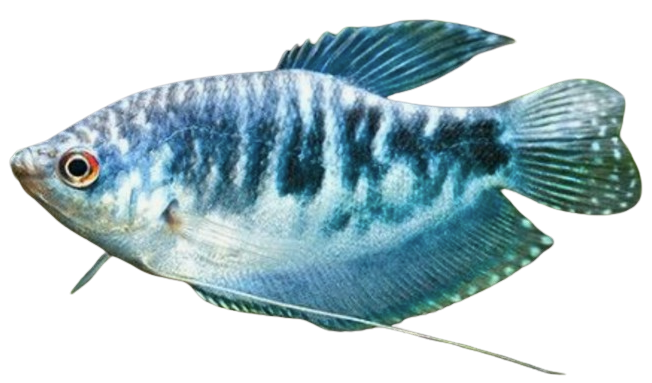
- Behavior: Very peaceful, avoid keeping multiple males together
- Size: 10 cm
- Temperature: 24-28°C
- dGH: Up to 30°
- pH Range: 6.0-8.5
- Diet: Omnivorous
Detailed Profile: Blue Gourami (Trichogaster trichopterus)
The Blue Gourami is a captivating species known for its stunning silvery-blue colouration and peaceful demeanour, making it a favourite among both novice and experienced aquarium enthusiasts. Here’s a breakdown of what you need to know to provide a healthy environment for this elegant fish.
Behaviour
Blue Gouramis are generally very peaceful, but they can exhibit territorial behaviours, particularly among males. It’s advised to keep a single male in a tank to avoid aggressive confrontations. They are adaptable and can thrive in community tanks with other peaceful fish of similar size. However, they should not be housed with very small, active, or aggressive species, as this can lead to stress.
Size and Growth
Reaching up to 10 cm in length, the Blue Gourami is a moderate-sized fish that requires ample space to swim and explore. They are not overly active swimmers but do appreciate room to manoeuvre and places to retreat when they feel the need for privacy.
Water Conditions
- Temperature: The ideal water temperature for Blue Gouramis is between 24°C and 28°C. Consistent temperatures on the higher end of the spectrum encourage more active behaviour and robust health.
- General Hardness (dGH): They are adaptable to a range of water hardness, up to 30° dGH, making them suitable for various tap water conditions.
- pH Range: Blue Gouramis are tolerant of pH levels from 6.0 to 8.5, but stable water conditions are crucial to prevent stress and health issues.
Diet and Feeding
Blue Gouramis are omnivores and are not particularly demanding when it comes to their diet. They will readily eat a variety of foods, including:
- Flake food
- Pellets
- Freeze-dried foods
- Small live or frozen foods such as bloodworms and brine shrimp
It’s important to offer a balanced diet that includes both plant-based and protein-rich foods to ensure optimal health and colouration. Overfeeding should be avoided, especially in community tanks, as Blue Gouramis can become overweight if given the chance.
Tank Setup
A tank of at least 75 litres (20 gallons) is recommended for Blue Gouramis, with larger being better to accommodate their territorial nature and ensure they have enough space to establish personal territories. The tank should include:
- Plenty of hiding spots such as caves, plants (either live or artificial), and driftwood.
- A gentle filtration system to keep the water clean without creating strong currents, as they prefer calmer waters.
Compatibility
Blue Gouramis can coexist with a variety of other peaceful fish that share similar water requirements. Suitable tank mates include other types of gouramis (as long as males are not housed together), tetras, barbs, and danios. Avoid keeping them with aggressive fish or fin-nippers, which can stress or harm the Blue Gourami.
In summary, the Blue Gourami is a stunning and peaceful addition to many community aquariums. With proper care, stable water conditions, and a balanced diet, they can be a joy to watch and relatively easy to maintain.
Pearl Gourami (Trichogaster leeri)
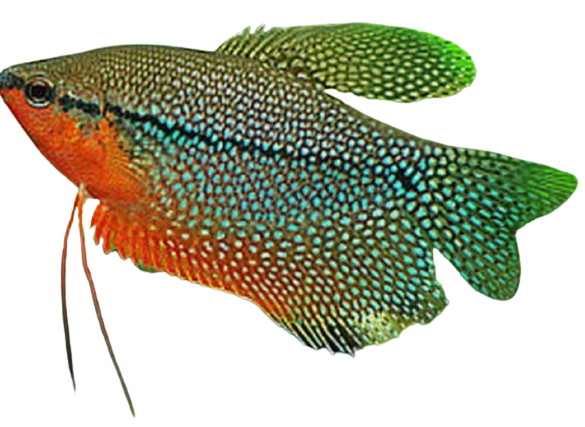
- Behavior: Very peaceful, avoid keeping multiple males together
- Size: 12 cm
- Temperature: 23-28°C
- dGH: Up to 20°
- pH Range: 6.5-8.5
- Diet: Omnivorous
Pearl Gourami (Trichogaster leeri)
Overview: The Pearl Gourami is a stunning freshwater fish that is revered for its delicate and ornate appearance. With a body that is silvery in color, and sprinkled with a constellation of tiny pearl-like spots, it is not only a visual delight but also a peaceful addition to most community aquariums.
Behaviour: Pearl Gouramis are known for their very peaceful demeanour, making them excellent inhabitants of community tanks. However, they do have a hierarchical social structure when kept with other Pearl Gouramis, particularly among males. It is generally advisable to keep them in either a single male with females or in a larger tank where more males have enough space to establish territories without conflict. They are also somewhat shy and benefit from having plenty of vegetation and hiding places in their environment.
Size and Growth: Growing up to about 12 cm in length, Pearl Gouramis are moderately sized and can thrive in a range of tank sizes, from medium to larger home aquariums.
Water Conditions: Pearl Gouramis prefer a temperature range of 23-28°C, which should be stable to avoid stress. They are adaptable to a range of water hardness up to 20 degrees dGH and a pH range of 6.5 to 8.5. However, they do best in slightly acidic to neutral water. Regular water changes and maintenance are crucial to keep these fish healthy, as they are sensitive to poor water quality.
Diet: Omnivorous by nature, Pearl Gouramis will accept a wide variety of foods. Their diet can include high-quality flake foods, and pellets, as well as frozen or live foods such as bloodworms, brine shrimp, and daphnia. It is important to provide a varied diet to ensure optimal health and colouration. Vegetative matter, such as blanched spinach or zucchini, can also be occasionally offered.
Aquarium Setup: An ideal setup for Pearl Gouramis includes plenty of plant life, both floating and rooted, which provides cover and helps the fish feel secure. They also appreciate some open areas for swimming. Dim lighting or shaded areas created by floating plants can help mimic their natural habitat and reduce stress.
Compatibility: Pearl Gouramis are typically good tank mates with other peaceful fish of similar size. They should not be housed with very large or aggressive species that could intimidate or harass them. Their calm nature makes them perfect for living alongside other community fish such as tetras, rasboras, and smaller catfish.
In conclusion, the Pearl Gourami is a beautiful and serene fish that, with proper care and an appropriate environment, can be a rewarding addition to many freshwater aquariums. It’s easy-going nature and striking appearance make it a favourite among both novice and experienced aquarists.
Paradise Fish (Macropodus opercularis)
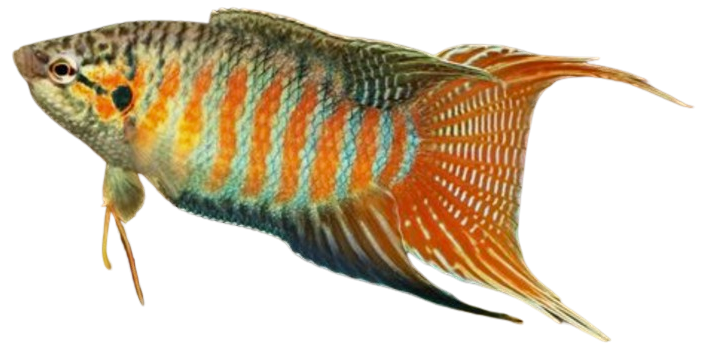
- Behavior: Relatively peaceful, avoid multiple males in small tanks
- Size: 10 cm
- Temperature: 18-26°C
- dGH: Up to 30°
- pH Range: 6.0-8.0
- Diet: Robust live food, flake food
Paradise Fish (Macropodus opercularis): A Vibrant Addition to Your Aquarium
Overview The Paradise Fish, known scientifically as Macropodus opercularis, is a striking and hardy species often recommended for aquarists with some experience. Native to East Asia, this species is admired for its vivid colours and elegant finnage.
Behavioural Traits Paradise Fish are relatively peaceful but exhibit a degree of territorial aggression, particularly among males. It’s crucial to avoid housing multiple males in small tanks to prevent aggressive confrontations. They can generally coexist with other species that are not overly timid or smaller enough to be considered prey. Their assertive nature makes them an excellent choice for a community tank with other semi-aggressive fish of similar size.
Aquarium Setup A tank for Paradise Fish should be at least 20 gallons to provide ample space for swimming and territories. The setup should include plenty of hiding places using plants, rocks, or aquarium decorations. These structures not only provide refuge but also help break lines of sight, reducing stress and aggression. The inclusion of floating plants can mimic their natural environment, providing shaded areas and enhancing their comfort.
Water Conditions Paradise Fish are adaptable to a wide range of water conditions, making them a robust species for varying climates. They thrive in temperatures between 18°C and 26°C, which allows them to be kept in many indoor settings without the need for additional heating. The pH should be maintained between 6.0 and 8.0, and a general hardness (dGH) of up to 30° is acceptable, reflecting their tolerance for both soft and hard water.
Diet The diet of Paradise Fish should include a variety of foods to ensure optimal health and colouration. They are not particularly fussy eaters but thrive on a diet that includes robust live foods such as brine shrimp, bloodworms, and small insects, as well as high-quality flake foods. Occasional vegetable supplements can also be beneficial, although they primarily prefer protein-rich foods.
Breeding Paradise Fish are bubble nest builders. The male constructs a nest from air bubbles and plants at the water’s surface, into which the female lays her eggs during spawning. The male then guards the nest and fry with great diligence. Breeding them can be a rewarding experience but requires careful monitoring to ensure the female is not harmed by the male’s aggressive protective instincts.
Summary With their vibrant appearance and engaging behaviour, Paradise Fish are a fascinating species for aquarists looking to add some colour and activity to their tanks. Their care requirements are manageable, but attention to their aggressive tendencies and environmental needs is crucial for maintaining a harmonious aquarium.
Otocinclus Catfish (Otocinclus affinis)
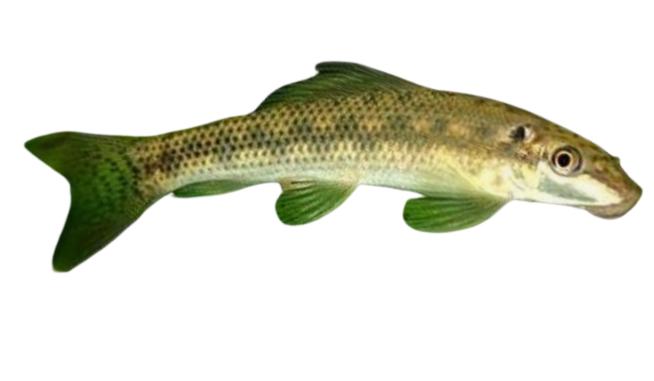
- Behaviour: Peaceful, best kept in groups
- Size: 4.5 cm
- Temperature: 20-27°C
- dGH: Up to 20°
- pH Range: 5.0-7.5
- Diet: Algae, food tablets
Otocinclus Catfish: The Gentle Algae Eater
The Otocinclus Catfish, often simply called “Oto,” is a small yet highly effective algae eater, making it a popular choice among aquarium enthusiasts. Its gentle disposition and diminutive size make it an excellent addition to a community tank, particularly one with small, peaceful fish.
Key Characteristics and Care
Behaviour: The Otocinclus is known for its peaceful nature. These fish thrive in groups and are more active and healthier when kept with several of their kind. The social interactions in a group can also be quite fascinating to observe.
Size: The Oto remains relatively small, reaching only about 4.5 cm in length, which makes it ideal for smaller aquariums starting from 10 gallons (about 38 litres).
Temperature: This species is adaptable to a range of temperatures but prefers water between 20°C and 27°C. Stability in water temperature is crucial to prevent stress.
Water Hardness and pH: Otocinclus Catfish can tolerate a general hardness of up to 20° dGH, making them suitable for moderately hard water. They prefer a pH range from 5.0 to 7.5, which aligns them with many community tank setups.
Diet: Otos are primarily algae eaters. They will graze on soft green algae growing on tank surfaces and plants. However, their diet should be supplemented with algae wafers or food tablets to ensure they receive sufficient nutrition, especially in newer tanks where algae might not be abundant. Occasionally, blanched vegetables like zucchini or cucumber can also be offered.
Health and Environment Considerations
Otocinclus Catfish are known for being sensitive to water conditions. They require a well-established tank with mature filtration to thrive because they are susceptible to fluctuations in water quality. It’s important to acclimate them slowly and carefully when introducing them to a new tank to prevent shock.
These catfish often spend their time attached to the glass or decorations, cleaning surfaces throughout the day. They are particularly beneficial in planted tanks where they help control algae without damaging the plants.
Compatibility
Otos are non-aggressive and can be kept with a wide variety of tank mates. Ideal companions include other peaceful fish such as tetras, guppies, and mollies. Their calm nature means they should not be housed with large or aggressive species that may bully or harm them.
Conclusion
The Otocinclus Catfish is an excellent choice for aquarists of all levels due to its beneficial algae-eating habits and minimal space requirements. Keeping them in groups helps to ensure their well-being, making them not only a practical choice for algae control but also a delightful group to watch as they interact in your aquarium.
Corydoras Catfish (Various species)
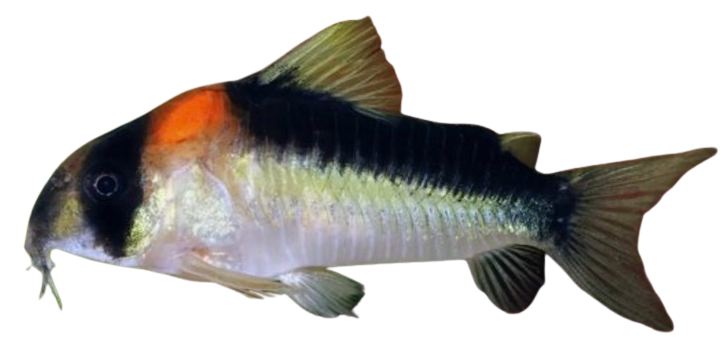
- Behavior: Peaceful schooling fish
- Size: Approximately 7 cm
- Temperature: 22-27°C
- dGH: Up to 20°
- pH Range: 6.0-7.5
- Diet: Live food (especially red mosquito larvae), food tablets
Corydoras Catfish: Gentle and Gregarious Bottom Dwellers
Overview Corydoras Catfish, commonly referred to as “Cories,” belong to a genus of over 160 species, each known for their peaceful demeanour and adorable appearance. These small, armoured catfish are indispensable members of many freshwater aquariums due to their bottom-cleaning habits. They help maintain a clean substrate by scavenging for leftover food and debris, which makes them not only charming but also beneficial.
Behaviour and Social Structure Corydoras are quintessential schooling fish and thrive in groups. Keeping them in groups of at least five or six helps promote natural behaviour, reducing stress and increasing their activity levels. In a well-settled group, Corydoras exhibit more confidence, often seen actively foraging together. Their peaceful nature makes them excellent tank mates for other gentle species.
Physical Characteristics and Size Typically, Corydoras grow to about 7 cm in length. They have unique armour plating over their bodies and are equipped with twin barbels that help them sift through the substrate for food. Their diverse colouration and patterning vary significantly between species, adding a delightful variety to their visual appeal.
Aquarium Conditions Corydoras are adaptable but prefer soft to moderately hard water with temperatures ranging between 22°C and 27°C. They are not overly sensitive to pH but thrive best in a range between 6.0 and 7.5. The aquarium should have a soft, sandy substrate to prevent damage to their delicate barbels. They also appreciate plenty of hiding spots provided by plants, rocks, and driftwood.
Dietary Needs A well-balanced diet for Corydoras should include high-quality sinking pellets or tablets, which ensures that the food reaches the bottom where they feed. They are also fond of live foods such as red mosquito larvae, which not only provide nutritional benefits but also stimulate their natural foraging behaviour. Occasional treats of frozen foods like bloodworms or brine shrimp can be offered to supplement their diet.
Breeding Corydoras are also known for their unique breeding behaviour, often stimulated by a change in water temperature during water changes. Observing their breeding rituals and the subsequent care of their eggs can be a fascinating experience for any aquarist.
Community Integration Thanks to their peaceful nature, Corydoras are perfect for community tanks. They coexist well with other small, peaceful fish and contribute to a harmonious and balanced aquarium environment. Avoid pairing them with large, aggressive fish that may bully or harm these gentle bottom dwellers.
In conclusion, Corydoras Catfish are excellent for both novice and experienced aquarists. Their gentle temperament, interesting behaviours, and beneficial cleaning habits make them a valuable and delightful addition to any freshwater aquarium.
Blauer Antennenwels (Common Bristlenose Pleco - Ancistrus dolichopterus)
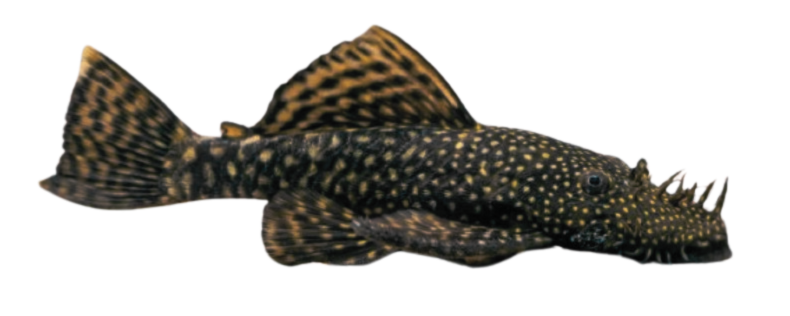
- Behaviour: Peaceful, best kept in pairs; ensure adequate hiding spots as it is nocturnal.
- Size: Up to 13 cm
- Temperature: 23-27°C
- General Hardness (GH): Up to 30°
- pH Range: 6.0-7.5
- Preferred Regions in the Aquarium: Bottom layers
- Diet: Algae, food tablets, cooked carrots
Comprehensive Guide to the Care of Blauer Antennenwels (Common Bristlenose Pleco – Ancistrus dolichopterus)
The Blauer Antennenwels, commonly known as the Bristlenose Pleco, is a favoured choice among aquarists, particularly for those just beginning their aquarium adventures. This species is renowned not only for its distinctive appearance but also for its beneficial role in the aquarium ecosystem.
Peaceful and Practical: The Nature of the Bristlenose Pleco
As a peaceful and generally sociable species, the Bristlenose Pleco thrives best when kept in pairs or small groups, which helps to foster a stable social environment. They are nocturnal, meaning that much of their activity takes place during the night. During the day, these fish prefer the tranquillity of shaded areas and require ample hiding spots. Providing structures like caves, driftwood, and dense plants will not only make them feel secure but also mimic their natural habitat, contributing to their overall health.
Size and Environmental Needs
Bristlenose Plecos can grow up to 13 cm in length, making them a manageable size for most aquariums. They are adaptable to a range of water conditions, capable of thriving in temperatures from 23°C to 27°C and in water hardness up to 30 dGH. The pH of their aquatic environment should ideally be maintained between 6.0 and 7.5, reflecting the slightly acidic to neutral water of their native habitats.
Dietary Habits
One of the key reasons the Bristlenose Pleco is particularly valued is its diet. These fish are primarily herbivores, with a strong preference for algae, which makes them natural aquarium cleaners. In addition to algae, it is beneficial to supplement their diet with food tablets specially formulated for bottom feeders and occasional treats like cooked carrots, which provide necessary nutrients and variety. This dietary diversity is crucial not only for their nutrition but also for the health of their digestive system.
Importance of Habitat Configuration
The setup of the aquarium is vital for the well-being of Bristlenose Plecos. As bottom dwellers, they are often found near the substrate level of the aquarium. It is important to ensure that the bottom of the tank is not overly cluttered with decorations that could obstruct their movement or injure them. Sand or fine gravel substrates are recommended as they provide a soft surface for the plecos to sift through without causing harm to their delicate barbels.
Tank Maintenance and Water Quality
While Bristlenose Plecos help keep the tank clean by eating algae, maintaining overall water quality is essential. Regular water changes, proper filtration, and monitoring of water parameters are crucial to prevent the build-up of harmful toxins that could stress or harm your fish. Gentle water flow and filtration not only keep the water clean but also emulate the gentle river currents of their natural environment.
By following these guidelines, aquarists can ensure that their Bristlenose Plecos not only survive but thrive, adding both beauty and utility to the freshwater aquarium. This species is more than just a pet; it is a gateway to understanding more complex aspects of aquatic life and aquarium care, making it an excellent choice for both novice and experienced fishkeepers.
The Role of Snails in Aquatic Ecosystems
Overview of Gastropoda
Snails, classified scientifically as Gastropoda, are a subgroup of molluscs (Mollusca). There are approximately 103,000 known species worldwide. About half of these live in the sea, a third on land, and around 10,000 species thrive in freshwater environments. In Germany alone, there are about 70 freshwater species. The anatomy of a snail consists of the head, the foot, the visceral mass, and the mantle. A significant feature, the mantle fold, located between the foot and the mantle, is responsible for the construction of the snail’s shell. The shell itself comprises three layers: the outer layer (Periostracum) is horn-like and durable, followed by the prismatic layer and the nacreous layer, commonly known as mother-of-pearl.
Anatomy Details
The tip of the shell is called the apex, while the transitions from one whorl to the next are known as sutures. In some species, the whorls do not touch at the axis, creating an opening known as the umbilicus.
Snails in the Aquarium
Almost every aquarium houses snails; they are small, unobtrusive, and generally not bothersome. In modest numbers, snails are quite beneficial as they graze on algae, consume leftover food, and help decompose overlooked dead fish, thus maintaining hygiene in the aquarium. However, they can also become a nuisance. An overabundance of snails can mar the aesthetic of an aquarium and detract from its cleanliness. Often, snails are introduced into aquariums through aquatic plants. If a few snails are left in a bowl overnight, by the next day, it might be filled with excrement, a factor that could lead to significant dirt accumulation in the tank without obvious immediate signs.
Malayan Trumpet Snails: Essential Custodians of the Aquarium
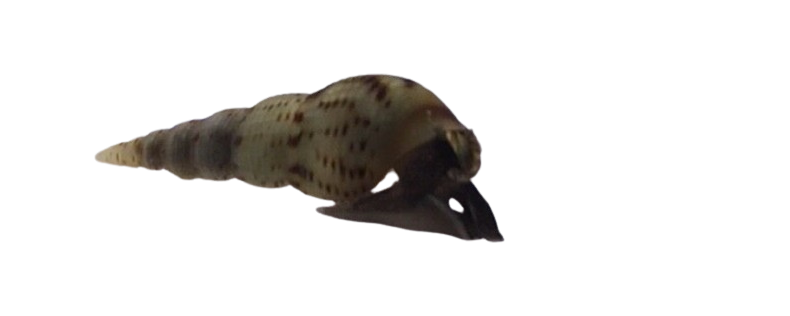
Overview
Malayan Trumpet Snails (Melanoides spec.) are live-bearing, hermaphroditic creatures that play a pivotal role in maintaining aquarium health. Far from being a threat to fish, these snails are beneficial as they burrow through the substrate while searching for food, helping to aerate and clean it.
Optimal Conditions
Comfortable in temperatures ranging from 20 to 30°C, these snails can grow up to about 25mm in size. They are often considered the “health police” of the aquarium ecosystem. Malayan Trumpet Snails typically surface at night, making them easy to collect during this time. Seeing them during the day, however, can be an indicator of water quality issues.
Reproduction and Behavior
Their reproduction rates are generally high, although they tend to breed less prolifically in very soft water. These snails pose no known threat to plants or fish, even newly hatched fish are safe from harm. During the day, they reside within the substrate, incorporating detritus and thus contributing to substrate aeration which is crucial in oxygen-poor environments.
Environmental Impact
While it is true that these snails consume fish waste and leftover food, their digestion process is not without residues. To manage their population, it’s crucial not to overfeed the aquarium inhabitants. In tanks with layered substrates, Malayan Trumpet Snails can cause mixing, which might lead to clogging of the pores in coarser substrates and impairing gas and water exchange.
Notable Varieties
It’s worth noting that some variants, such as the Venezuelan Trumpet Snail, might occasionally be visible during the day.
The Ramshorn Snails: Unique Inhabitants of Freshwater Aquariums
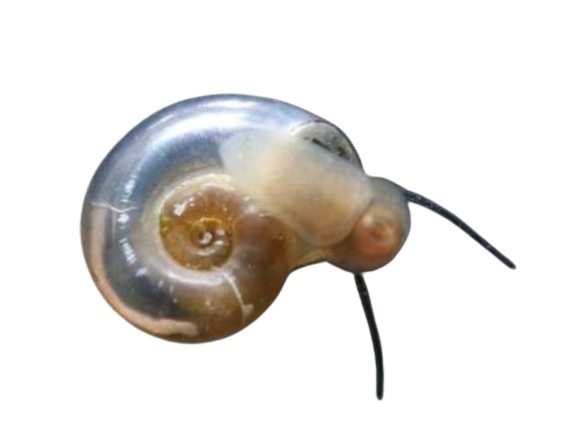
Characteristics of Planorbidae
Ramshorn snails, belonging to the family Planorbidae, are distinguished by their flat, sinistral (left-coiling) shells, which usually feature 3 to 6 whorls. In many species, the shell lays flat, giving these snails their characteristic “ramshorn” appearance. These snails possess thread-like (long, round in cross-section) tentacles which are sensitive and help them navigate their environment.
Biology and Behavior
These creatures are hermaphrodites, meaning each individual possesses both male and female reproductive organs, allowing for flexible reproduction strategies. This attribute can lead to rapid population increases in aquariums if not managed properly.
Ecological Role and Aquarium Care
Ramshorn snails play a vital role in the aquarium ecosystem. They are efficient cleaners who help maintain the aquarium by eating algae, dead plant material, and leftover food. However, their ability to reproduce quickly means that their population needs to be monitored to prevent overpopulation, which can lead to excessive waste and depletion of resources in the tank.
Compatibility and Maintenance
These snails are generally peaceful and can coexist with many fish species, making them suitable for community tanks. Care should be taken with species known to prey on snails or those that might compete for food. Regular monitoring and maintenance of the tank are essential to keep a healthy balance between the snail population and other inhabitants.
Bladder Snails: Efficient Cleaners in the Aquarium
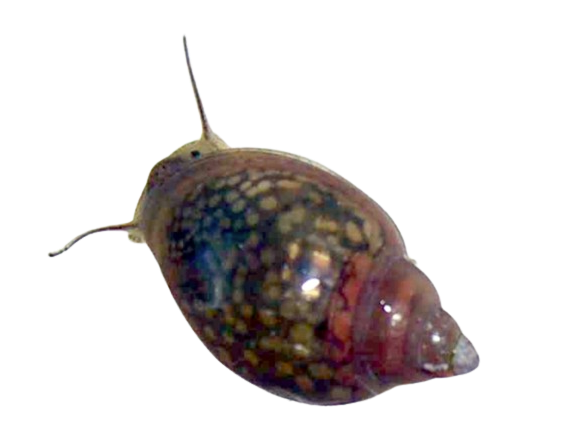
Overview
Bladder snails, or Physa marmorata, are distinguished by their left-coiling, cone-shaped shells and thread-like tentacles. These snails are pulmonates, meaning they breathe air, and exhibit both male and female reproductive organs within the same individual, classifying them as hermaphrodites.
Dietary Habits and Utility
Bladder snails thrive on decomposed material and algae growth, making them excellent cleaners for controlling algae in aquariums, particularly green and brown varieties. They are considered completely harmless and beneficial to the aquatic ecosystem. Their ability to consume algae and waste contributes significantly to maintaining water cleanliness, especially in smaller, unfiltered tanks.
Reproduction and Resilience
Bladder snails are prolific breeders, which can become a nuisance due to their rapid population growth. However, they are not known to cause any harm within the aquarium. Remarkably resilient, bladder snails can survive in conditions of extreme cold (down to 5 degrees Celsius) and high nitrite levels (over 2 mg/L). They are also capable of free swimming and feeding on surface deposits.
Compatibility
These snails are suitable for tanks with small to medium-sized fish. Larger, aggressive fish like cichlids may view them as food. Despite their vulnerability in such environments, their impressive resistance to nitrite makes them robust companions in diverse aquatic settings.
Apple Snails (Ampullaridae): A Colorful Addition to Aquatic Environments
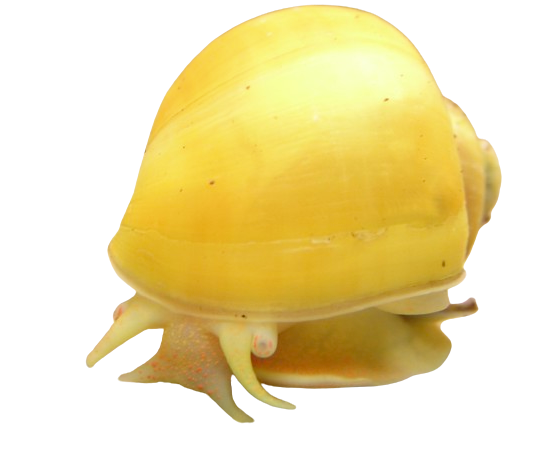
Overview
Apple snails are a diverse group originating from tropical and subtropical regions of the Americas, Africa, and Asia. Currently, the family is divided into seven genera, but only the genera Pomacea and Marisa hold significant interest for aquarists.
Unique Reproduction
Unlike other snails, accidental introduction of these genera into new habitats is relatively rare. Most apple snail species lay their eggs above the waterline. These eggs are quite large, with freshly hatched snails measuring about 2 mm in size, making them easily visible. This trait helps prevent unintended spread in non-native environments.
Compatibility and Habitat
While these snails can grow to the size of a golf ball with proper nutrition, they do not eat live plants, which is a common misconception. However, not all species are suitable for planted aquariums due to their other dietary habits and the potential damage they can cause. Apple snails demand high water quality and should not be kept with larger fish such as cichlids, loaches, and pufferfish, which may harm their delicate breathing apparatus.
Reproduction and Maturity
Apple snails are not hermaphrodites; they lay their eggs in moist locations above the water surface. The egg clutches are protected by a calcareous layer that hardens after laying. Snails reach sexual maturity between three to six months of age, ready to continue their life cycle.
The Great Pond Snail (Planorbarius corneus): A Detailed Overview
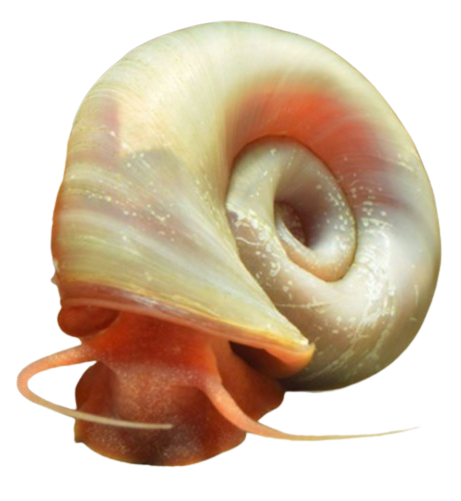
Characteristics and Habitat
The Great Pond Snail, or Planorbarius corneus, typically reaches a diameter of up to 34 mm and a thickness of up to 12 mm. It breathes using a lung-like organ, surfacing occasionally to breathe air. However, in well-oxygenated waters, these snails can obtain sufficient oxygen from the water itself and do not need to surface. This adaptation allows them to thrive in a variety of aquatic environments.
Diet and Ecosystem Impact
Great Pond Snails primarily feed on algae that grow on other plants. Their presence is generally non-intrusive, as they do not cause significant damage unless present in large numbers. In dense populations, however, they can damage aquatic plants. Their brown shell and dark brown to black body allow them to blend into their surroundings, making them a subtle yet integral part of the aquatic ecosystem.
Reproduction and Control
These snails lay their eggs in gelatinous clutches underwater, with each clutch containing about 60-70 eggs. They often appear spontaneously in aquariums, usually introduced with plants. Controlling their population can be challenging, as they are hermaphroditic; a single mating can produce hundreds of tiny snails. The “Red” Great Pond Snail refers to the albinotic variant, where the unpigmented foot allows the hemolymph to show through, coloured red by a haemoglobin-like pigment.
Current Status
The information provided still holds true based on current aquaristic knowledge. Great Pond Snails are known for their resilience and the ease with which they adapt to various aquatic settings, making them both a potential asset and a challenge in aquarium management.
Understanding the Paradise Snail (Marisa cornuarietis)
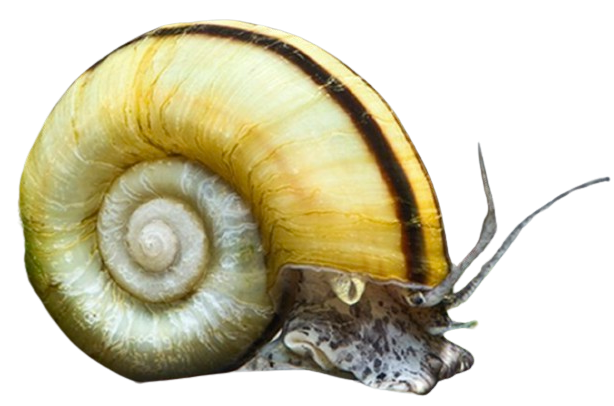
Physical Characteristics
The Marisa cornuarietis, commonly known as the Paradise Snail, has a distinctive appearance that makes it a unique addition to many aquariums. It features a flat, rounded shell predominantly yellow in colour with brown stripes. The snail’s foot is speckled with a yellowish-dark brown pattern, adding to its visual appeal.
Reproduction and Gender Identification
Closely related to the apple snails, Paradise Snails are dioecious, meaning they have distinct male and female individuals. Unlike apple snails, where sexing can be challenging, the gender of Paradise Snails is easier to determine. Males typically have a nearly round shell opening, while females display a more oval aperture, facilitating easier breeding management in captivity.
Habitat Considerations
Despite their attractive appearance, Paradise Snails are not suitable for planted aquariums. They have a strong appetite for aquatic plants and can quickly devour all parts of a plant down to the roots. Even with ample feeding, their plant-eating habits cannot be entirely curbed, which may lead to significant destruction in a lushly planted tank.
Additionally, these snails are not recommended for African Rift Lake setups (typically devoid of plants) because the cichlids in these environments may injure the snails’ delicate breathing siphon.
Snail Control in Aquariums
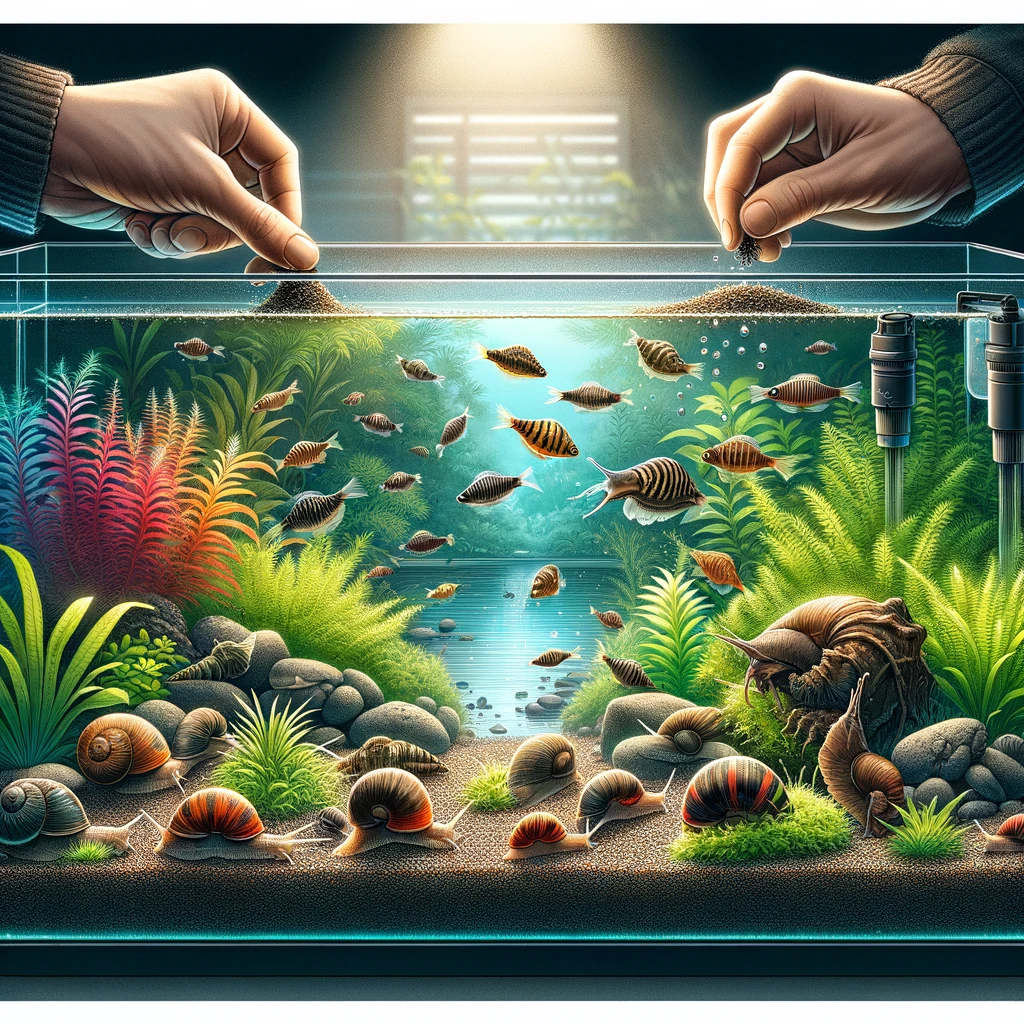
Managing a snail population in an aquarium can be a challenging task, especially if the population has already established itself extensively. Here’s a breakdown of effective snail control strategies.
Manual and Mechanical Removal
A straightforward method to begin reducing a snail population is daily removal using a siphon or a gravel cleaner, along with hand-picking. Using a food tablet as bait can facilitate this process by attracting snails to a specific location, making them easier to collect. However, it is difficult to completely eradicate snails this way, as tiny individuals and possibly eggs might escape even the most vigilant observer.
Biological Control
Another effective approach involves biological control using predator fish. This can be particularly impactful in small aquariums, potentially leading to the eradication of snails. Loaches, especially, are renowned for their efficiency in consuming snails. Among them, the Clown Loach (Botia macracanthus) is a popular choice. However, given its need to be kept in groups and its potential size reaching 15-20 cm, it is more suitable for larger aquariums.
For most aquarists, smaller species such as the Dwarf Chain Loach (Botia sidthimunki) or the Banded Loach (Botia dario), which grow to about 6-7 cm, are preferable. These fish are diligent in consuming small snails and can be a practical choice for standard-sized tanks.
Chemical Adjustments and Alternative Methods
Using increased CO2 levels can thin the shells of most snails, making them more vulnerable to predators. This occurs because the acid in CO2 dissolves calcium carbonate, which is a major component of snail shells. Snails in softer water, which contains less soluble minerals, are less affected by this treatment.
Occasionally, pufferfish are recommended for snail control due to their ability to crack hard snail shells. However, pufferfish generally require species-specific tanks and often need brackish or marine conditions as they mature. They are not suitable for community tanks due to their specialized diet and potentially aggressive behaviour. If a pufferfish runs out of snails to eat, it might suffer from overgrown teeth, which can prevent it from eating and lead to starvation.
Natural and Safe Alternatives
A non-chemical method involves placing a blanched lettuce leaf in the tank overnight and removing it before lights on; it will likely be covered in snails. Repeating this can significantly reduce snail numbers. Alternatively, cucumber slices can attract snails, although this could be problematic if plecostomus (sucker-mouthed catfish) are present, as they might also be attracted to the cucumber.
These methods offer a range of options for aquarists to control snail populations effectively, from manual removal to biological solutions, each with its own set of considerations to keep in mind for the health and balance of the aquarium ecosystem.
Keeping Your Discus Fish Parasite-Free: Essential Insights
Discus fish are celebrated for their stunning beauty but keeping them healthy can be quite the challenge due to the threat of parasites like gill worms and flagellates. Here, we’ll dive into effective strategies and share community insights on maintaining a parasite-free environment for your discus fish.
The Real Impact of Parasites
Parasites can be a big problem, leading to stunted growth and even death in discus fish. While achieving a completely parasite-free tank is tough, the effort is well worth it, yielding healthier and livelier fish.
Debating Treatment Methods
There’s a lot of debate about how to handle parasites. Some folks lean heavily on medications like Metronidazole, especially for younger fish that absorb these treatments more readily. However, there’s a growing voice advocating for less invasive approaches—think optimal water conditions and regular check-ups rather than heavy meds, which might do more harm than good in the long run.
Natural Control Strategies
One sustainable method to control parasites involves using predatory species, like certain loaches, to naturally reduce snail populations that host parasite larvae. This biological control is not only effective but also helps keep your tank ecosystem balanced without resorting to chemicals.
Learning from Each Other
Many in the discus community share their battles and successes in managing parasites, offering a treasure trove of practical advice. While some have seen great improvements with rigorous parasite control, others warn against over-treatment and the reliance on untested methods.
Moving Forward Responsibly
The consensus? We need to be thoughtful and informed about discus fish care. Aiming for a completely parasite-free tank may not be feasible, but improving care through proven practices and regular maintenance can make a big difference.
Ethical Care and Best Practices in Parasite Management
Keeping a healthy discus tank intersects with ethical fishkeeping, especially when it comes to handling parasites.
Ethical Treatment Choices
Choosing treatment methods raises ethical questions. Overusing powerful drugs can lead to resistance and side effects, so it’s crucial to use them judiciously and under professional guidance.
Prevention is Key
Preventative measures are less about radical actions and more about maintaining a stable environment:
- Quarantine New Fish: Always quarantine new arrivals to prevent the introduction of parasites.
- Regular Health Checks: Get your fish checked regularly to catch and manage parasite issues before they become severe.
- Water Quality: Maintain high water quality with regular changes and careful monitoring, as good water can prevent a host of problems.
Diet and Environment
A well-fed fish in a stress-free environment is your best defense against parasites. A nutritious diet enhances the fish’s natural defenses, helping them resist parasites more effectively.
A Call for Responsible Fishkeeping
It’s all about community and shared responsibility. By educating ourselves and each other, and advocating for ethical treatment, we can ensure our discus fish not only survive but thrive.
Conclusion
Maintaining a parasite-free environment for discus fish means staying informed, being cautious with treatments, and learning from each other’s experiences. It’s about more than just enjoying the hobby; it’s about committing to the health and well-being of these magnificent creatures.

